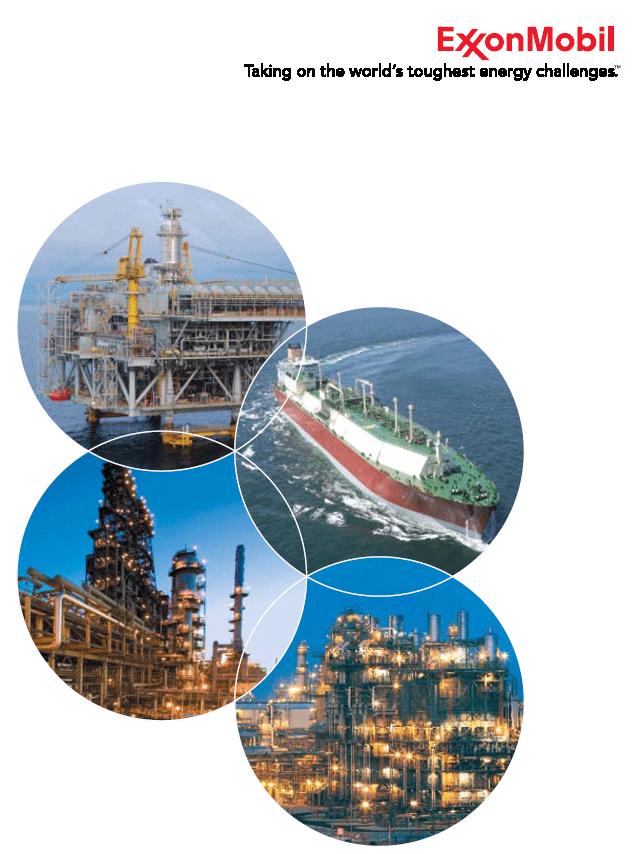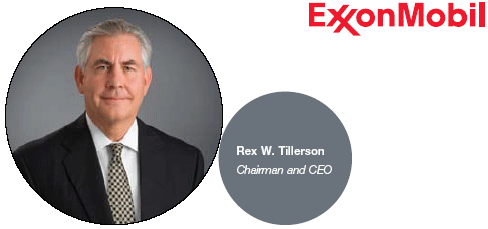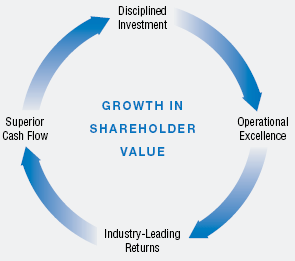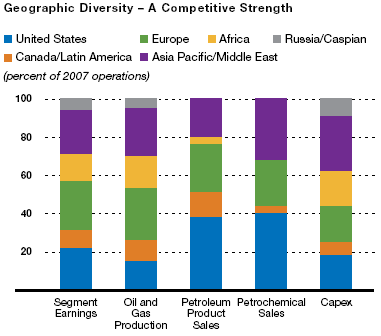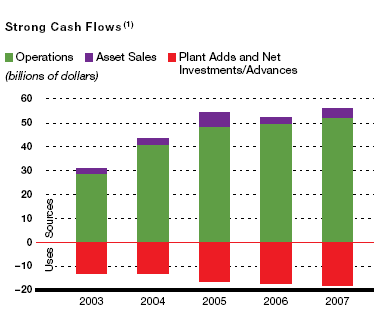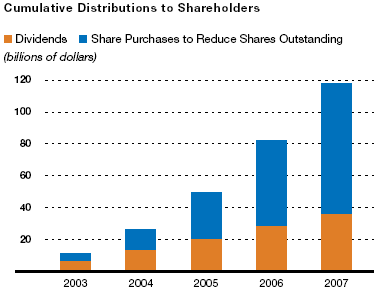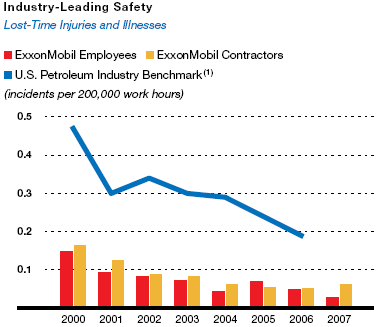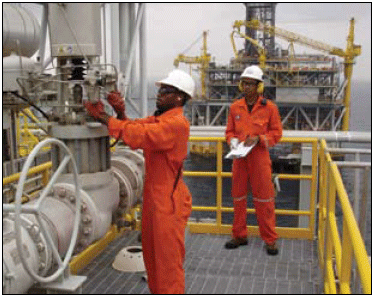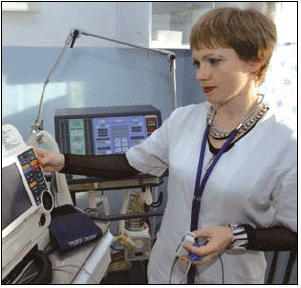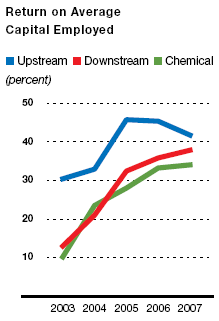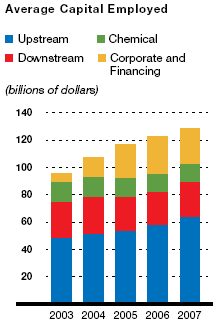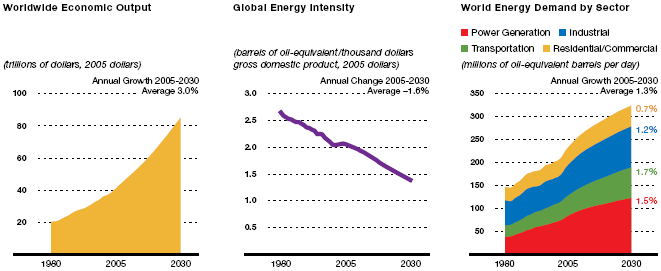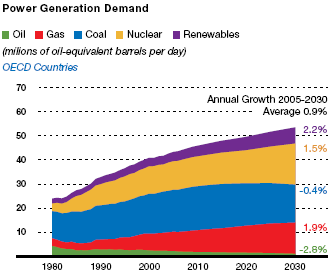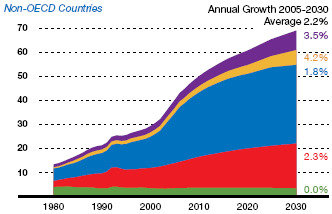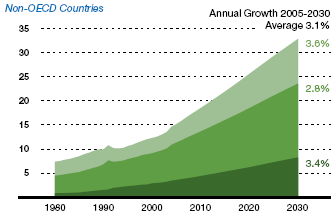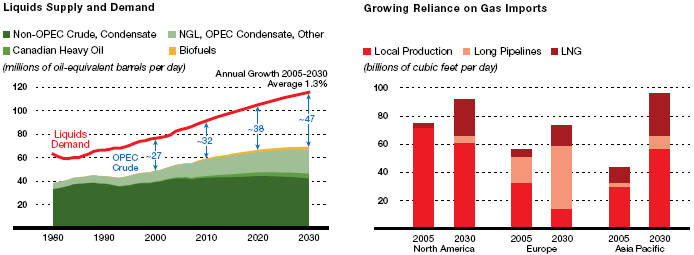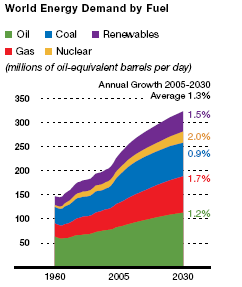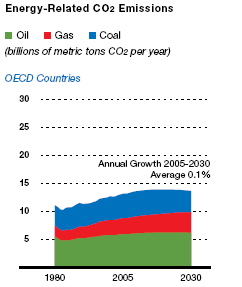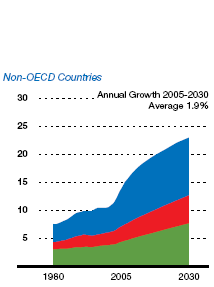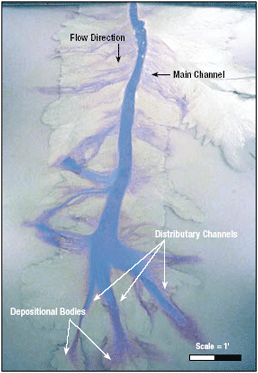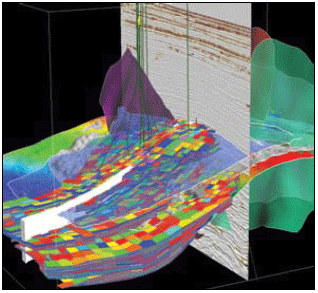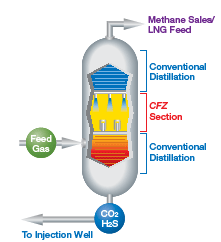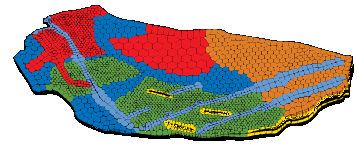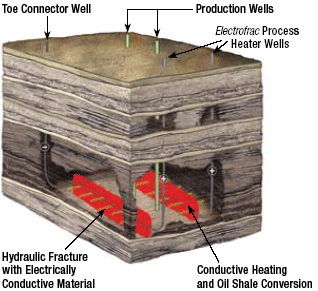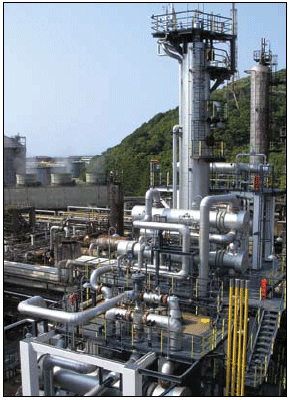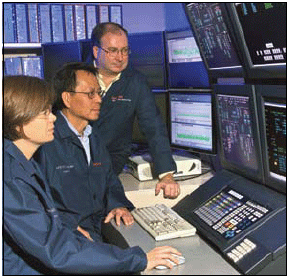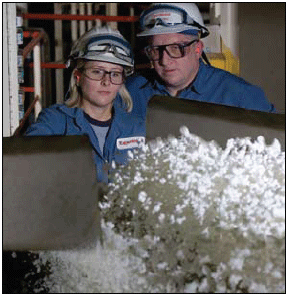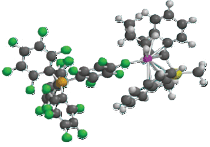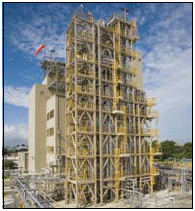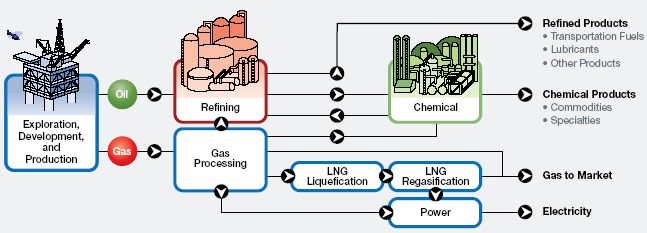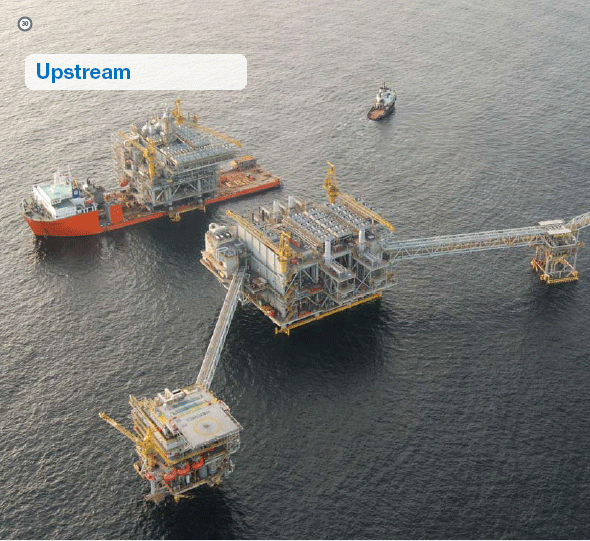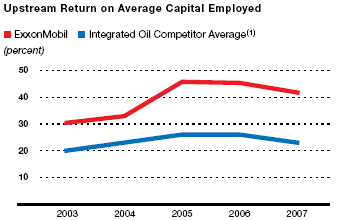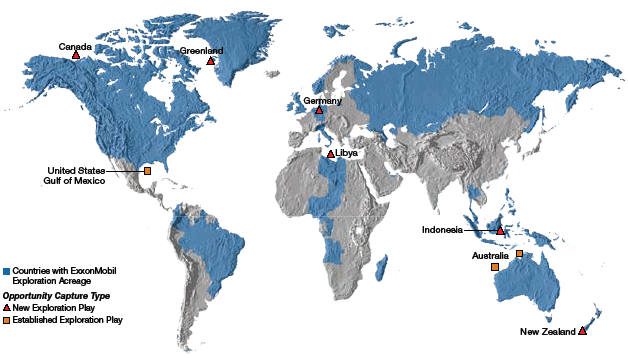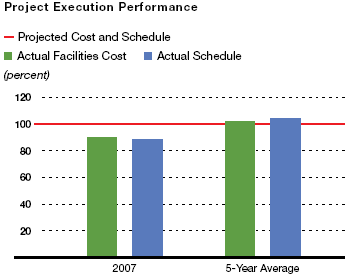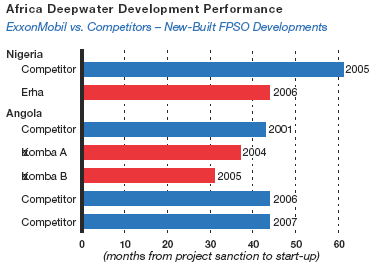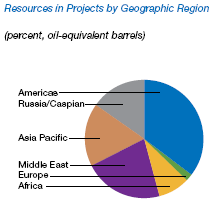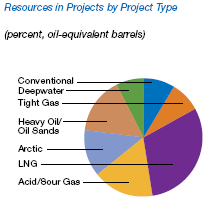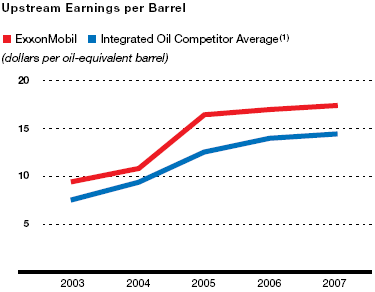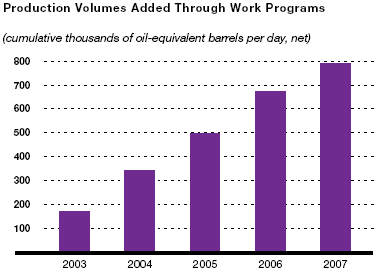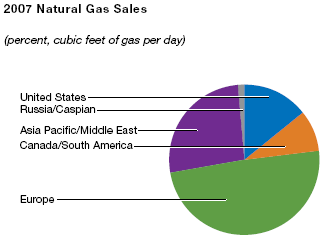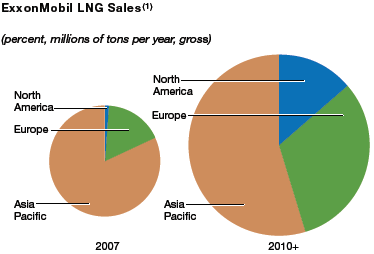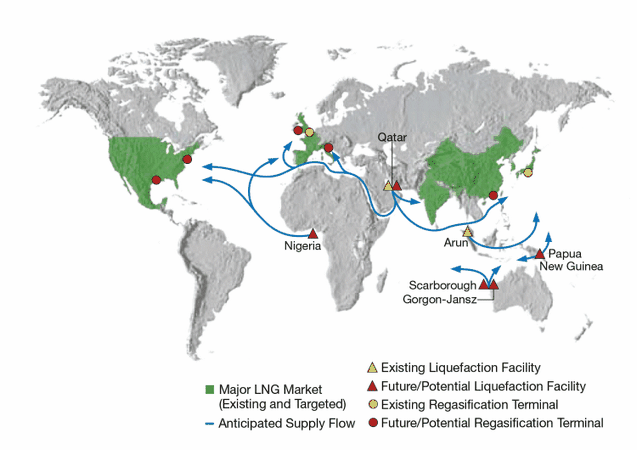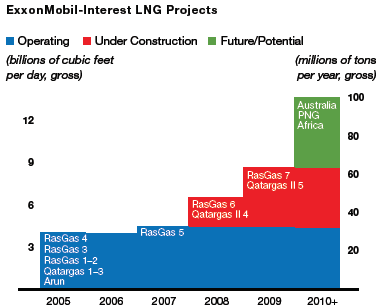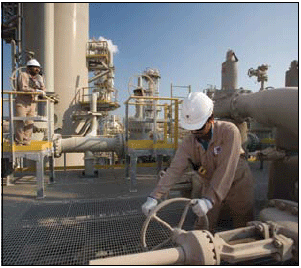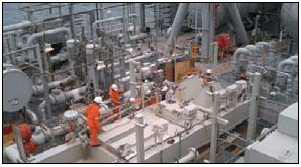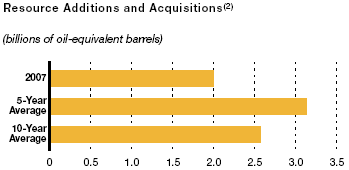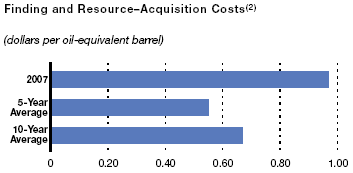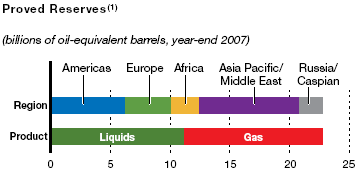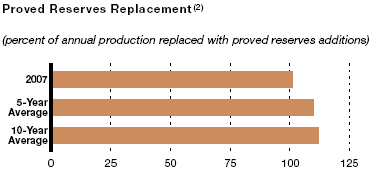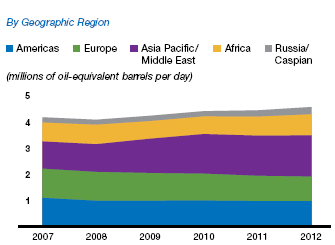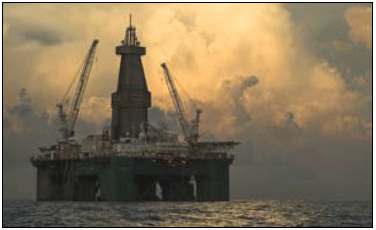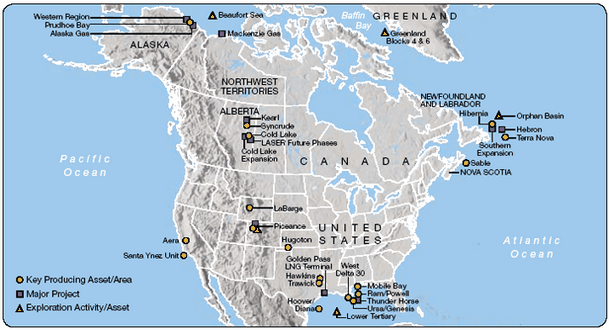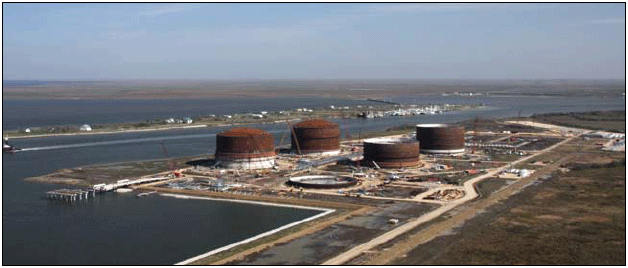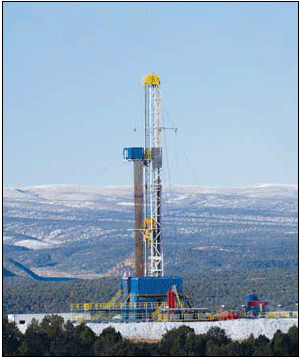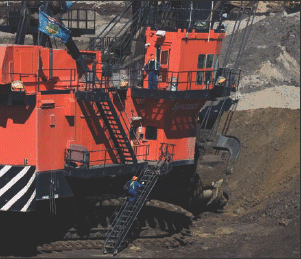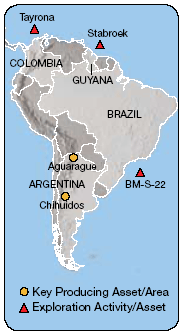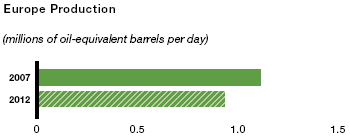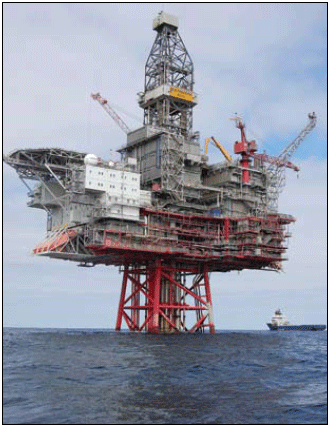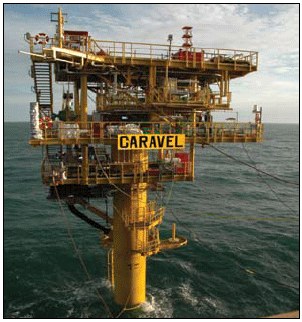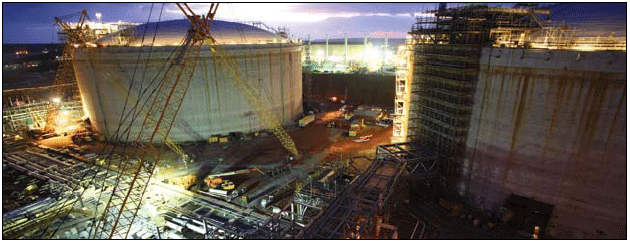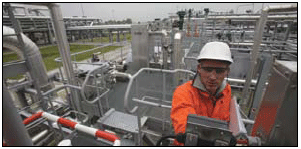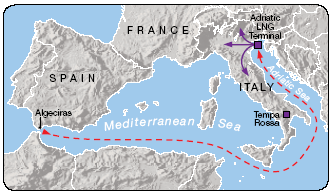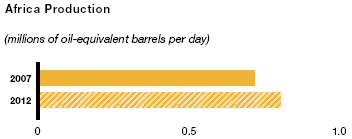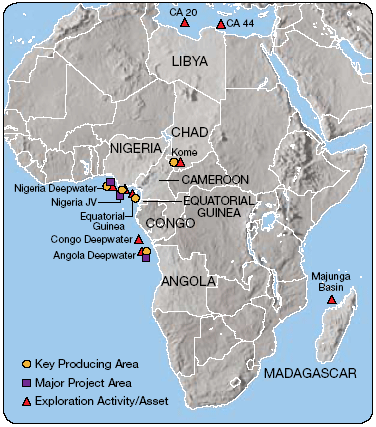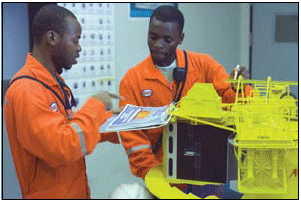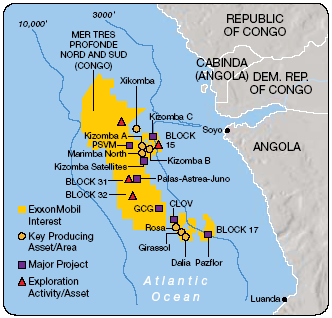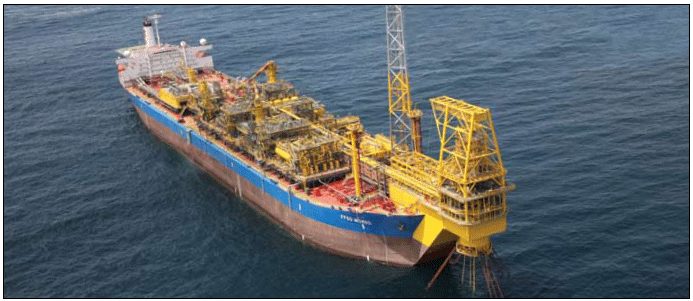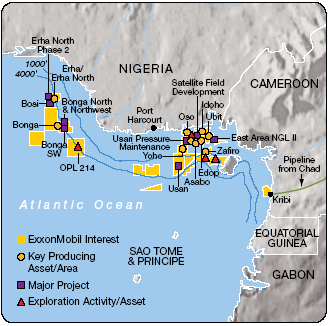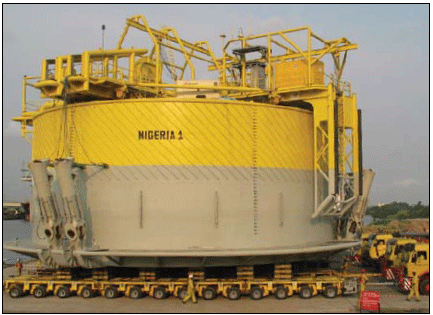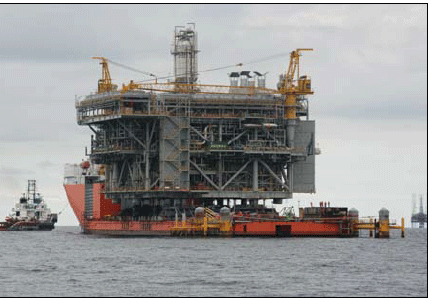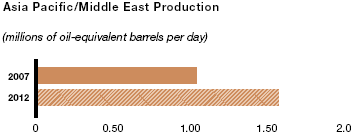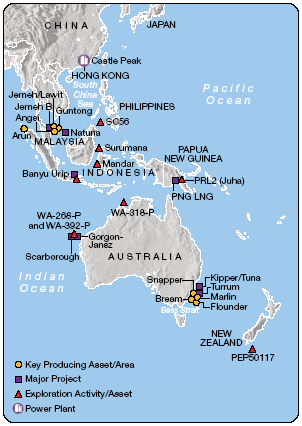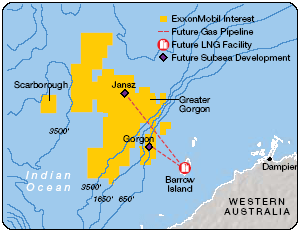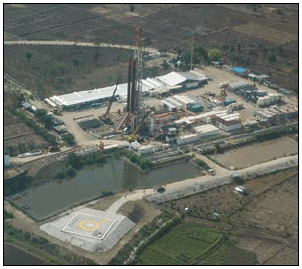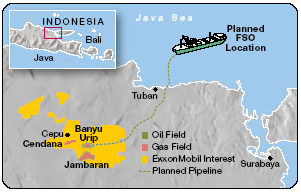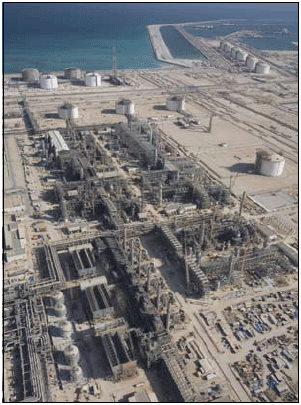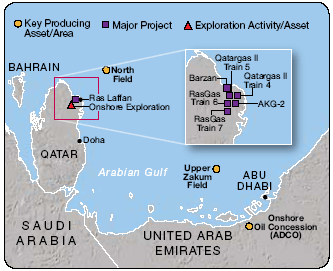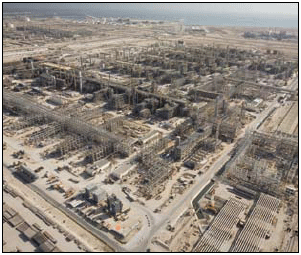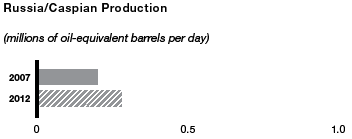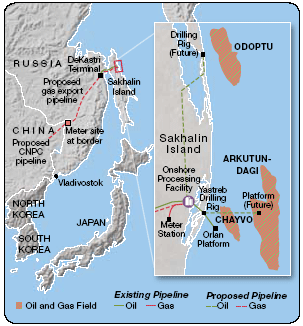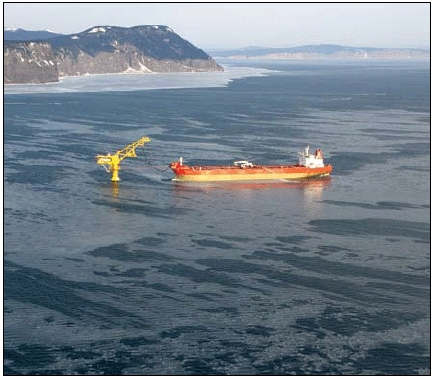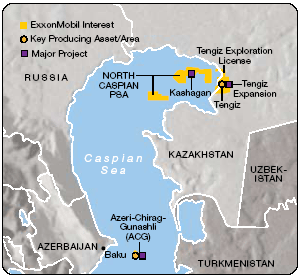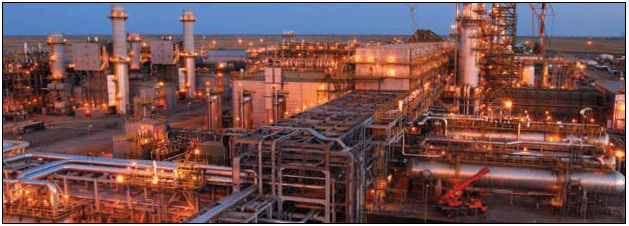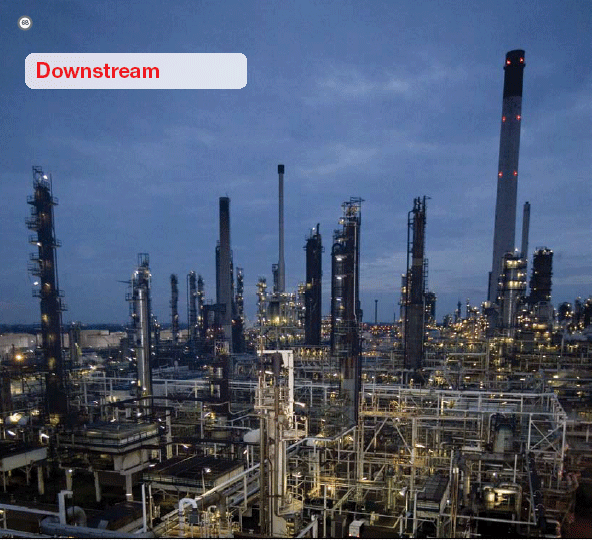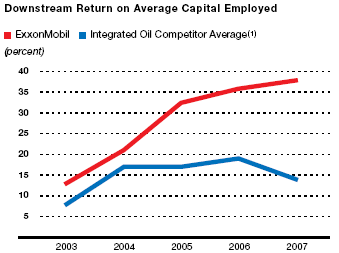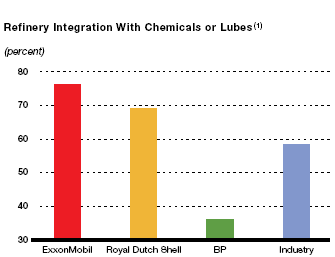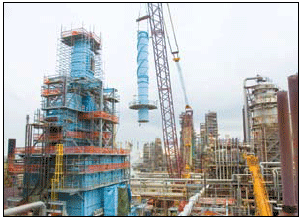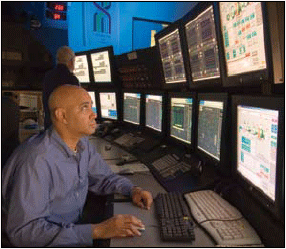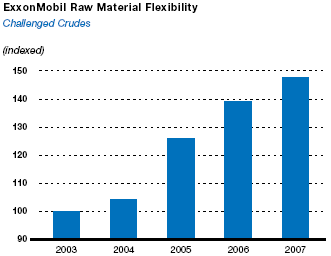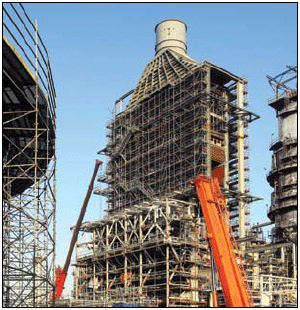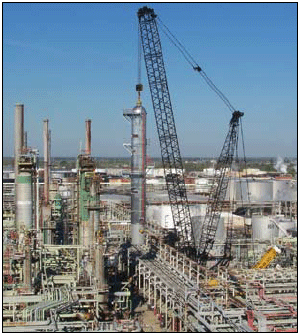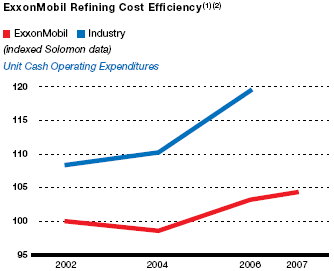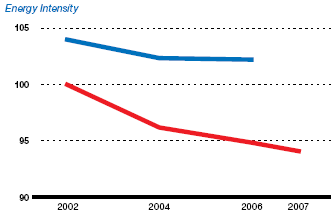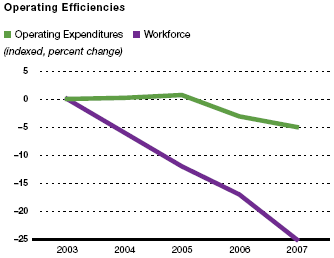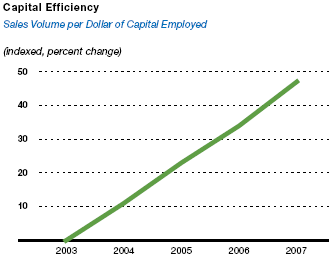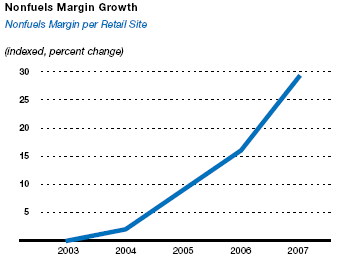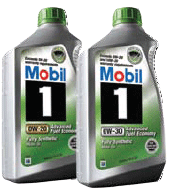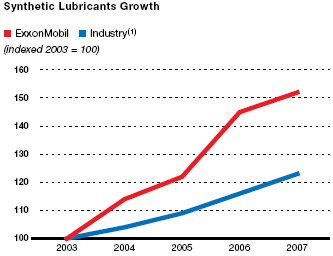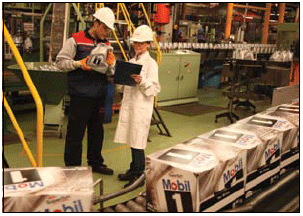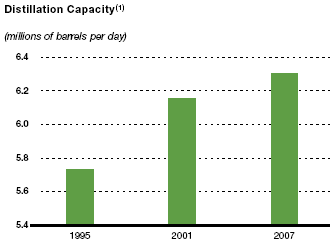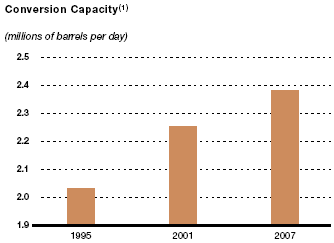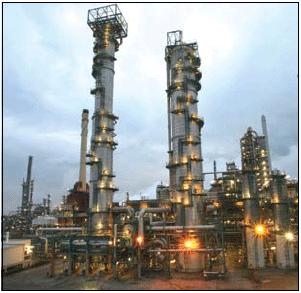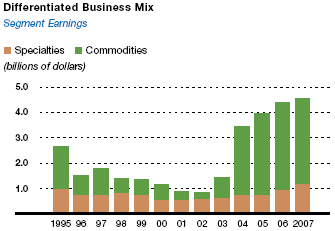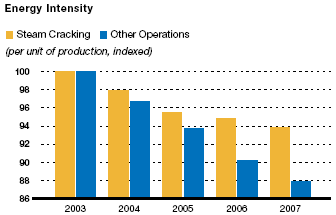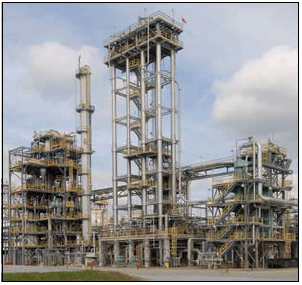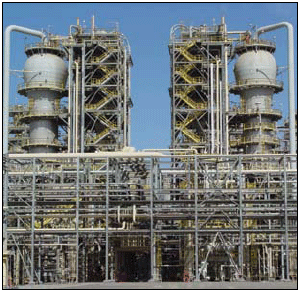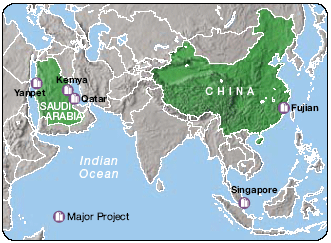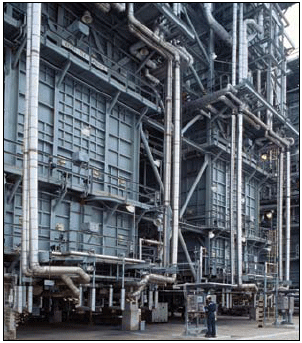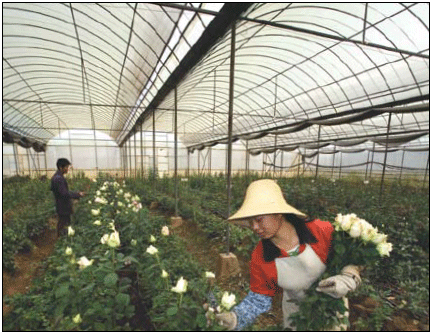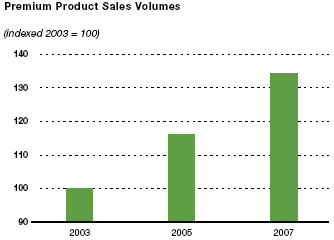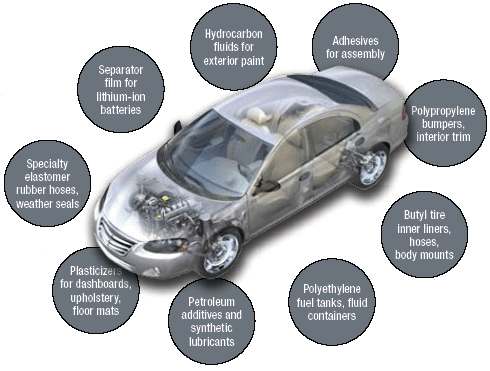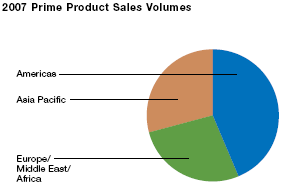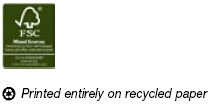2007 Financial & Operating Review
ON THE COVER
ExxonMobil is uniquely positioned in the industry due to the depth and breadth of our technical and
operational capabilities in our Upstream, Downstream, and Chemical businesses. We have a
world-class portfolio of Upstream projects, including the East Area NGL II project in Nigeria (top
left). Through the use of ExxonMobil technology, we have been able to increase the size of
liquefied natural gas (LNG) ships, such as the Q-Flex LNG ship (center right), and significantly
reduce shipping costs. Our Downstream portfolio includes world-class facilities with significant
conversion capacity — for example, the delayed coker at our Baytown, Texas, refinery (center left)
— that allow us to upgrade heavy crudes into higher-value products. ExxonMobil’s integrated
chemical plant in Singapore (lower right) will be expanded through the addition of a second world-scale ethylene steam cracker and derivative
units to meet the growing demand for products in Asia.
CONTENTS
| |
|
|
|
|
Corporate Overview |
|
|
1-17 |
|
| |
|
|
|
|
|
|
|
18-21 |
|
| |
|
|
|
|
|
|
|
22-28 |
|
| |
|
|
|
|
|
|
|
29 |
|
| |
|
|
|
|
|
|
|
30-67 |
|
| |
|
|
|
|
|
|
|
68-83 |
|
| |
|
|
|
|
|
|
|
84-93 |
|
| |
|
|
|
|
|
|
|
94-97 |
|
| |
|
|
|
|
|
|
|
98 |
|
| |
|
|
|
|
|
|
Inside Back Cover |
|
The term Upstream refers to exploration, development, production, and gas and power marketing.
Downstream refers to the refining and marketing of petroleum products such as motor fuels and
lubricants.
Projections, targets, expectations, estimates, and business plans in this report are
forward-looking statements. Actual future results, including demand growth and energy mix; capacity
growth; the impact of new technologies; capital expenditures; project plans, dates, and
capacities; production rates and resource recoveries; and efficiency gains and cost savings could
differ materially due to, for example, changes in oil and gas prices or other market conditions
affecting the oil and gas industry; reservoir performance; timely completion of development
projects; war and other political or security disturbances; changes in law or government
regulation; the actions of competitors; unexpected technological developments; the occurrence and
duration of economic recessions; the outcome of commercial negotiations; unforeseen technical
difficulties; and other factors discussed in this report and in Item 1A of ExxonMobil’s most recent Form 10-K.
Definitions of certain financial and operating measures and other terms used in this report are
contained in the section titled “Frequently Used Terms” on pages 94 through 97. In the case of
financial measures, the definitions also include information required by SEC Regulation G to the
extent we believe applicable.
“Factors Affecting Future Results” and “Frequently Used Terms” are also posted on our Web site and
are updated from time to time.
Prior
years’ data have been reclassified in certain cases to conform
to the 2007 presentation basis.
EXXON MOBIL CORPORATION § 2007 FINANCIAL & OPERATING REVIEW 1
Meeting the world’s fundamental and growing need for energy is a massive undertaking.
Providing reliable, affordable energy supplies in a responsible manner enables global economic
progress and improves the quality of life for people around the world. ExxonMobil remains uniquely
positioned to take on the key challenges facing our industry today:
| |
§ |
Safely and reliably producing oil, natural gas, and hydrocarbon products |
| |
| |
§ |
Finding and developing new supplies and products to bring to market |
| |
| |
§ |
Maximizing resource and asset value |
| |
| |
§ |
Improving energy efficiency and minimizing environmental impacts |
| |
| |
§ |
Developing the next generation of scientists and engineers |
What does it take to meet these challenges?
It requires an understanding of the long-term nature of our business. It requires a consistent,
systematic business model with the flexibility to adapt to changing business conditions. It
requires a commitment to invest in and develop people, innovative technology, and projects that
grow shareholder value. It requires a company of leaders with an unwavering commitment to
integrity, operational excellence, and community development.
ExxonMobil has taken on these challenges for over 125 years while continuing to deliver
superior financial results to our shareholders.
2 EXXON MOBIL CORPORATION § 2007 FINANCIAL & OPERATING REVIEW
Fundamentals of Our Approach:
Consistency, Integrity, Discipline, Reliability, and Ingenuity
FINANCIAL HIGHLIGHTS
| |
|
|
|
|
|
|
|
|
|
|
|
|
|
|
|
|
|
|
|
|
| (millions of dollars, unless noted) |
|
2007 |
|
|
2006 |
|
|
2005 |
|
|
2004 |
|
|
2003 |
|
| |
Sales and other operating revenue(1)(2) |
|
|
390,328 |
|
|
|
365,467 |
|
|
|
358,955 |
|
|
|
291,252 |
|
|
|
237,054 |
|
Net income |
|
|
40,610 |
|
|
|
39,500 |
|
|
|
36,130 |
|
|
|
25,330 |
|
|
|
21,510 |
|
Cash flow from operations and asset sales(3) |
|
|
56,206 |
|
|
|
52,366 |
|
|
|
54,174 |
|
|
|
43,305 |
|
|
|
30,788 |
|
Capital and exploration expenditures(3) |
|
|
20,853 |
|
|
|
19,855 |
|
|
|
17,699 |
|
|
|
14,885 |
|
|
|
15,525 |
|
Cash dividends to ExxonMobil shareholders |
|
|
7,621 |
|
|
|
7,628 |
|
|
|
7,185 |
|
|
|
6,896 |
|
|
|
6,515 |
|
Common stock purchases (gross) |
|
|
31,822 |
|
|
|
29,558 |
|
|
|
18,221 |
|
|
|
9,951 |
|
|
|
5,881 |
|
Research and development costs |
|
|
814 |
|
|
|
733 |
|
|
|
712 |
|
|
|
649 |
|
|
|
618 |
|
Cash and cash equivalents at year end(4) |
|
|
33,981 |
|
|
|
28,244 |
|
|
|
28,671 |
|
|
|
18,531 |
|
|
|
10,626 |
|
Total assets at year end |
|
|
242,082 |
|
|
|
219,015 |
|
|
|
208,335 |
|
|
|
195,256 |
|
|
|
174,278 |
|
Total debt at year end |
|
|
9,566 |
|
|
|
8,347 |
|
|
|
7,991 |
|
|
|
8,293 |
|
|
|
9,545 |
|
Shareholders’ equity at year end |
|
|
121,762 |
|
|
|
113,844 |
|
|
|
111,186 |
|
|
|
101,756 |
|
|
|
89,915 |
|
Average capital employed(3) |
|
|
128,760 |
|
|
|
122,573 |
|
|
|
116,961 |
|
|
|
107,339 |
|
|
|
95,373 |
|
Share price at year end (dollars) |
|
|
93.69 |
|
|
|
76.63 |
|
|
|
56.17 |
|
|
|
51.26 |
|
|
|
41.00 |
|
Market valuation at year end |
|
|
504,220 |
|
|
|
438,990 |
|
|
|
344,491 |
|
|
|
328,128 |
|
|
|
269,294 |
|
Regular employees at year end (thousands) |
|
|
80.8 |
|
|
|
82.1 |
|
|
|
83.7 |
|
|
|
85.9 |
|
|
|
88.3 |
|
| |
|
|
|
|
|
|
|
|
|
|
|
|
|
KEY FINANCIAL RATIOS |
| |
|
|
|
|
|
|
|
|
|
|
|
|
|
|
|
|
|
|
|
|
| |
|
2007 |
|
|
2006 |
|
|
2005 |
|
|
2004 |
|
|
2003 |
|
| |
Net income per common share (dollars) |
|
|
7.36 |
|
|
|
6.68 |
|
|
|
5.76 |
|
|
|
3.91 |
|
|
|
3.24 |
|
Net
income per common share – assuming dilution (dollars) |
|
|
7.28 |
|
|
|
6.62 |
|
|
|
5.71 |
|
|
|
3.89 |
|
|
|
3.23 |
|
Return on average capital employed(3) (percent) |
|
|
31.8 |
|
|
|
32.2 |
|
|
|
31.3 |
|
|
|
23.8 |
|
|
|
20.9 |
|
Net income to average shareholders’ equity (percent) |
|
|
34.5 |
|
|
|
35.1 |
|
|
|
33.9 |
|
|
|
26.4 |
|
|
|
26.2 |
|
Debt to capital(5) (percent) |
|
|
7.1 |
|
|
|
6.6 |
|
|
|
6.5 |
|
|
|
7.3 |
|
|
|
9.3 |
|
Net debt to capital(6) (percent) |
|
|
(24.0 |
) |
|
|
(20.4 |
) |
|
|
(22.0 |
) |
|
|
(10.7 |
) |
|
|
(1.2 |
) |
Ratio of current assets to current liabilities |
|
|
1.47 |
|
|
|
1.55 |
|
|
|
1.58 |
|
|
|
1.40 |
|
|
|
1.20 |
|
Fixed charge coverage (times) |
|
|
49.9 |
|
|
|
46.3 |
|
|
|
50.2 |
|
|
|
36.1 |
|
|
|
30.8 |
|
| |
|
|
|
| |
|
|
| (1) |
|
Sales and other operating revenue includes sales-based taxes of $31,728 million for 2007,
$30,381 million for 2006, $30,742 million for 2005, $27,263 million for 2004, and $23,855 million
for 2003. |
| |
| (2) |
|
Sales and other operating revenue includes $30,810 million for 2005, $25,289 million for 2004
and $20,936 million for 2003 for purchases/sales contracts with the same counterparty. Associated
costs were included in Crude oil and product purchases. Effective January 1, 2006, these
purchases/sales were recorded on a net basis with no resulting impact on net income. |
| |
| (3) |
|
See Frequently Used Terms on pages 94 through 97. |
| |
| (4) |
|
Excluding restricted cash of $4,604 million in 2006, 2005, and 2004. |
| |
| (5) |
|
Debt includes short- and long-term debt. Capital includes short- and long-term debt,
shareholders’ equity, and minority interests. |
| |
| (6) |
|
Debt net of cash and cash equivalents, excluding restricted
cash. |
EXXON MOBIL CORPORATION § 2007 FINANCIAL & OPERATING
REVIEW 3
BUSINESS MODEL
ExxonMobil has a consistent and straightforward business
model that combines our long-term perspective, disciplined
approach to capital investment, and focus on operational
excellence to grow shareholder value. We identify,
develop, and execute projects using best practices that
ensure project returns will be resilient over a range of
economic scenarios. We operate our facilities using proven
management systems to achieve operational excellence. As a
result, we are able to generate more income from a highly
efficient capital base, as demonstrated by our superior
return on capital employed. Our successful execution of
this model delivers industry-leading financial and
operating results that grow shareholder value.
ExxonMobil’s superior performance demonstrates the strength of our long-term business
model.
Superior 2007 Results
| • |
|
Best-ever lost-time incident rate for our combined employee and contractor workforce |
| • |
|
Record earnings of $40.6 billion, with record performance in each of our business functions |
| • |
|
Annual dividend per share growth of 7 percent versus 2006, the 25th consecutive year of
dividend per share increases |
| • |
|
Total shareholder distributions of $35.6 billion, an increase of $3 billion versus 2006 |
| • |
|
Industry-leading return on average capital employed of 32 percent |
| • |
|
Start-up of seven major Upstream projects |
| • |
|
Total liquids production and
natural gas production available for sale of 4.2 million oil-equivalent barrels per day |
| • |
|
Replaced 101 percent of production with proved oil and gas reserve additions of 1.6 billion
oil-equivalent barrels, |
| |
|
including
asset sales and the effect of the Venezuela expropriation, and
excluding year-end price/cost effects |
| • |
|
Downstream and Chemical operating cost efficiencies and margin enhancements totaling $2
billion after tax |
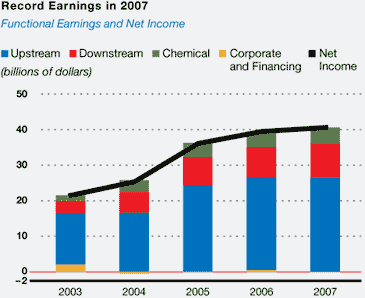
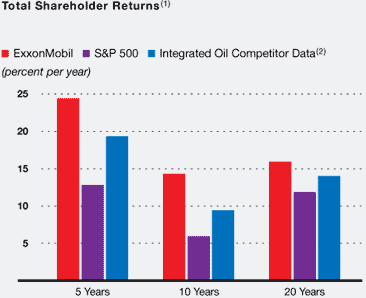
|
|
|
|
| |
|
(1) Reflects data through December 31, 2007. |
|
| |
| |
|
(2) Royal Dutch Shell, BP, and Chevron values are calculated on a consistent basis with ExxonMobil, based on public information. |
|
4 EXXON MOBIL CORPORATION § 2007 FINANCIAL & OPERATING REVIEW
Business Strategies
ExxonMobil’s fundamental business strategies are key to achieving sustained, outstanding
performance in all aspects of our business. Consistency, integrity, discipline, reliability, and
ingenuity provide the foundation for our business processes. ExxonMobil is able to meet the
challenge of providing reliable, affordable energy in a responsible manner through the superior
execution of our business strategies.
OPERATE
IN A SAFE AND ENVIRONMENTALLY RESPONSIBLE MANNER
ExxonMobil’s commitment to safety begins with our senior management and is a core value held by our
employees around the world. Our corporate culture drives us toward our goal of an incident-free
workplace.
We conduct business in a manner that is compatible with the environmental and economic needs of the
communities in which we operate. ExxonMobil is committed to continuous improvement in environmental
performance with the goal of driving incidents with real environmental impact to zero.
UPHOLD HIGH STANDARDS
ExxonMobil adheres to all applicable laws, rules, and regulations as a minimum standard, and, when
requirements do not exist, we apply responsible standards to our operations.
How we achieve results is as important as the results themselves. We choose the course of highest
integrity in all of our business interactions. We believe that a well-founded reputation for high
ethical standards, strong business controls, and good corporate governance is a priceless corporate
asset.
Directors, officers, and employees must comply with our Standards of Business Conduct. This
requirement is regularly reinforced by management.
PURSUE OPERATIONAL EXCELLENCE
Flawless operational performance is enabled through the use of management systems that ensure
consistency and the development of best practices.
ExxonMobil has developed a wide range of management and operating systems that cover critical
aspects of our business, including: ethics, safety, security, health, environmental performance,
operations reliability, business controls, project investment and execution, energy efficiency,
profit improvement, and external affairs. The disciplined application of these management and
operating systems, deployed through our functional organization, has consistently delivered
superior results.
INVEST WITH DISCIPLINE
The energy industry is a long-term business that requires decisions to be made with a time horizon
that is measured in decades rather than months or years. We have a responsibility to our
shareholders to ensure that each investment decision is made using a disciplined approach.
Our proven project management system incorporates best practices developed around the world.
Emphasis on the early phases of concept selection and project execution results in investments that
maximize resource and asset value.
Projects are tested over a range of economic scenarios to ensure that they are robust in a variety
of business environments. Post investment, we complete a rigorous appraisal of major projects and
incorporate learnings into future project planning and design. This approach ensures superior
investment returns throughout the business cycle.
DIFFERENTIATE WITH PROPRIETARY TECHNOLOGY
Technology is and will remain key to meeting the world’s growing energy demand. Technological
innovations allow the identification and economic development of challenged resources, optimization
of operating unit performance, and development of high-performance products.
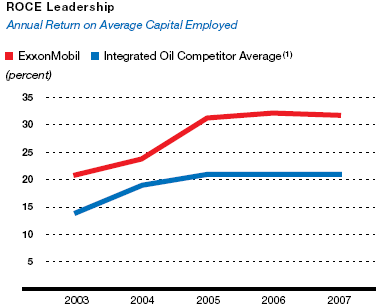
|
|
|
| (1) Royal Dutch Shell, BP, and Chevron values are estimated on a consistent basis with ExxonMobil, based on public information. |
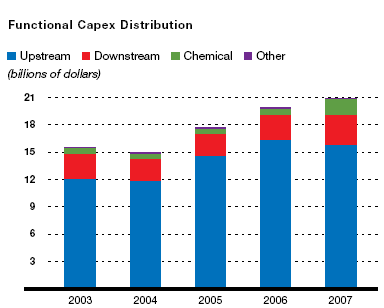
EXXON MOBIL CORPORATION § 2007 FINANCIAL & OPERATING
REVIEW 5
ExxonMobil has a long-standing commitment to the development of innovative proprietary
technology. We have a wide array of research programs designed to meet the needs identified in our
functional businesses. Over the past five years, we have invested about $3.5 billion in research
and development. As new technologies are developed, our global functional organization enables
rapid deployment and value capture.
OPTIMIZE RESULTS THROUGH FUNCTIONAL DIVERSITY AND INTEGRATION
ExxonMobil’s business portfolio and level of global integration are unique in the industry. Our
portfolio of assets provides advantages in scale, geographic diversity, and business mix, and
mitigates risks that arise from changes in commodity prices and business cycles.
We are able to capture value through superior opportunity identification, implementation of best
practices, advantaged technology, and operational optimization. The combination of our global scale
and integration across our businesses gives ExxonMobil a competitive advantage that is difficult to
replicate.
INCREASE EFFICIENCY THROUGH OUR GLOBAL FUNCTIONAL ORGANIZATION
ExxonMobil’s global functional organization is integral to our ongoing success. It drives senior
management involvement in all major decisions and ensures that our business processes are
consistent with our strategic goals. Our structure enables effective transfer of knowledge,
demonstrated by our ability to rapidly deploy people and technology to support business activities
around the world.
ATTRACT AND RETAIN EXCEPTIONAL PEOPLE
Delivering outstanding performance requires exceptional people. The quality of our workforce is a
competitive advantage. We focus on merit-based, long-term career development for our employees.
ExxonMobil is committed to maintaining a diverse workforce and a supportive work
environment that is characterized by open communication, trust, and fair treatment. We recruit
talented people from around the world and provide them with formal training and a broad range of
experiences to develop them into the next generation of company leaders.
ENHANCE COMMUNITY DEVELOPMENT
ExxonMobil believes in creating a positive and lasting social impact in the countries in which we
operate. Our operations strengthen economic growth through investment, employment, and the purchase
of local goods and services.
We focus on supporting community programs that reduce barriers to development. These strategic
community investment activities include enhancing health conditions, improving education, and
providing increased opportunities for women and girls. These investments help to alleviate poverty,
promote social progress, and increase economic growth.
This business strategy benefits the communities in which we operate and helps ensure a sustainable
operating environment for our business.
MAINTAIN FINANCIAL STRENGTH
ExxonMobil’s financial position remains unparalleled within our industry and when compared to
nearly every company in the world. Moody’s and Standard & Poor’s recognize our superior financial
strength by assigning the highest credit rating to our financial obligations. ExxonMobil is one of
very few public companies that has maintained the highest credit rating over the past several
decades.
Our financial strength gives us the flexibility to pursue and finance attractive investment
opportunities around the world. Host governments and project partners recognize our unique position
and benefit from the financial strength and expertise we bring to the development of resources.
This competitive advantage translates into superior returns for ExxonMobil’s shareholders.
(1) Net cash from operating and investing activities, excluding changes in restricted cash and cash equivalents, and marketable securities (see page 17).
6 EXXON MOBIL CORPORATION § 2007 FINANCIAL & OPERATING REVIEW
Shareholder Information
ExxonMobil’s core objective is to deliver long-term growth in shareholder value. Over the past five
years, we have distributed nearly $118 billion to our shareholders through quarterly dividend
payments and share purchases to reduce shares outstanding. In 2007 our total shareholder
distributions were $36 billion, including $28 billion of share purchases.
In 2007 ExxonMobil raised annual dividends to our shareholders to $1.37 per share, an increase of 7
percent versus the previous year. We have paid a dividend each year for more than a century and
have increased annual dividends per share in each of the last 25 years.
ExxonMobil reduced the number of shares outstanding by 20 percent over the last five years
through our flexible share purchase program. Reducing shares outstanding increases the percent
ownership of the company that each remaining share represents and contributes to increased
earnings and cash flow per share.
DIVIDEND AND SHAREHOLDER RETURN INFORMATION
| |
|
|
|
|
|
|
|
|
|
|
|
|
|
|
|
|
|
|
|
|
| |
|
2007 |
|
|
2006 |
|
|
2005 |
|
|
2004 |
|
|
2003 |
|
| |
Net income per common share (dollars) |
|
|
7.36 |
|
|
|
6.68 |
|
|
|
5.76 |
|
|
|
3.91 |
|
|
|
3.24 |
|
Net income per common share – assuming dilution (dollars) |
|
|
7.28 |
|
|
|
6.62 |
|
|
|
5.71 |
|
|
|
3.89 |
|
|
|
3.23 |
|
| |
Dividends per common share (dollars) |
|
|
|
|
|
|
|
|
|
|
|
|
|
|
|
|
|
|
|
|
First quarter |
|
|
0.32 |
|
|
|
0.32 |
|
|
|
0.27 |
|
|
|
0.25 |
|
|
|
0.23 |
|
Second quarter |
|
|
0.35 |
|
|
|
0.32 |
|
|
|
0.29 |
|
|
|
0.27 |
|
|
|
0.25 |
|
Third quarter |
|
|
0.35 |
|
|
|
0.32 |
|
|
|
0.29 |
|
|
|
0.27 |
|
|
|
0.25 |
|
Fourth quarter |
|
|
0.35 |
|
|
|
0.32 |
|
|
|
0.29 |
|
|
|
0.27 |
|
|
|
0.25 |
|
| |
Total |
|
|
1.37 |
|
|
|
1.28 |
|
|
|
1.14 |
|
|
|
1.06 |
|
|
|
0.98 |
|
| |
Dividends per share growth (annual percent) |
|
|
7.0 |
|
|
|
12.3 |
|
|
|
7.5 |
|
|
|
8.2 |
|
|
|
6.5 |
|
| |
Number of common shares outstanding (millions) |
|
|
|
|
|
|
|
|
|
|
|
|
|
|
|
|
|
|
|
|
Average |
|
|
5,517 |
|
|
|
5,913 |
|
|
|
6,266 |
|
|
|
6,482 |
|
|
|
6,634 |
|
Average – assuming dilution |
|
|
5,577 |
|
|
|
5,970 |
|
|
|
6,322 |
|
|
|
6,519 |
|
|
|
6,662 |
|
Year end |
|
|
5,382 |
|
|
|
5,729 |
|
|
|
6,133 |
|
|
|
6,401 |
|
|
|
6,568 |
|
| |
Cash dividends paid on common stock (millions of dollars) |
|
|
7,621 |
|
|
|
7,628 |
|
|
|
7,185 |
|
|
|
6,896 |
|
|
|
6,515 |
|
Cash dividends paid to net income (percent) |
|
|
19 |
|
|
|
19 |
|
|
|
20 |
|
|
|
27 |
|
|
|
30 |
|
Cash
dividends paid to cash
flow(1) (percent) |
|
|
15 |
|
|
|
15 |
|
|
|
15 |
|
|
|
17 |
|
|
|
23 |
|
| |
Total return to shareholders (annual percent) |
|
|
24.3 |
|
|
|
39.2 |
|
|
|
11.7 |
|
|
|
27.9 |
|
|
|
20.5 |
|
| |
Market quotations for common stock (dollars) |
|
|
|
|
|
|
|
|
|
|
|
|
|
|
|
|
|
|
|
|
High |
|
|
95.27 |
|
|
|
79.00 |
|
|
|
65.96 |
|
|
|
52.05 |
|
|
|
41.13 |
|
Low |
|
|
69.02 |
|
|
|
56.42 |
|
|
|
49.25 |
|
|
|
39.91 |
|
|
|
31.58 |
|
Average daily close |
|
|
83.23 |
|
|
|
65.35 |
|
|
|
58.24 |
|
|
|
45.29 |
|
|
|
36.14 |
|
Year-end close |
|
|
93.69 |
|
|
|
76.63 |
|
|
|
56.17 |
|
|
|
51.26 |
|
|
|
41.00 |
|
| |
|
|
|
| |
|
(1) Net cash provided by operating activities. |
EXXON MOBIL CORPORATION § 2007 FINANCIAL & OPERATING
REVIEW 7
Safety, Health & Environment
ExxonMobil is committed to high standards of safety, security, health, and environmental care.
We continue to deliver results that demonstrate our commitment.
2007 HIGHLIGHTS
| § |
|
Best-ever lost-time incident rate for our combined employee and contractor workforce |
| |
| § |
|
Best-ever energy efficiency in refining and chemical operations |
| |
| § |
|
Greater than 15 percent reduction in spills from 2006 |
| |
| § |
|
No spills from company-operated marine vessels |
| |
| § |
|
Reduction in greenhouse gas emissions |
GUIDING PRINCIPLE
ExxonMobil complies with all applicable laws and regulations, and when laws and regulations do not
exist, we apply responsible standards. We aim to drive the number of injuries, illnesses, and incidents
with real environmental impact to zero. Our initiatives are supported by ongoing technology programs that
include internal and external work by leading scientists. We believe ExxonMobil’s overarching commitment
to achieving superior performance in safety, health, and the environment is closely linked to and reflected
in the outstanding performance of all other aspects of our business. We manufacture essential commodities
in a manner that preserves and protects health and safety and
safeguards the environment.
Safety, health, and environmental risk is managed within a company-wide framework that we call OIMS —
our Operations Integrity Management System. OIMS provides
us with a disciplined, structured, and global approach to managing these risks.
Because the system is used in our businesses and facilities worldwide, it enables
us to measure progress and ensure management accountability for results in these areas.
ExxonMobil developed OIMS more than 15 years ago, and it has been strengthened through
several cycles of improvement. In 2003, among other changes, the security requirements were
enhanced and a globally consistent environmental planning process was added. In 2007 OIMS was
refined to extend expectations to include all office workers. We are pleased that in 2007,
Lloyd’s Register Quality Assurance recognized OIMS as meeting all of the requirements of the
Occupational Health and Safety Assessment Series for health and safety management systems
(OHSAS 18001:1999), in addition to the International Organization for Standardization’s
specification for environmental management systems (ISO 14001:2004).
RISK MANAGEMENT
We recognize that risks are inherent in our business and we take a disciplined,
systematic approach to reducing these risks. The same rigor and discipline that underpin
our investment programs are also used in our approach to managing our ongoing operations
in the areas of safety, security, health, and the environment.
Our approach includes great emphasis on business continuity planning and emergency
preparedness to enable timely and effective response to incidents. In 2007 we conducted
six major regional emergency response drills in locations including Malaysia, Cyprus,
Sakhalin Island in Russia, Bermuda, the Gulf of Mexico, and California. In addition, we
conducted drills and workshops worldwide to validate the readiness of ExxonMobil affiliates
to address a potential influenza pandemic.
|
|
|
| |
|
(1) Employee safety data from participating American Petroleum Institute
companies (2007 industry data not available at time of publication). |
ExxonMobil employees are trained to understand risks involved with
their work environment and how to reduce them. Our industry-leading
safety results reflect the success of our processes.
8 EXXON MOBIL CORPORATION § 2007 FINANCIAL & OPERATING REVIEW
SAFETY AND HEALTH
At ExxonMobil, safety and health in the workplace is a top priority. Based on careful analysis of
incidents and risks, we continuously work to improve the safety and health of our employees and
contractors. Since 2000 we have reduced our workforce lost-time incidents by an average of over 15
percent per year, and we are continuing that trend. We will not be satisfied until we have achieved
a work environment in which Nobody Gets Hurt.
ExxonMobil maintains an active commitment to the communities in which we work. We believe that
self-sustaining improvements in public health are a key enabler for broader economic and social
gains. We incorporate workforce and community health considerations into project planning. The
DeKastri Hospital was one of the hospitals that was upgraded as a result of the Sakhalin-1
community-based needs assessment. The DeKastri Hospital is now a preferred referral center for
managing local medical emergencies in Khabarovsk Krai, Russian Far East.
The DeKastri Hospital is one of the hospitals that was upgraded to manage medical and surgical
emergencies within the community.
ENVIRONMENT
ExxonMobil is committed to achieving excellent environmental performance in each of our businesses
to Protect Tomorrow. Today. We aim to implement scientifically sound, practical solutions that
consider environmental imperatives and the economic needs of the communities in which we operate.
We have a clear set of expectations to guide our environmental practices. In addition to the
consistent use of OIMS and careful adherence to all applicable laws and regulations, our business
functions are expected to:
| § |
|
Deliver superior environmental performance, which will lead to competitive advantage; |
| § |
|
Continually improve performance and drive incidents with real environmental impact to zero; and, |
| § |
|
Achieve industry leadership in key environmental performance areas. |
Our Corporate Environmental Aspects Guide enables comprehensive identification and risk-based
assessment of environmental impacts. It provides consistent guidance to our operating facilities
and design groups to identify and manage environmental risks — both episodic and cumulative risks.
Our Environmental Business Planning (EBP) process, contained within OIMS, is used by our businesses
to update environmental targets and to establish improvement plans. The EBP process helps our
businesses integrate environmental improvement efforts, such as spill prevention, efficiency
improvements, and emissions reductions, into both routine operations and the design of new
facilities.
Guided by our EBP process, we continue to take action to reduce emissions and to minimize our
environmental footprint in sensitive locations.
EXXON MOBIL CORPORATION § 2007 FINANCIAL & OPERATING REVIEW 9
Through actions taken in 2006 and 2007, we reduced greenhouse gas (GHG) emissions by about 5
million metric tons in 2007. Additionally we saved about $900 million in energy costs through
improvements identified by our Global Energy Management System (GEMS). Our Baton Rouge Refinery was
presented the EnergyStar Award by the U.S. Environmental Protection Agency in recognition of the
facility’s industry-leading improvements in energy-efficient operations.
ExxonMobil is an industry leader in the use of cogeneration, a highly efficient way to generate
power and steam. With facilities under construction around the world, we expect to have interests
in cogeneration capacity of over 5000 megawatts in the next three years. We continue to find
innovation opportunities in cogeneration applications. For example, our cogeneration project in
Antwerp, Belgium, will have the ability to directly integrate heat with one of the processes in the
refinery, a development that will make it unique in the industry for a large-scale project. The
Antwerp cogeneration project is on schedule to start up in 2008.
ExxonMobil recognizes that rising GHG emissions pose a risk to society and ecosystems. In addition
to the activities described above, we are committed to the development of technology to reduce GHG
emissions:
| § |
|
ExxonMobil is a founding sponsor of the Global Climate and Energy Project (GCEP) at Stanford University, a pioneering research effort to identify breakthrough low-GHG energy technologies. |
| |
| § |
|
In 2007 we announced the development of new film technologies for lithium-ion batteries. This
technology has the potential to significantly enhance lithium-ion battery power, safety, and
reliability, thereby helping to speed the adoption of these smaller and lighter batteries into the
next wave of lower-emission vehicles. |
| |
| § |
|
In conjunction with our partners, we are progressing plans to commercialize an on-vehicle hydrogen
production system in a fuel-cell-powered forklift. This application uses ExxonMobil technology that
has the long-term potential to be up to 80 percent more fuel efficient than today’s internal
combustion engines and reduce
CO2 emissions by up to 45 percent. |
| |
| § |
|
We have partnered with the European Commission and others in
the CO2ReMoVe project to assess the
viability of geological carbon storage. Over the next few years, this project will evaluate a range
of technologies to monitor the injection and storage of
CO2 from gas streams at the offshore Sleipner
and Snohvit fields in Norway. ExxonMobil shares ownership of the Sleipner field, where over 1 million
metric tons of
CO2 have been sequestered each year since 1998. |
LIVING IN HARMONY WITH NATURE
The Steller’s sea eagle (“Orlan” in Russian) is included in the International Union for
Conservation of Nature and Natural Resources’ Red List of threatened species and is protected
under the Convention on Migratory Species. These birds make their home in far eastern Russia.
Today, approximately 6000 of these beautiful and graceful birds survive. Their numbers are
threatened by a host of diverse factors including increased predatory activity by the brown bear.
ExxonMobil is deeply involved in efforts to preserve and increase the number of Steller’s sea
eagles. As part of the Sakhalin-1 project development, we created buffer zones around the eagles’
nests to prevent encroachment by people and machinery. On advice from Russian conservation
experts, the route of a pipeline was altered to be farther from the eagles’ nesting sites.
Additionally, a series of innovative actions has been taken in the Steller’s sea eagle population
support program. These actions include building artificial nests and perches in the surrounding
area to encourage the sea eagles to continue living in their historical territories. Metal
coverings specially designed to look like tree bark have been used to cover the trunks of trees
containing nests, making them more difficult to climb, thus deterring brown bear predators.
Over time these efforts are expected to result in an increase in the number of these majestic
birds that are the namesake for the Sakhalin-1 oil platform, Orlan.
ExxonMobil developed the Chayvo facility with buffer zones to provide protected habitats for the
Steller’s sea eagles that live in the area.
10 EXXON MOBIL CORPORATION § 2007 FINANCIAL & OPERATING REVIEW
FUNCTIONAL EARNINGS
| |
|
|
|
|
|
|
|
|
|
|
|
|
|
|
|
|
|
|
|
|
|
|
|
|
|
|
|
|
|
|
|
|
|
|
|
|
| |
|
2007 Quarters |
|
|
|
|
|
|
|
|
|
|
|
|
|
|
|
|
| (millions of dollars) |
|
First |
|
|
Second |
|
|
Third |
|
|
Fourth |
|
|
2007 |
|
|
2006 |
|
|
2005 |
|
|
2004 |
|
|
2003 |
|
| |
Net Income (U.S. GAAP) |
|
|
|
|
|
|
|
|
|
|
|
|
|
|
|
|
|
|
|
|
|
|
|
|
|
|
|
|
|
|
|
|
|
|
|
|
Upstream |
|
|
|
|
|
|
|
|
|
|
|
|
|
|
|
|
|
|
|
|
|
|
|
|
|
|
|
|
|
|
|
|
|
|
|
|
United States |
|
|
1,177 |
|
|
|
1,222 |
|
|
|
1,196 |
|
|
|
1,275 |
|
|
|
4,870 |
|
|
|
5,168 |
|
|
|
6,200 |
|
|
|
4,948 |
|
|
|
3,905 |
|
Non-U.S. |
|
|
4,864 |
|
|
|
4,731 |
|
|
|
5,103 |
|
|
|
6,929 |
|
|
|
21,627 |
|
|
|
21,062 |
|
|
|
18,149 |
|
|
|
11,727 |
|
|
|
10,597 |
|
Total |
|
|
6,041 |
|
|
|
5,953 |
|
|
|
6,299 |
|
|
|
8,204 |
|
|
|
26,497 |
|
|
|
26,230 |
|
|
|
24,349 |
|
|
|
16,675 |
|
|
|
14,502 |
|
| |
Downstream |
|
|
|
|
|
|
|
|
|
|
|
|
|
|
|
|
|
|
|
|
|
|
|
|
|
|
|
|
|
|
|
|
|
|
|
|
United States |
|
|
839 |
|
|
|
1,745 |
|
|
|
914 |
|
|
|
622 |
|
|
|
4,120 |
|
|
|
4,250 |
|
|
|
3,911 |
|
|
|
2,186 |
|
|
|
1,348 |
|
Non-U.S. |
|
|
1,073 |
|
|
|
1,648 |
|
|
|
1,087 |
|
|
|
1,645 |
|
|
|
5,453 |
|
|
|
4,204 |
|
|
|
4,081 |
|
|
|
3,520 |
|
|
|
2,168 |
|
Total |
|
|
1,912 |
|
|
|
3,393 |
|
|
|
2,001 |
|
|
|
2,267 |
|
|
|
9,573 |
|
|
|
8,454 |
|
|
|
7,992 |
|
|
|
5,706 |
|
|
|
3,516 |
|
| |
Chemical |
|
|
|
|
|
|
|
|
|
|
|
|
|
|
|
|
|
|
|
|
|
|
|
|
|
|
|
|
|
|
|
|
|
|
|
|
United States |
|
|
346 |
|
|
|
204 |
|
|
|
296 |
|
|
|
335 |
|
|
|
1,181 |
|
|
|
1,360 |
|
|
|
1,186 |
|
|
|
1,020 |
|
|
|
381 |
|
Non-U.S. |
|
|
890 |
|
|
|
809 |
|
|
|
906 |
|
|
|
777 |
|
|
|
3,382 |
|
|
|
3,022 |
|
|
|
2,757 |
|
|
|
2,408 |
|
|
|
1,051 |
|
Total |
|
|
1,236 |
|
|
|
1,013 |
|
|
|
1,202 |
|
|
|
1,112 |
|
|
|
4,563 |
|
|
|
4,382 |
|
|
|
3,943 |
|
|
|
3,428 |
|
|
|
1,432 |
|
| |
Corporate and financing |
|
|
91 |
|
|
|
(99 |
) |
|
|
(92 |
) |
|
|
77 |
|
|
|
(23 |
) |
|
|
434 |
|
|
|
(154 |
) |
|
|
(479 |
) |
|
|
1,510 |
|
Accounting change |
|
|
— |
|
|
|
— |
|
|
|
— |
|
|
|
— |
|
|
|
— |
|
|
|
— |
|
|
|
— |
|
|
|
— |
|
|
|
550 |
|
| |
Net income (U.S. GAAP) |
|
|
9,280 |
|
|
|
10,260 |
|
|
|
9,410 |
|
|
|
11,660 |
|
|
|
40,610 |
|
|
|
39,500 |
|
|
|
36,130 |
|
|
|
25,330 |
|
|
|
21,510 |
|
| |
Net income per common share
(dollars) |
|
|
1.64 |
|
|
|
1.85 |
|
|
|
1.72 |
|
|
|
2.15 |
|
|
|
7.36 |
|
|
|
6.68 |
|
|
|
5.76 |
|
|
|
3.91 |
|
|
|
3.24 |
|
Net income per common share —
assuming dilution (dollars) |
|
|
1.62 |
|
|
|
1.83 |
|
|
|
1.70 |
|
|
|
2.13 |
|
|
|
7.28 |
|
|
|
6.62 |
|
|
|
5.71 |
|
|
|
3.89 |
|
|
|
3.23 |
|
| |
|
|
|
|
|
|
|
|
|
|
|
|
|
|
|
|
|
|
|
|
|
|
|
|
|
|
|
|
|
|
|
|
|
|
|
|
|
| Accounting Change and Other Special Items |
|
|
|
|
|
|
|
|
|
|
|
|
|
|
|
|
|
|
|
|
|
|
|
|
|
|
|
|
Upstream |
|
|
|
|
|
|
|
|
|
|
|
|
|
|
|
|
|
|
|
|
|
|
|
|
|
|
|
|
|
|
|
|
|
|
|
|
United States |
|
|
— |
|
|
|
— |
|
|
|
— |
|
|
|
— |
|
|
|
— |
|
|
|
— |
|
|
|
— |
|
|
|
— |
|
|
|
— |
|
Non-U.S. |
|
|
— |
|
|
|
— |
|
|
|
— |
|
|
|
— |
|
|
|
— |
|
|
|
— |
|
|
|
1,620 |
|
|
|
— |
|
|
|
1,700 |
|
Total |
|
|
— |
|
|
|
— |
|
|
|
— |
|
|
|
— |
|
|
|
— |
|
|
|
— |
|
|
|
1,620 |
|
|
|
— |
|
|
|
1,700 |
|
| |
Downstream |
|
|
|
|
|
|
|
|
|
|
|
|
|
|
|
|
|
|
|
|
|
|
|
|
|
|
|
|
|
|
|
|
|
|
|
|
United States |
|
|
— |
|
|
|
— |
|
|
|
— |
|
|
|
— |
|
|
|
— |
|
|
|
— |
|
|
|
(200 |
) |
|
|
(550 |
) |
|
|
— |
|
Non-U.S. |
|
|
— |
|
|
|
— |
|
|
|
— |
|
|
|
— |
|
|
|
— |
|
|
|
— |
|
|
|
310 |
|
|
|
— |
|
|
|
— |
|
Total |
|
|
— |
|
|
|
— |
|
|
|
— |
|
|
|
— |
|
|
|
— |
|
|
|
— |
|
|
|
110 |
|
|
|
(550 |
) |
|
|
— |
|
| |
Chemical |
|
|
|
|
|
|
|
|
|
|
|
|
|
|
|
|
|
|
|
|
|
|
|
|
|
|
|
|
|
|
|
|
|
|
|
|
United States |
|
|
— |
|
|
|
— |
|
|
|
— |
|
|
|
— |
|
|
|
— |
|
|
|
— |
|
|
|
— |
|
|
|
— |
|
|
|
— |
|
Non-U.S. |
|
|
— |
|
|
|
— |
|
|
|
— |
|
|
|
— |
|
|
|
— |
|
|
|
— |
|
|
|
540 |
|
|
|
— |
|
|
|
— |
|
Total |
|
|
— |
|
|
|
— |
|
|
|
— |
|
|
|
— |
|
|
|
— |
|
|
|
— |
|
|
|
540 |
|
|
|
— |
|
|
|
— |
|
| |
Corporate and financing |
|
|
— |
|
|
|
— |
|
|
|
— |
|
|
|
— |
|
|
|
— |
|
|
|
410 |
|
|
|
— |
|
|
|
— |
|
|
|
2,230 |
|
Accounting change |
|
|
— |
|
|
|
— |
|
|
|
— |
|
|
|
— |
|
|
|
— |
|
|
|
— |
|
|
|
— |
|
|
|
— |
|
|
|
550 |
|
| |
Corporate total |
|
|
— |
|
|
|
— |
|
|
|
— |
|
|
|
— |
|
|
|
— |
|
|
|
410 |
|
|
|
2,270 |
|
|
|
(550 |
) |
|
|
4,480 |
|
| |
|
|
|
|
|
|
|
|
|
|
|
|
|
|
|
|
|
|
|
|
|
|
|
|
|
|
|
|
|
|
|
|
|
|
|
|
|
| Earnings Excluding Accounting Change and Other Special Items(1) |
|
|
|
|
|
|
|
|
|
|
|
|
|
|
|
|
|
|
|
|
Upstream |
|
|
|
|
|
|
|
|
|
|
|
|
|
|
|
|
|
|
|
|
|
|
|
|
|
|
|
|
|
|
|
|
|
|
|
|
United States |
|
|
1,177 |
|
|
|
1,222 |
|
|
|
1,196 |
|
|
|
1,275 |
|
|
|
4,870 |
|
|
|
5,168 |
|
|
|
6,200 |
|
|
|
4,948 |
|
|
|
3,905 |
|
Non-U.S. |
|
|
4,864 |
|
|
|
4,731 |
|
|
|
5,103 |
|
|
|
6,929 |
|
|
|
21,627 |
|
|
|
21,062 |
|
|
|
16,529 |
|
|
|
11,727 |
|
|
|
8,897 |
|
Total |
|
|
6,041 |
|
|
|
5,953 |
|
|
|
6,299 |
|
|
|
8,204 |
|
|
|
26,497 |
|
|
|
26,230 |
|
|
|
22,729 |
|
|
|
16,675 |
|
|
|
12,802 |
|
| |
Downstream |
|
|
|
|
|
|
|
|
|
|
|
|
|
|
|
|
|
|
|
|
|
|
|
|
|
|
|
|
|
|
|
|
|
|
|
|
United States |
|
|
839 |
|
|
|
1,745 |
|
|
|
914 |
|
|
|
622 |
|
|
|
4,120 |
|
|
|
4,250 |
|
|
|
4,111 |
|
|
|
2,736 |
|
|
|
1,348 |
|
Non-U.S. |
|
|
1,073 |
|
|
|
1,648 |
|
|
|
1,087 |
|
|
|
1,645 |
|
|
|
5,453 |
|
|
|
4,204 |
|
|
|
3,771 |
|
|
|
3,520 |
|
|
|
2,168 |
|
Total |
|
|
1,912 |
|
|
|
3,393 |
|
|
|
2,001 |
|
|
|
2,267 |
|
|
|
9,573 |
|
|
|
8,454 |
|
|
|
7,882 |
|
|
|
6,256 |
|
|
|
3,516 |
|
| |
Chemical |
|
|
|
|
|
|
|
|
|
|
|
|
|
|
|
|
|
|
|
|
|
|
|
|
|
|
|
|
|
|
|
|
|
|
|
|
United States |
|
|
346 |
|
|
|
204 |
|
|
|
296 |
|
|
|
335 |
|
|
|
1,181 |
|
|
|
1,360 |
|
|
|
1,186 |
|
|
|
1,020 |
|
|
|
381 |
|
Non-U.S. |
|
|
890 |
|
|
|
809 |
|
|
|
906 |
|
|
|
777 |
|
|
|
3,382 |
|
|
|
3,022 |
|
|
|
2,217 |
|
|
|
2,408 |
|
|
|
1,051 |
|
Total |
|
|
1,236 |
|
|
|
1,013 |
|
|
|
1,202 |
|
|
|
1,112 |
|
|
|
4,563 |
|
|
|
4,382 |
|
|
|
3,403 |
|
|
|
3,428 |
|
|
|
1,432 |
|
| |
Corporate and financing |
|
|
91 |
|
|
|
(99 |
) |
|
|
(92 |
) |
|
|
77 |
|
|
|
(23 |
) |
|
|
24 |
|
|
|
(154 |
) |
|
|
(479 |
) |
|
|
(720 |
) |
| |
Corporate total |
|
|
9,280 |
|
|
|
10,260 |
|
|
|
9,410 |
|
|
|
11,660 |
|
|
|
40,610 |
|
|
|
39,090 |
|
|
|
33,860 |
|
|
|
25,880 |
|
|
|
17,030 |
|
| |
Earnings per common share (dollars) |
|
|
1.64 |
|
|
|
1.85 |
|
|
|
1.72 |
|
|
|
2.15 |
|
|
|
7.36 |
|
|
|
6.61 |
|
|
|
5.40 |
|
|
|
3.99 |
|
|
|
2.57 |
|
Earnings
per common share — assuming dilution (dollars) |
|
|
1.62 |
|
|
|
1.83 |
|
|
|
1.70 |
|
|
|
2.13 |
|
|
|
7.28 |
|
|
|
6.55 |
|
|
|
5.35 |
|
|
|
3.97 |
|
|
|
2.56 |
|
| |
|
|
|
| (1) |
|
See Frequently Used Terms on pages 94 through 97. |
EXXON MOBIL CORPORATION § 2007 FINANCIAL & OPERATING
REVIEW 11
RETURN ON AVERAGE CAPITAL EMPLOYED(1) BY BUSINESS
| |
|
|
|
|
|
|
|
|
|
|
|
|
|
|
|
|
|
|
|
|
| (percent) |
|
2007 |
|
|
2006 |
|
|
2005 |
|
|
2004 |
|
|
2003 |
|
| |
Upstream |
|
|
|
|
|
|
|
|
|
|
|
|
|
|
|
|
|
|
|
|
United States |
|
|
34.7 |
|
|
|
37.1 |
|
|
|
46.0 |
|
|
|
37.0 |
|
|
|
28.9 |
|
Non-U.S. |
|
|
43.7 |
|
|
|
47.9 |
|
|
|
45.6 |
|
|
|
31.5 |
|
|
|
31.0 |
|
Total |
|
|
41.7 |
|
|
|
45.3 |
|
|
|
45.7 |
|
|
|
32.9 |
|
|
|
30.4 |
|
| |
Downstream |
|
|
|
|
|
|
|
|
|
|
|
|
|
|
|
|
|
|
|
|
United States |
|
|
65.1 |
|
|
|
65.8 |
|
|
|
58.8 |
|
|
|
28.6 |
|
|
|
16.7 |
|
Non-U.S. |
|
|
28.7 |
|
|
|
24.5 |
|
|
|
22.6 |
|
|
|
18.0 |
|
|
|
11.5 |
|
Total |
|
|
37.8 |
|
|
|
35.8 |
|
|
|
32.4 |
|
|
|
21.0 |
|
|
|
13.0 |
|
| |
Chemical |
|
|
|
|
|
|
|
|
|
|
|
|
|
|
|
|
|
|
|
|
United States |
|
|
24.9 |
|
|
|
27.7 |
|
|
|
23.1 |
|
|
|
19.4 |
|
|
|
7.3 |
|
Non-U.S. |
|
|
39.0 |
|
|
|
36.5 |
|
|
|
30.9 |
|
|
|
25.7 |
|
|
|
11.8 |
|
Total |
|
|
34.0 |
|
|
|
33.2 |
|
|
|
28.0 |
|
|
|
23.5 |
|
|
|
10.2 |
|
| |
Corporate and financing |
|
|
NA |
|
|
|
NA |
|
|
|
NA |
|
|
|
NA |
|
|
|
NA |
|
| |
Corporate total |
|
|
31.8 |
|
|
|
32.2 |
|
|
|
31.3 |
|
|
|
23.8 |
|
|
|
20.9 |
|
| |
|
|
|
| (1) |
|
Capital employed consists of shareholders’ equity and their share of
consolidated debt, including ExxonMobil’s share of amounts applicable to equity
companies. See Frequently Used Terms on pages 94 through 97. |
AVERAGE CAPITAL EMPLOYED (1) BY BUSINESS
| |
|
|
|
|
|
|
|
|
|
|
|
|
|
|
|
|
|
|
|
|
| (millions of dollars) |
|
2007 |
|
|
2006 |
|
|
2005 |
|
|
2004 |
|
|
2003 |
|
| |
Upstream |
|
|
|
|
|
|
|
|
|
|
|
|
|
|
|
|
|
|
|
|
United States |
|
|
14,026 |
|
|
|
13,940 |
|
|
|
13,491 |
|
|
|
13,355 |
|
|
|
13,508 |
|
Non-U.S. |
|
|
49,539 |
|
|
|
43,931 |
|
|
|
39,770 |
|
|
|
37,287 |
|
|
|
34,164 |
|
Total |
|
|
63,565 |
|
|
|
57,871 |
|
|
|
53,261 |
|
|
|
50,642 |
|
|
|
47,672 |
|
| |
Downstream |
|
|
|
|
|
|
|
|
|
|
|
|
|
|
|
|
|
|
|
|
United States |
|
|
6,331 |
|
|
|
6,456 |
|
|
|
6,650 |
|
|
|
7,632 |
|
|
|
8,090 |
|
Non-U.S. |
|
|
18,983 |
|
|
|
17,172 |
|
|
|
18,030 |
|
|
|
19,541 |
|
|
|
18,875 |
|
Total |
|
|
25,314 |
|
|
|
23,628 |
|
|
|
24,680 |
|
|
|
27,173 |
|
|
|
26,965 |
|
| |
Chemical |
|
|
|
|
|
|
|
|
|
|
|
|
|
|
|
|
|
|
|
|
United States |
|
|
4,748 |
|
|
|
4,911 |
|
|
|
5,145 |
|
|
|
5,246 |
|
|
|
5,194 |
|
Non-U.S. |
|
|
8,682 |
|
|
|
8,272 |
|
|
|
8,919 |
|
|
|
9,362 |
|
|
|
8,905 |
|
Total |
|
|
13,430 |
|
|
|
13,183 |
|
|
|
14,064 |
|
|
|
14,608 |
|
|
|
14,099 |
|
| |
Corporate and financing |
|
|
26,451 |
|
|
|
27,891 |
|
|
|
24,956 |
|
|
|
14,916 |
|
|
|
6,637 |
|
| |
Corporate total |
|
|
128,760 |
|
|
|
122,573 |
|
|
|
116,961 |
|
|
|
107,339 |
|
|
|
95,373 |
|
| |
Average capital
employed applicable
to equity companies
included above |
|
|
24,267 |
|
|
|
22,106 |
|
|
|
20,256 |
|
|
|
18,049 |
|
|
|
15,587 |
|
| |
|
|
|
| (1) |
|
Average capital employed is the average of beginning- and
end-of-year business segment capital employed. See Frequently Used
Terms on pages 94 through 97. |
12 EXXON MOBIL CORPORATION § 2007 FINANCIAL & OPERATING REVIEW
CAPITAL AND EXPLORATION EXPENDITURES(1)
| |
|
|
|
|
|
|
|
|
|
|
|
|
|
|
|
|
|
|
|
|
| (millions of dollars) |
|
2007 |
|
|
2006 |
|
|
2005 |
|
|
2004 |
|
|
2003 |
|
| |
Upstream |
|
|
|
|
|
|
|
|
|
|
|
|
|
|
|
|
|
|
|
|
Exploration |
|
|
|
|
|
|
|
|
|
|
|
|
|
|
|
|
|
|
|
|
United States |
|
|
415 |
|
|
|
425 |
|
|
|
297 |
|
|
|
248 |
|
|
|
275 |
|
Non-U.S. |
|
|
1,494 |
|
|
|
1,619 |
|
|
|
1,396 |
|
|
|
1,035 |
|
|
|
940 |
|
Total |
|
|
1,909 |
|
|
|
2,044 |
|
|
|
1,693 |
|
|
|
1,283 |
|
|
|
1,215 |
|
| |
Production(2) |
|
|
|
|
|
|
|
|
|
|
|
|
|
|
|
|
|
|
|
|
United States |
|
|
1,792 |
|
|
|
2,058 |
|
|
|
1,841 |
|
|
|
1,669 |
|
|
|
1,842 |
|
Non-U.S. |
|
|
11,913 |
|
|
|
12,059 |
|
|
|
10,844 |
|
|
|
8,629 |
|
|
|
8,758 |
|
Total |
|
|
13,705 |
|
|
|
14,117 |
|
|
|
12,685 |
|
|
|
10,298 |
|
|
|
10,600 |
|
| |
Power and Coal |
|
|
|
|
|
|
|
|
|
|
|
|
|
|
|
|
|
|
|
|
United States |
|
|
5 |
|
|
|
3 |
|
|
|
4 |
|
|
|
5 |
|
|
|
8 |
|
Non-U.S. |
|
|
105 |
|
|
|
67 |
|
|
|
88 |
|
|
|
129 |
|
|
|
165 |
|
Total |
|
|
110 |
|
|
|
70 |
|
|
|
92 |
|
|
|
134 |
|
|
|
173 |
|
| |
Total Upstream |
|
|
15,724 |
|
|
|
16,231 |
|
|
|
14,470 |
|
|
|
11,715 |
|
|
|
11,988 |
|
| |
|
|
|
|
|
|
|
|
|
|
|
|
|
|
|
|
|
|
|
|
|
Downstream |
|
|
|
|
|
|
|
|
|
|
|
|
|
|
|
|
|
|
|
|
Refining |
|
|
|
|
|
|
|
|
|
|
|
|
|
|
|
|
|
|
|
|
United States |
|
|
906 |
|
|
|
559 |
|
|
|
497 |
|
|
|
550 |
|
|
|
998 |
|
Non-U.S. |
|
|
1,267 |
|
|
|
1,051 |
|
|
|
871 |
|
|
|
774 |
|
|
|
768 |
|
Total |
|
|
2,173 |
|
|
|
1,610 |
|
|
|
1,368 |
|
|
|
1,324 |
|
|
|
1,766 |
|
| |
Marketing |
|
|
|
|
|
|
|
|
|
|
|
|
|
|
|
|
|
|
|
|
United States |
|
|
201 |
|
|
|
233 |
|
|
|
217 |
|
|
|
201 |
|
|
|
216 |
|
Non-U.S. |
|
|
876 |
|
|
|
852 |
|
|
|
859 |
|
|
|
811 |
|
|
|
739 |
|
Total |
|
|
1,077 |
|
|
|
1,085 |
|
|
|
1,076 |
|
|
|
1,012 |
|
|
|
955 |
|
| |
Pipeline/Marine |
|
|
|
|
|
|
|
|
|
|
|
|
|
|
|
|
|
|
|
|
United States |
|
|
21 |
|
|
|
32 |
|
|
|
39 |
|
|
|
24 |
|
|
|
30 |
|
Non-U.S. |
|
|
32 |
|
|
|
2 |
|
|
|
12 |
|
|
|
45 |
|
|
|
30 |
|
Total |
|
|
53 |
|
|
|
34 |
|
|
|
51 |
|
|
|
69 |
|
|
|
60 |
|
| |
Total Downstream |
|
|
3,303 |
|
|
|
2,729 |
|
|
|
2,495 |
|
|
|
2,405 |
|
|
|
2,781 |
|
| |
|
|
|
|
|
|
|
|
|
|
|
|
|
|
|
|
|
|
|
|
|
Chemical |
|
|
|
|
|
|
|
|
|
|
|
|
|
|
|
|
|
|
|
|
United States |
|
|
360 |
|
|
|
280 |
|
|
|
243 |
|
|
|
262 |
|
|
|
333 |
|
Non-U.S. |
|
|
1,422 |
|
|
|
476 |
|
|
|
411 |
|
|
|
428 |
|
|
|
359 |
|
Total
Chemical |
|
|
1,782 |
|
|
|
756 |
|
|
|
654 |
|
|
|
690 |
|
|
|
692 |
|
| |
|
|
|
|
|
|
|
|
|
|
|
|
|
|
|
|
|
|
|
|
|
Other |
|
|
|
|
|
|
|
|
|
|
|
|
|
|
|
|
|
|
|
|
United States |
|
|
44 |
|
|
|
130 |
|
|
|
80 |
|
|
|
66 |
|
|
|
64 |
|
Non-U.S. |
|
|
— |
|
|
|
9 |
|
|
|
— |
|
|
|
9 |
|
|
|
— |
|
Total other |
|
|
44 |
|
|
|
139 |
|
|
|
80 |
|
|
|
75 |
|
|
|
64 |
|
| |
Total capital and exploration expenditures |
|
|
20,853 |
|
|
|
19,855 |
|
|
|
17,699 |
|
|
|
14,885 |
|
|
|
15,525 |
|
| |
|
|
|
| (1) |
|
See Frequently Used Terms on pages 94 through 97. |
| |
| (2) |
|
Including related transportation. |
EXXON MOBIL CORPORATION § 2007 FINANCIAL & OPERATING REVIEW 13
TOTAL CAPITAL AND EXPLORATION EXPENDITURES BY GEOGRAPHY
| |
|
|
|
|
|
|
|
|
|
|
|
|
|
|
|
|
|
|
|
|
| (millions of dollars) |
|
2007 |
|
|
2006 |
|
|
2005 |
|
|
2004 |
|
|
2003 |
|
| |
United States |
|
|
3,744 |
|
|
|
3,720 |
|
|
|
3,218 |
|
|
|
3,025 |
|
|
|
3,766 |
|
Canada/Latin America |
|
|
1,522 |
|
|
|
1,862 |
|
|
|
1,940 |
|
|
|
1,867 |
|
|
|
1,826 |
|
Europe |
|
|
4,042 |
|
|
|
3,721 |
|
|
|
2,829 |
|
|
|
2,845 |
|
|
|
3,046 |
|
Africa |
|
|
3,639 |
|
|
|
4,019 |
|
|
|
3,815 |
|
|
|
3,330 |
|
|
|
3,657 |
|
Asia Pacific/Middle East |
|
|
6,156 |
|
|
|
4,601 |
|
|
|
3,241 |
|
|
|
2,168 |
|
|
|
2,046 |
|
Russia/Caspian |
|
|
1,750 |
|
|
|
1,932 |
|
|
|
2,656 |
|
|
|
1,650 |
|
|
|
1,184 |
|
| |
Total worldwide |
|
|
20,853 |
|
|
|
19,855 |
|
|
|
17,699 |
|
|
|
14,885 |
|
|
|
15,525 |
|
| |
DISTRIBUTION OF CAPITAL AND EXPLORATION EXPENDITURES
| |
|
|
|
|
|
|
|
|
|
|
|
|
|
|
|
|
|
|
|
|
| (millions of dollars) |
|
2007 |
|
|
2006 |
|
|
2005 |
|
|
2004 |
|
|
2003 |
|
| |
Consolidated Companies’ Expenditures |
|
|
|
|
|
|
|
|
|
|
|
|
|
|
|
|
|
|
|
|
Capital expenditures |
|
|
15,242 |
|
|
|
15,361 |
|
|
|
13,792 |
|
|
|
11,901 |
|
|
|
12,857 |
|
Exploration costs charged to expense |
|
|
|
|
|
|
|
|
|
|
|
|
|
|
|
|
|
|
|
|
United States |
|
|
280 |
|
|
|
243 |
|
|
|
157 |
|
|
|
192 |
|
|
|
256 |
|
Non-U.S. |
|
|
1,177 |
|
|
|
925 |
|
|
|
795 |
|
|
|
891 |
|
|
|
735 |
|
Depreciation on support equipment(1) |
|
|
12 |
|
|
|
13 |
|
|
|
12 |
|
|
|
15 |
|
|
|
19 |
|
Total exploration expenses |
|
|
1,469 |
|
|
|
1,181 |
|
|
|
964 |
|
|
|
1,098 |
|
|
|
1,010 |
|
| |
Total consolidated companies’ capital
and exploration expenditures |
|
|
|
|
|
|
|
|
|
|
|
|
|
|
|
|
|
|
|
|
(excluding Depreciation on support equipment) |
|
|
16,699 |
|
|
|
16,529 |
|
|
|
14,744 |
|
|
|
12,984 |
|
|
|
13,848 |
|
|
|
|
|
|
|
|
|
|
|
|
|
|
|
|
|
|
|
|
|
|
ExxonMobil’s Share of Non-Consolidated
Companies’ Expenditures |
|
|
|
|
|
|
|
|
|
|
|
|
|
|
|
|
|
|
|
|
Capital expenditures |
|
|
4,122 |
|
|
|
3,315 |
|
|
|
2,938 |
|
|
|
1,865 |
|
|
|
1,651 |
|
Exploration costs charged to expense |
|
|
32 |
|
|
|
11 |
|
|
|
17 |
|
|
|
36 |
|
|
|
26 |
|
Total non-consolidated companies’ capital
and exploration expenditures |
|
|
4,154 |
|
|
|
3,326 |
|
|
|
2,955 |
|
|
|
1,901 |
|
|
|
1,677 |
|
| |
Total capital and exploration expenditures |
|
|
20,853 |
|
|
|
19,855 |
|
|
|
17,699 |
|
|
|
14,885 |
|
|
|
15,525 |
|
| |
|
|
|
| (1) |
|
Not included as part of Total capital and exploration expenditures, but included as part
of Exploration expenses, including dry holes, in the Summary Statement of Income, page 16. |
14 EXXON MOBIL CORPORATION § 2007 FINANCIAL & OPERATING REVIEW
NET INVESTMENT IN PROPERTY, PLANT AND EQUIPMENT AT YEAR END
| |
|
|
|
|
|
|
|
|
|
|
|
|
|
|
|
|
|
|
|
|
| (millions of dollars) |
|
2007 |
|
|
2006 |
|
|
2005 |
|
|
2004 |
|
|
2003 |
|
| |
Upstream |
|
|
|
|
|
|
|
|
|
|
|
|
|
|
|
|
|
|
|
|
United States |
|
|
16,714 |
|
|
|
16,467 |
|
|
|
16,222 |
|
|
|
16,410 |
|
|
|
16,992 |
|
Non-U.S. |
|
|
56,810 |
|
|
|
51,943 |
|
|
|
46,595 |
|
|
|
45,603 |
|
|
|
41,735 |
|
Total |
|
|
73,524 |
|
|
|
68,410 |
|
|
|
62,817 |
|
|
|
62,013 |
|
|
|
58,727 |
|
| |
Downstream |
|
|
|
|
|
|
|
|
|
|
|
|
|
|
|
|
|
|
|
|
United States |
|
|
9,705 |
|
|
|
9,320 |
|
|
|
9,334 |
|
|
|
9,408 |
|
|
|
9,714 |
|
Non-U.S. |
|
|
20,443 |
|
|
|
19,598 |
|
|
|
18,695 |
|
|
|
20,402 |
|
|
|
19,852 |
|
Total |
|
|
30,148 |
|
|
|
28,918 |
|
|
|
28,029 |
|
|
|
29,810 |
|
|
|
29,566 |
|
| |
Chemical |
|
|
|
|
|
|
|
|
|
|
|
|
|
|
|
|
|
|
|
|
United States |
|
|
4,448 |
|
|
|
4,553 |
|
|
|
4,685 |
|
|
|
4,887 |
|
|
|
5,068 |
|
Non-U.S. |
|
|
5,623 |
|
|
|
4,766 |
|
|
|
4,619 |
|
|
|
5,162 |
|
|
|
5,047 |
|
Total |
|
|
10,071 |
|
|
|
9,319 |
|
|
|
9,304 |
|
|
|
10,049 |
|
|
|
10,115 |
|
| |
Other |
|
|
7,126 |
|
|
|
7,040 |
|
|
|
6,860 |
|
|
|
6,767 |
|
|
|
6,557 |
|
| |
Total net investment |
|
|
120,869 |
|
|
|
113,687 |
|
|
|
107,010 |
|
|
|
108,639 |
|
|
|
104,965 |
|
| |
DEPRECIATION AND DEPLETION EXPENSES
| |
|
|
|
|
|
|
|
|
|
|
|
|
|
|
|
|
|
|
|
|
| (millions of dollars) |
|
2007 |
|
|
2006 |
|
|
2005 |
|
|
2004 |
|
|
2003 |
|
| |
Upstream |
|
|
|
|
|
|
|
|
|
|
|
|
|
|
|
|
|
|
|
|
United States |
|
|
1,469 |
|
|
|
1,263 |
|
|
|
1,293 |
|
|
|
1,453 |
|
|
|
1,571 |
|
Non-U.S. |
|
|
7,126 |
|
|
|
6,482 |
|
|
|
5,407 |
|
|
|
4,758 |
|
|
|
4,072 |
|
Total |
|
|
8,595 |
|
|
|
7,745 |
|
|
|
6,700 |
|
|
|
6,211 |
|
|
|
5,643 |
|
| |
Downstream |
|
|
|
|
|
|
|
|
|
|
|
|
|
|
|
|
|
|
|
|
United States |
|
|
639 |
|
|
|
632 |
|
|
|
615 |
|
|
|
618 |
|
|
|
601 |
|
Non-U.S. |
|
|
1,662 |
|
|
|
1,605 |
|
|
|
1,611 |
|
|
|
1,646 |
|
|
|
1,548 |
|
Total |
|
|
2,301 |
|
|
|
2,237 |
|
|
|
2,226 |
|
|
|
2,264 |
|
|
|
2,149 |
|
| |
Chemical |
|
|
|
|
|
|
|
|
|
|
|
|
|
|
|
|
|
|
|
|
United States |
|
|
405 |
|
|
|
427 |
|
|
|
416 |
|
|
|
408 |
|
|
|
410 |
|
Non-U.S. |
|
|
418 |
|
|
|
473 |
|
|
|
410 |
|
|
|
400 |
|
|
|
368 |
|
Total |
|
|
823 |
|
|
|
900 |
|
|
|
826 |
|
|
|
808 |
|
|
|
778 |
|
| |
Other |
|
|
531 |
|
|
|
534 |
|
|
|
501 |
|
|
|
484 |
|
|
|
477 |
|
| |
Total depreciation and depletion expenses |
|
|
12,250 |
|
|
|
11,416 |
|
|
|
10,253 |
|
|
|
9,767 |
|
|
|
9,047 |
|
| |
OPERATING COSTS(1)
| |
|
|
|
|
|
|
|
|
|
|
|
|
|
|
|
|
|
|
|
|
| (millions of dollars) |
|
2007 |
|
|
2006 |
|
|
2005 |
|
|
2004 |
|
|
2003 |
|
| |
Production and manufacturing expenses |
|
|
31,885 |
|
|
|
29,528 |
|
|
|
26,819 |
|
|
|
23,225 |
|
|
|
21,260 |
|
Selling, general, and administrative |
|
|
14,890 |
|
|
|
14,273 |
|
|
|
14,402 |
|
|
|
13,849 |
|
|
|
13,396 |
|
Depreciation and depletion |
|
|
12,250 |
|
|
|
11,416 |
|
|
|
10,253 |
|
|
|
9,767 |
|
|
|
9,047 |
|
Exploration |
|
|
1,469 |
|
|
|
1,181 |
|
|
|
964 |
|
|
|
1,098 |
|
|
|
1,010 |
|
| |
Subtotal |
|
|
60,494 |
|
|
|
56,398 |
|
|
|
52,438 |
|
|
|
47,939 |
|
|
|
44,713 |
|
ExxonMobil’s share of
equity company expenses |
|
|
5,619 |
|
|
|
4,947 |
|
|
|
4,520 |
|
|
|
4,209 |
|
|
|
3,937 |
|
| |
Total operating costs |
|
|
66,113 |
|
|
|
61,345 |
|
|
|
56,958 |
|
|
|
52,148 |
|
|
|
48,650 |
|
| |
|
|
|
| (1) |
|
See Frequently Used Terms on pages 94 through 97. |
EXXON MOBIL CORPORATION § 2007 FINANCIAL & OPERATING
REVIEW 15
SUMMARY BALANCE SHEET AT YEAR END
| |
|
|
|
|
|
|
|
|
|
|
|
|
|
|
|
|
|
|
|
|
| (millions of dollars) |
|
2007 |
|
|
2006 |
|
|
2005 |
|
|
2004 |
|
|
2003 |
|
| |
Assets |
|
|
|
|
|
|
|
|
|
|
|
|
|
|
|
|
|
|
|
|
Current assets |
|
|
|
|
|
|
|
|
|
|
|
|
|
|
|
|
|
|
|
|
Cash and cash equivalents |
|
|
33,981 |
|
|
|
28,244 |
|
|
|
28,671 |
|
|
|
18,531 |
|
|
|
10,626 |
|
Cash and
cash equivalents – restricted |
|
|
— |
|
|
|
4,604 |
|
|
|
4,604 |
|
|
|
4,604 |
|
|
|
— |
|
Marketable securities |
|
|
519 |
|
|
|
— |
|
|
|
— |
|
|
|
— |
|
|
|
— |
|
Notes and accounts receivable,
less estimated doubtful amounts |
|
|
36,450 |
|
|
|
28,942 |
|
|
|
27,484 |
|
|
|
25,359 |
|
|
|
24,309 |
|
Inventories |
|
|
|
|
|
|
|
|
|
|
|
|
|
|
|
|
|
|
|
|
Crude oil, products and merchandise |
|
|
8,863 |
|
|
|
8,979 |
|
|
|
7,852 |
|
|
|
8,136 |
|
|
|
7,665 |
|
Materials and supplies |
|
|
2,226 |
|
|
|
1,735 |
|
|
|
1,469 |
|
|
|
1,351 |
|
|
|
1,292 |
|
Prepaid taxes and expenses |
|
|
3,924 |
|
|
|
3,273 |
|
|
|
3,262 |
|
|
|
2,396 |
|
|
|
2,068 |
|
| |
Total current assets |
|
|
85,963 |
|
|
|
75,777 |
|
|
|
73,342 |
|
|
|
60,377 |
|
|
|
45,960 |
|
| |
Investments, advances, and long-term receivables |
|
|
28,194 |
|
|
|
23,237 |
|
|
|
20,592 |
|
|
|
18,404 |
|
|
|
15,535 |
|
Property, plant and equipment, at cost,
less accumulated depreciation and depletion |
|
|
120,869 |
|
|
|
113,687 |
|
|
|
107,010 |
|
|
|
108,639 |
|
|
|
104,965 |
|
Other
assets, including intangibles – net |
|
|
7,056 |
|
|
|
6,314 |
|
|
|
7,391 |
|
|
|
7,836 |
|
|
|
7,818 |
|
| |
Total assets |
|
|
242,082 |
|
|
|
219,015 |
|
|
|
208,335 |
|
|
|
195,256 |
|
|
|
174,278 |
|
| |
|
|
|
|
|
|
|
|
|
|
|
|
|
|
|
|
|
|
|
|
|
Liabilities |
|
|
|
|
|
|
|
|
|
|
|
|
|
|
|
|
|
|
|
|
Current liabilities |
|
|
|
|
|
|
|
|
|
|
|
|
|
|
|
|
|
|
|
|
Notes and loans payable |
|
|
2,383 |
|
|
|
1,702 |
|
|
|
1,771 |
|
|
|
3,280 |
|
|
|
4,789 |
|
Accounts payable and accrued liabilities |
|
|
45,275 |
|
|
|
39,082 |
|
|
|
36,120 |
|
|
|
31,763 |
|
|
|
28,445 |
|
Income taxes payable |
|
|
10,654 |
|
|
|
8,033 |
|
|
|
8,416 |
|
|
|
7,938 |
|
|
|
5,152 |
|
| |
Total current liabilities |
|
|
58,312 |
|
|
|
48,817 |
|
|
|
46,307 |
|
|
|
42,981 |
|
|
|
38,386 |
|
| |
Long-term debt |
|
|
7,183 |
|
|
|
6,645 |
|
|
|
6,220 |
|
|
|
5,013 |
|
|
|
4,756 |
|
Postretirement benefits reserves |
|
|
13,278 |
|
|
|
13,931 |
|
|
|
10,220 |
|
|
|
10,850 |
|
|
|
9,609 |
|
Deferred income tax liabilities |
|
|
22,899 |
|
|
|
20,851 |
|
|
|
20,878 |
|
|
|
21,092 |
|
|
|
20,118 |
|
Other long-term obligations |
|
|
14,366 |
|
|
|
11,123 |
|
|
|
9,997 |
|
|
|
9,612 |
|
|
|
8,112 |
|
Equity of minority and preferred
shareholders in affiliated companies |
|
|
4,282 |
|
|
|
3,804 |
|
|
|
3,527 |
|
|
|
3,952 |
|
|
|
3,382 |
|
| |
Total liabilities |
|
|
120,320 |
|
|
|
105,171 |
|
|
|
97,149 |
|
|
|
93,500 |
|
|
|
84,363 |
|
| |
|
|
|
|
|
|
|
|
|
|
|
|
|
|
|
|
|
|
|
|
|
Shareholders’ Equity |
|
|
|
|
|
|
|
|
|
|
|
|
|
|
|
|
|
|
|
|
Common stock without par value |
|
|
4,933 |
|
|
|
4,786 |
|
|
|
4,477 |
|
|
|
4,053 |
|
|
|
3,834 |
|
Earnings reinvested |
|
|
228,518 |
|
|
|
195,207 |
|
|
|
163,335 |
|
|
|
134,390 |
|
|
|
115,956 |
|
Accumulated other comprehensive income |
|
|
|
|
|
|
|
|
|
|
|
|
|
|
|
|
|
|
|
|
Cumulative foreign exchange translation adjustment |
|
|
7,972 |
|
|
|
3,733 |
|
|
|
979 |
|
|
|
3,598 |
|
|
|
1,421 |
|
Postretirement benefits reserves adjustment |
|
|
(5,983 |
) |
|
|
(6,495 |
) |
|
|
— |
|
|
|
— |
|
|
|
— |
|
Minimum pension liability adjustment |
|
|
— |
|
|
|
— |
|
|
|
(2,258 |
) |
|
|
(2,499 |
) |
|
|
(2,446 |
) |
Unrealized gains/(losses) on stock investments |
|
|
— |
|
|
|
— |
|
|
|
— |
|
|
|
428 |
|
|
|
511 |
|
Common stock held in treasury |
|
|
(113,678 |
) |
|
|
(83,387 |
) |
|
|
(55,347 |
) |
|
|
(38,214 |
) |
|
|
(29,361 |
) |
| |
Total shareholders’ equity |
|
|
121,762 |
|
|
|
113,844 |
|
|
|
111,186 |
|
|
|
101,756 |
|
|
|
89,915 |
|
| |
Total liabilities and shareholders’ equity |
|
|
242,082 |
|
|
|
219,015 |
|
|
|
208,335 |
|
|
|
195,256 |
|
|
|
174,278 |
|
| |
The information in the Summary Statement of Income (for 2005 to 2007), the Summary Balance Sheet
(for 2006 and 2007), and the Summary Statement of Cash Flows (for 2005 to 2007), shown on pages 15
through 17, corresponds to the information in the Consolidated Statement of Income, Consolidated Balance Sheet, and the
Consolidated Statement of Cash Flows in the financial statements of ExxonMobil’s 2008 Proxy Statement.
For complete consolidated financial statements, including notes, please refer to Appendix A
of ExxonMobil’s 2008 Proxy Statement. See also Management’s Discussion and Analysis of Financial Condition and Results of Operations and other information in Appendix A of the 2008 Proxy Statement.
16 EXXON MOBIL CORPORATION § 2007 FINANCIAL & OPERATING REVIEW
SUMMARY STATEMENT OF INCOME
| |
|
|
|
|
|
|
|
|
|
|
|
|
|
|
|
|
|
|
|
|
| (millions of dollars) |
|
2007 |
|
|
2006 |
|
|
2005 |
|
|
2004 |
|
|
2003 |
|
| |
Revenues and Other Income |
|
|
|
|
|
|
|
|
|
|
|
|
|
|
|
|
|
|
|
|
Sales and other operating revenue(1)(2) |
|
|
390,328 |
|
|
|
365,467 |
|
|
|
358,955 |
|
|
|
291,252 |
|
|
|
237,054 |
|
Income from equity affiliates |
|
|
8,901 |
|
|
|
6,985 |
|
|
|
7,583 |
|
|
|
4,961 |
|
|
|
4,373 |
|
Other income |
|
|
5,323 |
|
|
|
5,183 |
|
|
|
4,142 |
|
|
|
1,822 |
|
|
|
5,311 |
|
| |
Total revenues and other income |
|
|
404,552 |
|
|
|
377,635 |
|
|
|
370,680 |
|
|
|
298,035 |
|
|
|
246,738 |
|
| |
|
|
|
|
|
|
|
|
|
|
|
|
|
|
|
|
|
|
|
|
|
Costs and Other Deductions |
|
|
|
|
|
|
|
|
|
|
|
|
|
|
|
|
|
|
|
|
Crude oil and product purchases |
|
|
199,498 |
|
|
|
182,546 |
|
|
|
185,219 |
|
|
|
139,224 |
|
|
|
107,658 |
|
Production and manufacturing expenses |
|
|
31,885 |
|
|
|
29,528 |
|
|
|
26,819 |
|
|
|
23,225 |
|
|
|
21,260 |
|
Selling, general and administrative expenses |
|
|
14,890 |
|
|
|
14,273 |
|
|
|
14,402 |
|
|
|
13,849 |
|
|
|
13,396 |
|
Depreciation and depletion |
|
|
12,250 |
|
|
|
11,416 |
|
|
|
10,253 |
|
|
|
9,767 |
|
|
|
9,047 |
|
Exploration expenses, including dry holes |
|
|
1,469 |
|
|
|
1,181 |
|
|
|
964 |
|
|
|
1,098 |
|
|
|
1,010 |
|
Interest expense |
|
|
400 |
|
|
|
654 |
|
|
|
496 |
|
|
|
638 |
|
|
|
207 |
|
Sales-based taxes(1) |
|
|
31,728 |
|
|
|
30,381 |
|
|
|
30,742 |
|
|
|
27,263 |
|
|
|
23,855 |
|
Other taxes and duties |
|
|
40,953 |
|
|
|
39,203 |
|
|
|
41,554 |
|
|
|
40,954 |
|
|
|
37,645 |
|
Income applicable to minority and preferred interests |
|
|
1,005 |
|
|
|
1,051 |
|
|
|
799 |
|
|
|
776 |
|
|
|
694 |
|
| |
Total costs and other deductions |
|
|
334,078 |
|
|
|
310,233 |
|
|
|
311,248 |
|
|
|
256,794 |
|
|
|
214,772 |
|
| |
Income before income taxes |
|
|
70,474 |
|
|
|
67,402 |
|
|
|
59,432 |
|
|
|
41,241 |
|
|
|
31,966 |
|
Income taxes |
|
|
29,864 |
|
|
|
27,902 |
|
|
|
23,302 |
|
|
|
15,911 |
|
|
|
11,006 |
|
| |
Income from continuing operations |
|
|
40,610 |
|
|
|
39,500 |
|
|
|
36,130 |
|
|
|
25,330 |
|
|
|
20,960 |
|
| |
Cumulative effect of accounting change, net of
income tax |
|
|
— |
|
|
|
— |
|
|
|
— |
|
|
|
— |
|
|
|
550 |
|
| |
Net income |
|
|
40,610 |
|
|
|
39,500 |
|
|
|
36,130 |
|
|
|
25,330 |
|
|
|
21,510 |
|
| |
|
|
|
|
|
|
|
|
|
|
|
|
|
|
|
|
|
|
|
|
|
Net Income per Common Share (dollars) |
|
|
|
|
|
|
|
|
|
|
|
|
|
|
|
|
|
|
|
|
Income from continuing operations |
|
|
7.36 |
|
|
|
6.68 |
|
|
|
5.76 |
|
|
|
3.91 |
|
|
|
3.16 |
|
Cumulative effect of accounting change, net of
income tax |
|
|
— |
|
|
|
— |
|
|
|
— |
|
|
|
— |
|
|
|
0.08 |
|
| |
Net income |
|
|
7.36 |
|
|
|
6.68 |
|
|
|
5.76 |
|
|
|
3.91 |
|
|
|
3.24 |
|
| |
|
|
|
|
|
|
|
|
|
|
|
|
|
|
|
|
|
|
|
|
|
Net Income per Common Share — Assuming Dilution
(dollars) |
|
|
|
|
|
|
|
|
|
|
|
|
|
|
|
|
|
|
|
|
Income from continuing operations |
|
|
7.28 |
|
|
|
6.62 |
|
|
|
5.71 |
|
|
|
3.89 |
|
|
|
3.15 |
|
Cumulative effect of accounting change, net of
income tax |
|
|
— |
|
|
|
— |
|
|
|
— |
|
|
|
— |
|
|
|
0.08 |
|
| |
Net income |
|
|
7.28 |
|
|
|
6.62 |
|
|
|
5.71 |
|
|
|
3.89 |
|
|
|
3.23 |
|
| |
|
|
|
| (1) |
|
Sales and other operating revenue includes sales-based taxes of $31,728 million for 2007,
$30,381 million for 2006, $30,742 million for 2005, $27,263 million for 2004, and $23,855
million for 2003. |
| |
| (2) |
|
Sales and other operating revenue includes $30,810 million for 2005, $25,289 million for
2004, and $20,936 million for 2003 for purchases/sales contracts with the same counterparty.
Associated costs were included in Crude oil and product purchases. Effective January 1, 2006,
these purchases/sales were recorded on a net basis with no resulting impact on net income. |
The information in the Summary Statement of Income (for 2005 to 2007), the Summary Balance Sheet
(for 2006 and 2007), and the Summary Statement of Cash Flows (for 2005 to 2007), shown on pages 15
through 17, corresponds to the information in the Consolidated Statement of Income, Consolidated
Balance Sheet, and the Consolidated Statement of Cash Flows in the financial statements of
ExxonMobil’s 2008 Proxy Statement. For complete consolidated financial statements, including notes,
please refer to Appendix A of ExxonMobil’s 2008 Proxy Statement. See also Management’s Discussion
and Analysis of Financial Condition and Results of Operations and other information in Appendix A
of the 2008 Proxy Statement.
EXXON MOBIL CORPORATION § 2007 FINANCIAL & OPERATING REVIEW 17
SUMMARY STATEMENT OF CASH FLOWS
| |
|
|
|
|
|
|
|
|
|
|
|
|
|
|
|
|
|
|
|
|
| (millions of dollars) |
|
2007 |
|
|
2006 |
|
|
2005 |
|
|
2004 |
|
|
2003 |
|
| |
Cash Flows from Operating Activities |
|
|
|
|
|
|
|
|
|
|
|
|
|
|
|
|
|
|
|
|
Net income |
|
|
|
|
|
|
|
|
|
|
|
|
|
|
|
|
|
|
|
|
Accruing to ExxonMobil shareholders |
|
|
40,610 |
|
|
|
39,500 |
|
|
|
36,130 |
|
|
|
25,330 |
|
|
|
21,510 |
|
Accruing to minority and preferred interests |
|
|
1,005 |
|
|
|
1,051 |
|
|
|
799 |
|
|
|
776 |
|
|
|
694 |
|
Cumulative effect of accounting change, net of income tax |
|
|
— |
|
|
|
— |
|
|
|
— |
|
|
|
— |
|
|
|
(550 |
) |
Adjustments for noncash transactions |
|
|
|
|
|
|
|
|
|
|
|
|
|
|
|
|
|
|
|
|
Depreciation and depletion |
|
|
12,250 |
|
|
|
11,416 |
|
|
|
10,253 |
|
|
|
9,767 |
|
|
|
9,047 |
|
Deferred income tax charges/(credits) |
|
|
124 |
|
|
|
1,717 |
|
|
|
(429 |
) |
|
|
(1,134 |
) |
|
|
1,827 |
|
Postretirement benefits expense in excess of/
(less than) payments |
|
|
(1,314 |
) |
|
|
(1,787 |
) |
|
|
254 |
|
|
|
886 |
|
|
|
(1,489 |
) |
Other long-term obligation provisions
in excess of/(less than) payments |
|
|
1,065 |
|
|
|
(666 |
) |
|
|
398 |
|
|
|
806 |
|
|
|
264 |
|
Dividends received greater than/(less than)
equity in current earnings of equity companies |
|
|
(714 |
) |
|
|
(579 |
) |
|
|
(734 |
) |
|
|
(1,643 |
) |
|
|
(402 |
) |
Changes in operational working capital, excluding cash and
debt |
|
|
|
|
|
|
|
|
|
|
|
|
|
|
|
|
|
|
|
|
Reduction/(increase) – Notes and
accounts receivable |
|
|
(5,441 |
) |
|
|
(181 |
) |
|
|
(3,700 |
) |
|
|
(472 |
) |
|
|
(1,286 |
) |
– Inventories |
|
|
72 |
|
|
|
(1,057 |
) |
|
|
(434 |
) |
|
|
(223 |
) |
|
|
(100 |
) |
– Prepaid taxes and expenses |
|
|
280 |
|
|
|
(385 |
) |
|
|
(7 |
) |
|
|
11 |
|
|
|
42 |
|
Increase/(reduction) – Accounts and other payables |
|
|
6,228 |
|
|
|
1,160 |
|
|
|
7,806 |
|
|
|
6,333 |
|
|
|
1,130 |
|
Net (gain) on asset sales |
|
|
(2,217 |
) |
|
|
(1,531 |
) |
|
|
(1,980 |
) |
|
|
(268 |
) |
|
|
(2,461 |
) |
All other
items – net |
|
|
54 |
|
|
|
628 |
|
|
|
(218 |
) |
|
|
382 |
|
|
|
272 |
|
| |
Net cash provided by operating activities |
|
|
52,002 |
|
|
|
49,286 |
|
|
|
48,138 |
|
|
|
40,551 |
|
|
|
28,498 |
|
| |
|
|
|
|
|
|
|
|
|
|
|
|
|
|
|
|
|
|
|
|
|
Cash Flows from Investing Activities |
|
|
|
|
|
|
|
|
|
|
|
|
|
|
|
|
|
|
|
|
Additions to property, plant and equipment |
|
|
(15,387 |
) |
|
|
(15,462 |
) |
|
|
(13,839 |
) |
|
|
(11,986 |
) |
|
|
(12,859 |
) |
Sales of subsidiaries, investments, and property,
plant and equipment |
|
|
4,204 |
|
|
|
3,080 |
|
|
|
6,036 |
|
|
|
2,754 |
|
|
|
2,290 |
|
Decrease/(increase) in restricted cash and cash equivalents |
|
|
4,604 |
|
|
|
— |
|
|
|
— |
|
|
|
(4,604 |
) |
|
|
— |
|
Additional investments and advances |
|
|
(3,038 |
) |
|
|
(2,604 |
) |
|
|
(2,810 |
) |
|
|
(2,287 |
) |
|
|
(809 |
) |
Collection of advances |
|
|
391 |
|
|
|
756 |
|
|
|
343 |
|
|
|
1,213 |
|
|
|
536 |
|
Additions to marketable securities |
|
|
(646 |
) |
|
|
— |
|
|
|
— |
|
|
|
— |
|
|
|
— |
|
Sales of marketable securities |
|
|
144 |
|
|
|
— |
|
|
|
— |
|
|
|
— |
|
|
|
— |
|
| |
Net cash used in investing activities |
|
|
(9,728 |
) |
|
|
(14,230 |
) |
|
|
(10,270 |
) |
|
|
(14,910 |
) |
|
|
(10,842 |
) |
| |
|
|
|
|
|
|
|
|
|
|
|
|
|
|
|
|
|
|
|
|
|
Cash Flows from Financing Activities |
|
|
|
|
|
|
|
|
|
|
|
|
|
|
|
|
|
|
|
|
Additions to long-term debt |
|
|
592 |
|
|
|
318 |
|
|
|
195 |
|
|
|
470 |
|
|
|
127 |
|
Reductions in long-term debt |
|
|
(209 |
) |
|
|
(33 |
) |
|
|
(81 |
) |
|
|
(562 |
) |
|
|
(914 |
) |
Additions to short-term debt |
|
|
1,211 |
|
|
|
334 |
|
|
|
377 |
|
|
|
450 |
|
|
|
715 |
|
Reductions in short-term debt |
|
|
(809 |
) |
|
|
(451 |
) |
|
|
(687 |
) |
|
|
(2,243 |
) |
|
|
(1,730 |
) |
Additions/(reductions) in debt with less than 90-day maturity |
|
|
(187 |
) |
|
|
(95 |
) |
|
|
(1,306 |
) |
|
|
(66 |
) |
|
|
(322 |
) |
Cash dividends to ExxonMobil shareholders |
|
|
(7,621 |
) |
|
|
(7,628 |
) |
|
|
(7,185 |
) |
|
|
(6,896 |
) |
|
|
(6,515 |
) |
Cash dividends to minority interests |
|
|
(289 |
) |
|
|
(239 |
) |
|
|
(293 |
) |
|
|
(215 |
) |
|
|
(430 |
) |
Changes in minority interests and
sales/(purchases) of affiliate stock |
|
|
(659 |
) |
|
|
(493 |
) |
|
|
(681 |
) |
|
|
(215 |
) |
|
|
(247 |
) |
Tax benefits related to stock-based awards |
|
|
369 |
|
|
|
462 |
|
|
|
— |
|
|
|
— |
|
|
|
— |
|
Common stock acquired |
|
|
(31,822 |
) |
|
|
(29,558 |
) |
|
|
(18,221 |
) |
|
|
(9,951 |
) |
|
|
(5,881 |
) |
Common stock sold |
|
|
1,079 |
|
|
|
1,173 |
|
|
|
941 |
|
|
|
960 |
|
|
|
434 |
|
| |
Net cash used in financing activities |
|
|
(38,345 |
) |
|
|
(36,210 |
) |
|
|
(26,941 |
) |
|
|
(18,268 |
) |
|
|
(14,763 |
) |
| |
Effects of exchange rate changes on cash |
|
|
1,808 |
|
|
|
727 |
|
|
|
(787 |
) |
|
|
532 |
|
|
|
504 |
|
| |
Increase/(decrease) in cash and cash equivalents |
|
|
5,737 |
|
|
|
(427 |
) |
|
|
10,140 |
|
|
|
7,905 |
|
|
|
3,397 |
|
Cash and cash equivalents at beginning of year |
|
|
28,244 |
|
|
|
28,671 |
|
|
|
18,531 |
|
|
|
10,626 |
|
|
|
7,229 |
|
| |
Cash and cash equivalents at end of year |
|
|
33,981 |
|
|
|
28,244 |
|
|
|
28,671 |
|
|
|
18,531 |
|
|
|
10,626 |
|
| |
The information in the Summary Statement of Income (for 2005 to 2007), the Summary Balance
Sheet (for 2006 and 2007), and the Summary Statement of Cash Flows (for 2005 to 2007), shown on
pages 15 through 17, corresponds to the information in the Consolidated Statement of Income,
Consolidated Balance Sheet, and the Consolidated Statement of Cash Flows in the financial
statements of ExxonMobil’s 2008 Proxy Statement. For complete consolidated financial statements,
including notes, please refer to Appendix A of ExxonMobil’s 2008 Proxy Statement. See also
Management’s Discussion and Analysis of Financial Condition and Results of Operations and other
information in Appendix A of the 2008 Proxy Statement.
18 EXXON MOBIL CORPORATION § 2007 FINANCIAL & OPERATING REVIEW
The
Outlook for Energy – A View to 2030
Our outlook is focused on the world’s rising energy needs and how we expect these needs to be met.
Providing this energy is not easy or automatic. The challenges reflect the global scope of the
task, as well as substantial objectives related to economic development, energy security, and the
environment.
The Outlook for Energy summarizes ExxonMobil’s projections for global energy demand and supply
through 2030. The outlook is developed annually, the result of an ongoing process that has been
conducted for decades. The results are used to assist our business planning and to increase public
understanding of the world’s energy needs and challenges.
PROGRESS DRIVES A GROWING NEED FOR ENERGY
The world’s economy runs on energy. Future energy use will be driven by a growing global population
that continues to advance and seek better living standards. Global economic output, as measured by
Gross Domestic Product (GDP), is likely to increase by close to 3 percent annually through 2030,
similar to historical trends.
While growing, the global economy is becoming more energy efficient. Energy intensity — the amount
of energy used per unit of economic output — has improved significantly over the past 25 years.
The rate of improvement is likely to increase as advanced technologies are developed and deployed.
As a result, energy intensity in 2030 will be almost 50 percent below the level in 1980.
Global energy demand — expressed in millions of oil-equivalent barrels per day — is expected to
increase by an average of 1.3 percent per year from 2005 to 2030, even with significant
efficiency gains. The vast majority of the demand increase will be in developing countries, where
economies are growing most rapidly and modern energy supplies are still a precious commodity for
millions of people. While the use of alternative fuels will continue to grow, oil, natural gas, and
coal will remain the primary sources of energy throughout the outlook period.
POWER GENERATION AND GROWING ELECTRICITY DEMANDS
The largest end-use sector today, and the one with the greatest volume growth going forward, is
power generation. Both economic development and rising prosperity drive the demand for electricity.
The linkage between electricity demand and economic progress is evident when considering
electricity use relative to GDP per capita in countries around the world. For example, per capita
electricity use in the United States is close to seven times that of China. This difference
reflects the fact that as economies grow and incomes rise, per-capita electricity use increases to
serve an expanding variety of needs, from appliances and air conditioning in homes to commercial
office equipment and the manufacture of goods.
As developing countries become more prosperous and billions of people move up the economic curve,
demand for electricity will increase significantly. By 2030 electricity use in the non-OECD
countries will increase by about 70 percent on a per capita basis, and more than double overall.
Meeting this demand will require strong growth in fuel supplies for power generation. The
particular mix of energy sources used by countries around the world is highly dependent on
economics, the availability of local supplies, and public policies.
Total power generation in the OECD countries is expected to grow only about 1 percent per year to
2030. Growth will be
OECD — Organisation for Economic Co-operation and Development
EXXON MOBIL CORPORATION § 2007 FINANCIAL & OPERATING
REVIEW 19
led by less CO2-intensive fuels. The share of power generation from coal is expected to
decline from 40 percent to 30 percent, while nuclear power and natural gas will each
gain a considerable share of the mix. Renewable fuels usage
will grow most rapidly, but from a small base.
In the non-OECD countries, total power generation demand is expected to increase more than twice as
fast as in the OECD countries. Coal demand will rise substantially and retain close to a 50 percent
share of total input fuel. Increases in natural gas demand will be led by Asia Pacific and
the Middle East. Nuclear power and renewable fuels usage will grow most rapidly.
On a global basis, coal will remain the largest source of power through the outlook period,
comprising approximately 40 percent of total input fuels in 2030. While more efficient
technologies and cleaner fuels will continue to penetrate the power generation sector, coal’s
predominance will continue to have significant implications for overall CO2 emissions.
TRANSPORTATION DEMAND EXPANDING
The fastest growing sector — and the one most important to oil demand — is transportation, which
includes road vehicles, ships, trains, and airplanes.
Transportation
is an essential part of today’s world — whether aiding the provision of goods and
services or getting people to local or distant destinations. Global
economic progress, increasing
populations, and rising individual prosperity will remain strong drivers of transportation demand.
These drivers of transportation demand are readily apparent when considering the outlooks for the
OECD and non-OECD countries, which illustrate significantly different trends in demand. The OECD
countries, with relatively modest population and economic growth, are moving toward a plateau in
transportation demand with overall growth of 0.6 percent per year on average from 2005 to 2030.
This view is underpinned by an expected decline in fuel demand for light-duty vehicles (e.g., cars,
SUVs) in the latter years. In contrast,
20 EXXON MOBIL CORPORATION § 2007 FINANCIAL & OPERATING REVIEW
fuel consumption by heavy-duty vehicles (e.g., trucks) will increase by approximately 1.7 percent
per year while other transportation segments (e.g., aviation, marine, and rail) will increase
approximately 1.2 percent per year on average.
In the non-OECD countries, transportation fuel demand is likely to climb steadily at approximately
3 percent per year, or about five times faster than the OECD countries. All transportation sectors
will increase significantly, reflecting faster economic and population growth, and rising personal
incomes.
A segment of particular focus is light-duty vehicles. As of 2005, there were about 700 million
light-duty vehicles worldwide with close to 80 percent in the OECD countries. The United States is
predominant with approximately one-third of the global total, and more light-duty vehicles than all
of the non-OECD countries combined. However, as economic prosperity expands in the non-OECD
countries, vehicle ownership in these nations will rise dramatically.
As the number of vehicles continues to rise, energy efficiency will become increasingly important.
Significant gains are expected to come from evolutionary changes to conventional engine
technologies, along with market penetration of advanced vehicle technologies.
LIQUIDS SUPPLY AND DEMAND
Meeting the growing need for affordable, reliable energy supplies remains a tremendous challenge.
Access to resources, ongoing investments, and transparent energy markets, including international
trade, are critical.
Liquid fuel, principally oil, is the most widely used source of energy today. Oil is widely
available, easy to transport, and economical. Demand is expected to increase from 86 million
oil-equivalent barrels per day today to 116 million oil-equivalent barrels per day in 2030. Demand
will be met by a variety of sources.
Crude and condensate from the non-OPEC countries make up the largest supply source today. These
supplies are likely to have a long plateau with a modest downturn after 2020.
Canadian heavy oil output will grow rapidly, both from mining and in situ developments. Supplies
are expected to increase from 1 million barrels per day in 2005 to more than 4 million barrels per
day in 2030.
Natural gas liquids (NGL) will increase as gas supplies grow. OPEC condensate will add more than 1
million barrels per day, reaching over 3 million barrels per day in 2030. Other supplies will
include gas to liquids, increasing to about 1 million barrels per day, and coal to liquids, which
will contribute modestly through demonstration plants. Refinery processing gains will also add to
increased supplies.
Biofuel supplies, primarily ethanol from corn and sugar cane, are likely to average close to 8
percent annual growth over the period. From a small base today, supplies are likely to reach
approximately 3 million oil-equivalent barrels per day in 2030, or 3 percent of global liquids
demand.
OPEC crude supply is expected to rise from about 30 million barrels per day today to 45 to 50
million barrels per day by 2030. Timely investments will remain vital to providing reliable,
affordable supplies.
GAS SUPPLY AND DEMAND
Natural gas will continue to expand its reach as a reliable, affordable source of energy. Power
generation is the sector with the most significant growth in natural gas demand at approximately 2
percent per year. Residential, commercial, and industrial uses are also important with demand
expected to grow close to 1.5 percent per year on average through 2030.
Demand will increase in North America, Europe, and, most significantly, the Asia Pacific region.
International trade, via long pipelines and liquefied natural gas (LNG) supplies, will play a
critical role in meeting these growing needs. While each region’s gas supply-demand outlook is
unique, they share a growing need for LNG. To help meet these demands, supplies are expected to
increase significantly from the Middle East, Africa, and Australia over the outlook period.
OPEC — Organization of the Petroleum Exporting Countries
EXXON MOBIL CORPORATION § 2007 FINANCIAL & OPERATING REVIEW 21
GLOBAL ENERGY IN PERSPECTIVE
In assessing the global energy future, it is important to
recognize the expected contribution of all primary energy
sources. Oil consumption, driven by transportation and
industrial demand, will likely increase at 1.2 percent per year.
Gas consumption is expected to grow at 1.7 percent per
year, largely due to increasing demand for power generation
from efficient fuels with relatively low carbon intensity.
Demand for coal, which has high carbon intensity, is likely to
rise less than 1 percent per year. Nuclear power is expected
to grow significantly, particularly after 2020.
Renewable fuels will also gain share, with a growth rate of
1.5 percent per year expected overall. Most of this segment
is made up of traditional biomass (e.g., wood, charcoal, dung),
hydroelectric, and geothermal energy. Relatively modest
growth is expected for these traditional renewables.
In contrast, “modern” renewables, specifically wind, solar,
and biofuels, are likely to grow rapidly, at about 9 percent
per year on average, supported by government subsidies
and mandates. These energy sources currently represent
about 0.5 percent of world energy and are expected to
reach approximately 2 percent by 2030.
GROWING ENERGY DEMAND AND CO2 EMISSIONS
In the OECD countries, total energy demand growth is
expected to be relatively modest at 0.5 percent per year, with
the share of coal shrinking. As a result, energy-related CO2
emissions in the OECD countries are likely to be almost flat
to 2030. Growth that occurs in energy demand is expected
to be offset by a decrease in the overall carbon intensity of
energy use.
In the non-OECD countries, by comparison, much stronger
growth in energy demand is expected. With significant
increases in all fossil fuels, energy-related CO2 emissions
are expected to rise by almost 2 percent per year.
Global energy-related CO2 emissions are likely to increase
1.2 percent per year on average, with the non-OECD
countries representing close to 95 percent of the annual
growth over the outlook period.
A variety of options exist to mitigate CO2 emissions, but
each option has a cost that is ultimately borne by consumers.
Effectively addressing this issue requires a thorough
understanding of the scale, cost, and trade-offs involved.
CONCLUSIONS
We draw three key conclusions from our outlook.
| § |
|
Economic progress will drive energy demand significantly
higher by 2030, up nearly 40 percent versus 2005, even
with substantial gains in efficiency. This growth will be
concentrated in the non-OECD countries, where economies
are growing rapidly and where billions of people require
access to growing quantities of energy to improve their
quality of life. |
| |
| § |
|
Oil, gas, and coal will be indispensable to meet the demand
for reliable, affordable energy for the foreseeable future.
Since renewable fuels start from a small base, even with
rapid growth, they will not significantly alter the global energy
mix over the outlook period. Fossil fuels are expected to
continue to provide about 80 percent of energy in 2030. |
| |
| § |
|
Significantly impacting global CO2 emissions growth will
require the combination of many challenging and essential
elements, including global participation, step changes in
energy efficiency, significant technology gains, and massive
investment over decades. |
Our approach to addressing these challenges is pragmatic,
with a long-term perspective. We remain committed to
finding practical, broad-based solutions that will help ensure
reliable, affordable energy for people around the world.
22 EXXON MOBIL CORPORATION § 2007 FINANCIAL & OPERATING REVIEW
Technology
ExxonMobil effectively develops and globally deploys proprietary technology. Our research efforts
encompass all of our functional businesses: Upstream, Downstream, and Chemical.
UPSTREAM TECHNOLOGY
ExxonMobil is committed to investing in a broad range of proprietary technologies that provide a competitive advantage in
exploration, field development, hydrocarbon recovery, and production operations.
Integrated Source Prediction
A prerequisite for successful exploration is the presence
of organic-rich source rocks that generate oil and gas.
ExxonMobil has developed technologies that accurately
predict the distribution and quality of ancient source rocks
to improve the identification of new exploration opportunities.
Our integrated work processes and tools incorporate
an understanding of complex paleo-environmental factors
to make probabilistic predictions of potential source rocks.
We have applied this Integrated Source Prediction workflow
in opportunity identification and acreage capture efforts
in Libya, Canada, Madagascar, Ireland, and New Zealand.
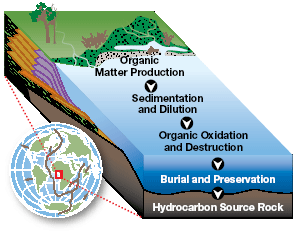
Colored dye highlights the flow of water and sediment in a
laboratory measurement of deposition processes.
Our proprietary workflow combines complex paleo-environmental
factors with biological, physical, and chemical processes to predict
source rock potential.
Award-Winning Research
The Society of Exploration Geophysicists (SEG) presented
its prestigious 2007 Distinguished Achievement Award
to ExxonMobil for “the first substantial test of controlled
source electromagnetics for direct hydrocarbon indication.”
The award recognizes ExxonMobil for contributions
that “substantially advanced the science of exploration
geophysics.” Our research led to the development of the
R3M method, which is used today to reduce exploration
risk in drilling programs around the globe.
Accurate Reservoir Prediction
ExxonMobil maintains an industry-leading capability for
gaining new insights into the development and spatial
distribution of sedimentary formations. Using two state-of-the-art sedimentology flume tanks, we make observations
and measurements that demonstrate how deltaic and
deepwater systems form over time. These direct observations
improve our ability to predict the distribution of
permeability in reservoirs and provide data to validate
our unique process-based numerical modeling methods.
These tools allow us to build geologic models based on
the fundamental principles of sediment transport and
deposition. Our work in this area has led to significantly
improved reservoir modeling and more accurate
performance prediction.
Colored dye highlights the flow of water and sediment in a
laboratory measurement of deposition processes.
EXXON MOBIL CORPORATION § 2007 FINANCIAL & OPERATING
REVIEW 23
Enhanced
Recovery and Processing of Heavy Oil
ExxonMobil is pursuing a broad range of research activities to improve the efficiency of heavy oil
recovery and processing. Our research program includes developing proprietary in situ recovery
processes, enhancing surface-related technologies to improve the economics of mining operations,
and improving upgrading technologies to increase the value of heavy oil and aid in its transport.
These new technologies will help ExxonMobil develop a current heavy oil and oil sands resource base
of nearly 15 billion barrels and gain access to new global opportunities.
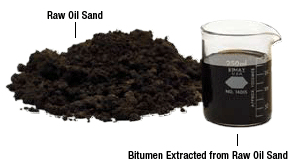
Our research for in situ heavy oil recovery includes innovative
processes to improve economic recovery in existing thermal heavy oil developments as well as novel,
proprietary processes
to unlock resources that are currently uneconomic. One research product is our Liquids Addition to
Steam for Enhanced
Recovery (LASER) process, jointly developed
with Imperial Oil Limited. This process
involves co-injecting solvent with steam, and
builds on the success and experience of our
Cyclic Steam Stimulation (CSS) process. A
staged approach of scaled laboratory
experiments, reservoir modeling, and field
testing has confirmed that LASER significantly
improves recovery relative to CSS alone. We
performed the first commercial application of
LASER in 2007 and plan to expand its use.
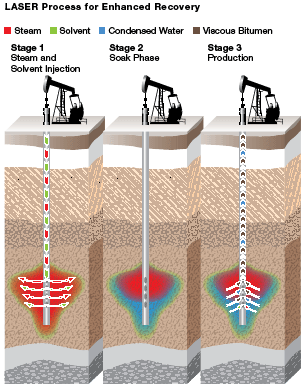
Research in mining and upgrading operations for
bitumen recovery addresses the economic
challenge of processing up to two tons of oil
sands to produce a single barrel of clean
bitumen. To produce the clean bitumen,
ExxonMobil and Imperial Oil Limited have
jointly developed a High-Temperature Paraffinic
Froth Treatment (HTPFT) process, which removes
tightly bound water and fine solids. HTPFT will
be applied in the Kearl development in northern
Alberta, Canada.
Once produced, bitumen must typically be
upgraded or diluted in order to transport it
to refineries for further processing.
ExxonMobil is developing novel methods using
proprietary catalysts and processes to improve
the quality of produced bitumen, thereby
increasing its value and facilitating
transportation.
Technical Training
The mission of ExxonMobil’s Upstream technical training effort is to develop the industry’s premier
technical workforce. Our technical curriculum, comprising 200 courses, covers a variety of
disciplines, including engineering, geoscience, technical computing, project management, commercial
operations, and safety. In 2007 over 7000 students attended 375 training sessions. A distinguishing
feature of the program is that 85 percent of the 550 instructors are ExxonMobil employees. By using
our own instructors, we incorporate proprietary technology and deliver research results to the
functional businesses. In addition, students get to know company experts and build personal
networks they can rely on throughout their careers. We continually assess and improve the
effectiveness of our training and develop new courses to meet emerging needs.
Geoscientists work together on a team problem in Fundamentals of Subsurface Interpretation,
one of the flagship courses for geoscience employees.
24 EXXON MOBIL CORPORATION § 2007 FINANCIAL & OPERATING REVIEW
Flexible Well Completion Method
ExxonMobil
drills and produces hydrocarbons from wells in increasingly remote and hostile environments,
including deepwater, arctic, and high pressure/high temperature reservoirs. The well completion
(the interface between the reservoir and the well) must perform
reliably in these challenging
conditions, sometimes for 20 years or longer. We have developed state-of-the-art analytical
capabilities that accurately predict the ability of a well to produce
at required flow rates and, at
the same time, control sand, water, and gas production. As a result, we are able to design and employ
simple, yet robust, well completions with self-activated subsurface controls that adapt to changing
production environments. This distinguishing combination of technologies can be used in a wide range of well
completions and has been successfully applied to
extended-reach wells in the Sakhalin-1 Chayvo field in Russia.
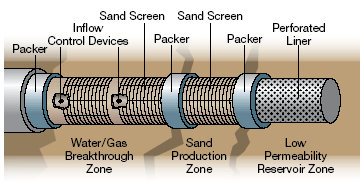
Flexible Well Completion design enables self-activated control of
unwanted sand and fluid inflow into the well.
Shared Earth Environment
The Shared Earth Environment is one component of the work ExxonMobil has under way to achieve
breakthrough performance in subsurface interpretation. The primary objective of this initiative is
to create a common visual environment and tools that interdisciplinary teams of geoscientists and
engineers can use to rapidly visualize, integrate, and analyze relevant technical data. The
improved integration and collaboration enabled by the Shared Earth Environment will enhance work
efficiency, improve business decisions through more effective communication and analysis, and
increase resource recovery through opportunity identification and optimized development plans.
3D models of subsurface oil and gas reservoirs used in field development planning integrate
geoscience interpretations and engineering predictions.
Flow Line Integrity
ExxonMobil uses laboratory experiments coupled with advanced analytical techniques to predict and
prevent corrosion in flow lines that gather oil and gas production. In our Materials & Corrosion
Laboratory, we accurately reproduce field conditions with unique test equipment. Modern surface
measurement techniques gather data, and statistical analysis tools estimate corrosion rates over
time. These results are used to calibrate a proprietary corrosion model, called CorrCast, which
predicts corrosion over the full range of flow line operating conditions. Using CorrCast
predictions, we can implement designs and operating practices for corrosion control to assure flow
line integrity.
ExxonMobil scientists analyze corrosion using an interferometric microscope.
EXXON MOBIL CORPORATION § 2007 FINANCIAL & OPERATING
REVIEW 25
Effective
Sour Gas Processing
ExxonMobil’s CFZ technology is being developed for potential application at sour gas fields where
high concentrations of CO2 and H2S create challenges for economic recovery of methane. By reducing
processing equipment and resulting costs, the CFZ process can facilitate commercial development of
these gas resources. The CFZ process differs from conventional separation methods by cryogenically
removing both CO2 and H2S in a controlled manner and using a simpler distillation process to purify
the methane and remove the unwanted compounds. These improvements are particularly significant when
integrated with reservoir injection of the acidic CO2 and H2S by-products, since they are produced
as a high-pressure liquid that requires less power and equipment for subsequent injection. Efforts
are under way to build a CFZ commercial demonstration plant at ExxonMobil’s LaBarge facility in
Wyoming.
CFZ is a cryogenic process for the single-step removal of CO2 and H2S from natural gas.
Reservoir Simulation Advances
ExxonMobil’s industry-leading reservoir simulator, EMpower, takes advantage of the latest
developments in multiple-CPU desktop computers. The EMpower simulator’s advanced parallel computing
algorithms determine the optimal way to divide a reservoir model into multiple calculation regions,
each of which is simultaneously modeled on a separate CPU. This parallel processing method allows
significant reductions in the time required to simulate reservoir fluid flow processes. The faster
computing times enable our teams to tackle more complex problems, such as modeling super-giant
fields with hundreds of wells, simultaneously modeling multiple fields that share processing
facilities and platforms, or using advanced optimization mathematics to identify development plans
that maximize economic recovery.
The EMpower simulator optimally divides a reservoir model into multiple calculation regions to make
the most effective use of multiple-CPU desktop computers.
Innovative Concepts for Oil Shale Recovery
Oil shale represents a significant unconventional
hydrocarbon resource, with estimates of the total volume
of oil-in-place exceeding 1.5 trillion equivalent
barrels in the United States alone. ExxonMobil is
pursuing multiple concepts for commercializing oil
shale, and our leading candidate technology is the
Electrofrac process for in situ oil shale conversion.
This process has the potential to provide cost-effective
recovery in deep, thick formations with less surface
disturbance than other proposed methods.
The Electrofrac process is designed to heat oil shale in
situ by creating hydraulic fractures in the oil shale
and filling the fractures with an electrically
conductive material. Electricity is conducted from one
end of the fracture to the other, making the fracture a
resistive heating element. Heat flows from the fracture
into the oil shale formation, gradually converting the
oil shale’s solid organic matter into oil and gas. The
oil and gas are then produced by conventional methods.
Results from laboratory experiments and numerical modeling
have been encouraging, and field tests have been initiated to
test Electrofrac process elements on a larger scale. Many years of research and development may be
required to
demonstrate the technical, environmental, and economic feasibility of this breakthrough technology.
The Electrofrac process could potentially be used for the subsurface conversion of oil shale into
producible hydrocarbons.
26 EXXON MOBIL CORPORATION § 2007 FINANCIAL & OPERATING REVIEW
DOWNSTREAM TECHNOLOGY
Our long-term commitment to investment in innovative downstream research, led by our scientists and
in collaboration with other leading researchers around the world, continues to deliver competitive
advantage by progressing our strategic business objectives: lower-cost processes, advantaged feeds,
and higher-value products.
Lower-Cost Processes
Advanced
Catalyst Development – ExxonMobil is an industry leader in the discovery, development, and
deployment of new refining catalysts. Catalysis — enabling the right chemical reactions and
increasing their rate — is integral to most refining technologies and critical to increasing
product yields and lowering processing costs.
Our investment in high throughput experimentation (HTE) technology, including experimental design,
automated materials synthesis and testing, and advanced data analysis, has allowed the rapid
development of improved catalysts. This advantageous research method has accelerated the next
generation of new technology in areas of demonstrated strength. HTE techniques enabled the latest
advancement in a new SCANfining catalyst to produce lower-sulfur gasoline. To meet the growing
demand for ultra-low-sulfur diesel (ULSD), ExxonMobil is developing a new step-out ULSD catalyst,
which was discovered using HTE tools. High throughput experimentation will continue to accelerate
the pace of improvements in the production of clean fuels.
High throughput experimentation (HTE) has allowed rapid advances in the development of new
catalysts, including the next generation of SCANfining catalyst recently deployed at our refinery
in Wakayama, Japan.
Complex
Modeling – Complex modeling tools developed by ExxonMobil scientists, utilizing
computational fluid dynamics, allow us to better use existing assets to strategic advantage.
Modeling complex system behavior enables ExxonMobil engineers to configure the hardware and process
conditions of our fluidized catalytic cracking units to produce gasoline more efficiently with
overall lower energy consumption.
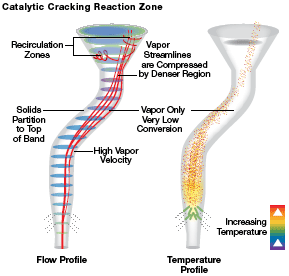
Computational fluid dynamics modeling of the fluidized catalytic cracking catalyst and
hydrocarbon feed allows improved efficiency in the production of gasoline.
Emissions
Reduction – ExxonMobil has long been a leader in environmental technology, licensing our
Wet Gas Scrubbing (WGS) technology for over two decades to remove sulfur dioxide and particulate
emissions from refinery flue gases. We have recently developed and are now licensing an enhancement
of our technology called WGS+. This technology uses a proprietary process within the scrubber to
remove nitrogen oxides, a combustion by-product and contributor to smog formation. This enhancement
provides a single, integrated air emissions control device for nitrogen oxides, sulfur dioxide, and
particulate removal. Developing and applying proprietary technology provides ExxonMobil with the
ability to reduce emissions in an effective and cost-efficient manner.
EXXON MOBIL CORPORATION § 2007 FINANCIAL & OPERATING REVIEW 27
Advantaged Feeds
Efficient and reliable refining operations are critical to our ability to process challenged feeds
and lower raw material costs.
ExxonMobil has developed a proprietary suite of tools to improve refining operability, enabling
additional feed flexibility. Operator Guidance Tools are used in our refineries by control room
personnel to keep the process units running smoothly. These tools provide key information on
process and equipment conditions to the operators, allowing proactive monitoring of process
conditions and problem analysis. Avoiding potential disruptions in the operation improves unit
safety and enables feedstock flexibility, resulting in improved business performance.
ExxonMobil continues to lead the industry in hydroprocessing technology for efficient conversion
of lower-value feedstocks into cleaner fuels and lubricants. In 2007 we began using our latest
proprietary catalyst, MSDW-3, in Jurong, Singapore, to improve lube basestock production. This
technology application is a direct example of research increasing feed flexibility and improving
energy conservation in refining.
ExxonMobil scientists utilized state-of-the-art pilot plants to develop the next generation of
proprietary catalyst for production of lube basestocks, MSDW-3.
Higher-Value Products
Technology plays an important role in developing new products, such as our advanced lubricants,
that benefit consumers and the environment.
ExxonMobil has developed a series of high-performance synthetic lubricants utilizing advanced
additive and synthetic basestock technology to provide environmental benefits over conventional
products. Our Emission System Protection (ESP) product line of passenger car and heavy-duty diesel
engine oil helps control vehicle emissions by extending the life of exhaust treatment technology,
such as diesel particulate traps and catalytic converters. The flagship products in this line are Mobil
1 ESP for passenger cars and Mobil 1 Delvac ESP for heavy-duty trucks. In addition, the Mobil 1
Extended Performance product line in the United States allows car owners to extend oil change
intervals to 15,000 miles, reducing the total volume of used oil to be disposed of each year.
Mobilgear SHC XMP industrial gear oil is designed to provide extra protection for wind turbine gear
boxes, supporting the production of renewable energy.
ExxonMobil supplies Mobil 1 branded lubricants and fuels designed specifically for use by
the Vodafone McLaren Mercedes Formula 1 team, contributing to the team’s many victories. These
exceptionally severe racing conditions are the ultimate testing environment for lubricants and
fuels and are a proving ground for continuous advancement of the Mobil 1 branded products for
everyday use.
Vodafone McLaren Mercedes Formula 1 driver Lewis Hamilton (left) and engineer Dr. Tony Harlow
refill the Mobil 1 lubricant used by the team.
28 EXXON MOBIL CORPORATION § 2007 FINANCIAL & OPERATING REVIEW
CHEMICAL TECHNOLOGY
Within the Chemical technology portfolio, we have a number of activities that allow us to capture
value from low-cost, advantaged feedstocks and from more efficient operating processes. Our
research in premium products focuses on translating the evolving higher demands of our customers
into value-added products that capitalize on our process capabilities.
Lower-Cost Processes
We have a number of programs targeting more efficient, lower-cost processes. Following a
significant development program, ExxonMobil recently began commercial production of butyl rubber at
our Notre-Dame-de-Gravenchon plant in France using a breakthrough process technology. This
technology allows the reactors to be operated at much more efficient temperatures for higher
throughput and lower energy usage.
We have also developed state-of-the-art PxMax technology for production of paraxylene. The
technology can offer significant debottleneck opportunities by increasing paraxylene yields in
existing equipment while lowering costs. PxMax technology will be employed at the aromatics plant
expansion in Rotterdam, the Netherlands.
Using our breakthrough process technology, we have demonstrated a 20-percent increase in our
ability to produce butyl rubber in the polymerization section of existing plants.
Premium Product Development
Our Chemical business also continues to focus on delivering higher-value premium products to the
market.
Our extensive product development facilities include high throughput experimentation (HTE) catalyst
screening, large-scale production lines, and plastic film lines. A recent product development
example is the commercialization of Enable metallocene-catalyzed polyethylene, which has
outstanding processability while retaining excellent film properties.
We have also recently developed a dynamically vulcanized alloy (DVA) of Exxpro specialty elastomers
and nylon. This material may be blown into film and used as the air barrier for the inner liner of
tires. Tires manufactured with DVA liners are lighter weight, which improves tire durability and
reduces fuel consumption.
Metallocene catalysts allow researchers to tailor product properties to meet customer needs.
ExxonMobil is a leader in this technology.
Advantaged Feeds
Many of our programs are centered around developing new processes to run advantaged feeds. Use of
these lower-cost feeds provides greater flexibility in meeting marketing demands while managing raw
material costs.
We also continue to invest in breakthrough technology development. Our methanol-to-olefins program
is well developed, and we have extended our research to include a methanol-to-aromatics program.
Development of technology to upgrade bottom-of-the-barrel streams and discovery of game-changing
conversion processes set us apart from competition and will extend our competitive advantage for
the future.
ExxonMobil has over 100 patent applications filed in methanol conversion technology for lower-cost
olefins and aromatics.
EXXON MOBIL CORPORATION § 2007 FINANCIAL & OPERATING REVIEW 29
Integration
The integration of our businesses is a competitive advantage that enables ExxonMobil to capture
new opportunities and grow shareholder returns. Integration between business functions delivers
value through superior opportunity identification, implementation of best practices, advantaged
technology, and operational optimization.
SUPERIOR OPPORTUNITY IDENTIFICATION
We are uniquely positioned in the industry due to the breadth and depth of our technological and
operational capabilities in each of our Upstream, Downstream, and Chemical businesses. As a result,
we are able to identify and deliver high-quality, integrated projects that generate increased value
to our shareholders and to resource owners through economies of scale, use of proprietary
technology, superior project and operations management, and optimization of raw materials and
products.
ExxonMobil, along with our project partners, formed the only fully integrated refining,
petrochemicals, and fuels marketing venture with foreign participation in China. Additionally we
are progressing studies with Qatar Petroleum for a petrochemical complex utilizing feedstock from
gas development projects in Qatar’s North Field.
IMPLEMENTATION OF BEST PRACTICES
Integration across our Upstream, Downstream, and Chemical businesses allows us to capture benefits
by sharing best practices, utilizing centralized support services, and leveraging the expertise of
our employees around the world. For example, our capital investment portfolio is managed using a
globally consistent management system. While each investment is unique, our approach to project
development and management utilizes our time-tested, consistent best practices: optimized concept
selection, comprehensive project planning, disciplined project execution, and reappraisal of
project performance.
ADVANTAGED TECHNOLOGY
ExxonMobil takes an integrated approach to the development and deployment of new technology.
Our researchers, scientists, engineers, and operating functions work together to identify key
business challenges that require technical solutions. The ongoing dialogue allows us to
concentrate research efforts in the highest-value areas, driven by our business needs.
Technology development represents only part of our integration advantage. ExxonMobil’s ability
to rapidly deploy new solutions through our global functional organization allows us to
utilize technologies and subject matter experts to their fullest.
OPERATIONAL OPTIMIZATION
Through years of experience, we have developed proprietary technologies that allow us to optimize
operations across our functional businesses. Our Molecule Management technology includes advanced
molecular fingerprinting and modeling tools that enable us to process the optimal mix of crudes and
maximize the yield of higher-value products and feedstocks. Integrated process models enable our
refineries to tailor feedstocks to our chemical plants in order to maximize value. Sophisticated
process control technologies optimize unit performance, increase reliability, and decrease
operating costs. Our ongoing optimization activities allow us to maximize the value of every
molecule.
Integrated Concepts
ExxonMobil has expertise throughout the upstream, downstream, and chemical value chain. Our
technology, operating experience, and project management skills allow us to identify
opportunities to maximize resource value.
In Nigeria, a marine transport vessel installs a new
offshore platform at the East Area NGL II project in late
2007. The new facilities will extract natural gas liquids
and export them to the onshore Bonny River terminal.
| |
|
|
|
|
|
|
|
|
|
|
|
|
|
|
|
|
|
|
|
|
| UPSTREAM STATISTICAL RECAP |
|
2007 |
|
|
2006 |
|
|
2005 |
|
|
2004 |
|
|
2003 |
|
| |
Earnings (millions of dollars) |
|
|
26,497 |
|
|
|
26,230 |
|
|
|
24,349 |
|
|
|
16,675 |
|
|
|
14,502 |
|
Liquids production (thousands of barrels per day) |
|
|
2,616 |
|
|
|
2,681 |
|
|
|
2,523 |
|
|
|
2,571 |
|
|
|
2,516 |
|
Natural gas production
available for sale (millions of cubic feet per day) |
|
|
9,384 |
|
|
|
9,334 |
|
|
|
9,251 |
|
|
|
9,864 |
|
|
|
10,119 |
|
Oil-equivalent production (thousands of barrels per day) |
|
|
4,180 |
|
|
|
4,237 |
|
|
|
4,065 |
|
|
|
4,215 |
|
|
|
4,203 |
|
Proved reserves replacement(1)(2) (percent) |
|
|
132 |
|
|
|
129 |
|
|
|
129 |
|
|
|
125 |
|
|
|
107 |
|
Resource additions(2) (millions of oil-equivalent barrels) |
|
|
2,010 |
|
|
|
4,270 |
|
|
|
4,365 |
|
|
|
2,940 |
|
|
|
2,110 |
|
Average capital employed(2) (millions of dollars) |
|
|
63,565 |
|
|
|
57,871 |
|
|
|
53,261 |
|
|
|
50,642 |
|
|
|
47,672 |
|
Return on average capital employed(2) (percent) |
|
|
41.7 |
|
|
|
45.3 |
|
|
|
45.7 |
|
|
|
32.9 |
|
|
|
30.4 |
|
Capital and exploration expenditures(2) (millions of
dollars) |
|
|
15,724 |
|
|
|
16,231 |
|
|
|
14,470 |
|
|
|
11,715 |
|
|
|
11,988 |
|
|
|
|
| (1) |
|
Excluding asset sales, the 2007 Venezuela expropriation, and year-end price/cost
effects. |
| |
| (2) |
|
See Frequently Used Terms on pages 94 through 97. |
EXXON MOBIL CORPORATION § 2007 FINANCIAL & OPERATING
REVIEW 31
EXPLORATION, DEVELOPMENT, PRODUCTION, AND GAS & POWER MARKETING
UPSTREAM STRATEGIES
ExxonMobil’s fundamental Upstream strategies guide our global exploration, development, production,
and gas and power marketing activities:
| § |
|
Identify and pursue all attractive exploration opportunities |
| |
| § |
|
Invest in projects that deliver superior returns |
| |
| § |
|
Maximize the profitability of existing oil and gas production |
| |
| § |
|
Capitalize on growing natural gas and power markets |
These strategies are underpinned by our relentless focus on safety, health, and environmental
performance. Our commitment to the ongoing development and application of innovative technologies
is key to the success of our Upstream strategies.
|
|
|
| (1) |
|
Royal Dutch Shell, BP, and Chevron values are estimated on a consistent basis with ExxonMobil,
based on public information. |
2007 Results and Highlights
Achieved best-ever employee safety performance.
Earnings were a record $26.5 billion.
Upstream return on average capital employed was 42 percent in 2007 and has averaged 39 percent over
the past five years.
Earnings per oil-equivalent barrel were $17.37, exceeding those of our competitors.
Total liquids production and natural gas production available for sale was 4.2 million
oil-equivalent barrels per day, the highest among our competitors.
Replaced 101 percent of production with proved oil and gas reserve additions of 1.6 billion
oil-equivalent barrels, including asset sales and the effect of the Venezuela expropriation, and excluding year-end
price/cost effects.
Resource base additions totaled 2.0 billion oil-equivalent barrels. ExxonMobil’s
resource base now stands at 72 billion oil-equivalent barrels.
Finding and resource-acquisition costs were $0.97 per oil-equivalent barrel.
Upstream capital and exploration spending was $15.7 billion, driven by an active exploration
program, selective investment in a strong portfolio of development projects, and continued
investment to enhance the value of existing assets.
UPSTREAM COMPETITIVE ADVANTAGES
Portfolio Quality – The quality, size, and diversity of
ExxonMobil’s resource base and project inventory underpin a strong long-term outlook.
Global Integration – The global functional Upstream companies work with the Downstream and Chemical
businesses to identify and deliver integrated solutions that maximize resource value.
Discipline and Consistency – ExxonMobil rigorously assesses the world’s hydrocarbon resources and
pursues only the most attractive opportunities. We explore, develop, produce, and market using globally deployed management systems that ensure application of the highest
technical, operational, and commercial standards.
Value Maximization – From optimum development concept selection through mid- and late-life
investments to increase reservoir recovery, ExxonMobil maximizes resource value over the life of
each asset.
Long-Term perspective – Consistent, selective capital investment and focused technology development
ensure robust investments that reward shareholders over the long term.
32 EXXON MOBIL CORPORATION § 2007 FINANCIAL & OPERATING REVIEW
Identify and Pursue All Attractive Exploration Opportunities
ExxonMobil is positioned to identify, evaluate, pursue, and capture the highest-quality
opportunities. Our global organization explores in a diverse range of geological and geographical
environments, covering the full range of resource life cycle and type, including:
| § |
|
New exploration plays and concepts that typically have high
uncertainty but large resource potential to provide significant
long-term resource growth |
| |
| § |
|
Unconventional resources such as tight gas, heavy oil, and oil sands
that can provide profitable, long-plateau production |
| |
| § |
|
Further exploration of established hydrocarbon provinces and mature
plays that provide near-term resource additions and production |
| |
| § |
|
Discovered fields that are undeveloped or partially developed |
Advanced, integrated visualization capabilities allow geoscientists and engineers to collaborate in
an interactive environment.
Each year ExxonMobil makes significant investments in new data and fundamental scientific analyses
to identify new resource capture opportunities. The combination of world-class technical expertise
and our extensive global database provides a distinct competitive advantage in the identification,
evaluation, pursuit, and capture of new opportunities.
ExxonMobil has developed and implemented a proprietary, interactive database that captures the
results of decades of basin analysis and historical exploration activity around the globe. This
system is used to assemble data, interpretations, and quantitative assessments for each area in
which ExxonMobil explores. It enables ExxonMobil geoscientists to identify areas for more in-depth
study and ultimately define new opportunities to pursue. Once identified, opportunities are
assessed and screened for technical and economic viability, as well as materiality, on a globally
consistent basis. Only the best, most robust opportunities are selected for
further evaluation and investment. ExxonMobil has the research and technical capability to develop
and deploy new technology when existing capabilities are not sufficient to effectively evaluate a
particular resource.
ExxonMobil’s disciplined exploration process delivers cost-effective, high-quality resources and
promotes long-term resource additions and production growth.
In 2007 this approach resulted in the successful capture of 14 conventional and unconventional
opportunities in new, untested areas as well as established ones.
ExxonMobil’s gross exploration acreage totaled 118 million acres in 31 countries at year-end 2007.
This acreage provides a high-quality, geographically and geologically diverse portfolio of
opportunities for potential resource and production growth.
EXXON MOBIL CORPORATION § 2007 FINANCIAL & OPERATING REVIEW 33
2007 KEY EXPLORATION CAPTURES
Australia – ExxonMobil expanded its position in the Greater Gorgon area by acquiring interests in
the 730,000-acre Block WA-392-P, south of the Jansz discovery, and the 1.4-million-acre Block
WA-268-P, northwest of Jansz. ExxonMobil holds 25-percent interest in both blocks. ExxonMobil
also acquired a 65-percent operating interest in the 820,000-acre Block WA-318-P in the Bonaparte
Basin, offshore northern Australia. Seismic acquisition in support of potential future drilling is
planned for 2008.
Canada – ExxonMobil Canada and majority-owned affiliate Imperial Oil were jointly awarded
100-percent interest in the EL446 block in the Beaufort Sea, offshore Canada. The block covers over
500,000 acres and is located 75 miles from shore in water depths ranging from 200 to 4000 feet.
Near-term plans include a 3D seismic survey to identify potential drilling opportunities.
Germany – ExxonMobil was awarded four exploration licenses by the Lower Saxony and North
Rhine-Westphalia states, covering 1.3 million acres of the Lower Saxony Basin. ExxonMobil operates
these licenses with a 67-percent interest. Drilling is expected to commence in 2008.
Greenland – ExxonMobil was awarded interests in Blocks 4 and 6 located 30 to 60 miles offshore
western Greenland. ExxonMobil will operate Block 6 (ExxonMobil interest, 44 percent) through the
exploration, development, and production phases and Block 4 (ExxonMobil interest, 29 percent)
after the exploration phase. These adjacent blocks cover a total of nearly 6.7 million acres.
Indonesia – ExxonMobil was awarded the 1-million-acre Mandar block offshore Sulewesi. Award of
this deepwater block follows capture of the Surumana block in 2006. Seismic data acquisition is
planned for 2008 in support of exploration drilling. ExxonMobil holds 100-percent interest in each
block.
Libya – ExxonMobil was awarded operatorship of Contract Area 20 (ExxonMobil interest, 22
percent), covering 2.5 million acres offshore Libya. Seismic acquisition commenced in the fourth
quarter of 2007, and drilling is planned for 2009. ExxonMobil also signed an interim agreement in
2007 for the adjacent Contract Area 21. The agreement is expected to be ratified in 2008.
New Zealand – ExxonMobil was awarded the 4-million-acre PEP50117 license (ExxonMobil interest, 90
percent) in the 2007 New Zealand Great South Basin tender. Seismic data has been acquired and will
be used to further assess the potential of this large block.
U.S. Gulf of Mexico – ExxonMobil was the high bidder on 13 leases in the Gulf of Mexico Central
Sale 205. At year-end 2007, five blocks in the deepwater Lower Tertiary trend had been awarded to
ExxonMobil.
34 EXXON MOBIL CORPORATION § 2007 FINANCIAL & OPERATING REVIEW
Invest in Projects That Deliver Superior Returns
ExxonMobil continues to deliver superior returns from Upstream projects through disciplined
investment and industry-leading project planning and execution.
As project scale and complexity increase across the industry, the challenge to bring new energy
supplies to market on budget and on schedule grows. Through our ability to deliver superior project
execution results, ExxonMobil consistently meets these new challenges and maximizes value to
resource owners and to our shareholders.
Superior project execution begins with selecting the design and operating concept that will be
robust through a range of uncertainties and will deliver maximum value over the life of the asset.
It requires a commitment to and investment in technology to develop innovative solutions that lower
costs and increase reliability. At ExxonMobil, we spend a great deal of time on execution
planning, or the “how to” regarding development of major projects. These essentials are enhanced by
the experience of our project management professionals and our global functional organization that
facilitates the swift transfer of lessons learned and best practices around the world.
The combination of our global processes, proprietary technology, and project management experience
results in industry-leading project performance.
ExxonMobil has a geographically diverse portfolio of about 120 projects that are expected to
develop over 24 billion oil-equivalent barrels (net). Many of these developments are located in
challenging environments and include deepwater, heavy oil/oil sands, tight gas, arctic, LNG, and
acid/sour gas projects. This large, diverse portfolio provides ExxonMobil the ability to
selectively fund those projects that will be robust over a wide range of economic conditions.
Project Execution
ExxonMobil continues to demonstrate the ability to deliver projects on time and on budget. Over
the last five years, the average facilities cost and schedule of 44 ExxonMobil-operated projects
came within 5 percent of the level projected at funding.
EXXON
MOBIL CORPORATION § 2007 FINANCIAL & OPERATING
REVIEW 35
Maximize Profitability of Existing Oil and Gas Production
ExxonMobil applies the most cost-effective technology and operations management systems to
every asset to maximize the commercial recovery of hydrocarbons.
ExxonMobil’s diverse and robust asset base is balanced between mature producing fields and fields
that are early in their producing lives.
ExxonMobil employs a global organization to manage oil and gas assets. Using this structure, we
are able to leverage the transfer of technology and best practices across our global portfolio. We
establish priorities on a worldwide basis and deploy resources when and where they are needed,
drawing on an experienced, dedicated, and diverse workforce of exceptional quality.
Our strategies place significant emphasis on managing and optimizing base performance and
continuously generating opportunities to maximize the value of our assets. High-quality reservoir
management and rigorous depletion planning ensure optimum long-term performance from each of our
fields and enhance production from existing wells. We continually invest in our existing asset base
to enhance resource recovery, maximize profitability, and extend field life. New production volumes
are generated through work programs including workovers, drilling new wells, and implementing
secondary or tertiary recovery projects to access and develop resources not captured during the
initial field development.
All of these activities are performed with a structured focus on cost management and capital
discipline in combination with a steadfast commitment to operations excellence. Operations
integrity is fundamental to our success and is a top priority.
We place significant emphasis on maximizing production uptime through our disciplined focus on
integrity and facility reliability. We maximize uptime through reliability improvement activities,
rigorous scheduled maintenance planning, and disciplined root-cause analysis of downtime events.
We are a recognized industry leader in the application of cost-effective technology for enhanced
oil recovery (EOR). We have broad experience with water and gas injection, heavy oil steamflooding,
and sour gas injection to increase reservoir recovery.
Our asset base is continuously under review to ensure that every asset is contributing to our
strategic objectives to the maximum extent possible.
Our Upstream business consistently generates more earnings per barrel than our competitors. This is
a reflection of our commitment to maximizing recovery, superior execution, and investment
discipline.
| (1) |
|
Royal Dutch Shell, BP, and Chevron values calculated on a consistent basis with ExxonMobil,
based on public information. |
36 EXXON MOBIL CORPORATION § 2007 FINANCIAL & OPERATING REVIEW
Capitalize on Growing Natural Gas and Power Markets
Growth in world gas and power demand combined with ExxonMobil’s global reach provides a strong
platform to maximize the value of our gas, natural gas liquids, and power operations. Our sales and
development activities extend to almost all major and developing markets. ExxonMobil sells about 11
billion cubic feet per day of natural gas to customers in a variety of sectors including power
companies and industrial users. We also manage about 1 million barrels per day of natural gas
liquids, generate a significant amount of power, and are an important marketer of helium.
With global gas demand growing and existing local supplies declining in many areas of the world,
the development of new resources is key to the continued supply of the world’s gas requirements.
In North America, ExxonMobil is a major gas producer and processor with production from the Gulf of
Mexico, the onshore Gulf Coast, the mid-continent United States, western Canada, and offshore
eastern Canada. We continue to expand production of our significant tight gas resources in the
Piceance Basin in Colorado. ExxonMobil has a leading position in arctic gas resources in the
Mackenzie Delta region of northern Canada and on the North Slope of Alaska.
Liquefied natural gas (LNG) will play a greater role in our activities in the United States as we
complete construction of the Golden Pass LNG regasification terminal in Texas and seek to permit a
new terminal offshore New Jersey.
In addition to natural gas, our Shute Creek plant in Wyoming is one of the world’s leading sources
of helium.
ExxonMobil is a leading gas producer in Europe through ownership in many key assets in the
Netherlands, Germany, and the North Sea. Natural gas demand in Europe continues to grow while local
production is expected to begin declining in the next few years, creating the need for new
supplies. To help meet this need, ExxonMobil and our partners are developing new resources, such as the Ormen Lange field offshore Norway, and are nearing completion
of LNG import terminals in the United Kingdom and Italy. Both the South Hook terminal in Milford
Haven, Wales, and the Adriatic terminal offshore Italy are expected to be operational in 2008.
ExxonMobil remains among the largest suppliers of natural gas in Australia and Malaysia and also
sells gas in Thailand, Russia Far East, Qatar, and elsewhere. Our LNG ventures provide significant
volumes of gas to key Asian markets, including Japan, South Korea, India, and Taiwan.
A major strength of our marketing activities is the ability to integrate our Upstream, Downstream,
and Chemical businesses. This advantage allows us to optimize our portfolio to respond to market
demands most effectively and profitably. Applying this strong integrated focus to the global scale
of our operations delivers significant competitive advantage.
Gas & Power Marketing constantly assesses conditions across the world’s gas and power markets
to optimize ExxonMobil’s global portfolio.
POWER ACTIVITIES
ExxonMobil has interests in electric power generation facilities with total capacity of over 15,500 megawatts.
These interests include a majority interest in the Castle Peak Power Company, which generates and sells electricity in Hong Kong and mainland China. ExxonMobil is
an industry leader in the application of cogeneration technology, with interests in about 4500
megawatts of cogeneration capacity that is used primarily to supply our own power and steam
demands. With facilities under construction around the world, we expect to have interests in
cogeneration capacity of over 5000 megawatts in the next three years.
EXXON MOBIL CORPORATION § 2007 FINANCIAL & OPERATING
REVIEW 37
LNG Market
Global LNG demand is expected to grow by more than 4 percent per year through 2030, driven by
demand in North America and Europe as well as Asia Pacific markets. By 2030 LNG demand is expected
to exceed 500 million tons per year, representing almost 16 percent of the world’s gas demand.
|
|
|
| (1) |
|
Includes joint-marketed interests |
ExxonMobil is currently participating in LNG production in Qatar and Indonesia with a combined
gross capacity of approximately 35 million tons per year, supplying markets in Asia, Europe, and
North America. Construction is progressing in Qatar on four additional LNG trains that will
increase gross capacity by over 30 million tons per year. In addition, ExxonMobil is progressing
new LNG opportunities in Asia and West Africa. Once these opportunities are brought onstream,
ExxonMobil expects to be participating in gross LNG capacity of approximately 100 million tons per year,
with significant volumes being placed in the growing markets of North America,
Europe, and Asia Pacific.
ExxonMobil is also participating with Qatar Petroleum and others in the
construction of LNG regasification terminals on the U.S. Gulf Coast; Milford
Haven, United Kingdom; and offshore Italy. ExxonMobil is seeking regulatory approval
to build a floating LNG receiving terminal, called
BlueOcean Energy, approximately 20 miles off
the coast of New Jersey. The terminal would
have the capacity to supply approximately
1.2 billion cubic feet of natural gas per day,
enough to meet the needs of more than
5 million residential consumers. BlueOcean Energy
is expected to start up during the middle of the
next decade.
ExxonMobil and Qatar Petroleum retain capacity rights in the Fluxys Zeebrugge terminal in Belgium.
Castle Peak Power Company, an ExxonMobil joint venture with China Light and Power, is progressing
an onshore terminal in Hong Kong for LNG imports. ExxonMobil participates in the Shimizu terminal
in Japan that is currently being expanded.
Through our large global portfolio of gas resources and integrated LNG operations, ExxonMobil
is well-positioned to help meet the world’s growing gas and power needs.
38 EXXON MOBIL CORPORATION § 2007 FINANCIAL & OPERATING REVIEW
Major Development Projects
ExxonMobil participated in seven
major project start-ups in 2007,
with 12 more anticipated in 2008.
Beyond 2008, an additional
47 major projects are in various
stages of project planning and execution.
There are about 120 projects in the portfolio,
including minor projects.
RasGas Train 5 – The Ras Laffan Liquefied Natural Gas Company II Train 5 (ExxonMobil interest, 30
percent) in Qatar was completed under budget and ahead of schedule. The onshore facilities came
online in November 2006 and the offshore facilities in January 2007. With production of 4.7 million
tons per year of LNG, it is the third train built of this size at RasGas with the “Design One,
Build Multiple” strategy, enabling this project to outperform the original cost and schedule
estimates.
Production of LNG from Ras Laffan Liquefied Natural Gas Company II Train 5, shown at left, began
just 29 months after major construction contracts were awarded.
Rosa – Production from the Rosa field (ExxonMobil interest, 20 percent) in Angola began in June
2007. This 360-million-barrel development is located approximately 85 miles offshore in a water
depth of 4500 feet. The field is tied back to the existing Girassol floating production, storage,
and offloading (FPSO) vessel. This development included a major upgrade to the FPSO’s processing
system that will maintain the production plateau at 250 thousand barrels per day until early into
the next decade.
Tengiz Phase 1 – Initial oil production from the first expansion of the Tengiz development
(ExxonMobil interest, 25 percent) in Kazakhstan, was achieved in October 2007. This expansion, when
complete, will integrate a second-generation gas-handling project with sour-gas injection,
resulting in incremental production of 285 thousand barrels of oil per day (gross).
Statfjord Late Life – The Statfjord Late Life project (ExxonMobil interest, 21 percent) offshore
Norway started up in October 2007. This project will develop 1.1 trillion cubic feet of gas and 186
million barrels of oil and natural gas liquids (gross). The project includes gas cap blowdown,
reservoir depressurization, and facility debottlenecking, as well as a new gas export pipeline that
connects into the U.K. gas pipeline system.
Ormen Lange – The Ormen Lange project (ExxonMobil interest, 7 percent) offshore Norway started
production in September 2007. The project will develop almost 13 trillion cubic feet of gas and 175
million barrels of natural gas liquids (gross). The gas is being transported by the world’s longest
subsea export pipeline, approximately 750 miles across the North Sea, from a new processing plant
in Nyhamna, Norway, to the Easington terminal in the United Kingdom.
Waddenzee – Start-up of the Moddergat and Nes fields (ExxonMobil interest, 40 percent) in the
Waddenzee area of the Netherlands was achieved on time and on budget in 2007. Production and
environmental permits have been secured for development of the Lauwersoog and Vierhuizen fields,
also in the Waddenzee area.
EXXON MOBIL CORPORATION § 2007 FINANCIAL & OPERATING
REVIEW 39
Marimba North – The Marimba North project (ExxonMobil interest, 40 percent) began production in
September 2007 and will develop 80 million barrels of oil in approximately 3900 feet of water, 90
miles off the coast of Angola. The project is a subsea tie-back to the Kizomba A development and
was completed ahead of schedule and within budget. Major components include subsea wells, a single
drill center, approximately 20 miles of flowlines, and a riser system that ties the production
flowline into the Kizomba A Tension Leg Platform. This milestone was achieved safely without any
production impact to the existing Kizomba A operations. With the addition of Marimba North, Block
15 will produce about 540 thousand barrels of oil per day with combined recoverable resources of
approximately 2 billion barrels of oil.
The Marimba North project, a subsea development offshore Angola that started up in 2007, utilizes
facilities on the Kizomba A FPSO, shown here.
MAJOR
PROJECT START - UPS
| |
|
|
|
|
|
|
|
|
|
|
|
|
|
|
|
|
|
|
|
|
|
|
| |
|
|
|
Target Peak |
|
|
|
|
|
|
|
|
|
|
|
|
| |
|
|
|
Production (Gross) |
|
|
ExxonMobil |
|
|
|
|
|
|
|
|
|
| |
|
|
|
Liquids |
|
|
Gas |
|
|
Working |
|
|
|
|
|
|
|
|
|
| |
|
|
|
(KBD) |
|
|
(MCFD) |
|
|
Interest (%) |
|
|
|
|
|
|
|
|
|
| 2007 (Actual) |
|
|
|
|
|
|
|
|
|
|
|
|
|
|
|
|
|
|
|
|
Angola |
|
Marimba North |
|
|
40 |
|
|
|
— |
|
|
|
40 |
|
|
|
n |
|
|
|
|
|
|
|
Rosa |
|
|
140 |
|
|
|
— |
|
|
|
20 |
|
|
|
l |
|
|
|
|
|
Kazakhstan |
|
Tengiz Phase 1 |
|
|
285 |
|
|
|
350 |
|
|
|
25 |
|
|
|
l |
|
|
|
|
|
Netherlands |
|
Waddenzee |
|
|
— |
|
|
|
195 |
|
|
|
40 |
|
|
|
l |
|
|
|
|
|
Norway |
|
Ormen Lange |
|
|
35 |
|
|
|
2385 |
|
|
|
7 |
|
|
|
l |
|
|
|
|
|
|
|
Statfjord Late Life |
|
|
80 |
|
|
|
315 |
|
|
|
21 |
|
|
|
l |
|
|
|
|
|
Qatar |
|
RasGas Train 5 |
|
|
45 |
|
|
|
740 |
|
|
|
30 |
|
|
|
5 |
|
|
|
|
|
|
|
|
|
|
|
|
|
|
|
|
|
|
|
|
|
|
|
|
|
|
|
|
| 2008 (Projected) |
|
|
|
|
|
|
|
|
|
|
|
|
|
|
|
|
|
|
|
|
Angola |
|
Kizomba C — Mondo |
|
|
100 |
|
|
|
— |
|
|
|
40 |
|
|
|
n |
|
|
|
|
|
|
|
Kizomba C — Saxi/Batuque |
|
|
100 |
|
|
|
— |
|
|
|
40 |
|
|
|
n |
|
|
|
|
|
Azerbaijan |
|
ACG Phase 3 |
|
|
260 |
|
|
|
— |
|
|
|
8 |
|
|
|
l |
|
|
|
|
|
Italy |
|
Adriatic LNG Terminal |
|
|
— |
|
|
|
— |
|
|
|
45 |
|
|
|
5 |
|
|
|
|
|
Malaysia |
|
Jerneh B |
|
|
— |
|
|
|
150 |
|
|
|
100 |
|
|
|
n |
|
|
|
|
|
Norway |
|
Volve |
|
|
50 |
|
|
|
30 |
|
|
|
30 |
|
|
|
l |
|
|
|
|
|
Nigeria |
|
East Area Natural Gas Liquids II |
|
|
40 |
|
|
|
— |
|
|
|
51 |
|
|
|
n |
|
|
|
|
|
Qatar |
|
Qatargas II Train 4 |
|
|
80 |
|
|
|
1250 |
|
|
|
30 |
|
|
|
5 |
|
|
|
|
|
|
|
RasGas Train 6 |
|
|
75 |
|
|
|
1250 |
|
|
|
30 |
|
|
|
5 |
|
|
|
|
|
U.K. |
|
South Hook LNG Terminal |
|
|
— |
|
|
|
— |
|
|
|
24 |
|
|
|
5 |
|
|
|
|
|
|
|
Starling |
|
|
5 |
|
|
|
110 |
|
|
|
72 |
|
|
|
l |
|
|
|
|
|
U.S. |
|
Thunder Horse |
|
|
210 |
|
|
|
185 |
|
|
|
25 |
|
|
|
l |
|
|
|
|
|
|
|
|
|
|
|
|
|
|
|
|
|
|
|
|
|
|
|
|
|
|
|
|
| 2009-2010 (Projected) |
|
|
|
|
|
|
|
|
|
|
|
|
|
|
|
|
|
|
|
|
Canada |
|
Hibernia Southern Expansion |
|
|
80 |
|
|
|
— |
|
|
|
22 |
|
|
|
n |
|
|
|
|
|
Norway |
|
Tyrihans |
|
|
80 |
|
|
|
335 |
|
|
|
12 |
|
|
|
l |
|
|
|
|
|
Qatar |
|
Al Khaleej Gas Phase 2 |
|
|
70 |
|
|
|
1250 |
|
|
|
80 |
* |
|
|
n |
|
|
|
|
|
|
|
RasGas Train 7 |
|
|
75 |
|
|
|
1250 |
|
|
|
30 |
|
|
|
5 |
|
|
|
|
|
|
|
Qatargas II Train 5 |
|
|
80 |
|
|
|
1250 |
|
|
|
18 |
|
|
|
5 |
|
|
|
|
|
U.S. |
|
Golden Pass LNG Terminal |
|
|
— |
|
|
|
— |
|
|
|
18 |
|
|
|
5 |
|
|
|
|
|
|
|
Piceance Phase 1 |
|
|
2 |
|
|
|
200 |
|
|
|
100 |
|
|
|
n |
|
|
|
|
|
|
|
|
|
|
|
|
|
|
|
|
|
|
|
|
|
|
|
|
|
|
|
|
| |
| 2011+ (Projected) |
|
|
|
|
|
|
|
|
|
|
|
|
|
|
|
|
|
|
|
|
Angola |
|
Cravo-Lirio-Orquidea-Violeta |
|
|
150 |
|
|
|
— |
|
|
|
20 |
|
|
|
l |
|
|
|
|
|
|
|
Gindungo-Canela-Gengibre |
|
|
120 |
|
|
|
— |
|
|
|
15 |
|
|
|
l |
|
|
|
|
|
|
|
Kizomba Satellites |
|
|
125 |
|
|
|
— |
|
|
|
40 |
|
|
|
n |
|
|
|
|
|
|
|
Palas-Astrea-Juno |
|
|
150 |
|
|
|
— |
|
|
|
25 |
|
|
|
l |
|
|
|
|
|
|
|
Pazflor |
|
|
200 |
|
|
|
— |
|
|
|
20 |
|
|
|
l |
|
|
|
|
|
|
|
Plutao-Saturno-Venus-Marte |
|
|
150 |
|
|
|
— |
|
|
|
25 |
|
|
|
l |
|
|
|
|
|
Australia |
|
Greater
Gorgon Initial Development |
|
|
15 |
|
|
|
2250 |
|
|
|
25 |
|
|
|
l |
|
|
|
|
|
|
|
Kipper / Tuna |
|
|
15 |
|
|
|
175 |
|
|
|
41 |
|
|
|
n |
|
|
|
|
|
|
|
Scarborough |
|
|
— |
|
|
|
965 |
|
|
|
50 |
|
|
|
n |
|
|
|
|
|
|
|
Turrum |
|
|
10 |
|
|
|
245 |
|
|
|
50 |
|
|
|
n |
|
|
|
|
|
Canada |
|
Cold Lake Expansion |
|
|
35 |
|
|
|
— |
|
|
|
100 |
|
|
|
n |
|
|
|
|
|
|
|
Cold Lake LASER Future Phases |
|
|
20 |
|
|
|
— |
|
|
|
100 |
|
|
|
n |
|
|
|
|
|
|
|
Hebron |
|
|
140 |
|
|
|
— |
|
|
|
38 |
|
|
|
l |
|
|
|
|
|
|
|
Kearl Phase 1 |
|
|
100 |
|
|
|
— |
|
|
|
100 |
|
|
|
n |
|
|
|
|
|
|
|
Kearl Future Phases |
|
|
200 |
|
|
|
— |
|
|
|
100 |
|
|
|
n |
|
|
|
|
|
|
|
Mackenzie Gas |
|
|
10 |
|
|
|
830 |
|
|
|
56 |
|
|
|
n |
|
|
|
|
|
Indonesia |
|
Banyu Urip |
|
|
165 |
|
|
|
— |
|
|
|
45 |
|
|
|
n |
|
|
|
|
|
|
|
Natuna |
|
|
— |
|
|
|
1100 |
|
|
|
76 |
|
|
|
n |
|
|
|
|
|
Italy |
|
Tempa Rossa |
|
|
50 |
|
|
|
5 |
|
|
|
25 |
|
|
|
l |
|
|
|
|
|
Kazakhstan |
|
Kashagan Phase 1 |
|
|
360 |
|
|
|
— |
|
|
|
17 |
* |
|
|
l |
|
|
|
|
|
|
|
Kashagan Future Phases |
|
|
1190 |
|
|
|
— |
|
|
|
17 |
* |
|
|
l |
|
|
|
|
|
|
|
Tengiz Expansion |
|
|
260 |
|
|
|
— |
|
|
|
25 |
|
|
|
l |
|
|
|
|
|
Nigeria |
|
Bonga North |
|
|
100 |
|
|
|
60 |
|
|
|
20 |
|
|
|
l |
|
|
|
|
|
|
|
Bonga SW |
|
|
140 |
|
|
|
105 |
|
|
|
16 |
|
|
|
l |
|
|
|
|
|
|
|
Bosi Oil |
|
|
135 |
|
|
|
— |
|
|
|
56 |
|
|
|
n |
|
|
|
|
|
|
|
Erha North Phase 2 |
|
|
30 |
|
|
|
— |
|
|
|
56 |
|
|
|
n |
|
|
|
|
|
|
|
LNG IPP Upstream |
|
|
— |
|
|
|
700 |
|
|
|
40 |
|
|
|
n |
|
|
|
|
|
|
|
Satellite Field Development |
|
|
125 |
|
|
|
— |
|
|
|
40 |
|
|
|
n |
|
|
|
|
|
|
|
Usan |
|
|
180 |
|
|
|
— |
|
|
|
30 |
|
|
|
l |
|
|
|
|
|
|
|
Usari Pressure Maintenance |
|
|
50 |
|
|
|
— |
|
|
|
40 |
|
|
|
n |
|
|
|
|
|
Norway |
|
Trestakk |
|
|
55 |
|
|
|
50 |
|
|
|
33 |
|
|
|
l |
|
|
|
|
|
Papua New Guinea
|
|
PNG LNG Project |
|
|
40 |
|
|
|
940 |
|
|
|
34 |
|
|
|
n |
|
|
|
|
|
Qatar |
|
Barzan |
|
|
100 |
|
|
|
1500 |
|
|
|
10 |
* |
|
|
5 |
|
|
|
|
|
Russia |
|
Sakhalin-1 Odoptu |
|
|
35 |
|
|
|
— |
|
|
|
30 |
|
|
|
n |
|
|
|
|
|
|
|
Sakhalin-1 Arkutun-Dagi |
|
|
75 |
|
|
|
— |
|
|
|
30 |
|
|
|
n |
|
|
|
|
|
|
|
Sakhalin-1 Future Phases |
|
|
— |
|
|
|
800 |
|
|
|
30 |
|
|
|
n |
|
|
|
|
|
U.K. |
|
Fram |
|
|
5 |
|
|
|
45 |
|
|
|
72 |
|
|
|
l |
|
|
|
|
|
U.S. |
|
Alaska Gas/Point Thomson |
|
|
70 |
|
|
|
4500 |
|
|
|
36 |
|
|
|
* |
|
|
|
|
|
|
|
Piceance Future Phases |
|
|
10 |
|
|
|
825 |
|
|
|
100 |
|
|
|
n |
|
|
|
|
|
|
|
Prudhoe Bay Western Region |
|
|
50 |
|
|
|
— |
|
|
|
36 |
|
|
|
l |
|
|
|
|
|
Operatorship:
n = ExxonMobil Operated
5 = Joint Operation
l = Co-Venturer Operated
* Pending Final Agreements
— Not Applicable
40 EXXON MOBIL CORPORATION § 2007 FINANCIAL & OPERATING REVIEW
RESOURCES
The size, quality, and diversity of ExxonMobil’s resource base are competitive strengths of the
Corporation. ExxonMobil’s resource base totals 72 billion oil-equivalent barrels, of which 32
percent is proved.
The resource base is updated annually for new discoveries and resource additions, and to reflect
changes in the estimates of existing resources. Changes to existing resources may result from new
drilling or from revisions to forecast recovery estimates such as from planned use of new
technology. Changes may also occur due to modifications to depletion plans and from ongoing
geoscience and engineering evaluations. Volumes produced or sold during the year are removed from
the resource base at year end.
ExxonMobil’s resource base is the largest among our competitors, and is highly diverse in terms of
geography and hydrocarbon/development type. The success of ExxonMobil’s global opportunity
identification strategy is demonstrated by our ability to add an average of 3.1 billion
oil-equivalent barrels of resource per year over the past five years.
In 2007 we added 2.0 billion oil-equivalent barrels to the resource base, with significant
additions resulting from our drilling programs in the Piceance Basin in Colorado, West Africa, and
the Asia Pacific region. Overall, the resource base was reduced by 1.8 billion barrels in 2007,
driven by production and the expropriation of our Venezuelan assets in June 2007.
Effective use of ExxonMobil’s proprietary processes and best practices has resulted in continued
low finding and resource-acquisition costs. In 2007 finding and resource-acquisition costs were
$0.97 per oil-equivalent barrel. The timing of large resource additions varies from year to year
and can lead to fluctuations in finding and resource-acquisition cost. The five-year average
finding and resource-acquisition cost is $0.55 per oil-equivalent barrel.
See Frequently Used Terms on pages 94 through 97.
Resource Base Changes
| |
|
|
|
|
|
|
|
|
| |
|
|
|
|
|
5-Year |
|
| (billions of oil-equivalent barrels) |
|
2007 |
|
|
Average |
|
|
|
|
|
|
|
|
|
|
Resource additions/acquisitions |
|
|
2.0 |
|
|
|
3.1 |
|
Revisions to existing fields |
|
|
(0.4 |
) |
|
|
(0.6 |
) |
Production |
|
|
(1.6 |
) |
|
|
(1.6 |
) |
Sales(1) |
|
|
(1.8 |
) |
|
|
(0.9 |
) |
| |
Net change |
|
|
(1.8 |
) |
|
|
– |
|
| |
|
|
|
| (1) |
|
Includes impact of the Venezuela expropriation (1.6 billion oil-equivalent barrels).
|
| |
| (2) |
|
See Frequently Used Terms on pages 94 through 97. |
ExxonMobil’s industry-leading resource base of 72 billion oil-equivalent barrels is diverse in
terms of resource type and geography.
EXXON MOBIL CORPORATION § 2007 FINANCIAL & OPERATING REVIEW 41
PROVED RESERVES
The annual reporting of proved reserves is the product of
ExxonMobil’s rigorous and structured management review
process that is stewarded by a team of experienced reserves
experts with global responsibilities. ExxonMobil calculates its
reserves using the same pricing basis used to make investment
decisions, consistent with long-standing practice, rather than
single-day, year-end pricing.
At year-end 2007, the resource base included 22.7 billion
oil-equivalent barrels of proved oil and gas reserves, which
equates to a reserves life at current production rates of
14.4 years. The reserves are evenly distributed between liquids
and gas, and are geographically diverse.
ExxonMobil has added over 8.7 billion oil-equivalent barrels to
proved reserves over the last five years, more than replacing
production. In that time frame, the development of new fields and
extensions of existing fields have added an average of 1.1 billion
oil-equivalent barrels per year to proved reserves. Revisions have
averaged about 0.7 billion oil-equivalent barrels per year over
the last five years, driven by effective reservoir management
and the application of new technology.
In 2007 ExxonMobil replaced 101 percent of reserves produced,
including asset sales and the Venezuela expropriation, by adding
1.59 billion oil-equivalent barrels to proved reserves while
producing 1.58 billion oil-equivalent barrels. Key additions came
from our operations in the United States, Middle East, Europe,
and Africa. Excluding the effect of the Venezuela expropriation and
other asset sales, ExxonMobil replaced 132 percent of reserves.
|
|
|
| (1) Proved reserves reflecting December 31, 2007
prices can be found on page 96. |
|
|
|
| (2) Includes asset sales and the 2007 Venezuela expropriation, and excludes year-end price/cost effects. |
PRODUCTION VOLUMES
In 2007 oil-equivalent production of 4.2 million barrels per day
was down 1 percent compared to 2006. Liquids production
was 2.6 million barrels per day, and natural gas volumes available
for sale were 9.4 billion cubic feet per day. Excluding the effect
of the Venezuela expropriation, divestments, OPEC quotas, and
price and spend impacts on volumes, oil-equivalent production
was up nearly 1 percent. Volumes from new projects offset natural
field decline and production sharing contract (PSC) net interest
reductions of approximately 100 thousand barrels per day.
Near-term production growth will be driven by large gas projects in Qatar and liquids projects
offshore West Africa. Longer-term growth will be enhanced by key projects in the Asia Pacific/Middle East, Africa, and Russia/Caspian regions. Production from North America and Europe is
expected to continue to provide a strong, profitable base.
The forward-looking projections of
production volumes in this document are reflective of our best assumptions regarding the technical,
commercial, and regulatory aspects of existing operations and new projects. Factors that could have
an impact on actual volumes include project start-up timing, regulatory changes, quotas, asset
sales, operational outages, severe weather, and price effects under certain production sharing
contracts.
See Frequently Used Terms on pages 94 through 97.
42 EXXON MOBIL CORPORATION § 2007 FINANCIAL & OPERATING REVIEW
Worldwide Upstream Operations
ExxonMobil has interests in exploration and production acreage in 36 countries and production
operations in 24 countries.
The Americas
ExxonMobil’s operations in the Americas accounted for approximately 26 percent of ExxonMobil’s 2007
net oil and gas production and about 29 percent of Upstream earnings. Base production continues to
yield strong returns. We expect future production to include contributions from multiple
opportunities, including tight gas, heavy oil, deepwater, and arctic developments.
Americas Highlights
| |
|
|
|
|
|
|
|
|
|
|
|
|
| |
|
2007 |
|
2006 |
|
2005 |
Earnings (billions of dollars) |
|
|
7.6 |
|
|
|
8.9 |
|
|
|
9.5 |
|
Proved
Reserves(1)(BOEB) |
|
|
6.2 |
|
|
|
6.2 |
|
|
|
6.9 |
|
Acreage (gross acres, million) |
|
|
56.3 |
|
|
|
56.4 |
|
|
|
62.9 |
|
Net Liquids Production (MBD) |
|
|
0.7 |
|
|
|
0.8 |
|
|
|
0.9 |
|
Net Gas Available for Sale (BCFD) |
|
|
2.3 |
|
|
|
2.5 |
|
|
|
2.8 |
|
|
|
|
| (1) See Frequently Used Terms on pages 94 through 97. |
UNITED STATES
ExxonMobil is one of the largest oil and gas producers and reserves holders in the United States.
The U.S. portfolio is geographically diverse with significant positions in all major producing
regions, including the Gulf Coast and deepwater areas of the Gulf of Mexico, the mid-continent,
onshore and offshore California, and Alaska. The U.S. portfolio contains a diverse range of assets,
from mature fields to new, world-scale projects.
The United States continues to provide a significant contribution to ExxonMobil’s profitability
through high-quality drilling programs, selective investments in existing fields and new projects,
and continued operational-efficiency improvements.
ExxonMobil continued to evaluate our large deepwater acreage position in the Gulf of Mexico in
2007.
EXXON MOBIL CORPORATION § 2007 FINANCIAL & OPERATING REVIEW 43
The Golden Pass LNG terminal, currently under construction at Sabine Pass, Texas, will
regasify LNG received from Qatar for supply to U.S. markets.
Gulf of Mexico/Gulf Coast – For more than 50 years, ExxonMobil has been a leading oil and
gas producer in the offshore Gulf of Mexico, with average daily net production of 56 thousand
barrels of liquids per day and 573 million cubic feet of gas per day in 2007. Onshore production in
Texas and Louisiana added 72 thousand barrels of liquids per day and 480 million cubic feet of gas
per day.
In the Gulf of Mexico, ExxonMobil has about 2.6 million acres (gross) under lease, and operates
about 70 structures. We continue to actively evaluate our large acreage position, including the
deepwater Lower Tertiary play.
The Golden Pass LNG regasification terminal at Sabine Pass, Texas, is currently under construction
and is scheduled to start up in 2009. It will have the capacity to supply 2 billion cubic feet of
gas per day to the U.S. market.
Thunder Horse, a deepwater development in the central Gulf of Mexico, is progressing and is
scheduled to start up in 2008.
Mid-Continent – ExxonMobil has oil and gas production throughout the mid-continent states,
including Wyoming, Kansas, Colorado, Oklahoma, and New Mexico. Average daily net production from
these areas was 12 thousand barrels of liquids per day and 365 million cubic feet of gas per day in
2007.
The mid-continent contains some of the most mature assets in ExxonMobil’s portfolio. The
application of proprietary technology, including enhanced oil recovery and refracturing techniques,
continues to significantly extend production life.
In the Piceance Basin in Colorado, ExxonMobil has 300,000 acres under lease with a potential
recoverable resource of nearly 45 trillion cubic feet of gas (gross). In 2007 field production was
brought to 55 million cubic feet of gas per day. Near term, production will be increased through
expansion of the gas gathering and processing system and additional drilling. Opportunities for
additional projects to fully develop the resource are under evaluation.
The LaBarge development (ExxonMobil interest, 100 percent) in Wyoming consists of the Tip Top and
Hogsback fields and the Shute Creek plant. The operation includes the longest sour gas pipeline in
the United States and the world’s largest helium recovery and Selexol (gas sweetening) plants. In
2007 the LaBarge facilities processed an average of 637 million cubic feet of inlet gas per day. In
recent years, significant project activity has enabled the reinjection of produced hydrogen sulfide
and carbon dioxide into nonproducing areas of the field.
Development drilling of tight
gas continues in the Piceance Basin in western Colorado.
44 EXXON MOBIL CORPORATION § 2007 FINANCIAL & OPERATING REVIEW
California
– Average daily net production from ExxonMobil’s offshore and onshore California assets
averaged 119 thousand barrels of liquids per day and 44 million cubic feet of gas per day in 2007.
The Santa Ynez Unit, located 20 miles west of Santa Barbara, consists of three offshore platforms
in the Pacific Ocean’s Outer Continental Shelf and a processing plant in Las Flores Canyon.
ExxonMobil also has a 48-percent equity share in the Aera onshore operations, comprising 15 fields
and about 12,000 wells producing a mixture of heavy and conventional oil with associated gas.
Alaska – ExxonMobil is among the largest oil and gas producers in Alaska with average daily net
production of 132 thousand barrels per day of liquids and 6 million cubic feet per day of gas in
2007.
Key assets include a 36-percent working interest in Prudhoe Bay and a 37-percent interest in Point
Thomson.
ExxonMobil is actively involved in the Prudhoe Bay Western Region development, which will allow new
satellite fields to produce into existing infrastructure. In 2007 we continued with additional
facility expansion and upgrade activity. Engineering for a new gas processing facility was also
advanced.
ExxonMobil is the largest holder of gas resources on the North Slope of Alaska. The Alaska Gas
project would enable treatment and transportation of natural gas from the Prudhoe Bay and Point
Thomson fields to North American gas markets. Securing predictable and durable fiscal terms with
the State of Alaska is necessary to progress planning and execution of this world-scale project.
Coal – In 2007 ExxonMobil produced 2 million metric tons (gross) of coal from the Monterey coal
mine in Illinois. In December 2007, mining operations were shut down.
CANADA
ExxonMobil has a leading position in Canada through our wholly owned affiliate ExxonMobil Canada
and majority-owned affiliate Imperial Oil (ExxonMobil interest, 69.6 percent). Through these
entities, ExxonMobil is a leading crude oil and natural gas producer in Canada and holds one of the
country’s largest resource positions. We also have a significant presence in major projects
offshore eastern Canada and a well-established production base with expansion opportunities in
western Canada.
Offshore Canada Operations – The ExxonMobil-operated Sable Offshore Energy Project (ExxonMobil
interest, 51 percent; Imperial Oil interest, 9 percent) consists of five producing fields.
Production in 2007 was approximately 405 million cubic feet per day (gross), including 130
million cubic feet of gas per day from the Sable gas compression project that started up in
2006.
The Hibernia field (ExxonMobil interest, 33 percent) is operated by Hibernia Management and
Development Company Ltd., using ExxonMobil personnel and processes. In 2007 Hibernia’s production
averaged 135 thousand barrels of oil per day (gross).
The co-venturer-operated Terra Nova development (ExxonMobil interest, 22 percent) produces about
119 thousand barrels of oil per day (gross). Located in 315 feet of water, Terra Nova consists of a
unique, harsh-environment-equipped FPSO and 26 subsea wells that are expected to recover 400
million oil-equivalent barrels (gross).
The Hebron project (ExxonMobil interest, 38 percent) is a future heavy oil development located in
300 feet of water offshore Newfoundland. Hebron will be designed for harsh arctic conditions using
a gravity-based concrete structure to handle peak production of about 140 thousand barrels per
day. A Memorandum of Understanding with the province of Newfoundland and Labrador was concluded in
August 2007 to facilitate development of the resource, and work on the associated definitive
agreements is progressing.
ExxonMobil has interests in four ExxonMobil-operated and four co-venturer-operated deepwater
exploration blocks in the Orphan Basin (ExxonMobil interest, 15 percent; Imperial Oil interest, 15
percent), a high-potential, unexplored area with arctic conditions offshore eastern Canada. The
first wildcat well in the Orphan Basin was completed in April 2007, and the results are being
evaluated.
The Sable platforms connect five offshore gas fields that supply energy to markets in eastern
Canada and the northeastern United States.
EXXON MOBIL CORPORATION § 2007 FINANCIAL & OPERATING REVIEW 45
Onshore Canada Operations – The Cold Lake field (Imperial Oil interest, 100 percent) and the
Syncrude oil sands mining operation (Imperial Oil interest, 25 percent) in Alberta account for the
majority of Imperial Oil’s liquids production in western Canada.
Cold Lake averaged 154 thousand barrels of oil per day (gross) in 2007. At Syncrude, 2007
production of synthetic crude averaged 304 thousand barrels per day (gross).
The Cold Lake field in Alberta is the largest thermal in situ heavy oil project in the world. It
has over 4000 wells directionally drilled from satellite pads. Cyclic Steam Stimulation is used to
recover bitumen as it is too heavy and viscous for conventional production. Plans are in place to
further enhance recovery at Cold Lake by using leading-edge thermal recovery technologies such as
LASER (Liquids Addition to Steam for Enhanced Recovery).
The Syncrude Management Services Agreement was implemented in May 2007. This agreement allows
ExxonMobil and Imperial Oil management and technical staff to work with Syncrude Canada Limited to
improve operating performance through the application of proven operating best practices.
The Kearl Oil Sands project (combined ExxonMobil and Imperial Oil interest, 100 percent) is
expected to develop a world-class resource in northern Alberta in three phases. Each phase will
produce approximately 100 thousand barrels of bitumen per day (gross) from a resource exceeding 4
billion barrels. Federal and provincial regulatory approvals have been secured. Engineering,
design, and execution planning are progressing.
The Mackenzie Gas project includes the development of three onshore fields (ExxonMobil and Imperial
Oil hold interests in two of the three fields) containing approximately 6 trillion cubic feet of
natural gas. Located in the Mackenzie Delta region of Canada, this development includes a gas
processing plant and a 740-mile pipeline that will transport gas to North American markets. The
regulatory process continues with a review panel report expected in 2008, followed by a National
Energy Board decision in 2009.
Syncrude, located in the Athabasca region in Alberta, Canada, is the largest oil sands mining and
upgrading facility in the world.
SOUTH AMERICA
Brazil – ExxonMobil holds a 40-percent interest in and operatorship of Block BM-S-22, located in
the high-potential subsalt play of the Santos Basin, offshore Brazil. BM-S-22 is a 342,000-acre
block in water depths over 7400 feet. 3D seismic data were acquired in 2005 and processed in 2006.
Wildcat drilling plans are progressing.
Colombia – In 2007 the first exploration well was drilled in the Tayrona
block (ExxonMobil interest, 40 percent). This is a 5.5-million-acre block
with water depths up to 10,500 feet in the Caribbean Sea, off the north
coast of Colombia. Further drilling plans are being assessed to ensure
thorough exploration of this large block.
Venezuela – Following the expropriation of our assets in Venezuela effective June 27, 2007,
ExxonMobil has attempted to work with the Venezuelan government to reach an agreement regarding
compensation based on the fair market value of the assets. Discussions with Venezuelan authorities
over compensation have not resulted in an agreement on the amount to be paid. ExxonMobil’s
affiliates have submitted the dispute against Venezuela to the International Centre for Settlement
of Investment Disputes in September 2007, and have filed a related arbitration against Venezuela’s
national oil company (PdVSA) and a PdVSA affiliate with the International Chamber of Commerce in
January 2008. ExxonMobil previously operated the Cerro Negro field (ExxonMobil interest, 42
percent), which produced an average of 76 thousand barrels of extra heavy oil per day (gross) in
2007, while ExxonMobil held an equity position.
Other South America – In Argentina, ExxonMobil holds a 51-percent interest in the Chihuidos field
and a 23-percent interest in the Aguarague concession. In 2007 net daily gas production of 63
million cubic feet was sold into markets in Argentina and Chile. In addition the company holds
exploration rights in the Stabroek block offshore Guyana.
46 EXXON MOBIL CORPORATION § 2007 FINANCIAL & OPERATING REVIEW
Europe
ExxonMobil is one of the largest producers of hydrocarbons in Europe. The company has upstream
interests in Norway, the United Kingdom, the Netherlands, Germany, Italy, and Ireland. Extensive
North Sea oil and natural gas production operations and significant onshore natural gas production
are among the company’s key assets. ExxonMobil’s operations in Europe accounted for about 27
percent of the company’s 2007 net oil and gas production and about 23 percent of Upstream earnings.
Europe Highlights
| |
|
|
|
|
|
|
|
|
|
|
|
|
| |
|
2007 |
|
2006 |
|
2005 |
Earnings (billions of dollars) |
|
|
6.1 |
|
|
|
6.5 |
|
|
|
6.9 |
|
Proved Reserves(1)(BOEB) |
|
|
3.8 |
|
|
|
3.9 |
|
|
|
4.3 |
|
Acreage (gross acres, million) |
|
|
24.3 |
|
|
|
18.8 |
|
|
|
20.1 |
|
Net Liquids Production (MBD) |
|
|
0.5 |
|
|
|
0.5 |
|
|
|
0.5 |
|
Net Gas Available for Sale (BCFD) |
|
|
3.8 |
|
|
|
4.1 |
|
|
|
4.3 |
|
|
|
|
| (1) |
|
See Frequently Used Terms on pages 94 through 97. |
The North Sea continues to be an area of strong production for ExxonMobil. Activities continue in
all sectors, from execution of new greenfield projects to programs that maximize recovery in mature
assets. A major project to deliver liquefied natural gas (LNG) to the United Kingdom is progressing
in Wales, and exploration is progressing offshore Ireland.
On the continent, ExxonMobil has significant gas holdings in the Netherlands and Germany, and is
the largest gas producer in Germany. A major project to deliver LNG to Italy is progressing.
NORWAY
ExxonMobil is among the largest oil and gas producers in Norway, with average daily net production
of 319 thousand barrels per day of liquids and 705 million cubic feet per day of gas in 2007.
ExxonMobil has been an industry pioneer in Norway, capturing the first oil and gas licenses and
drilling Norway’s first discovery well in the 1960s. We operate four major producing fields
including Ringhorne (ExxonMobil interest, 100 percent) and Ringhorne East (ExxonMobil interest, 77
percent), which are located 110 miles west of Stavanger. Since being brought onstream in 2003,
Ringhorne has produced 135 million barrels of oil and produced 101
thousand oil-equivalent barrels per day (gross) in 2007.
The ExxonMobil-operated Ringhorne platform is 110 miles offshore Norway in 410 feet of water.
EXXON MOBIL CORPORATION § 2007 FINANCIAL & OPERATING REVIEW 47
ExxonMobil also has equity in more than 20 producing fields. In the Statfjord field
(ExxonMobil interest, 21 percent) the “Late Life” project to improve recovery and increase field
life started up in 2007.
The Ormen Lange field (ExxonMobil interest, 7 percent) has been developed with subsea wells and
associated infrastructure in about 3000 feet of water, with produced hydrocarbons flowing 75 miles
to shore. Gas is processed at a new plant at Nyhamna before being transported 750 miles through the
Langeled subsea export pipeline, via the Sleipner platform, to the Easington terminal in the United
Kingdom. Gas from the Ormen Lange field began flowing in September 2007, and will have the capacity
to provide 20 percent of the U.K.’s gas needs.
The Volve field (ExxonMobil interest, 30 percent) will start up in 2008 as an eight-well
development, with production capacity of 50 thousand barrels per day of liquids and 30 million
cubic feet per day of gas (gross).
The joint-venturer-operated Caravel field in the U.K. North Sea is being developed with a
monotower design.
UNITED KINGDOM
ExxonMobil is one of the largest oil and gas producers in the United Kingdom, with average daily
net production of 150 thousand barrels per day of liquids and 779 million cubic feet per day of gas
in 2007.
ExxonMobil operates eight fields in the northern North Sea and has interests in about 50 producing
fields that are operated by others as part of joint operations.
We are the operator of the Scottish Area Gas Evacuation (SAGE) gas plant at St. Fergus and the SAGE
pipeline that transports gas from the Beryl Area fields to the gas plant. The company’s mature
operations at Beryl and the SAGE gas plant are key contributors to U.K. energy supply.
The South Hook LNG regasification terminal in Milford Haven, Wales, will start up in 2008. This
former ExxonMobil refinery site is being redeveloped for receipt, storage, and regasification of
LNG. The terminal will have the capacity to deliver up to 2 billion cubic feet of gas daily into
the U.K. natural gas grid.
ExxonMobil’s offshore portfolio remains an area of significant activity. In the southern North Sea,
an innovative single-leg platform design known as a “monotower” has been utilized to develop the
joint-venturer-operated Caravel field (ExxonMobil interest, 29 percent). Caravel will start up in
2008.
In the central North Sea, start-up of production from the joint-venturer-operated Starling gas
condensate field (ExxonMobil interest, 72 percent) began in January 2008.
Additionally, planning is under way to drill a wildcat well on ExxonMobil’s Mid North Sea High
license.
Construction progresses on the South Hook LNG regasification terminal in Milford Haven, Wales.
48 EXXON MOBIL CORPORATION § 2007 FINANCIAL & OPERATING REVIEW
THE NETHERLANDS
ExxonMobil is among the largest gas producers in the
Netherlands, primarily through its shareholding in NAM
(Nederlandse Aardolie Maatschappij). NAM is a 50-percent
ExxonMobil equity company that produces gas from more
than 100 fields located both onshore and offshore.
NAM’s operations include Groningen, the largest gas field
in western Europe, with estimated ultimate recoverable
resources of over 100 trillion cubic feet of gas. The field
has been producing since 1963. A major renovation project
is nearing completion to ensure the long-term integrity of
existing facilities, and to install new compression equipment
to maintain capacity and extend field life.
Currently, NAM’s biggest offshore development project is L09
(ExxonMobil interest, 25 percent). L09 is being developed
in parallel with the Caravel project in the U.K. sector of the
North Sea and utilizes the same monotower development
concept. By using a standard design and combined project
team for L09 and Caravel, significant efficiencies have been
achieved. The L09 platform and pipelines were installed in
2007 and first gas is expected in 2008.
During 2007 NAM funded the Schoonebeek Redevelopment
project. This enhanced oil recovery steamflood project is
expected to start up in 2010 and will have 20 thousand
barrels per day (gross) capacity.
The giant onshore Groningen gas field is capable of producing up to
12 billion cubic feet per day to supply Europe’s growing gas demand.
GERMANY
ExxonMobil is Germany’s largest gas producer with average
daily net production of 775 million cubic feet per day of gas
in 2007. Our 55 operated gas fields account for about three-quarters
of all natural gas produced in the country. We drill
approximately ten wells every year, some reaching depths in
excess of 16,000 feet.
Approximately half of the gas production is sour, containing
up to 36 percent hydrogen sulfide. The sour gas is
processed at the Grossenkneten or NEAG sulfur-recovery
plants. The company also operates a number of large
compressor stations to maximize field depletion.
ExxonMobil’s portfolio in Germany also includes new exploration
opportunities. ExxonMobil subsidiaries are evaluating
four large exploration licenses that were awarded in 2007 by
the Lower Saxony and North Rhine-Westphalia states. The licenses cover 1.3 million acres of the
Lower Saxony Basin, and ExxonMobil operates these licenses with a 67-percent
interest. Drilling is expected to commence in 2008.
BEB Transport GmBH (ExxonMobil interest, 50 percent) and
ExxonMobil Gastransport Deutschland GmBH (ExxonMobil
interest, 100 percent) both own regional gas pipeline
networks in northwest Germany with a combined pipeline
length of approximately 2300 miles. In 2007 a marketing
effort resulted in an agreement for the sale of the transport
businesses to N.V. Nederlandse Gasunie. Financial close of
the transaction is scheduled for 2008.
The Grossenkneten plant (ExxonMobil interest, 67 percent) started
up in 1972. Sulfur is removed using three processing trains to
improve the quality of the sales gas.
EXXON MOBIL CORPORATION § 2007 FINANCIAL & OPERATING REVIEW 49
ITALY
Adriatic LNG Terminal – The Adriatic LNG
terminal will be the world’s first fixed offshore
LNG storage and regasification terminal. The
concrete, gravity-based structure (GBS) is
currently under construction in Algeciras,
Spain (photo below). It contains two large
LNG storage tanks and supports topside
regasification equipment.
Once construction of the GBS is complete,
the dry dock will be slowly flooded (left panel
of graphic, below) to allow the GBS to be
towed from Spain to Italy.
Using a combination of boats and winches,
the GBS will be moved out of the dry dock
and into the open water. The GBS will be
towed approximately 1700 nautical miles to a
location offshore the northeast coast of Italy in
the Gulf of Venice (center panel of graphic, and map).
At its final destination, the GBS will be lowered securely to
the seabed for final commissioning, start-up, and operation.
LNG ships, primarily from Qatar, will discharge cargo at the
Adriatic LNG terminal (right panel of graphic), where the LNG
will be converted back into gas for delivery to shore via an
export pipeline supplying up to 775 million cubic feet of gas
per day to the Italian market.
Tempa Rossa – In southern Italy, the Tempa Rossa project
(ExxonMobil interest, 25 percent) is expected to develop
over 200 million oil-equivalent barrels (gross). Planning for
construction of the oil facilities and export system is under
way. These facilities will produce at a peak rate of 50 thousand
barrels of oil per day along with associated natural
gas and liquefied petroleum gas, which will be handled in a
separate storage and loading facility. Construction is planned
to begin in 2008.
IRELAND
In the Porcupine Basin, a frontier area approximately 125 miles off the southwest coast of Ireland,
ExxonMobil has an 80-percent interest in the 320,000-acre Dunquin license. Evaluation of a 2D
seismic survey is progressing.
50 EXXON MOBIL CORPORATION § 2007 FINANCIAL & OPERATING REVIEW
Africa
ExxonMobil is one of the largest oil and gas producers
in Africa. ExxonMobil’s operations in Africa accounted for
about 17 percent of the company’s 2007 net oil and gas
production and 21 percent of Upstream earnings, with
those percentages expected to increase as new projects
begin producing.
ExxonMobil has exploration and production operations in
Angola, Chad, Cameroon, Equatorial Guinea, and Nigeria.
Exploration activities are also ongoing in Libya, Madagascar,
and the Republic of Congo. ExxonMobil is also progressing
LNG opportunities in the region. In deepwater areas offshore
Africa, ExxonMobil holds interests in 29 blocks, totaling
more than 25 million gross acres. ExxonMobil participated
in 17 West Africa deepwater exploration wells completed
in 2007.
Africa Highlights
| |
|
|
|
|
|
|
|
|
|
|
|
|
| |
|
2007 |
|
2006 |
|
2005 |
Earnings (billions of dollars) |
|
|
5.5 |
|
|
|
5.5 |
|
|
|
3.7 |
|
Proved Reserves(1) (BOEB) |
|
|
2.4 |
|
|
|
2.4 |
|
|
|
2.7 |
|
Acreage (gross acres, million) |
|
|
41.8 |
|
|
|
41.1 |
|
|
|
50.8 |
|
Net Liquids Production (MBD) |
|
|
0.7 |
|
|
|
0.8 |
|
|
|
0.7 |
|
Net Gas Available for Sale (BCFD) |
|
|
— |
|
|
|
— |
|
|
|
— |
|
|
|
|
| (1) |
|
See Frequently Used Terms on pages 94 through 97. |
ANGOLA
ExxonMobil has interests in four deepwater blocks that
cover more than 3 million gross acres. The company and
its co-venturers have announced a total of 58 discoveries in
Angola, representing world-class development opportunities
with a recoverable resource potential of about 14 billion
oil-equivalent barrels (gross).
During 2007, ExxonMobil production in Angola averaged
about 170 thousand barrels of oil per day (net). Development
drilling in current fields continues. On ExxonMobil-operated
Block 15, the Marimba North project started up in 2007.
The Kizomba C-Mondo project started up in early 2008,
and the Kizomba C-Saxi/Batuque project will start up later in
2008. Following the start-up of the Dalia project on Block 17
in 2006, Rosa began production in 2007. Development
planning for the many discoveries in Block 31 and Block 32
is progressing.
ExxonMobil makes significant contributions to Angola’s
development, not only through oil production and revenues,
but in other important areas such as employment, education,
and local supplier and infrastructure development. Project
expenditures on Angolan goods and services, including
contracts for in-country fabrication, have totaled nearly
$4 billion to date, resulting in the increased capacity of
Angolan suppliers to execute the complex work required
for future projects.
Angola
Block 15 – ExxonMobil was awarded Block 15 in
1994, and the first discovery was made in 1998. ExxonMobil
operates the license with a 40-percent working interest. To
date, a total resource of nearly 5 billion oil-equivalent barrels
has been discovered on the block. First oil was produced
in November 2003 from the Xikomba field, followed by
Kizomba A in 2004 and Kizomba B in 2005.
Our workforce in Angola has grown from 12 in 1994 to almost
700 today — about two-thirds of whom are Angolan.
EXXON MOBIL CORPORATION § 2007 FINANCIAL & OPERATING
REVIEW 51
In 2007 the Marimba North field began production. Marimba North is the first subsea tie-back to the
Kizomba A infrastructure. With this development, combined daily production on the block averaged
about 530 thousand barrels per day (gross) in
2007. Also in 2007, a project was sanctioned that will gather
associated gas from various fields on the block for use at the
proposed Angola LNG facility in Soyo.
The Kizomba C-Mondo project began production on January 1,
2008. Kizomba C exemplifies ExxonMobil’s “Design One,
Build Multiple” strategy as it includes two projects, Mondo
and Saxi/Batuque, each utilizing a floating production, storage,
and offloading (FPSO) vessel that will handle 100 thousand
barrels per day at peak production (gross). Together, these
developments will recover approximately 600 million barrels of
oil (gross). Fabrication of surface and subsea components was
conducted in Angola, while the two FPSO conversions were
carried out in Singapore. Start-up of the Saxi/Batuque project
is planned for 2008. Planning continues to progress development of the remaining discovered resources on Block 15.
Kizomba C-Mondo project started up on January 1, 2008.
Angola Block 17 – ExxonMobil owns a 20-percent interest in Block 17, where the first
discovery was made in 1996. Through year-end 2007, there have been 15 announced discoveries on the
block with a total resource estimate of nearly 6 billion oil-equivalent barrels. A number of
projects have started up, including Girassol in 2001, Dalia in 2006, and Rosa in 2007. The next
development will be Pazflor, located 100 miles offshore in 2600 feet of water. An FPSO vessel will
be used to produce 200 thousand barrels per day (gross). Project execution activities will begin in
2008.
Angola Block 31 – ExxonMobil was awarded a 25-percent interest in Block 31 in 1999, and the first
discovery was made in 2002. Through year-end 2007, there have been 15 announced discoveries with a
total resource of approximately 2 billion oil-equivalent barrels on the block. The first
development is expected to be the Plutao-Saturno-Venus-Marte (PSVM) hub located in the northern
part of the block.
A single, 150-thousand-barrel-per-day FPSO is planned for the four fields to produce an initial
developed resource of 500 million barrels of oil (gross). The water depth ranges from 5900 to 6700
feet, the deepest yet for a West Africa development project. Planning for development of a second
hub in the southeast part of the block is under way.
Angola Block 32 – ExxonMobil was awarded a 15-percent interest in Block 32 in 1999 and the first
discovery was made in 2003. Through year-end 2007, there have been 12 announced discoveries with a
total resource of approximately 1.5 billion oil-equivalent barrels on the block. The first
development being planned is the Gindungo-Canela-Gengibre (GCG) hub in the east-central part of the
block. A single FPSO is planned for the three fields to develop a combined resource of 300 million
barrels of oil (gross). The water depth ranges from 4700 to 5600 feet. Additional exploration wells
are planned in 2008.
52 EXXON MOBIL CORPORATION § 2007 FINANCIAL & OPERATING REVIEW
NIGERIA
ExxonMobil is active on both shallow and deepwater acreage in Nigeria. In shallow water, ExxonMobil
operates a joint venture with the Nigerian National Petroleum Corporation (ExxonMobil interest, 40
percent for crude and condensate; 51 percent for natural gas liquids) that covers over 800,000
acres in five leases offshore southeastern Nigeria. In deep water, ExxonMobil has interests in nine
blocks that include the Bonga, Bosi, Bolia, Erha, Uge, and Usan discoveries. In 2007 ExxonMobil
produced an average of 415 thousand barrels of liquids per day (net) offshore Nigeria.
Nigeria Deepwater Development
ExxonMobil continues to explore Nigeria’s deepwater potential, looking for opportunities that
leverage our expertise, technology, and capability in West Africa. Following the start-up of the
ExxonMobil-operated Erha/Erha North project in 2006, the
co-venturer-operated Usan and Bonga
Northwest projects are scheduled to begin execution with the award of engineering, procurement, and
construction (EPC) contracts in 2008. Development planning
continues for the ExxonMobil-operated
Bosi and co-venturer-operated Bonga Southwest and Bonga North projects.
Erha/Erha North – The world-class Erha development
(ExxonMobil interest, 56 percent) is located 60 miles offshore in 3900 feet of water. Starting up in March 2006, Erha is ExxonMobil’s first operated
deepwater production in Nigeria. A satellite development, Erha North, came online in September
2006, just 30 months after discovery — a record for Nigeria deepwater. The combined development
consists of over 30 subsea wells tied back to an FPSO vessel, with a capacity of over 200 thousand
barrels per day. Produced associated gas is reinjected for reservoir management. Performance in
2007 was strong, with average production of 200 thousand barrels per day (gross). Erha North Phase
2 is currently in the planning stage.
Bosi – The Bosi development (ExxonMobil interest, 56 percent) consists of an FPSO vessel and subsea
system that would become ExxonMobil’s deepest operated development to date, in over 5500 feet of
water. Development planning optimization work continues. Bosi is expected to produce approximately
135 thousand barrels of oil per day from the Bosi and Bosi Southwest fields.
Usan – Usan (ExxonMobil interest, 30 percent) is a co-venturer-operated development located 60
miles offshore Nigeria in 2500 feet of water. It is designed to recover over 500 million barrels of
oil (gross). Engineering, procurement, and construction contracts are expected to be awarded early
in 2008 to build a new 180-thousand-barrel-per-day FPSO vessel.
Bonga North and Northwest – Subsequent to the start-up of Bonga in 2005, two subsea tieback
opportunities are progressing. As planned, Bonga North and Bonga Northwest (ExxonMobil interest, 20
percent) would develop a combined 350 million barrels of oil (gross).
Bonga Southwest – The Bonga Southwest project (ExxonMobil interest, 16 percent) is advancing. As
designed, this FPSO development will handle 140 thousand barrels per day of peak production.
OPL 214 – ExxonMobil was awarded operatorship of OPL 214 (ExxonMobil interest, 20 percent) in 2001.
The first discovery, Uge, was made in 2005, and an
appraisal well was successfully completed in 2007. Planning for development is under way, and
exploration continues on the block with a wildcat well in 2008.
The Erha field’s offshore loading buoy, one of the largest in the world, was fabricated in Lagos,
Nigeria.
EXXON MOBIL CORPORATION § 2007 FINANCIAL & OPERATING
REVIEW 53
New production facilities for the East Area NGL II project offshore Nigeria were installed in 2007.
Nigeria
Joint Venture — Shelf Development
In the joint-venture area, activities are progressing to increase production capacity as well as
develop additional resources. Production growth will result from development drilling, enhanced
recovery projects, and a series of platform upgrades that will also serve to improve facility
integrity. The East Area Natural Gas Liquids II (NGL II) and the Satellite Field Development
projects are currently under way.
East Area NGL II – Following the start-up of the East Area Additional Oil Recovery (AOR) project in
2006, the East Area NGL II expansion project (ExxonMobil interest, 51 percent) is expected to start
up in 2008. The project includes offshore facilities to extract natural gas liquids, an 89-mile
pipeline to shore, and expansion of the Bonny River terminal for further fractionation and
offloading. The development will recover 300 million barrels of natural gas liquids and is part of
ExxonMobil’s ongoing efforts to reduce flaring and emissions.
Satellite Field Development – The Satellite Field Development project targets 20 undeveloped oil
fields and 15 infill platform opportunities with total recoverable resources exceeding 1 billion
barrels of oil (gross).
EQUATORIAL GUINEA
ExxonMobil is the largest producer in Equatorial Guinea and operates two blocks that cover over
500,000 acres (gross). The Zafiro field is in Block B (ExxonMobil interest, 71 percent) in water
depths between 400 and 2800 feet. In 2007 Zafiro production averaged approximately 210 thousand
barrels of oil per day (gross) through the Serpentina FPSO, the Jade Platform, and the Zafiro
Producer, a floating production unit. Exploration drilling continued on both Blocks B and C in
2007.
CHAD
ExxonMobil is the primary producer in Chad, with average production in 2007 of 50 thousand barrels
of oil per day (net). Development drilling is continuing in the Three Fields area (Kome, Miandoum,
and Bolobo). The Maikeri field began production in 2007, and the Timbre field is expected to begin
production in 2008. Waterflood projects were started up in 2007 to recover additional reserves.
MADAGASCAR
In 2004 and 2005, ExxonMobil captured a large acreage position and currently holds over 18 million
acres (gross) in four frontier exploration blocks offshore northwestern Madagascar. ExxonMobil has
implemented a phased approach to its exploration program. Through year-end 2007, activity has
included acquisition of new 2D and 3D seismic data.
CONGO
ExxonMobil was awarded a 30-percent interest in the Mer Tres Profonde Sud block in 1997. The first
discovery was made in 2000, and there were two new discoveries in 2007. Through year-end 2007,
there have been five announced discoveries with a total resource of approximately 500 million
oil-equivalent barrels on the block. Planning for development is under way. The water depth ranges
from 6200 to 6900 feet. The exploration program continues with a new 3D seismic survey acquired in
2007.
ExxonMobil was awarded a 40-percent interest in Mer Tres Profonde Nord in 1997. A new 3D seismic
survey was acquired in 2007, and additional exploration activities are planned for late 2008 or
early 2009.
LIBYA
A 2D seismic survey on Contract Area 44, offshore northeast Libya, was completed in February 2007.
Evaluation of these data is in progress, and a wildcat well is planned.
Contract Area 20 was officially awarded to ExxonMobil in
2007 after a successful license-round application. The license covers 2.5 million acres in an
undrilled area of the offshore Sirte Basin, in water depths up to 6000 feet. Acquisition of a large
2D seismic survey over the area commenced in 2007 and is likely to lead to drilling in 2009.
In November 2007 ExxonMobil signed a Heads of Agreement to execute an Exploration and Production
Sharing Agreement with Libya’s National Oil Corporation to initiate exploration activity in
Contract Area 21 in the Sirte Basin, approximately 110 miles offshore. The contract area comprises
2.5 million acres and is situated in water depths ranging from approximately 5400 feet to 8700
feet. The work program will consist of 2D and 3D seismic surveys in preparation for an exploration
well.
54 EXXON MOBIL CORPORATION § 2007 FINANCIAL & OPERATING REVIEW
Asia Pacific/Middle East
ExxonMobil’s operations in the Asia Pacific/Middle East region accounted for about 25 percent of
the company’s 2007 net oil and gas production and about 18 percent of Upstream earnings. Those
percentages are expected to increase in the future, primarily due to new developments expected to
come onstream in Qatar.
Asia Pacific/Middle East Highlights
| |
|
|
|
|
|
|
|
|
|
|
|
|
| |
|
2007 |
|
|
2006 |
|
|
2005 |
|
Earnings (billions of dollars) |
|
|
4.9 |
|
|
|
4.1 |
|
|
|
3.3 |
|
Proved
Reserves(1)
(BOEB) |
|
|
8.3 |
|
|
|
8.1 |
|
|
|
6.3 |
|
Acreage (gross acres, million) |
|
|
29.0 |
|
|
|
21.7 |
|
|
|
15.0 |
|
Net Liquids Production (MBD) |
|
|
0.5 |
|
|
|
0.5 |
|
|
|
0.3 |
|
Net Gas Available for Sale (BCFD) |
|
|
3.2 |
|
|
|
2.6 |
|
|
|
2.1 |
|
|
|
|
| (1) |
|
See Frequently Used Terms on pages 94 through 97. |
AUSTRALIA
ExxonMobil continues to be a leading oil and gas producer in Australia. In 2007 daily net
production was 66 thousand barrels of liquids and 389 million cubic feet of gas per day.
The Kipper/Tuna project (ExxonMobil interest, Kipper 32.5 percent, Tuna 50 percent) in the Bass
Strait progressed into the execution phase. Another project in the Bass Strait, Turrum (ExxonMobil
interest, 50 percent), progressed into the detailed design phase.
In the Greater Gorgon area offshore Western Australia (ExxonMobil interest, 25 percent),
engineering optimization, design enhancement studies, and front-end execution planning progressed
during 2007. As presently designed, the project will include parallel development of the Gorgon and
deepwater Jansz gas fields and installation of a 15-million-tons-per-year LNG facility on Barrow
Island. This project will also include one of the largest carbon sequestration efforts in the
world, which will help minimize emissions. State and federal environmental approvals were secured
for a liquefaction plant on Barrow Island, and additional regulatory approval activities will
continue in 2008. The project has the potential for future expansion to fully develop discovered
resources of 40 trillion cubic feet of gas (gross) and additional exploration potential.
Development planning progressed on the Scarborough project (ExxonMobil interest, 50 percent).
Scarborough is also located offshore Western Australia and has a resource of approximately 10
trillion cubic feet of gas (gross).
In 2007 ExxonMobil was awarded the prospective WA-392-P block southwest of the Gorgon-Jansz
discoveries. We also completed a farm-in to the remainder of block WA-268-P (ExxonMobil
interest, 25 percent) following the successful Chandon-1 well drilled in this
block in 2006.
ExxonMobil acquired a 65-percent interest in the 820,000-acre WA-318-P block in the Bonaparte Basin
offshore northern Australia. Seismic data acquisition is planned for 2008.
EXXON MOBIL CORPORATION § 2007 FINANCIAL & OPERATING REVIEW 55
INDONESIA
ExxonMobil operates Indonesia’s Arun gas field (ExxonMobil interest, 100 percent), which supplies
gas to the PT Arun LNG plant. In 2007 net production from the Arun field, Arun satellite fields,
and the North Sumatra Offshore field averaged 286 million cubic feet of gas per day.
Activities continue for the Banyu Urip development in the Cepu Contract Area, onshore Java
(ExxonMobil interest, 45 percent). Appraisal drilling and front-end engineering design are
progressing in preparation for the tendering of major engineering, procurement, and construction
contracts.
ExxonMobil, along with co-venturer PT Pertamina (Persero), continues to progress development plans
for the Natuna D-Alpha gas field, a large offshore gas field containing over 70 percent CO2.
Discussions are ongoing with the Indonesian government seeking mutually agreeable revisions to the
current production sharing contract.
In 2007 ExxonMobil was awarded a 100-percent interest in the 1-million-acre Mandar block offshore
Sulawesi in the Makassar Strait. We also acquired 2D seismic data over the Surumana block
(ExxonMobil interest, 100 percent) located 160 miles to the north. We plan to initiate drilling on
the Surumana block in 2008.
(Above) Appraisal drilling in preparation for development of the Banyu Urip field began in 2007.
(Below) As planned, the Banyu Urip development consists of about 50 wells, a
20-thousand-barrels-of-oil-per-day early production facility, an onshore central processing
facility capable of handling 165 thousand barrels per day, and a 60-mile pipeline that connects
to a 2-million-barrel floating storage and offloading vessel (FSO).
MALAYSIA
ExxonMobil is a leading oil producer in Malaysia and the largest supplier of natural gas to
Peninsular Malaysia. Net production in 2007 was 67 thousand barrels of liquids per day and 583
million cubic feet of gas per day. The company operates 42 platforms offshore Peninsular Malaysia.
In 2007 ExxonMobil continued with its gas development program in the South China Sea to develop
additional capacity to meet Malaysia’s growing gas demand. The Tabu and Tapis F Gas projects, part
of the overall Guntong Hub development (ExxonMobil interest, 50 percent), commenced a 22-well
drilling program that is expected to deliver 170 million cubic feet per day of gas to Peninsular
Malaysia.
In early 2008, ExxonMobil installed the Jerneh-B platform (ExxonMobil interest, 100 percent) in the
South China Sea. This seven-well project will develop over 500 billion cubic feet of gas (gross)
with peak production of 150 million cubic feet per day.
NEW ZEALAND
ExxonMobil was awarded the 4-million-acre PEP50117 license (ExxonMobil interest, 90 percent) in the
Great South Basin in 2007 and is acquiring seismic data in preparation for a potential exploratory
drilling program.
PHILIPPINES
Evaluation of the SC-56 block (ExxonMobil interest, 50 percent) continued with acquisition of
a 3D seismic survey in 2007.
PAPUA NEW GUINEA
In 2007 ExxonMobil net production averaged 8 thousand barrels of oil per day. Evaluation of a
6.3-million-tons-per-year LNG development (ExxonMobil interest, 34 percent) progressed in
preparation for a near-term decision to commence front-end engineering and design work. Also in
2007, two wells were drilled at the onshore Juha structure to further define the gas resource.
HONG KONG POWER
Through a partnership with CLP Holdings, ExxonMobil has a 60-percent interest in the Castle Peak
Power Company in Hong Kong with 6900 megawatts of power generation capacity, and a 51-percent
interest in 600 megawatts of pumped storage capacity in southern China. This capacity primarily
serves the Hong Kong market. A major project is under way at the Castle Peak power station to
reduce emissions of sulfur dioxide, nitrogen oxides, and particulates.
56 EXXON MOBIL CORPORATION § 2007 FINANCIAL & OPERATING REVIEW
QATAR
Through the Qatar joint ventures, ExxonMobil and Qatar Petroleum are developing the North Field,
the largest non-associated gas field in the world. Resources exceeding 25 billion oil-equivalent
barrels (gross) will be developed through existing and planned projects with ExxonMobil interest.
Natural gas from the North Field is cost competitive for supplying LNG to the Asia Pacific region,
Europe, and North America.
LNG production from ExxonMobil-interest trains in Qatar was nearly 30 million tons in 2007 (gross).
ExxonMobil participates in all of the existing Qatargas and RasGas trains (ExxonMobil interest
ranges from 10 to 34 percent). The Al Khaleej domestic gas operation (ExxonMobil interest, 100
percent) produced 676 million cubic feet per day in 2007. Also in 2007, ExxonMobil initiated an
onshore exploration program in Qatar.
RasGas Train 5 – ExxonMobil and Qatar Petroleum began early production of LNG from Ras Laffan
Liquefied Natural Gas Company II Train 5, just 29 months after award of major construction
contracts, a world record for a train of this size. The project was completed under budget with the
start-up of the offshore production facilities in January 2007.
Qatargas II Trains 4 and 5 – Work continues on Qatargas II LNG Trains 4 and 5, each with an annual
capacity of 7.8 million tons. Drilling has been completed and the offshore platforms and pipelines
for Train 4 have been installed. Train 4 will be the largest in the world at start-up in 2008.
Train 5 will start up in 2009. Deliveries from Qatargas II are planned primarily for the United
Kingdom gas market via the South Hook LNG regasification terminal.
Construction on Qatargas II Trains 4 and 5 is advancing. These trains will export LNG to world
markets utilizing the Port of Ras Laffan, shown in the distance.
Al Khaleej Gas – Since 2005 the Al Khaleej Gas project Phase 1 (AKG-1) has helped supply Qatar’s
domestic natural gas market. The second phase, AKG-2, is currently under construction and will
supply 1.25 billion cubic feet per day of gas to meet the growing domestic demand, as well as
export 70 thousand barrels per day of liquids. Start-up is expected in 2009.
Barzan – The initial phase of the Barzan project will supply domestic gas to meet Qatar’s rapidly
growing infrastructure and industry requirements. Qatar Petroleum and ExxonMobil signed a Heads of
Agreement in 2007 to form a joint venture to develop all future phases of the Barzan project. It is
expected that the initial phase of the Barzan project will yield about 1.5 billion cubic feet per
day of sales gas.
Qatar Existing and planned LNG Trains
| |
|
|
|
|
|
|
|
|
|
|
| Joint |
|
|
|
Capacity |
|
Working |
|
Scheduled |
| Venture |
|
Train |
|
(MTA)(1) |
|
Interest(%) |
|
Completion |
| |
Qatargas |
|
1,2,3 |
|
9.7 |
|
10 |
|
Complete |
Qatargas II |
|
4 |
|
7.8 |
|
30 |
|
|
2008 |
|
|
5 |
|
7.8 |
|
18 |
|
|
2009 |
RasGas |
|
1,2 |
|
6.6 |
|
25 |
|
Complete |
|
|
3 |
|
4.7 |
|
30 |
|
Complete |
|
|
4 |
|
4.7 |
|
34 |
|
Complete |
|
|
5 |
|
4.7 |
|
30 |
|
Complete |
|
|
6 |
|
7.8 |
|
30 |
|
|
2008 |
|
|
|
7 |
|
7.8 |
|
30 |
|
|
2009 |
Total |
|
61.6 |
|
|
|
|
| (1) |
|
Million tons per year. |
EXXON MOBIL CORPORATION § 2007 FINANCIAL & OPERATING REVIEW 57
The world’s first Q-Flex LNG ship, the Al Gattara, is shown entering the Port of Ras Laffan,
Qatar. Q-Flex ships are 45 percent larger than conventional-size LNG ships and employ more
efficient propulsion systems. The ExxonMobil joint ventures, Qatargas and RasGas, will charter 20
Q-Flex and seven Q-Max ships. The Q-Max ship is 80 percent larger than conventional-size ships. The
increase in ship size was made possible by the use of ExxonMobil proprietary technology, and the
Qatargas and RasGas joint ventures will benefit from approximately 30 percent lower shipping costs.
RasGas Trains 6 and 7 – RasGas will build and operate two 7.8-million-tons-per-year LNG
trains owned by Ras Laffan Liquefied Natural Gas Company 3, a joint venture between Qatar Petroleum
and ExxonMobil. Train 6 is planned to start up in 2008 and will primarily supply the U.S. market
via the Golden Pass LNG regasification terminal. Train 7 will supply Asia and other parts of the
world beginning in 2009. Construction is in progress on both liquefaction trains and also on two
offshore production platforms to supply feed gas from Qatar’s North Field. The engineering,
procurement, and construction of the large trains has benefited from execution learnings and
project team experiences with RasGas Trains 3, 4, and 5.
Qatar Common Facilities – ExxonMobil is working with RasGas and Qatargas to construct common
infrastructure to support the storage and loading of LNG, condensate, LPGs, and sulfur for many
projects in Ras Laffan Industrial City. This shared approach is resulting in billions of dollars of
savings over standalone construction costs.
Construction is well under way on the 7.8-million-tons-per-year RasGas Trains 6 and 7 (foreground)
in Qatar.
UNITED ARAB EMIRATES
ExxonMobil participates in two oil concessions in the United Arab Emirates, one onshore and one
offshore. In 2007 daily net production from the onshore concession was 131 thousand barrels of oil.
Daily net production from the Upper Zakum offshore concession was 145 thousand barrels of oil.
Upper Zakum (ExxonMobil interest, 28 percent) is one of the world’s largest oil fields, with
approximately 50 billion barrels originally in place, and less than 10 percent of the resource
produced to date. ExxonMobil’s capability to improve oil recovery, build production capacity,
transfer technology, and develop staff was key to our entry in the field in 2006. In 2007 the
ExxonMobil Technology Center was opened in Abu Dhabi to allow staff working on Upper Zakum access
to industry’s most advanced technology in the areas of reservoir management, well management, and
production operations.
The ExxonMobil Technology Center in Abu Dhabi opened in 2007 for application in the Upper Zakum
field.
58 EXXON MOBIL CORPORATION § 2007 FINANCIAL & OPERATING REVIEW
Russia/Caspian
ExxonMobil’s operations in the Russia/Caspian region accounted for about 5 percent of the company’s
2007 net oil and gas production and about 9 percent of Upstream earnings, with those percentages
expected to increase as new projects come onstream. In the Caspian, ExxonMobil holds the unique
position of participating in the development of three of the largest fields in the world: Kashagan
and Tengiz in Kazakhstan, and Azeri-Chirag-Gunashli in Azerbaijan.
Russia/Caspian Highlights
| |
|
|
|
|
|
|
|
|
|
|
|
|
| |
|
2007 |
|
|
2006 |
|
|
2005 |
|
Earnings (billions of dollars) |
|
|
2.4 |
|
|
|
1.2 |
|
|
|
0.9 |
|
Proved Reserves(1) (BOEB) |
|
|
2.0 |
|
|
|
2.1 |
|
|
|
2.2 |
|
Acreage (gross acres, million) |
|
|
2.5 |
|
|
|
2.7 |
|
|
|
3.1 |
|
Net Liquids Production (MBD) |
|
|
0.2 |
|
|
|
0.1 |
|
|
|
0.1 |
|
Net Gas Available for Sale (BCFD) |
|
|
0.1 |
|
|
|
0.1 |
|
|
|
0.1 |
|
|
|
|
| (1) |
|
See Frequently Used Terms on pages 94 through 97. |
RUSSIA
ExxonMobil operates and holds a 30-percent interest in the Sakhalin-1 blocks offshore Sakhalin
Island, eastern Russia. Production from Phase 1 commenced in 2005, and the permanent onshore
processing facilities and export system were commissioned in 2006.
Exploration activities on the Sakhalin-III blocks are pending resolution of award of exploration
and production licenses by the Russian government. ExxonMobil continues to pursue new opportunities
to participate jointly with Russian companies in Russia’s energy industry.
Sakhalin-1 Chayvo – Sakhalin-1 Chayvo achieved peak production of 250 thousand barrels per day
in February 2007. By year-end 2007, more than 132 cargoes carrying 94 million barrels had been
loaded through a single-point mooring system offshore the DeKastri terminal. Sakhalin-1 is also
delivering an average of 115 million cubic feet of gas per day to the Russian domestic market.
In October 2006, a Heads of Agreement was signed with China National Petroleum Company (CNPC) for
gas pipeline sales from Sakhalin-1 to China. Other regional gas export options continue to be
evaluated.
Sakhalin- 1 Future Phases – The next phases of the Sakhalin-1 project include the development of
the offshore Odoptu and Arkutun-Dagi fields. For Odoptu, concept selection and preliminary
engineering began in 2006, and for Arkutun-Dagi, similar work activities began in 2007. Appraisal
activities are planned for Arkutun-Dagi in 2008. Both projects will benefit from the infrastructure
and learnings from Chayvo.
Ice-strengthened tankers, like this one shown in partially-frozen waters, are
loaded every three to four days at the loading structure located offshore DeKastri.
EXXON MOBIL CORPORATION § 2007 FINANCIAL & OPERATING REVIEW 59
AZERBAIJAN
Phase 1 and 2 developments of the Azeri portion of the Azeri-Chirag-Gunashli (ACG) field
(ExxonMobil interest, 8 percent) started up in 2005 and 2006, respectively. The Phase 3 development
of the deepwater Gunashli area is planned to start up in 2008. Total estimated recovery from Phases
1, 2, and 3 is 5.4 billion oil-equivalent barrels (gross). Total oil production from the ACG field
at year-end 2007 was about 700 thousand barrels of oil per day (gross) and is expected to exceed 1
million barrels per day (gross) by 2010.
KAZAKHSTAN
ExxonMobil participates in the Tengizchevroil (TCO) joint venture (ExxonMobil interest, 25
percent), which includes a production license area encompassing the Tengiz field, an associated
processing plant complex, and the nearby Korolev field. Including an exploration license adjacent
to the production area, TCO holds a total of 608 thousand acres (gross).
Initial production from Tengiz Phase 1 onshore Kazakhstan began late 2007.
Under the North Caspian Production Sharing Agreement (ExxonMobil interest, 19 percent,
pending final agreements reducing it to 17 percent), development activities are under way to
initiate production from the giant Kashagan field, located offshore in the northern Caspian Sea.
Tengiz – The giant Tengiz field in Kazakhstan has produced over 1 billion barrels of oil from a
developed resource of over 3 billion barrels. Through 2007, capacity of the field was about 300
thousand barrels of oil per day. Initial oil production from the first expansion, Tengiz Phase 1,
was achieved in October 2007. Phase 1 integrates a second-generation gas-handling project with
sour-gas injection. Phase 1 will develop about 2.3 billion barrels and provide 285 thousand barrels
per day of incremental oil production. Future expansion will develop an additional 1 billion
barrels and provide a further 260 thousand barrels per day of incremental capacity.
Kashagan – Full development of Kashagan will occur in phases, with the first phase targeting
approximately
3.6 billion barrels of oil (gross) at a production rate of 360 thousand barrels per day. Phase 1,
currently under construction, will include an offshore production and separation hub on an
artificial island, several drilling islands, three onshore oil-stabilization trains, and two
onshore gas treatment plants. Future phases are expected to increase recovery to 12 billion barrels
of oil (gross) at a production rate of approximately 1.5 million barrels of oil per day.
Kashagan Phase 1 will develop 3.6 billion barrels of oil, utilizing artificial islands in the
Caspian Sea.
60 EXXON MOBIL CORPORATION § 2007 FINANCIAL & OPERATING REVIEW
Upstream Operating Statistics
NET LIQUIDS PRODUCTION(1) — Including Oil Sands and Non-Consolidated Operations
| |
|
|
|
|
|
|
|
|
|
|
|
|
|
|
|
|
|
|
|
|
| (thousands of barrels per day) |
|
2007 |
|
|
2006 |
|
|
2005 |
|
|
2004 |
|
|
2003 |
|
| |
United States |
|
|
|
|
|
|
|
|
|
|
|
|
|
|
|
|
|
|
|
|
Alaska |
|
|
132 |
|
|
|
127 |
|
|
|
159 |
|
|
|
174 |
|
|
|
188 |
|
Lower 48 |
|
|
260 |
|
|
|
287 |
|
|
|
317 |
|
|
|
383 |
|
|
|
422 |
|
Total United States |
|
|
392 |
|
|
|
414 |
|
|
|
477 |
|
|
|
557 |
|
|
|
610 |
|
Canada/South America |
|
|
324 |
|
|
|
354 |
|
|
|
395 |
|
|
|
408 |
|
|
|
411 |
|
Total Americas |
|
|
716 |
|
|
|
768 |
|
|
|
872 |
|
|
|
965 |
|
|
|
1,021 |
|
| |
|
Europe |
|
|
|
|
|
|
|
|
|
|
|
|
|
|
|
|
|
|
|
|
United Kingdom |
|
|
150 |
|
|
|
186 |
|
|
|
202 |
|
|
|
235 |
|
|
|
278 |
|
Norway |
|
|
319 |
|
|
|
320 |
|
|
|
327 |
|
|
|
328 |
|
|
|
280 |
|
Other |
|
|
11 |
|
|
|
14 |
|
|
|
17 |
|
|
|
20 |
|
|
|
21 |
|
Total Europe |
|
|
480 |
|
|
|
520 |
|
|
|
546 |
|
|
|
583 |
|
|
|
579 |
|
| |
|
Africa |
|
|
|
|
|
|
|
|
|
|
|
|
|
|
|
|
|
|
|
|
Nigeria |
|
|
415 |
|
|
|
427 |
|
|
|
299 |
|
|
|
276 |
|
|
|
260 |
|
Angola |
|
|
173 |
|
|
|
193 |
|
|
|
181 |
|
|
|
95 |
|
|
|
43 |
|
Equatorial Guinea |
|
|
76 |
|
|
|
103 |
|
|
|
122 |
|
|
|
136 |
|
|
|
124 |
|
Other |
|
|
53 |
|
|
|
58 |
|
|
|
64 |
|
|
|
65 |
|
|
|
15 |
|
Total Africa |
|
|
717 |
|
|
|
781 |
|
|
|
666 |
|
|
|
572 |
|
|
|
442 |
|
| |
|
Asia Pacific/Middle East |
|
|
|
|
|
|
|
|
|
|
|
|
|
|
|
|
|
|
|
|
Australia |
|
|
66 |
|
|
|
69 |
|
|
|
73 |
|
|
|
91 |
|
|
|
111 |
|
Malaysia |
|
|
67 |
|
|
|
64 |
|
|
|
82 |
|
|
|
94 |
|
|
|
105 |
|
Middle East |
|
|
374 |
|
|
|
340 |
|
|
|
163 |
|
|
|
158 |
|
|
|
149 |
|
Other |
|
|
11 |
|
|
|
12 |
|
|
|
14 |
|
|
|
17 |
|
|
|
21 |
|
Total Asia Pacific/Middle East |
|
|
518 |
|
|
|
485 |
|
|
|
332 |
|
|
|
360 |
|
|
|
386 |
|
| |
|
Russia/Caspian |
|
|
185 |
|
|
|
127 |
|
|
|
107 |
|
|
|
91 |
|
|
|
88 |
|
| |
|
Total worldwide |
|
|
2,616 |
|
|
|
2,681 |
|
|
|
2,523 |
|
|
|
2,571 |
|
|
|
2,516 |
|
| |
|
| |
|
|
|
|
|
|
|
|
|
|
|
|
|
|
|
|
|
|
|
|
Gas Plant Liquids Included Above |
|
|
|
|
|
|
|
|
|
|
|
|
|
|
|
|
|
|
|
|
United States |
|
|
57 |
|
|
|
61 |
|
|
|
68 |
|
|
|
86 |
|
|
|
90 |
|
Non-U.S. |
|
|
166 |
|
|
|
175 |
|
|
|
172 |
|
|
|
168 |
|
|
|
166 |
|
| |
|
Total worldwide |
|
|
223 |
|
|
|
236 |
|
|
|
240 |
|
|
|
254 |
|
|
|
256 |
|
| |
|
| |
|
|
|
|
|
|
|
|
|
|
|
|
|
|
|
|
|
|
|
|
Oil Sands and Non-Consolidated
Volumes Included Above |
|
|
|
|
|
|
|
|
|
|
|
|
|
|
|
|
|
|
|
|
United States |
|
|
82 |
|
|
|
87 |
|
|
|
93 |
|
|
|
101 |
|
|
|
106 |
|
Canada/South America |
|
|
65 |
|
|
|
58 |
|
|
|
53 |
|
|
|
59 |
|
|
|
52 |
|
Europe |
|
|
6 |
|
|
|
6 |
|
|
|
7 |
|
|
|
9 |
|
|
|
9 |
|
Asia Pacific/Middle East |
|
|
190 |
|
|
|
172 |
|
|
|
146 |
|
|
|
140 |
|
|
|
127 |
|
Russia/Caspian |
|
|
75 |
|
|
|
71 |
|
|
|
72 |
|
|
|
74 |
|
|
|
71 |
|
| |
|
Total worldwide |
|
|
418 |
|
|
|
394 |
|
|
|
371 |
|
|
|
383 |
|
|
|
365 |
|
| |
|
|
|
|
| (1) |
|
Net liquids production quantities are the volumes of crude oil and natural gas liquids
withdrawn from ExxonMobil’s oil and gas reserves, excluding royalties and quantities due to
others when produced, and are based on the volumes delivered from the lease or at the point
measured for royalty and/or severance tax purposes. Volumes include 100 percent of the
production of majority-owned affiliates, including liquids production from oil sands
operations in Canada, and ExxonMobil’s ownership of the production by companies owned 50
percent or less. |
EXXON MOBIL CORPORATION § 2007 FINANCIAL & OPERATING REVIEW 61
NET NATURAL GAS PRODUCTION AVAILABLE FOR SALE(1) — Including Non-Consolidated Operations
| |
|
|
|
|
|
|
|
|
|
|
|
|
|
|
|
|
|
|
|
|
| (millions of cubic feet per day) |
|
2007 |
|
|
2006 |
|
|
2005 |
|
|
2004 |
|
|
2003 |
|
| |
United States |
|
|
1,468 |
|
|
|
1,625 |
|
|
|
1,739 |
|
|
|
1,947 |
|
|
|
2,246 |
|
Canada/South America |
|
|
808 |
|
|
|
935 |
|
|
|
1,006 |
|
|
|
1,069 |
|
|
|
1,044 |
|
Total Americas |
|
|
2,276 |
|
|
|
2,560 |
|
|
|
2,745 |
|
|
|
3,016 |
|
|
|
3,290 |
|
| |
|
Europe |
|
|
|
|
|
|
|
|
|
|
|
|
|
|
|
|
|
|
|
|
The Netherlands |
|
|
1,551 |
|
|
|
1,536 |
|
|
|
1,595 |
|
|
|
1,725 |
|
|
|
1,591 |
|
United Kingdom |
|
|
779 |
|
|
|
990 |
|
|
|
1,126 |
|
|
|
1,196 |
|
|
|
1,234 |
|
Norway |
|
|
705 |
|
|
|
686 |
|
|
|
709 |
|
|
|
645 |
|
|
|
667 |
|
Germany |
|
|
775 |
|
|
|
874 |
|
|
|
885 |
|
|
|
1,048 |
|
|
|
1,006 |
|
Total Europe |
|
|
3,810 |
|
|
|
4,086 |
|
|
|
4,315 |
|
|
|
4,614 |
|
|
|
4,498 |
|
| |
|
Africa |
|
|
26 |
|
|
|
— |
|
|
|
— |
|
|
|
— |
|
|
|
— |
|
| |
|
Asia Pacific/Middle East |
|
|
|
|
|
|
|
|
|
|
|
|
|
|
|
|
|
|
|
|
Australia |
|
|
389 |
|
|
|
330 |
|
|
|
338 |
|
|
|
397 |
|
|
|
450 |
|
Malaysia |
|
|
583 |
|
|
|
519 |
|
|
|
488 |
|
|
|
511 |
|
|
|
563 |
|
Middle East |
|
|
1,875 |
|
|
|
1,353 |
|
|
|
846 |
|
|
|
642 |
|
|
|
455 |
|
Indonesia |
|
|
286 |
|
|
|
365 |
|
|
|
410 |
|
|
|
578 |
|
|
|
745 |
|
Other |
|
|
29 |
|
|
|
29 |
|
|
|
32 |
|
|
|
33 |
|
|
|
45 |
|
Total Asia Pacific/Middle East |
|
|
3,162 |
|
|
|
2,596 |
|
|
|
2,114 |
|
|
|
2,161 |
|
|
|
2,258 |
|
| |
|
Russia/Caspian |
|
|
110 |
|
|
|
92 |
|
|
|
77 |
|
|
|
73 |
|
|
|
73 |
|
| |
|
Total worldwide |
|
|
9,384 |
|
|
|
9,334 |
|
|
|
9,251 |
|
|
|
9,864 |
|
|
|
10,119 |
|
| |
|
|
|
|
|
|
|
|
|
|
|
|
|
|
|
|
|
|
|
|
|
|
Non-Consolidated Natural Gas Volumes
Included Above |
|
|
|
|
|
|
|
|
|
|
|
|
|
|
|
|
|
|
|
|
United States |
|
|
1 |
|
|
|
1 |
|
|
|
2 |
|
|
|
2 |
|
|
|
2 |
|
Europe |
|
|
1,503 |
|
|
|
1,500 |
|
|
|
1,548 |
|
|
|
1,667 |
|
|
|
1,531 |
|
Asia Pacific/Middle East |
|
|
1,272 |
|
|
|
1,000 |
|
|
|
807 |
|
|
|
642 |
|
|
|
455 |
|
Russia/Caspian |
|
|
79 |
|
|
|
75 |
|
|
|
73 |
|
|
|
74 |
|
|
|
73 |
|
| |
|
Total worldwide |
|
|
2,855 |
|
|
|
2,576 |
|
|
|
2,430 |
|
|
|
2,385 |
|
|
|
2,061 |
|
| |
|
|
|
|
| (1) |
|
Net natural gas available for sale quantities are the volumes withdrawn from ExxonMobil’s
natural gas reserves, excluding royalties and volumes due to others when produced, and
excluding gas purchased from others, gas consumed in producing operations, field processing
plant losses, volumes used for gas lift, gas injection and cycling operations, quantities
flared, and volume shrinkage due to the removal of condensate or natural gas liquids
fractions. |
NATURAL GAS SALES(1)
| |
|
|
|
|
|
|
|
|
|
|
|
|
|
|
|
|
|
|
|
|
| (millions of cubic feet per day) |
|
2007 |
|
|
2006 |
|
|
2005 |
|
|
2004 |
|
|
2003 |
|
| |
United States |
|
|
1,560 |
|
|
|
1,686 |
|
|
|
1,833 |
|
|
|
2,277 |
|
|
|
4,793 |
|
Canada/South America |
|
|
968 |
|
|
|
1,120 |
|
|
|
1,186 |
|
|
|
1,353 |
|
|
|
2,022 |
|
Europe |
|
|
5,396 |
|
|
|
5,728 |
|
|
|
6,015 |
|
|
|
6,262 |
|
|
|
6,610 |
|
Africa |
|
|
26 |
|
|
|
— |
|
|
|
— |
|
|
|
— |
|
|
|
— |
|
Asia Pacific/Middle East |
|
|
2,900 |
|
|
|
2,379 |
|
|
|
1,901 |
|
|
|
1,973 |
|
|
|
2,092 |
|
Russia/Caspian |
|
|
129 |
|
|
|
112 |
|
|
|
86 |
|
|
|
77 |
|
|
|
78 |
|
| |
|
Total worldwide |
|
|
10,979 |
|
|
|
11,025 |
|
|
|
11,021 |
|
|
|
11,942 |
|
|
|
15,595 |
|
| |
|
|
|
|
| (1) |
|
Natural gas sales include 100 percent of the sales of ExxonMobil- and majority-owned
affiliates and ExxonMobil’s ownership of sales by companies owned 50 percent or less. Numbers
include sales of gas purchased from third parties. |
62 EXXON MOBIL CORPORATION § 2007 FINANCIAL & OPERATING REVIEW
NUMBER OF NET WELLS DRILLED ANNUALLY(1)
| |
|
|
|
|
|
|
|
|
|
|
|
|
|
|
|
|
|
|
|
|
|
|
|
|
|
|
|
|
|
|
|
|
|
|
|
|
|
|
|
|
|
|
|
|
|
|
|
|
|
|
|
|
|
|
|
|
|
|
|
|
| |
|
Productive |
|
|
Dry |
|
|
Total |
|
| (net wells drilled) |
|
2007 |
|
|
2006 |
|
|
2005 |
|
|
2004 |
|
|
2003 |
|
|
2007 |
|
|
2006 |
|
|
2005 |
|
|
2004 |
|
|
2003 |
|
|
2007 |
|
|
2006 |
|
|
2005 |
|
|
2004 |
|
|
2003 |
|
| |
Exploratory(2) |
|
|
19 |
|
|
|
21 |
|
|
|
24 |
|
|
|
21 |
|
|
|
38 |
|
|
|
16 |
|
|
|
12 |
|
|
|
13 |
|
|
|
15 |
|
|
|
28 |
|
|
|
35 |
|
|
|
33 |
|
|
|
37 |
|
|
|
36 |
|
|
|
66 |
|
Development |
|
|
917 |
|
|
|
1,041 |
|
|
|
946 |
|
|
|
1,164 |
|
|
|
1,060 |
|
|
|
19 |
|
|
|
11 |
|
|
|
14 |
|
|
|
18 |
|
|
|
34 |
|
|
|
936 |
|
|
|
1,052 |
|
|
|
960 |
|
|
|
1,182 |
|
|
|
1,094 |
|
Total |
|
|
936 |
|
|
|
1,062 |
|
|
|
970 |
|
|
|
1,185 |
|
|
|
1,098 |
|
|
|
35 |
|
|
|
23 |
|
|
|
27 |
|
|
|
33 |
|
|
|
62 |
|
|
|
971 |
|
|
|
1,085 |
|
|
|
997 |
|
|
|
1,218 |
|
|
|
1,160 |
|
| |
NET ACREAGE AT YEAR END(3)
| |
|
|
|
|
|
|
|
|
|
|
|
|
|
|
|
|
|
|
|
|
|
|
|
|
|
|
|
|
|
|
|
|
|
|
|
|
|
|
|
|
| |
|
Undeveloped |
|
|
Developed |
|
| (thousands of net acres) |
|
2007 |
|
|
2006 |
|
|
2005 |
|
|
2004 |
|
|
2003 |
|
|
2007 |
|
|
2006 |
|
|
2005 |
|
|
2004 |
|
|
2003 |
|
| |
United States |
|
|
5,539 |
|
|
|
6,062 |
|
|
|
6,413 |
|
|
|
7,055 |
|
|
|
7,353 |
|
|
|
5,174 |
|
|
|
5,178 |
|
|
|
5,260 |
|
|
|
5,480 |
|
|
|
5,655 |
|
Canada/South America(4) |
|
|
22,563 |
|
|
|
22,224 |
|
|
|
24,484 |
|
|
|
25,832 |
|
|
|
20,345 |
|
|
|
2,366 |
|
|
|
2,360 |
|
|
|
2,498 |
|
|
|
2,915 |
|
|
|
2,845 |
|
Europe |
|
|
6,002 |
|
|
|
2,727 |
|
|
|
2,778 |
|
|
|
2,245 |
|
|
|
2,611 |
|
|
|
4,194 |
|
|
|
4,418 |
|
|
|
4,687 |
|
|
|
4,715 |
|
|
|
4,746 |
|
Africa |
|
|
24,835 |
|
|
|
24,075 |
|
|
|
29,048 |
|
|
|
21,797 |
|
|
|
11,447 |
|
|
|
729 |
|
|
|
717 |
|
|
|
545 |
|
|
|
475 |
|
|
|
462 |
|
Asia Pacific/Middle East |
|
|
13,167 |
|
|
|
7,462 |
|
|
|
3,797 |
|
|
|
4,180 |
|
|
|
8,694 |
|
|
|
1,649 |
|
|
|
1,655 |
|
|
|
1,570 |
|
|
|
2,436 |
|
|
|
3,079 |
|
Russia/Caspian |
|
|
392 |
|
|
|
449 |
|
|
|
569 |
|
|
|
561 |
|
|
|
601 |
|
|
|
116 |
|
|
|
116 |
|
|
|
116 |
|
|
|
103 |
|
|
|
103 |
|
Total worldwide |
|
|
72,498 |
|
|
|
62,999 |
|
|
|
67,089 |
|
|
|
61,670 |
|
|
|
51,051 |
|
|
|
14,228 |
|
|
|
14,444 |
|
|
|
14,676 |
|
|
|
16,124 |
|
|
|
16,890 |
|
| |
NET CAPITALIZED COSTS AT YEAR END(3)
| |
|
|
|
|
|
|
|
|
|
|
|
|
|
|
|
|
|
|
|
|
| (millions of dollars) |
|
2007 |
|
|
2006 |
|
|
2005 |
|
|
2004 |
|
|
2003 |
|
| |
United States |
|
|
16,948 |
|
|
|
16,530 |
|
|
|
16,097 |
|
|
|
16,217 |
|
|
|
16,711 |
|
Canada/South America(4) |
|
|
11,338 |
|
|
|
10,076 |
|
|
|
10,306 |
|
|
|
10,144 |
|
|
|
9,330 |
|
Europe |
|
|
15,426 |
|
|
|
15,182 |
|
|
|
13,556 |
|
|
|
16,169 |
|
|
|
15,830 |
|
Africa |
|
|
15,149 |
|
|
|
14,280 |
|
|
|
12,744 |
|
|
|
10,706 |
|
|
|
8,606 |
|
Asia Pacific/Middle East |
|
|
10,674 |
|
|
|
8,813 |
|
|
|
6,718 |
|
|
|
6,675 |
|
|
|
7,094 |
|
Russia/Caspian |
|
|
9,142 |
|
|
|
8,246 |
|
|
|
7,158 |
|
|
|
5,336 |
|
|
|
3,975 |
|
Total worldwide |
|
|
78,677 |
|
|
|
73,127 |
|
|
|
66,579 |
|
|
|
65,247 |
|
|
|
61,546 |
|
| |
COSTS INCURRED IN PROPERTY ACQUISITION, EXPLORATION, AND DEVELOPMENT ACTIVITIES(3)
| |
|
|
|
|
|
|
|
|
|
|
|
|
|
|
|
|
|
|
|
|
|
|
|
|
|
|
|
|
| |
|
|
|
|
|
Canada/ |
|
|
|
|
|
|
|
|
|
|
Asia Pacific/ |
|
|
Russia/ |
|
|
|
|
| (millions of dollars) |
|
United States |
|
|
South America(4) |
|
|
Europe |
|
|
Africa |
|
|
Middle East |
|
|
Caspian |
|
|
Worldwide |
|
| |
During 2007 |
|
|
|
|
|
|
|
|
|
|
|
|
|
|
|
|
|
|
|
|
|
|
|
|
|
|
|
|
Property acquisition costs |
|
|
63 |
|
|
|
93 |
|
|
|
— |
|
|
|
13 |
|
|
|
15 |
|
|
|
10 |
|
|
|
194 |
|
Exploration costs |
|
|
377 |
|
|
|
231 |
|
|
|
229 |
|
|
|
584 |
|
|
|
261 |
|
|
|
80 |
|
|
|
1,762 |
|
Development costs |
|
|
1,859 |
|
|
|
902 |
|
|
|
2,016 |
|
|
|
2,847 |
|
|
|
2,405 |
|
|
|
1,541 |
|
|
|
11,570 |
|
Total |
|
|
2,299 |
|
|
|
1,226 |
|
|
|
2,245 |
|
|
|
3,444 |
|
|
|
2,681 |
|
|
|
1,631 |
|
|
|
13,526 |
|
| |
During 2006 |
|
|
|
|
|
|
|
|
|
|
|
|
|
|
|
|
|
|
|
|
|
|
|
|
|
|
|
|
Property acquisition costs |
|
|
54 |
|
|
|
100 |
|
|
|
11 |
|
|
|
16 |
|
|
|
405 |
|
|
|
11 |
|
|
|
597 |
|
Exploration costs |
|
|
382 |
|
|
|
225 |
|
|
|
202 |
|
|
|
518 |
|
|
|
219 |
|
|
|
139 |
|
|
|
1,685 |
|
Development costs |
|
|
1,838 |
|
|
|
1,002 |
|
|
|
2,660 |
|
|
|
3,433 |
|
|
|
1,718 |
|
|
|
1,452 |
|
|
|
12,103 |
|
Total |
|
|
2,274 |
|
|
|
1,327 |
|
|
|
2,873 |
|
|
|
3,967 |
|
|
|
2,342 |
|
|
|
1,602 |
|
|
|
14,385 |
|
| |
During 2005 |
|
|
|
|
|
|
|
|
|
|
|
|
|
|
|
|
|
|
|
|
|
|
|
|
|
|
|
|
Property acquisition costs |
|
|
11 |
|
|
|
18 |
|
|
|
— |
|
|
|
53 |
|
|
|
41 |
|
|
|
330 |
|
|
|
453 |
|
Exploration costs |
|
|
286 |
|
|
|
134 |
|
|
|
152 |
|
|
|
507 |
|
|
|
181 |
|
|
|
160 |
|
|
|
1,420 |
|
Development costs |
|
|
1,695 |
|
|
|
1,177 |
|
|
|
1,493 |
|
|
|
3,189 |
|
|
|
850 |
|
|
|
2,157 |
|
|
|
10,561 |
|
Total |
|
|
1,992 |
|
|
|
1,329 |
|
|
|
1,645 |
|
|
|
3,749 |
|
|
|
1,072 |
|
|
|
2,647 |
|
|
|
12,434 |
|
| |
During 2004 |
|
|
|
|
|
|
|
|
|
|
|
|
|
|
|
|
|
|
|
|
|
|
|
|
|
|
|
|
Property acquisition costs |
|
|
14 |
|
|
|
1 |
|
|
|
— |
|
|
|
92 |
|
|
|
2 |
|
|
|
25 |
|
|
|
134 |
|
Exploration costs |
|
|
233 |
|
|
|
166 |
|
|
|
143 |
|
|
|
382 |
|
|
|
141 |
|
|
|
190 |
|
|
|
1,255 |
|
Development costs |
|
|
1,581 |
|
|
|
1,269 |
|
|
|
1,381 |
|
|
|
2,788 |
|
|
|
668 |
|
|
|
1,435 |
|
|
|
9,122 |
|
Total |
|
|
1,828 |
|
|
|
1,436 |
|
|
|
1,524 |
|
|
|
3,262 |
|
|
|
811 |
|
|
|
1,650 |
|
|
|
10,511 |
|
| |
|
|
|
| (1) |
|
A regional breakout of this data is included on page 13 of ExxonMobil’s 2007 Form 10-K.
|
| |
| (2) |
|
These include near-field and appraisal wells classified as exploratory for SEC reporting. |
| |
| (3) |
|
Includes non-consolidated interests and Canadian oil sands mining operations and is
not directly comparable to data in Appendix A of ExxonMobil’s 2008 Proxy Statement, or
pages 6 and 7 of ExxonMobil’s 2007 Form 10-K, which due to financial reporting
requirements treat Canadian oil sands as a mining operation. |
| |
| (4) |
|
Canadian oil sands data included above: net acreage of 29,000 developed acres and 210,000
undeveloped acres at year-end 2007, net capitalized cost of about $3.7 billion at year-end
2007, exploration costs of $9 million, and development costs of $257 million incurred
during 2007. |
EXXON MOBIL CORPORATION § 2007 FINANCIAL & OPERATING
REVIEW 63
PROVED
OIL AND GAS RESERVES
(1)
| |
|
|
|
|
|
|
|
|
|
|
|
|
|
|
|
|
|
|
|
|
| |
|
2007 |
|
|
2006 |
|
|
2005 |
|
|
2004 |
|
|
2003 |
|
| |
| Liquids, Including Oil Sands
and Non-Consolidated Reserves
(millions of barrels at year end) |
|
|
|
|
|
|
|
|
|
|
|
|
|
|
|
|
|
|
|
|
|
Net proved developed and undeveloped reserves |
|
|
|
|
|
|
|
|
|
|
|
|
|
|
|
|
|
|
|
|
United States |
|
|
2,212 |
|
|
|
2,177 |
|
|
|
2,424 |
|
|
|
2,894 |
|
|
|
3,218 |
|
Canada/South America(2) |
|
|
1,564 |
|
|
|
1,985 |
|
|
|
2,152 |
|
|
|
2,326 |
|
|
|
2,487 |
|
Europe |
|
|
696 |
|
|
|
750 |
|
|
|
886 |
|
|
|
1,029 |
|
|
|
1,204 |
|
Africa |
|
|
2,180 |
|
|
|
2,266 |
|
|
|
2,527 |
|
|
|
2,654 |
|
|
|
2,742 |
|
Asia Pacific/Middle East |
|
|
2,976 |
|
|
|
2,765 |
|
|
|
1,908 |
|
|
|
1,688 |
|
|
|
1,383 |
|
Russia/Caspian |
|
|
1,632 |
|
|
|
1,766 |
|
|
|
1,798 |
|
|
|
1,922 |
|
|
|
1,822 |
|
Total worldwide excluding year-end price/cost effects |
|
|
11,260 |
|
|
|
11,709 |
|
|
|
11,695 |
|
|
|
12,513 |
|
|
|
12,856 |
|
| |
Year-end price/cost effects |
|
|
(186 |
) |
|
|
(141 |
) |
|
|
(466 |
) |
|
|
(862 |
) |
|
|
— |
|
| |
Total worldwide |
|
|
11,074 |
|
|
|
11,568 |
|
|
|
11,229 |
|
|
|
11,651 |
|
|
|
12,856 |
|
| |
Proportional interest in oil sands and non-consolidated
reserves included above, excluding year-end price/cost
effects |
United States |
|
|
374 |
|
|
|
369 |
|
|
|
391 |
|
|
|
402 |
|
|
|
426 |
|
Canada (oil
sands)(2) |
|
|
694 |
|
|
|
718 |
|
|
|
738 |
|
|
|
757 |
|
|
|
781 |
|
Europe |
|
|
25 |
|
|
|
12 |
|
|
|
11 |
|
|
|
17 |
|
|
|
20 |
|
Asia Pacific/Middle East |
|
|
1,420 |
|
|
|
1,399 |
|
|
|
1,353 |
|
|
|
1,161 |
|
|
|
767 |
|
Russia/Caspian |
|
|
850 |
|
|
|
909 |
|
|
|
923 |
|
|
|
981 |
|
|
|
973 |
|
|
|
|
|
|
|
|
|
|
|
|
|
|
|
|
|
|
|
|
|
|
Net proved developed reserves included above |
|
|
|
|
|
|
|
|
|
|
|
|
|
|
|
|
|
|
|
|
United States |
|
|
1,626 |
|
|
|
1,777 |
|
|
|
2,006 |
|
|
|
2,551 |
|
|
|
2,711 |
|
Canada/South America |
|
|
1,376 |
|
|
|
1,620 |
|
|
|
1,344 |
|
|
|
1,218 |
|
|
|
1,433 |
|
Europe |
|
|
526 |
|
|
|
568 |
|
|
|
665 |
|
|
|
778 |
|
|
|
821 |
|
Africa |
|
|
1,202 |
|
|
|
1,279 |
|
|
|
1,218 |
|
|
|
1,117 |
|
|
|
1,107 |
|
Asia Pacific/Middle East |
|
|
1,797 |
|
|
|
1,720 |
|
|
|
1,189 |
|
|
|
1,045 |
|
|
|
1,105 |
|
Russia/Caspian |
|
|
602 |
|
|
|
652 |
|
|
|
629 |
|
|
|
634 |
|
|
|
546 |
|
| |
Total worldwide |
|
|
7,129 |
|
|
|
7,616 |
|
|
|
7,051 |
|
|
|
7,343 |
|
|
|
7,723 |
|
| |
| |
| Natural Gas, Including
Non-Consolidated Reserves
(billions of cubic feet at year end) |
|
|
|
|
|
|
|
|
|
|
|
|
|
|
|
|
|
|
|
|
|
Net proved developed and undeveloped reserves |
|
|
|
|
|
|
|
|
|
|
|
|
|
|
|
|
|
|
|
|
United States |
|
|
13,255 |
|
|
|
10,231 |
|
|
|
11,362 |
|
|
|
10,578 |
|
|
|
11,424 |
|
Canada/South
America |
|
|
1,547 |
|
|
|
1,952 |
|
|
|
2,354 |
|
|
|
2,748 |
|
|
|
2,986 |
|
Europe |
|
|
18,539 |
|
|
|
18,847 |
|
|
|
20,575 |
|
|
|
21,916 |
|
|
|
23,849 |
|
Africa |
|
|
1,006 |
|
|
|
986 |
|
|
|
841 |
|
|
|
771 |
|
|
|
583 |
|
Asia Pacific/Middle East |
|
|
32,143 |
|
|
|
31,878 |
|
|
|
26,662 |
|
|
|
19,938 |
|
|
|
13,993 |
|
Russia/Caspian |
|
|
2,282 |
|
|
|
2,103 |
|
|
|
2,173 |
|
|
|
1,989 |
|
|
|
1,934 |
|
Total worldwide excluding
year-end price/cost effects |
|
|
68,772 |
|
|
|
65,997 |
|
|
|
63,967 |
|
|
|
57,940 |
|
|
|
54,769 |
|
| |
Year-end price/cost effects |
|
|
(510 |
) |
|
|
1,563 |
|
|
|
2,940 |
|
|
|
2,422 |
|
|
|
— |
|
| |
Total worldwide |
|
|
68,262 |
|
|
|
67,560 |
|
|
|
66,907 |
|
|
|
60,362 |
|
|
|
54,769 |
|
| |
Proportional interest in non-consolidated reserves included
above, excluding year-end price/cost effects |
|
|
|
|
|
|
|
|
|
|
|
|
|
|
|
|
|
|
|
|
United States |
|
|
125 |
|
|
|
131 |
|
|
|
136 |
|
|
|
140 |
|
|
|
152 |
|
Europe |
|
|
12,189 |
|
|
|
11,867 |
|
|
|
12,340 |
|
|
|
12,873 |
|
|
|
13,703 |
|
Asia Pacific/Middle East |
|
|
21,596 |
|
|
|
20,800 |
|
|
|
18,697 |
|
|
|
13,339 |
|
|
|
6,055 |
|
Russia/Caspian |
|
|
1,504 |
|
|
|
1,290 |
|
|
|
1,326 |
|
|
|
1,473 |
|
|
|
1,464 |
|
|
|
|
|
|
|
|
|
|
|
|
|
|
|
|
|
|
|
|
|
|
Net proved developed reserves included
above |
|
|
|
|
|
|
|
|
|
|
|
|
|
|
|
|
|
|
|
|
United States |
|
|
8,477 |
|
|
|
9,389 |
|
|
|
10,499 |
|
|
|
9,254 |
|
|
|
9,637 |
|
Canada/South America |
|
|
1,303 |
|
|
|
1,628 |
|
|
|
1,840 |
|
|
|
1,926 |
|
|
|
2,290 |
|
Europe |
|
|
14,743 |
|
|
|
15,331 |
|
|
|
16,558 |
|
|
|
16,881 |
|
|
|
14,966 |
|
Africa |
|
|
773 |
|
|
|
823 |
|
|
|
376 |
|
|
|
279 |
|
|
|
155 |
|
Asia Pacific/Middle East |
|
|
14,272 |
|
|
|
13,788 |
|
|
|
13,343 |
|
|
|
9,018 |
|
|
|
8,473 |
|
Russia/Caspian |
|
|
1,152 |
|
|
|
1,258 |
|
|
|
1,062 |
|
|
|
841 |
|
|
|
713 |
|
| |
Total worldwide |
|
|
40,720 |
|
|
|
42,217 |
|
|
|
43,678 |
|
|
|
38,199 |
|
|
|
36,234 |
|
| |
|
|
|
| (1) |
|
See Frequently Used Terms on pages 94 through 97. |
| |
| (2) |
|
Includes proven reserves from Canadian oil sands operations in Canada and, therefore, is not
directly comparable to data shown in Appendix A of ExxonMobil’s 2008 Proxy Statement, which due to
financial reporting requirements treat Canadian oil sands as a mining operation. |
64 EXXON MOBIL CORPORATION § 2007 FINANCIAL & OPERATING REVIEW
PROVED
OIL AND GAS RESERVES REPLACEMENT
(1)(2)(3)
— Units are million barrels of oil
or billion cubic feet of gas unless specified otherwise
| |
|
|
|
|
|
|
|
|
|
|
|
|
|
|
|
|
|
|
|
|
|
|
|
|
| |
|
|
|
|
|
|
|
|
|
|
|
|
|
|
|
|
|
|
|
|
|
Average |
|
| |
|
2007 |
|
|
2006 |
|
|
2005 |
|
|
2004 |
|
|
2003 |
|
|
2003-2007 |
|
| |
Liquids (millions of barrels) |
|
|
|
|
|
|
|
|
|
|
|
|
|
|
|
|
|
|
|
|
|
|
|
|
Revisions |
|
|
708 |
|
|
|
57 |
|
|
|
(333 |
) |
|
|
97 |
|
|
|
375 |
|
|
|
181 |
|
Improved recovery |
|
|
35 |
|
|
|
27 |
|
|
|
30 |
|
|
|
22 |
|
|
|
111 |
|
|
|
45 |
|
Extensions/discoveries |
|
|
197 |
|
|
|
246 |
|
|
|
516 |
|
|
|
595 |
|
|
|
674 |
|
|
|
445 |
|
Purchases |
|
|
— |
|
|
|
746 |
|
|
|
113 |
|
|
|
10 |
|
|
|
1 |
|
|
|
174 |
|
Sales |
|
|
(436 |
) |
|
|
(86 |
) |
|
|
(227 |
) |
|
|
(132 |
) |
|
|
(16 |
) |
|
|
(179 |
) |
| |
Total additions before year-end price/cost effects |
|
|
504 |
|
|
|
990 |
|
|
|
99 |
|
|
|
592 |
|
|
|
1,145 |
|
|
|
666 |
|
Remove prior year-end price/cost effects |
|
|
141 |
|
|
|
466 |
|
|
|
862 |
|
|
|
— |
|
|
NA |
|
|
NA |
|
Current year-end price/cost effects |
|
(186 |
) |
|
|
(141 |
) |
|
|
(466 |
) |
|
|
(862 |
) |
|
NA |
|
|
NA |
|
Total additions |
|
|
459 |
|
|
|
1,315 |
|
|
|
495 |
|
|
|
(270 |
) |
|
NA |
|
|
NA |
|
Production |
|
|
953 |
|
|
|
976 |
|
|
|
917 |
|
|
|
935 |
|
|
|
912 |
|
|
|
939 |
|
| |
Reserves
replacement ratio, excluding
sales (percent) |
|
|
99 |
|
|
|
110 |
|
|
|
36 |
|
|
|
77 |
|
|
|
127 |
|
|
|
90 |
|
Reserves replacement ratio, including sales (percent) |
|
|
53 |
|
|
|
101 |
|
|
|
11 |
|
|
|
63 |
|
|
|
126 |
|
|
|
71 |
|
Reserves replacement ratio, including sales
and year-end price/cost effects (percent) |
|
|
48 |
|
|
|
135 |
|
|
|
54 |
|
|
|
— |
|
|
NA |
|
|
NA |
|
| |
|
|
|
|
|
|
|
|
|
|
|
|
|
|
|
|
|
|
|
|
|
|
|
|
|
Natural
Gas (billions of cubic feet) |
|
|
|
|
|
|
|
|
|
|
|
|
|
|
|
|
|
|
|
|
|
|
|
|
Revisions |
|
|
6,509 |
|
|
|
1,993 |
|
|
|
4,261 |
|
|
|
256 |
|
|
|
1,462 |
|
|
|
2,896 |
|
Improved recovery |
|
|
4 |
|
|
|
12 |
|
|
|
9 |
|
|
|
37 |
|
|
|
25 |
|
|
|
18 |
|
Extensions/discoveries |
|
|
323 |
|
|
|
3,808 |
|
|
|
5,667 |
|
|
|
7,282 |
|
|
|
1,719 |
|
|
|
3,760 |
|
Purchases |
|
|
9 |
|
|
|
57 |
|
|
|
53 |
|
|
|
9 |
|
|
|
10 |
|
|
|
27 |
|
Sales |
|
|
(320 |
) |
|
|
(104 |
) |
|
|
(229 |
) |
|
|
(477 |
) |
|
|
(120 |
) |
|
|
(250 |
) |
| |
Total additions before year-end price/cost effects |
|
|
6,525 |
|
|
|
5,766 |
|
|
|
9,761 |
|
|
|
7,107 |
|
|
|
3,096 |
|
|
|
6,451 |
|
Remove prior year-end price/cost effects |
|
|
(1,563 |
) |
|
|
(2,940 |
) |
|
|
(2,422 |
) |
|
|
— |
|
|
NA |
|
|
NA |
|
Current year-end price/cost effects |
|
|
(510 |
) |
|
|
1,563 |
|
|
|
2,940 |
|
|
|
2,422 |
|
|
NA |
|
|
NA |
|
Total additions |
|
|
4,452 |
|
|
|
4,389 |
|
|
|
10,279 |
|
|
|
9,529 |
|
|
NA |
|
|
NA |
|
Production |
|
|
3,750 |
|
|
|
3,736 |
|
|
|
3,734 |
|
|
|
3,936 |
|
|
|
4,045 |
|
|
|
3,840 |
|
| |
Reserves replacement ratio, excluding sales (percent) |
|
|
183 |
|
|
|
157 |
|
|
|
268 |
|
|
|
193 |
|
|
|
80 |
|
|
|
175 |
|
Reserves
replacement ratio, including sales (percent) |
|
|
174 |
|
|
|
154 |
|
|
|
261 |
|
|
|
181 |
|
|
|
77 |
|
|
|
168 |
|
Reserves replacement ratio, including sales
and year-end price/cost effects (percent) |
|
|
119 |
|
|
|
117 |
|
|
|
275 |
|
|
|
242 |
|
|
NA |
|
|
NA |
|
| |
|
|
|
|
|
|
|
|
|
|
|
|
|
|
|
|
|
|
|
|
|
|
|
|
|
Oil-Equivalent (millions of barrels) |
|
|
|
|
|
|
|
|
|
|
|
|
|
|
|
|
|
|
|
|
|
|
|
|
Revisions |
|
|
1,793 |
|
|
|
390 |
|
|
|
377 |
|
|
|
140 |
|
|
|
619 |
|
|
|
664 |
|
Improved recovery |
|
|
35 |
|
|
|
29 |
|
|
|
31 |
|
|
|
28 |
|
|
|
116 |
|
|
|
48 |
|
Extensions/discoveries |
|
|
251 |
|
|
|
881 |
|
|
|
1,461 |
|
|
|
1,809 |
|
|
|
961 |
|
|
|
1,072 |
|
Purchases |
|
|
2 |
|
|
|
755 |
|
|
|
122 |
|
|
|
11 |
|
|
|
2 |
|
|
|
178 |
|
Sales |
|
|
(490 |
) |
|
|
(104 |
) |
|
|
(265 |
) |
|
|
(211 |
) |
|
|
(36 |
) |
|
|
(221 |
) |
| |
Total additions before year-end price/cost effects |
|
|
1,591 |
|
|
|
1,951 |
|
|
|
1,726 |
|
|
|
1,777 |
|
|
|
1,662 |
|
|
|
1,741 |
|
Remove prior year-end price/cost effects |
|
|
(119 |
) |
|
|
(24 |
) |
|
|
458 |
|
|
|
— |
|
|
NA |
|
|
NA |
|
Current year-end price/cost effects |
|
|
(271 |
) |
|
|
119 |
|
|
|
24 |
|
|
|
(459 |
) |
|
NA |
|
|
NA |
|
Total additions |
|
|
1,201 |
|
|
|
2,046 |
|
|
|
2,208 |
|
|
|
1,318 |
|
|
NA |
|
|
NA |
|
Production |
|
|
1,578 |
|
|
|
1,598 |
|
|
|
1,539 |
|
|
|
1,591 |
|
|
|
1,587 |
|
|
|
1,579 |
|
| |
Reserves replacement ratio, excluding sales (percent) |
|
|
132 |
|
|
|
129 |
|
|
|
129 |
|
|
|
125 |
|
|
|
107 |
|
|
|
124 |
|
Reserves replacement ratio, including sales (percent) |
|
|
101 |
|
|
|
122 |
|
|
|
112 |
|
|
|
112 |
|
|
|
105 |
|
|
|
110 |
|
Reserves replacement ratio, including sales
and year-end price/cost effects (percent) |
|
|
76 |
|
|
|
128 |
|
|
|
143 |
|
|
|
83 |
|
|
NA |
|
|
NA |
|
| |
2007
Reserves Changes by Region
| |
|
|
|
|
|
|
|
|
|
|
|
|
|
|
|
|
|
|
|
|
|
|
|
|
|
|
|
|
|
|
|
|
|
|
|
|
|
|
|
|
|
|
|
|
|
|
|
|
|
|
|
|
|
|
|
|
| |
|
Crude Oil and Natural Gas Liquids (millions of barrels) |
|
Natural Gas (billions of cubic feet) |
| |
|
|
|
|
|
Canada/ |
|
|
|
|
|
|
|
|
|
|
Asia Pacific/ |
|
|
|
|
|
|
|
|
|
|
|
|
|
|
Canada/ |
|
|
|
|
|
|
|
|
|
|
Asia Pacific/ |
|
|
|
|
|
|
|
| |
|
United |
|
|
South |
|
|
|
|
|
|
|
|
|
|
Middle |
|
|
Russia/ |
|
|
|
|
|
|
United |
|
|
South |
|
|
|
|
|
|
|
|
|
|
Middle |
|
|
Russia/ |
|
|
|
|
| |
|
States |
|
|
America |
|
|
Europe |
|
|
Africa |
|
|
East |
|
|
Caspian |
|
|
Total |
|
|
States |
|
|
America |
|
|
Europe |
|
|
Africa |
|
|
East |
|
|
Caspian |
|
|
Total |
|
| |
Revisions |
|
|
165 |
|
|
|
78 |
|
|
|
95 |
|
|
|
37 |
|
|
|
399 |
|
|
|
(66 |
) |
|
|
708 |
|
|
|
3,473 |
|
|
|
144 |
|
|
|
1,184 |
|
|
|
(22 |
) |
|
|
1,492 |
|
|
|
238 |
|
|
|
6,509 |
|
Improved recovery |
|
|
18 |
|
|
|
5 |
|
|
|
8 |
|
|
|
4 |
|
|
|
— |
|
|
|
— |
|
|
|
35 |
|
|
|
3 |
|
|
|
1 |
|
|
|
— |
|
|
|
— |
|
|
|
— |
|
|
|
— |
|
|
|
4 |
|
Extensions/discoveries |
|
|
2 |
|
|
|
40 |
|
|
|
19 |
|
|
|
135 |
|
|
|
1 |
|
|
|
— |
|
|
|
197 |
|
|
|
207 |
|
|
|
8 |
|
|
|
27 |
|
|
|
81 |
|
|
|
— |
|
|
|
— |
|
|
|
323 |
|
Purchases |
|
|
— |
|
|
|
— |
|
|
|
— |
|
|
|
— |
|
|
|
— |
|
|
|
— |
|
|
|
— |
|
|
|
9 |
|
|
|
— |
|
|
|
— |
|
|
|
— |
|
|
|
— |
|
|
|
— |
|
|
|
9 |
|
Sales |
|
|
(9 |
) |
|
|
(426 |
) |
|
|
(1 |
) |
|
|
— |
|
|
|
— |
|
|
|
— |
|
|
|
(436 |
) |
|
|
(19 |
) |
|
|
(231 |
) |
|
|
(70 |
) |
|
|
— |
|
|
|
— |
|
|
|
— |
|
|
|
(320 |
) |
| |
Total additions before year-end
price/cost effects |
|
|
176 |
|
|
|
(303 |
) |
|
|
121 |
|
|
|
176 |
|
|
|
400 |
|
|
|
(66 |
) |
|
|
504 |
|
|
|
3,673 |
|
|
|
(78 |
) |
|
|
1,141 |
|
|
|
59 |
|
|
|
1,492 |
|
|
|
238 |
|
|
|
6,525 |
|
Remove 2006 year-end price/cost effects |
|
|
(98 |
) |
|
|
(128 |
) |
|
|
(11 |
) |
|
|
177 |
|
|
|
66 |
|
|
|
135 |
|
|
|
141 |
|
|
|
(1,949 |
) |
|
|
(32 |
) |
|
|
(793 |
) |
|
|
— |
|
|
|
1,111 |
|
|
|
100 |
|
|
|
(1,563 |
) |
2007 year-end price/cost effects |
|
|
13 |
|
|
|
69 |
|
|
|
3 |
|
|
|
(122 |
) |
|
|
(38 |
) |
|
|
(111 |
) |
|
|
(186 |
) |
|
|
43 |
|
|
|
13 |
|
|
|
313 |
|
|
|
— |
|
|
|
(776 |
) |
|
|
(103 |
) |
|
|
(510 |
) |
Total additions |
|
|
91 |
|
|
|
(362 |
) |
|
|
113 |
|
|
|
231 |
|
|
|
428 |
|
|
|
(42 |
) |
|
|
459 |
|
|
|
1,767 |
|
|
|
(97 |
) |
|
|
661 |
|
|
|
59 |
|
|
|
1,827 |
|
|
|
235 |
|
|
|
4,452 |
|
Production |
|
|
141 |
|
|
|
118 |
|
|
|
175 |
|
|
|
262 |
|
|
|
189 |
|
|
|
68 |
|
|
|
953 |
|
|
|
649 |
|
|
|
327 |
|
|
|
1,449 |
|
|
|
39 |
|
|
|
1,227 |
|
|
|
59 |
|
|
|
3,750 |
|
Net change |
|
|
(50 |
) |
|
|
(480 |
) |
|
|
(62 |
) |
|
|
(31 |
) |
|
|
239 |
|
|
|
(110 |
) |
|
|
(494 |
) |
|
|
1,118 |
|
|
|
(424 |
) |
|
|
(788 |
) |
|
|
20 |
|
|
|
600 |
|
|
|
176 |
|
|
|
702 |
|
| |
Reserves replacement ratio,
excluding sales (percent) |
|
|
131 |
|
|
|
104 |
|
|
|
70 |
|
|
|
67 |
|
|
|
212 |
|
|
|
— |
|
|
|
99 |
|
|
|
569 |
|
|
|
47 |
|
|
|
84 |
|
|
|
151 |
|
|
|
122 |
|
|
|
403 |
|
|
|
183 |
|
Reserves replacement ratio,
including sales (percent) |
|
|
125 |
|
|
|
— |
|
|
|
69 |
|
|
|
67 |
|
|
|
212 |
|
|
|
— |
|
|
|
53 |
|
|
|
566 |
|
|
|
— |
|
|
|
79 |
|
|
|
151 |
|
|
|
122 |
|
|
|
403 |
|
|
|
174 |
|
Reserves replacement ratio, including
sales and year-end price/cost
effects (percent) |
|
|
65 |
|
|
|
— |
|
|
|
65 |
|
|
|
88 |
|
|
|
226 |
|
|
|
— |
|
|
|
48 |
|
|
|
272 |
|
|
|
— |
|
|
|
46 |
|
|
|
151 |
|
|
|
149 |
|
|
|
398 |
|
|
|
119 |
|
| |
See footnotes on page 65.
EXXON MOBIL CORPORATION § 2007 FINANCIAL & OPERATING REVIEW 65
PROVED
OIL AND GAS RESERVES REPLACEMENT
(1)(2)(3)
— Units are million
barrels of oil or billion cubic feet of gas unless specified
otherwise
| |
|
|
|
|
|
|
|
|
|
|
|
|
|
|
|
|
|
|
|
|
|
|
|
|
| |
|
|
|
|
|
|
|
|
|
|
|
|
|
|
|
|
|
|
|
|
|
Average |
|
| |
|
2007 |
|
|
2006 |
|
|
2005 |
|
|
2004 |
|
|
2003 |
|
|
2003-2007 |
|
| |
Non-U.S. |
|
|
|
|
|
|
|
|
|
|
|
|
|
|
|
|
|
|
|
|
|
|
|
|
E&P costs (millions of dollars) |
|
|
11,227 |
|
|
|
12,111 |
|
|
|
10,442 |
|
|
|
8,683 |
|
|
|
9,032 |
|
|
|
10,299 |
|
| |
Oil reserves additions |
|
|
368 |
|
|
|
1,417 |
|
|
|
794 |
|
|
|
(246 |
) |
|
|
1,063 |
|
|
|
679 |
|
Oil production |
|
|
812 |
|
|
|
827 |
|
|
|
747 |
|
|
|
737 |
|
|
|
695 |
|
|
|
764 |
|
| |
Gas reserves additions |
|
|
2,685 |
|
|
|
5,319 |
|
|
|
8,145 |
|
|
|
7,626 |
|
|
|
2,900 |
|
|
|
5,335 |
|
Gas production |
|
|
3,101 |
|
|
|
3,018 |
|
|
|
2,959 |
|
|
|
3,077 |
|
|
|
3,034 |
|
|
|
3,038 |
|
| |
Oil-equivalent reserves additions, excluding sales |
|
|
1,281 |
|
|
|
2,172 |
|
|
|
1,918 |
|
|
|
1,974 |
|
|
|
1,554 |
|
|
|
1,780 |
|
Oil-equivalent reserves additions, including sales |
|
|
803 |
|
|
|
2,118 |
|
|
|
1,766 |
|
|
|
1,900 |
|
|
|
1,547 |
|
|
|
1,627 |
|
Oil-equivalent reserves additions,
including sales and price/cost effects |
|
|
815 |
|
|
|
2,303 |
|
|
|
2,151 |
|
|
|
1,025 |
|
|
NA |
|
|
NA |
|
Oil-equivalent production |
|
|
1,329 |
|
|
|
1,330 |
|
|
|
1,240 |
|
|
|
1,250 |
|
|
|
1,201 |
|
|
|
1,270 |
|
| |
Reserves replacement ratio, excluding sales (percent) |
|
|
96 |
|
|
|
163 |
|
|
|
155 |
|
|
|
158 |
|
|
|
129 |
|
|
|
140 |
|
Reserves replacement ratio, including sales (percent) |
|
|
60 |
|
|
|
159 |
|
|
|
142 |
|
|
|
152 |
|
|
|
129 |
|
|
|
128 |
|
Reserves replacement ratio, including sales
and year-end price/cost effects (percent) |
|
|
61 |
|
|
|
173 |
|
|
|
173 |
|
|
|
82 |
|
|
NA |
|
|
NA |
|
Reserves
replacement
costs(4) (dollars per barrel) |
|
|
8.76 |
|
|
|
5.58 |
|
|
|
5.44 |
|
|
|
4.40 |
|
|
|
5.81 |
|
|
|
5.79 |
|
| |
|
|
|
|
|
|
|
|
|
|
|
|
|
|
|
|
|
|
|
|
|
|
|
|
|
United States |
|
|
|
|
|
|
|
|
|
|
|
|
|
|
|
|
|
|
|
|
|
|
|
|
E&P costs (millions of dollars) |
|
|
2,299 |
|
|
|
2,274 |
|
|
|
1,992 |
|
|
|
1,828 |
|
|
|
2,050 |
|
|
|
2,089 |
|
| |
Oil reserves additions |
|
|
91 |
|
|
|
(102 |
) |
|
|
(299 |
) |
|
|
(24 |
) |
|
|
82 |
|
|
|
(50 |
) |
Oil production |
|
|
141 |
|
|
|
149 |
|
|
|
170 |
|
|
|
198 |
|
|
|
217 |
|
|
|
175 |
|
| |
Gas reserves additions |
|
|
1,767 |
|
|
|
(930 |
) |
|
|
2,134 |
|
|
|
1,903 |
|
|
|
196 |
|
|
|
1,014 |
|
Gas production |
|
|
649 |
|
|
|
718 |
|
|
|
775 |
|
|
|
859 |
|
|
|
1,011 |
|
|
|
802 |
|
| |
Oil-equivalent reserves additions, excluding sales |
|
|
800 |
|
|
|
(117 |
) |
|
|
73 |
|
|
|
14 |
|
|
|
144 |
|
|
|
183 |
|
Oil-equivalent reserves additions, including sales |
|
|
788 |
|
|
|
(167 |
) |
|
|
(40 |
) |
|
|
(123 |
) |
|
|
115 |
|
|
|
114 |
|
Oil-equivalent reserves additions, including sales
and year-end price/cost effects |
|
|
386 |
|
|
|
(257 |
) |
|
|
57 |
|
|
|
293 |
|
|
NA |
|
|
NA |
|
Oil-equivalent production |
|
|
249 |
|
|
|
268 |
|
|
|
299 |
|
|
|
341 |
|
|
|
386 |
|
|
|
309 |
|
| |
Reserves replacement ratio, excluding sales (percent) |
|
|
321 |
|
|
|
— |
|
|
|
24 |
|
|
|
4 |
|
|
|
37 |
|
|
|
59 |
|
Reserves replacement ratio, including sales (percent) |
|
|
316 |
|
|
|
— |
|
|
|
— |
|
|
|
— |
|
|
|
30 |
|
|
|
37 |
|
Reserves
replacement ratio, including sales and year-end price/cost effects (percent) |
|
155 |
|
|
|
— |
|
|
|
19 |
|
|
|
86 |
|
|
NA |
|
|
NA |
|
Reserves replacement costs(4) (dollars per barrel) |
|
|
2.87 |
|
|
|
— |
|
|
|
27.29 |
|
|
|
130.57 |
|
|
|
14.24 |
|
|
|
11.43 |
|
| |
|
|
|
|
|
|
|
|
|
|
|
|
|
|
|
|
|
|
|
|
|
|
|
|
|
Worldwide |
|
|
|
|
|
|
|
|
|
|
|
|
|
|
|
|
|
|
|
|
|
|
|
|
E&P costs (millions of dollars) |
|
|
13,526 |
|
|
|
14,385 |
|
|
|
12,434 |
|
|
|
10,511 |
|
|
|
11,082 |
|
|
|
12,388 |
|
| |
Oil reserves additions |
|
|
459 |
|
|
|
1,315 |
|
|
|
495 |
|
|
|
(270 |
) |
|
|
1,145 |
|
|
|
629 |
|
Oil production |
|
|
953 |
|
|
|
976 |
|
|
|
917 |
|
|
|
935 |
|
|
|
912 |
|
|
|
939 |
|
| |
Gas reserves additions |
|
|
4,452 |
|
|
|
4,389 |
|
|
|
10,279 |
|
|
|
9,529 |
|
|
|
3,096 |
|
|
|
6,349 |
|
Gas production |
|
|
3,750 |
|
|
|
3,736 |
|
|
|
3,734 |
|
|
|
3,936 |
|
|
|
4,045 |
|
|
|
3,840 |
|
| |
Oil-equivalent reserves additions, excluding sales |
|
|
2,081 |
|
|
|
2,055 |
|
|
|
1,991 |
|
|
|
1,988 |
|
|
|
1,698 |
|
|
|
1,963 |
|
Oil-equivalent reserves additions, including sales |
|
|
1,591 |
|
|
|
1,951 |
|
|
|
1,726 |
|
|
|
1,777 |
|
|
|
1,662 |
|
|
|
1,741 |
|
Oil-equivalent reserves additions,
including sales and price/cost effects |
|
|
1,201 |
|
|
|
2,046 |
|
|
|
2,208 |
|
|
|
1,318 |
|
|
NA |
|
|
NA |
|
Oil-equivalent production |
|
|
1,578 |
|
|
|
1,598 |
|
|
|
1,539 |
|
|
|
1,591 |
|
|
|
1,587 |
|
|
|
1,579 |
|
| |
Reserves replacement ratio, excluding sales (percent) |
|
|
132 |
|
|
|
129 |
|
|
|
129 |
|
|
|
125 |
|
|
|
107 |
|
|
|
124 |
|
Reserves replacement ratio, including sales (percent) |
|
|
101 |
|
|
|
122 |
|
|
|
112 |
|
|
|
112 |
|
|
|
105 |
|
|
|
110 |
|
Reserves replacement ratio, including sales
and year-end price/cost effects (percent) |
|
|
76 |
|
|
|
128 |
|
|
|
143 |
|
|
|
83 |
|
|
NA |
|
|
NA |
|
Reserves
replacement
costs(4)
(dollars per barrel) |
|
|
6.50 |
|
|
|
7.00 |
|
|
|
6.25 |
|
|
|
5.29 |
|
|
|
6.53 |
|
|
|
6.31 |
|
| |
|
|
|
| (1) |
|
The data shown above and on the preceding page include reserves, production, and costs
from Canadian oil sands operations. This is a more complete summary of ExxonMobil’s exploration and
production operations than the data in Appendix A of ExxonMobil’s 2008 Proxy Statement, which due
to financial reporting requirements, treat Canadian oil sands as a mining operation.
|
| |
| (2) |
|
See Frequently Used Terms on pages 94 through 97. |
| |
| (3) |
|
The term “sales” includes the impact of expropriation of
proved reserves in Venezuela (462 million oil-equivalent barrels) in 2007. |
| |
| (4) |
|
Calculation based on exploration and production costs divided by oil-equivalent reserves
additions. All values exclude the impact of asset sales; i.e., reserves sold and proceeds received;
and price/cost related effects associated with using December 31 prices and costs. |
66 EXXON MOBIL CORPORATION § 2007 FINANCIAL & OPERATING REVIEW
OIL AND GAS EXPLORATION AND PRODUCTION EARNINGS
The revenue, cost, and earnings data are shown both on a total dollar and unit basis, and are
inclusive of non-consolidated and Canadian oil sands operations. They are not directly
comparable to the data in Appendix A of ExxonMobil’s 2008 Proxy Statement, which due to
financial reporting requirements, treat Canadian oil sands as a mining operation. The data
displayed here provide a more complete summary of ExxonMobil’s exploration and production
operations.
| |
|
|
|
|
|
|
|
|
|
|
|
|
|
|
|
|
|
|
|
|
|
|
|
|
|
|
|
|
|
|
|
|
|
|
|
|
|
|
|
|
|
|
|
|
|
| |
|
Total Revenues and Costs, Including Non-Consolidated Interests and Oil Sands |
|
|
Revenues and Costs per Unit of Sales or Production(1) |
|
|
| |
|
|
|
|
|
|
|
|
|
|
|
|
|
|
|
|
|
Asia |
|
|
|
|
|
|
|
|
|
|
|
|
|
|
|
|
|
|
|
|
|
|
|
| |
|
|
|
|
|
Canada / |
|
|
|
|
|
|
|
|
|
|
Pacific / |
|
|
|
|
|
|
|
|
|
|
|
|
|
|
Canada / |
|
|
|
|
|
|
|
|
| |
|
United |
|
|
South |
|
|
|
|
|
|
|
|
|
|
Middle |
|
|
Russia / |
|
|
|
|
|
|
United |
|
|
South |
|
|
Outside |
|
|
|
|
|
| |
|
States |
|
|
America |
|
|
Europe |
|
|
Africa |
|
|
East |
|
|
Caspian |
|
|
Total |
|
|
States |
|
|
America |
|
|
Americas |
|
|
Worldwide |
|
|
| |
|
|
|
| 2007 |
|
(millions of dollars)
|
|
(dollars per unit of sales)
|
|
Revenue |
|
|
|
|
|
|
|
|
|
|
|
|
|
|
|
|
|
|
|
|
|
|
|
|
|
|
|
|
|
|
|
|
|
|
|
|
|
|
|
|
|
|
|
|
|
Crude oil and NGL |
|
|
8,997 |
|
|
|
6,569 |
|
|
|
11,986 |
|
|
|
17,834 |
|
|
|
13,153 |
|
|
|
4,477 |
|
|
|
63,016 |
|
|
|
62.86 |
|
|
|
55.27 |
|
|
|
69.32 |
|
|
|
66.58 |
|
|
Natural gas |
|
|
3,176 |
|
|
|
1,704 |
|
|
|
9,911 |
|
|
|
21 |
|
|
|
5,117 |
|
|
|
46 |
|
|
|
19,975 |
|
|
|
5.93 |
|
|
|
5.77 |
|
|
|
5.82 |
|
|
|
5.83 |
|
|
| |
|
|
|
|
|
| |
|
|
|
|
|
|
|
|
|
|
|
|
|
|
|
|
|
|
|
|
|
|
|
|
|
|
|
|
|
(dollars per barrel of net oil-equivalent production)
|
|
Total revenue |
|
|
12,173 |
|
|
|
8,273 |
|
|
|
21,897 |
|
|
|
17,855 |
|
|
|
18,270 |
|
|
|
4,523 |
|
|
|
82,991 |
|
|
|
52.42 |
|
|
|
49.40 |
|
|
|
55.55 |
|
|
|
54.40 |
|
|
Less costs: |
|
|
|
|
|
|
|
|
|
|
|
|
|
|
|
|
|
|
|
|
|
|
|
|
|
|
|
|
|
|
|
|
|
|
|
|
|
|
|
|
|
|
|
|
|
Production costs
excluding taxes |
|
|
2,275 |
|
|
|
2,206 |
|
|
|
3,243 |
|
|
|
1,180 |
|
|
|
1,046 |
|
|
|
383 |
|
|
|
10,333 |
|
|
|
9.80 |
|
|
|
13.17 |
|
|
|
5.20 |
|
|
|
6.77 |
|
|
Depreciation and depletion |
|
|
1,493 |
|
|
|
1,256 |
|
|
|
2,657 |
|
|
|
2,101 |
|
|
|
861 |
|
|
|
540 |
|
|
|
8,908 |
|
|
|
6.43 |
|
|
|
7.50 |
|
|
|
5.47 |
|
|
|
5.85 |
|
|
Exploration expenses |
|
|
282 |
|
|
|
273 |
|
|
|
170 |
|
|
|
470 |
|
|
|
226 |
|
|
|
81 |
|
|
|
1,502 |
|
|
|
1.21 |
|
|
|
1.63 |
|
|
|
0.84 |
|
|
|
0.98 |
|
|
Taxes other than income |
|
|
1,347 |
|
|
|
126 |
|
|
|
2,528 |
|
|
|
1,599 |
|
|
|
4,045 |
|
|
|
86 |
|
|
|
9,731 |
|
|
|
5.80 |
|
|
|
0.75 |
|
|
|
7.33 |
|
|
|
6.38 |
|
|
Related income tax |
|
|
2,429 |
|
|
|
1,190 |
|
|
|
8,190 |
|
|
|
7,263 |
|
|
|
7,437 |
|
|
|
1,034 |
|
|
|
27,543 |
|
|
|
10.46 |
|
|
|
7.11 |
|
|
|
21.25 |
|
|
|
18.05 |
|
|
| |
|
|
|
Results of producing activities |
|
|
4,347 |
|
|
|
3,222 |
|
|
|
5,109 |
|
|
|
5,242 |
|
|
|
4,655 |
|
|
|
2,399 |
|
|
|
24,974 |
|
|
|
18.72 |
|
|
|
19.24 |
|
|
|
15.46 |
|
|
|
16.37 |
|
|
Other earnings(2) |
|
|
609 |
|
|
|
(504 |
) |
|
|
944 |
|
|
|
277 |
|
|
|
(48 |
) |
|
|
34 |
|
|
|
1,312 |
|
|
|
2.62 |
|
|
|
(3.01 |
) |
|
|
1.07 |
|
|
|
0.86 |
|
|
| |
|
|
|
Total earnings, excluding
power and coal |
|
|
4,956 |
|
|
|
2,718 |
|
|
|
6,053 |
|
|
|
5,519 |
|
|
|
4,607 |
|
|
|
2,433 |
|
|
|
26,286 |
|
|
|
21.34 |
|
|
|
16.23 |
|
|
|
16.53 |
|
|
|
17.23 |
|
|
Power and coal |
|
|
(86 |
) |
|
|
— |
|
|
|
— |
|
|
|
— |
|
|
|
297 |
|
|
|
— |
|
|
|
211 |
|
|
|
|
|
|
|
|
|
|
|
|
|
|
|
|
|
|
| |
|
|
|
|
|
|
|
|
|
|
|
|
|
|
|
|
|
Total earnings |
|
|
4,870 |
|
|
|
2,718 |
|
|
|
6,053 |
|
|
|
5,519 |
|
|
|
4,904 |
|
|
|
2,433 |
|
|
|
26,497 |
|
|
|
|
|
|
|
|
|
|
|
|
|
|
|
|
|
|
| |
|
|
|
|
|
|
|
|
|
|
|
|
|
|
|
|
|
|
|
|
|
|
|
|
|
|
|
|
|
|
|
|
|
|
|
|
|
|
|
|
|
|
|
|
|
|
|
|
|
|
|
|
|
|
|
|
|
|
|
|
|
|
|
| 2006 |
|
(millions of dollars)
|
|
(dollars per unit of sales)
|
|
Revenue |
|
|
|
|
|
|
|
|
|
|
|
|
|
|
|
|
|
|
|
|
|
|
|
|
|
|
|
|
|
|
|
|
|
|
|
|
|
|
|
|
|
|
|
|
|
Crude oil and NGL |
|
|
8,417 |
|
|
|
6,405 |
|
|
|
11,069 |
|
|
|
17,253 |
|
|
|
11,027 |
|
|
|
2,569 |
|
|
|
56,740 |
|
|
|
55.63 |
|
|
|
50.42 |
|
|
|
60.90 |
|
|
|
58.70 |
|
|
Natural gas |
|
|
3,689 |
|
|
|
1,984 |
|
|
|
11,333 |
|
|
|
— |
|
|
|
4,225 |
|
|
|
38 |
|
|
|
21,269 |
|
|
|
6.22 |
|
|
|
5.81 |
|
|
|
6.31 |
|
|
|
6.24 |
|
|
| |
|
|
|
|
|
| |
|
|
|
|
|
|
|
|
|
|
|
|
|
|
|
|
|
|
|
|
|
|
|
|
|
|
|
|
|
(dollars per barrel of net oil-equivalent production)
|
|
Total revenue |
|
|
12,106 |
|
|
|
8,389 |
|
|
|
22,402 |
|
|
|
17,253 |
|
|
|
15,252 |
|
|
|
2,607 |
|
|
|
78,009 |
|
|
|
48.41 |
|
|
|
45.07 |
|
|
|
51.80 |
|
|
|
50.44 |
|
|
Less costs: |
|
|
|
|
|
|
|
|
|
|
|
|
|
|
|
|
|
|
|
|
|
|
|
|
|
|
|
|
|
|
|
|
|
|
|
|
|
|
|
|
|
|
|
|
|
Production costs
excluding taxes |
|
|
2,367 |
|
|
|
2,075 |
|
|
|
2,669 |
|
|
|
965 |
|
|
|
892 |
|
|
|
233 |
|
|
|
9,201 |
|
|
|
9.46 |
|
|
|
11.15 |
|
|
|
4.29 |
|
|
|
5.95 |
|
|
Depreciation and depletion |
|
|
1,264 |
|
|
|
1,123 |
|
|
|
2,354 |
|
|
|
2,096 |
|
|
|
747 |
|
|
|
373 |
|
|
|
7,957 |
|
|
|
5.06 |
|
|
|
6.03 |
|
|
|
5.02 |
|
|
|
5.14 |
|
|
Exploration expenses |
|
|
247 |
|
|
|
172 |
|
|
|
169 |
|
|
|
330 |
|
|
|
157 |
|
|
|
116 |
|
|
|
1,191 |
|
|
|
0.99 |
|
|
|
0.92 |
|
|
|
0.70 |
|
|
|
0.77 |
|
|
Taxes other than income |
|
|
833 |
|
|
|
146 |
|
|
|
2,885 |
|
|
|
1,612 |
|
|
|
5,048 |
|
|
|
66 |
|
|
|
10,590 |
|
|
|
3.33 |
|
|
|
0.79 |
|
|
|
8.66 |
|
|
|
6.85 |
|
|
Related income tax |
|
|
2,711 |
|
|
|
1,258 |
|
|
|
8,667 |
|
|
|
6,878 |
|
|
|
4,687 |
|
|
|
596 |
|
|
|
24,797 |
|
|
|
10.84 |
|
|
|
6.76 |
|
|
|
18.76 |
|
|
|
16.03 |
|
|
| |
|
|
|
Results of producing activities |
|
|
4,684 |
|
|
|
3,615 |
|
|
|
5,658 |
|
|
|
5,372 |
|
|
|
3,721 |
|
|
|
1,223 |
|
|
|
24,273 |
|
|
|
18.73 |
|
|
|
19.42 |
|
|
|
14.39 |
|
|
|
15.70 |
|
|
Other earnings(2) |
|
|
503 |
|
|
|
112 |
|
|
|
891 |
|
|
|
122 |
|
|
|
39 |
|
|
|
3 |
|
|
|
1,670 |
|
|
|
2.01 |
|
|
|
0.60 |
|
|
|
0.95 |
|
|
|
1.08 |
|
|
| |
|
|
|
Total earnings, excluding
power and coal |
|
|
5,187 |
|
|
|
3,727 |
|
|
|
6,549 |
|
|
|
5,494 |
|
|
|
3,760 |
|
|
|
1,226 |
|
|
|
25,943 |
|
|
|
20.74 |
|
|
|
20.02 |
|
|
|
15.34 |
|
|
|
16.78 |
|
|
Power and coal |
|
|
(19 |
) |
|
|
— |
|
|
|
— |
|
|
|
— |
|
|
|
306 |
|
|
|
— |
|
|
|
287 |
|
|
|
|
|
|
|
|
|
|
|
|
|
|
|
|
|
|
| |
|
|
|
|
|
|
|
|
|
|
|
|
|
|
|
|
|
Total earnings |
|
|
5,168 |
|
|
|
3,727 |
|
|
|
6,549 |
|
|
|
5,494 |
|
|
|
4,066 |
|
|
|
1,226 |
|
|
|
26,230 |
|
|
|
|
|
|
|
|
|
|
|
|
|
|
|
|
|
|
| |
|
|
|
|
|
|
| (1) |
|
The per unit data is divided into two sections: (a) revenue per unit of sales from
ExxonMobil’s own production; and, (b) operating costs and earnings per unit of net
oil-equivalent production. Units for crude oil and natural gas liquids (NGL) are barrels,
while units for natural gas are thousands of cubic feet. The volumes of crude oil and
natural gas liquids production and net natural gas production available for sale used in
this calculation are shown on pages 60 and 61. The volumes of natural gas were converted to
oil-equivalent barrels based on a conversion factor of 6 thousand cubic feet per barrel. |
| |
| (2) |
|
Includes earnings related to transportation operations, LNG liquefaction and
transportation operations, sale of third-party purchases, technical services agreements,
other nonoperating activities, and adjustments for minority interests. |
EXXON MOBIL CORPORATION § 2007 FINANCIAL & OPERATING
REVIEW 67
Oil and Gas Exploration and Production Earnings (continued)
| |
|
|
|
|
|
|
|
|
|
|
|
|
|
|
|
|
|
|
|
|
|
|
|
|
|
|
|
|
|
|
|
|
|
|
|
|
|
|
|
|
|
|
|
|
|
| |
|
Total Revenues and Costs, Including Non-Consolidated Interests and Oil Sands |
|
|
Revenues and Costs per Unit of Sales or Production(1) |
|
|
| |
|
|
|
|
|
|
|
|
|
|
|
|
|
|
|
|
|
Asia |
|
|
|
|
|
|
|
|
|
|
|
|
|
|
|
|
|
|
|
|
|
|
|
| |
|
|
|
|
|
Canada / |
|
|
|
|
|
|
|
|
|
|
Pacific / |
|
|
|
|
|
|
|
|
|
|
|
|
|
|
Canada / |
|
|
|
|
|
|
|
|
| |
|
United |
|
|
South |
|
|
|
|
|
|
|
|
|
|
Middle |
|
|
Russia / |
|
|
|
|
|
|
United |
|
|
South |
|
|
Outside |
|
|
|
|
|
| |
|
States |
|
|
America |
|
|
Europe |
|
|
Africa |
|
|
East |
|
|
Caspian |
|
|
Total |
|
|
States |
|
|
America |
|
|
Americas |
|
|
Worldwide |
|
|
| |
|
|
|
| 2005 |
|
(millions of dollars)
|
|
(dollars per unit of sales)
|
|
Revenue |
|
|
|
|
|
|
|
|
|
|
|
|
|
|
|
|
|
|
|
|
|
|
|
|
|
|
|
|
|
|
|
|
|
|
|
|
|
|
|
|
|
|
|
|
|
Crude oil and NGL |
|
|
8,081 |
|
|
|
5,907 |
|
|
|
9,841 |
|
|
|
12,333 |
|
|
|
6,396 |
|
|
|
1,819 |
|
|
|
44,377 |
|
|
|
46.29 |
|
|
|
41.34 |
|
|
|
51.00 |
|
|
|
48.59 |
|
|
Natural gas |
|
|
4,633 |
|
|
|
2,530 |
|
|
|
9,095 |
|
|
|
— |
|
|
|
3,165 |
|
|
|
21 |
|
|
|
19,444 |
|
|
|
7.30 |
|
|
|
6.90 |
|
|
|
5.17 |
|
|
|
5.76 |
|
|
| |
|
|
|
|
|
| |
|
|
|
|
|
|
|
|
|
|
|
|
|
|
|
|
|
|
|
|
|
|
|
|
|
|
|
|
|
(dollars per barrel of net oil-equivalent production)
|
|
Total revenue |
|
|
12,714 |
|
|
|
8,437 |
|
|
|
18,936 |
|
|
|
12,333 |
|
|
|
9,561 |
|
|
|
1,840 |
|
|
|
63,821 |
|
|
|
45.41 |
|
|
|
41.08 |
|
|
|
42.74 |
|
|
|
43.02 |
|
|
Less costs: |
|
|
|
|
|
|
|
|
|
|
|
|
|
|
|
|
|
|
|
|
|
|
|
|
|
|
|
|
|
|
|
|
|
|
|
|
|
|
|
|
|
|
|
|
|
Production costs
excluding taxes |
|
|
1,786 |
|
|
|
1,887 |
|
|
|
2,461 |
|
|
|
840 |
|
|
|
624 |
|
|
|
209 |
|
|
|
7,807 |
|
|
|
6.38 |
|
|
|
9.19 |
|
|
|
4.14 |
|
|
|
5.26 |
|
|
Depreciation and depletion |
|
|
1,291 |
|
|
|
1,095 |
|
|
|
2,362 |
|
|
|
1,319 |
|
|
|
716 |
|
|
|
199 |
|
|
|
6,982 |
|
|
|
4.61 |
|
|
|
5.33 |
|
|
|
4.60 |
|
|
|
4.71 |
|
|
Exploration expenses |
|
|
158 |
|
|
|
150 |
|
|
|
77 |
|
|
|
310 |
|
|
|
122 |
|
|
|
164 |
|
|
|
981 |
|
|
|
0.56 |
|
|
|
0.73 |
|
|
|
0.67 |
|
|
|
0.66 |
|
|
Taxes other than income |
|
|
761 |
|
|
|
64 |
|
|
|
2,113 |
|
|
|
1,158 |
|
|
|
2,501 |
|
|
|
57 |
|
|
|
6,654 |
|
|
|
2.72 |
|
|
|
0.31 |
|
|
|
5.84 |
|
|
|
4.49 |
|
|
Related income tax |
|
|
3,138 |
|
|
|
1,815 |
|
|
|
7,130 |
|
|
|
5,143 |
|
|
|
2,596 |
|
|
|
411 |
|
|
|
20,233 |
|
|
|
11.21 |
|
|
|
8.84 |
|
|
|
15.31 |
|
|
|
13.64 |
|
|
| |
|
|
|
Results of producing activities |
|
|
5,580 |
|
|
|
3,426 |
|
|
|
4,793 |
|
|
|
3,563 |
|
|
|
3,002 |
|
|
|
800 |
|
|
|
21,164 |
|
|
|
19.93 |
|
|
|
16.68 |
|
|
|
12.18 |
|
|
|
14.26 |
|
|
Other earnings(2) |
|
|
633 |
|
|
|
(131 |
) |
|
|
2,101 |
|
|
|
166 |
|
|
|
6 |
|
|
|
109 |
|
|
|
2,884 |
|
|
|
2.26 |
|
|
|
(0.64 |
) |
|
|
2.39 |
|
|
|
1.95 |
|
|
| |
|
|
|
Total earnings, excluding
power and coal |
|
|
6,213 |
|
|
|
3,295 |
|
|
|
6,894 |
|
|
|
3,729 |
|
|
|
3,008 |
|
|
|
909 |
|
|
|
24,048 |
|
|
|
22.19 |
|
|
|
16.04 |
|
|
|
14.57 |
|
|
|
16.21 |
|
|
Power and coal |
|
|
(13 |
) |
|
|
— |
|
|
|
— |
|
|
|
— |
|
|
|
314 |
|
|
|
— |
|
|
|
301 |
|
|
|
|
|
|
|
|
|
|
|
|
|
|
|
|
|
|
| |
|
|
|
|
|
|
|
|
|
|
|
|
|
|
|
|
|
Total earnings |
|
|
6,200 |
|
|
|
3,295 |
|
|
|
6,894 |
|
|
|
3,729 |
|
|
|
3,322 |
|
|
|
909 |
|
|
|
24,349 |
|
|
|
|
|
|
|
|
|
|
|
|
|
|
|
|
|
|
| |
|
|
|
|
|
|
|
|
|
|
|
|
|
|
|
|
|
|
|
|
|
|
|
|
|
|
|
|
|
|
|
|
|
|
|
|
|
|
|
|
|
|
|
|
|
|
|
|
|
|
|
|
|
|
|
|
|
|
|
|
|
|
|
| 2004 |
|
(millions of dollars)
|
|
(dollars per unit of sales)
|
|
Revenue |
|
|
|
|
|
|
|
|
|
|
|
|
|
|
|
|
|
|
|
|
|
|
|
|
|
|
|
|
|
|
|
|
|
|
|
|
|
|
|
|
|
|
|
|
|
Crude oil and NGL |
|
|
7,119 |
|
|
|
4,610 |
|
|
|
7,647 |
|
|
|
7,301 |
|
|
|
5,071 |
|
|
|
1,061 |
|
|
|
32,809 |
|
|
|
34.92 |
|
|
|
31.33 |
|
|
|
35.76 |
|
|
|
34.88 |
|
|
Natural gas |
|
|
3,943 |
|
|
|
1,900 |
|
|
|
7,642 |
|
|
|
— |
|
|
|
2,629 |
|
|
|
18 |
|
|
|
16,132 |
|
|
|
5.53 |
|
|
|
4.86 |
|
|
|
4.10 |
|
|
|
4.47 |
|
|
| |
|
|
|
|
|
| |
|
|
|
|
|
|
|
|
|
|
|
|
|
|
|
|
|
|
|
|
|
|
|
|
|
|
|
|
|
(dollars per barrel of net oil-equivalent production) |
|
Total revenue |
|
|
11,062 |
|
|
|
6,510 |
|
|
|
15,289 |
|
|
|
7,301 |
|
|
|
7,700 |
|
|
|
1,079 |
|
|
|
48,941 |
|
|
|
34.28 |
|
|
|
30.33 |
|
|
|
31.20 |
|
|
|
31.72 |
|
|
Less costs: |
|
|
|
|
|
|
|
|
|
|
|
|
|
|
|
|
|
|
|
|
|
|
|
|
|
|
|
|
|
|
|
|
|
|
|
|
|
|
|
|
|
|
|
|
|
Production costs
excluding taxes |
|
|
1,787 |
|
|
|
1,526 |
|
|
|
2,209 |
|
|
|
719 |
|
|
|
695 |
|
|
|
180 |
|
|
|
7,116 |
|
|
|
5.54 |
|
|
|
7.11 |
|
|
|
3.78 |
|
|
|
4.61 |
|
|
Depreciation and depletion |
|
|
1,454 |
|
|
|
1,080 |
|
|
|
2,296 |
|
|
|
839 |
|
|
|
740 |
|
|
|
98 |
|
|
|
6,507 |
|
|
|
4.50 |
|
|
|
5.03 |
|
|
|
3.95 |
|
|
|
4.22 |
|
|
Exploration expenses |
|
|
202 |
|
|
|
180 |
|
|
|
137 |
|
|
|
321 |
|
|
|
104 |
|
|
|
189 |
|
|
|
1,133 |
|
|
|
0.63 |
|
|
|
0.84 |
|
|
|
0.75 |
|
|
|
0.73 |
|
|
Taxes other than income |
|
|
571 |
|
|
|
55 |
|
|
|
1,747 |
|
|
|
722 |
|
|
|
1,702 |
|
|
|
42 |
|
|
|
4,839 |
|
|
|
1.77 |
|
|
|
0.25 |
|
|
|
4.19 |
|
|
|
3.14 |
|
|
Related income tax |
|
|
2,546 |
|
|
|
1,244 |
|
|
|
4,971 |
|
|
|
2,789 |
|
|
|
1,949 |
|
|
|
201 |
|
|
|
13,700 |
|
|
|
7.89 |
|
|
|
5.80 |
|
|
|
9.86 |
|
|
|
8.88 |
|
|
| |
|
|
|
Results of producing
activities |
|
|
4,502 |
|
|
|
2,425 |
|
|
|
3,929 |
|
|
|
1,911 |
|
|
|
2,510 |
|
|
|
369 |
|
|
|
15,646 |
|
|
|
13.95 |
|
|
|
11.30 |
|
|
|
8.67 |
|
|
|
10.14 |
|
|
Other earnings(2) |
|
|
458 |
|
|
|
(320 |
) |
|
|
459 |
|
|
|
201 |
|
|
|
(85 |
) |
|
|
13 |
|
|
|
726 |
|
|
|
1.42 |
|
|
|
(1.49 |
) |
|
|
0.58 |
|
|
|
0.47 |
|
|
| |
|
|
|
Total earnings, excluding
power and coal |
|
|
4,960 |
|
|
|
2,105 |
|
|
|
4,388 |
|
|
|
2,112 |
|
|
|
2,425 |
|
|
|
382 |
|
|
|
16,372 |
|
|
|
15.37 |
|
|
|
9.81 |
|
|
|
9.26 |
|
|
|
10.61 |
|
|
Power and coal |
|
|
(12 |
) |
|
|
— |
|
|
|
— |
|
|
|
— |
|
|
|
315 |
|
|
|
— |
|
|
|
303 |
|
|
|
|
|
|
|
|
|
|
|
|
|
|
|
|
|
|
| |
|
|
|
|
|
|
|
|
|
|
|
|
|
|
|
|
|
Total earnings |
|
|
4,948 |
|
|
|
2,105 |
|
|
|
4,388 |
|
|
|
2,112 |
|
|
|
2,740 |
|
|
|
382 |
|
|
|
16,675 |
|
|
|
|
|
|
|
|
|
|
|
|
|
|
|
|
|
|
| |
|
|
|
|
|
|
|
|
|
|
|
|
|
|
|
|
|
|
|
|
|
|
|
|
|
|
|
|
|
|
|
|
|
|
|
|
|
|
|
|
|
|
|
|
|
|
|
|
|
|
|
|
|
|
|
|
|
|
|
|
|
|
|
| 2003 |
|
(millions of dollars)
|
|
(dollars per unit of sales)
|
|
Revenue |
|
|
|
|
|
|
|
|
|
|
|
|
|
|
|
|
|
|
|
|
|
|
|
|
|
|
|
|
|
|
|
|
|
|
|
|
|
|
|
|
|
|
|
|
|
Crude oil and NGL |
|
|
5,785 |
|
|
|
3,633 |
|
|
|
5,683 |
|
|
|
4,499 |
|
|
|
4,014 |
|
|
|
755 |
|
|
|
24,369 |
|
|
|
26.00 |
|
|
|
24.34 |
|
|
|
27.67 |
|
|
|
26.72 |
|
|
Natural gas |
|
|
4,152 |
|
|
|
1,625 |
|
|
|
6,720 |
|
|
|
— |
|
|
|
2,342 |
|
|
|
16 |
|
|
|
14,855 |
|
|
|
5.07 |
|
|
|
4.27 |
|
|
|
3.64 |
|
|
|
4.02 |
|
|
| |
|
|
|
|
|
| |
|
|
|
|
|
|
|
|
|
|
|
|
|
|
|
|
|
|
|
|
|
|
|
|
|
|
|
|
|
(dollars per barrel of net oil-equivalent production) |
|
Total revenue |
|
|
9,937 |
|
|
|
5,258 |
|
|
|
12,403 |
|
|
|
4,499 |
|
|
|
6,356 |
|
|
|
771 |
|
|
|
39,224 |
|
|
|
27.67 |
|
|
|
24.66 |
|
|
|
24.99 |
|
|
|
25.57 |
|
|
Less costs: |
|
|
|
|
|
|
|
|
|
|
|
|
|
|
|
|
|
|
|
|
|
|
|
|
|
|
|
|
|
|
|
|
|
|
|
|
|
|
|
|
|
|
|
|
|
Production costs
excluding taxes |
|
|
1,780 |
|
|
|
1,451 |
|
|
|
1,951 |
|
|
|
564 |
|
|
|
640 |
|
|
|
150 |
|
|
|
6,536 |
|
|
|
4.96 |
|
|
|
6.81 |
|
|
|
3.44 |
|
|
|
4.26 |
|
|
Depreciation and depletion |
|
|
1,574 |
|
|
|
883 |
|
|
|
1,997 |
|
|
|
459 |
|
|
|
797 |
|
|
|
92 |
|
|
|
5,802 |
|
|
|
4.37 |
|
|
|
4.14 |
|
|
|
3.48 |
|
|
|
3.78 |
|
|
Exploration expenses |
|
|
257 |
|
|
|
146 |
|
|
|
166 |
|
|
|
217 |
|
|
|
152 |
|
|
|
95 |
|
|
|
1,033 |
|
|
|
0.72 |
|
|
|
0.69 |
|
|
|
0.65 |
|
|
|
0.67 |
|
|
Taxes other than income |
|
|
554 |
|
|
|
45 |
|
|
|
1,594 |
|
|
|
528 |
|
|
|
1,154 |
|
|
|
41 |
|
|
|
3,916 |
|
|
|
1.54 |
|
|
|
0.21 |
|
|
|
3.45 |
|
|
|
2.55 |
|
|
Related income tax |
|
|
2,017 |
|
|
|
847 |
|
|
|
3,420 |
|
|
|
1,496 |
|
|
|
1,664 |
|
|
|
138 |
|
|
|
9,582 |
|
|
|
5.62 |
|
|
|
3.97 |
|
|
|
6.99 |
|
|
|
6.25 |
|
|
| |
|
|
|
Results of producing
activities |
|
|
3,755 |
|
|
|
1,886 |
|
|
|
3,275 |
|
|
|
1,235 |
|
|
|
1,949 |
|
|
|
255 |
|
|
|
12,355 |
|
|
|
10.46 |
|
|
|
8.84 |
|
|
|
6.98 |
|
|
|
8.06 |
|
|
Other earnings(2) |
|
|
149 |
|
|
|
(252 |
) |
|
|
1,977 |
|
|
|
14 |
|
|
|
(62 |
) |
|
|
9 |
|
|
|
1,835 |
|
|
|
0.41 |
|
|
|
(1.18 |
) |
|
|
2.02 |
|
|
|
1.19 |
|
|
| |
|
|
|
Total earnings, excluding
power and coal |
|
|
3,904 |
|
|
|
1,634 |
|
|
|
5,252 |
|
|
|
1,249 |
|
|
|
1,887 |
|
|
|
264 |
|
|
|
14,190 |
|
|
|
10.87 |
|
|
|
7.66 |
|
|
|
9.00 |
|
|
|
9.25 |
|
|
Power and coal |
|
|
1 |
|
|
|
— |
|
|
|
— |
|
|
|
— |
|
|
|
311 |
|
|
|
— |
|
|
|
312 |
|
|
|
|
|
|
|
|
|
|
|
|
|
|
|
|
|
|
| |
|
|
|
|
|
|
|
|
|
|
|
|
|
|
|
|
|
Total earnings |
|
|
3,905 |
|
|
|
1,634 |
|
|
|
5,252 |
|
|
|
1,249 |
|
|
|
2,198 |
|
|
|
264 |
|
|
|
14,502 |
|
|
|
|
|
|
|
|
|
|
|
|
|
|
|
|
|
|
| |
|
|
|
|
|
|
|
|
|
|
|
|
|
|
|
|
|
See footnotes on page 66.
ExxonMobil has a large refining presence in Europe,
including this high-conversion refinery in
Rotterdam, the Netherlands, which is part of an
integrated refining and chemical complex.
| |
|
|
|
|
|
|
|
|
|
|
|
|
|
|
|
|
|
|
|
|
| DOWNSTREAM STATISTICAL RECAP |
|
2007 |
|
|
2006 |
|
|
2005 |
|
|
2004 |
|
|
2003 |
|
| |
Earnings (millions of dollars) |
|
|
9,573 |
|
|
|
8,454 |
|
|
|
7,992 |
|
|
|
5,706 |
|
|
|
3,516 |
|
Refinery throughput (thousands of barrels per day) |
|
|
5,571 |
|
|
|
5,603 |
|
|
|
5,723 |
|
|
|
5,713 |
|
|
|
5,510 |
|
Petroleum product sales(1) (thousands of barrels per day) |
|
|
7,099 |
|
|
|
7,247 |
|
|
|
7,519 |
|
|
|
7,511 |
|
|
|
7,270 |
|
Average capital employed(2) (millions of dollars) |
|
|
25,314 |
|
|
|
23,628 |
|
|
|
24,680 |
|
|
|
27,173 |
|
|
|
26,965 |
|
Return on average capital employed(2) (percent) |
|
|
37.8 |
|
|
|
35.8 |
|
|
|
32.4 |
|
|
|
21.0 |
|
|
|
13.0 |
|
Capital expenditures (millions of dollars) |
|
|
3,303 |
|
|
|
2,729 |
|
|
|
2,495 |
|
|
|
2,405 |
|
|
|
2,781 |
|
|
|
|
| (1) |
|
Petroleum product sales data are reported net of purchases/sales contracts with the same
counterparty. |
| |
| (2) |
|
See Frequently Used Terms on pages 94 through 97. |
EXXON MOBIL CORPORATION § 2007 FINANCIAL & OPERATING REVIEW 69
Refining & Supply, Fuels Marketing, and Lubricants & Specialties
DOWNSTREAM STRATEGIES
ExxonMobil’s Downstream is a large, diversified, and profitable business, with marketing presence
and refining complexes around the world. Fundamental Downstream business strategies position the
company to deliver long-term growth in shareholder value that is superior to competition regardless
of market conditions:
| § |
|
Maintain best-in-class operations, in all respects |
| § |
|
Provide quality, valued products and services to our customers |
| § |
|
Lead industry in efficiency and effectiveness |
| § |
|
Capitalize on integration with other ExxonMobil businesses |
| § |
|
Selectively invest for resilient, advantaged returns |
| § |
|
Maximize value from leading-edge technology |
Execution of these strategies combined with overall operations excellence continues
to deliver superior results, such as return on average capital employed. Our financial
objectives in the Downstream can be summarized into three broad areas — margin
enhancement, cost efficiency, and capital discipline.
|
|
|
| (1) |
|
Royal Dutch Shell, BP, and Chevron values are estimated on a consistent basis with ExxonMobil,
based on public information. |
2007 Results and Highlights
Continued leadership in safety, reliability, efficiency, scale, and technology contributed to
our best-ever financial performance and superior operating results.
Earnings were a record $9.6 billion, up 13 percent from 2006.
More than $2 billion of pretax operating cost efficiencies and margin enhancements were
achieved. We have delivered an average of $2 billion in pretax improvements per year since 2003
through improvements derived from our scale, integration, collaboration via our global
functional organization, and industry-leading proprietary technology.
Downstream capital expenditures were $3.3 billion in 2007, up more than 20 percent
versus 2006, reflecting new investments in China and additional environmental
expenditures.
Return on average capital employed was 38 percent, up from 36 percent in 2006.
Refinery throughput was 5.6 million barrels per day, in line with 2006 as volume growth was offset
by divestments.
Petroleum product sales continued to be strong at 7.1 million barrels per day.
DOWNSTREAM COMPETITIVE ADVANTAGES
Portfolio Quality – We are the world’s largest global refiner, manufacturer of lube basestocks, and
supplier/marketer of petroleum products. Our large, world-class facilities are located in major
markets around the world.
Global Integration – Over 75 percent of our refining capacity is integrated with our lubes and/or
chemical businesses. Our global functional organization delivers efficient development and
deployment of best practices and new technology.
Discipline and Consistency – Systematic processes and corresponding efficient execution have
established us as an industry leader in operations excellence and cost effectiveness.
Value Maximization – Proprietary Molecule Management technology allows us to optimize raw
materials, maximize premium products, and highgrade product placement.
Long-Term Perspective – We maintain a disciplined capital approach focused on profitable and
resilient investments that build on our advantages.
70 EXXON MOBIL CORPORATION § 2007 FINANCIAL & OPERATING REVIEW
Refining & Supply
ExxonMobil Refining & Supply encompasses a global network of reliable and efficient manufacturing
plants, transportation systems, and distribution centers that provide a range of fuels, lubricants,
and other high-value products and feedstocks to our customers around the world. Our global supply
organization optimizes our network — the supply of raw materials to our refineries, products
supplied to our customers, and placement of equity crude production. Our proven business model is
founded on continuous operations improvement, leveraging our global scale and integration to
improve margins and deliver cost efficiencies, and a disciplined capital investment program to meet
growing demand for high-quality products through selective investments that yield a competitive
advantage.
Largest Global Refiner
| |
|
|
Refinery Interests
|
|
38 |
Distillation Capacity (barrels per day)
|
|
6.3 million
|
Lube Basestock Capacity (barrels per day)
|
|
142 thousand |
Crude Oil and Product Tanker Interests (>1kDWT)
|
|
18 |
Major Petroleum Products Terminals
|
|
230 |
PURSUING OPERATIONS EXCELLENCE
Our goal is flawless operations. Safety — both personnel and operations safety — remains a top
priority. We strive to achieve an incident-free workplace where Nobody Gets Hurt. Our Operations
Integrity Management System (OIMS) framework establishes common worldwide expectations for
mitigating operating risks that are inherent in our business. To meet these expectations, we
continue to focus on underlying behaviors — reinforcing personal accountability, identifying and
reducing risks, and ensuring compliance to our standards — while enhancing our facilities,
systems, and competencies.
We also strive to improve all aspects of our operations, including reliability, security,
environmental performance, and business controls. We rely on the commitment of our people, global
management systems, extensive technical networks, and business planning processes to continually
improve performance. Our processes and efficient execution have established ExxonMobil as an
industry leader in operations excellence.
Safety of our personnel and operations continues to be a top priority for ExxonMobil. Close
monitoring of facilities and operations by ExxonMobil engineers and technicians is critical to
stable operations.
|
|
|
| (1) |
|
Royal Dutch Shell and BP values calculated on a consistent basis with ExxonMobil, based
on public information. |
| |
| (2) |
|
Conversion capacity includes catalytic cracking, hydrocracking, and coking. |
|
|
|
| (1) |
|
Royal Dutch Shell, BP, and Industry values calculated on a consistent basis with ExxonMobil,
based on public information. |
EXXON MOBIL CORPORATION § 2007 FINANCIAL & OPERATING
REVIEW 71
LEVERAGING GLOBAL SCALE AND INTEGRATION
ExxonMobil is the world’s largest global refining company, with the most distillation, conversion,
and lube basestock production capacity. We have a strong presence in mature markets around the
world as well as a significant presence in the high-growth Asia Pacific region. On average, our
refineries are over 60 percent larger and are more integrated with chemical and lubes operations
than the industry average. This scale and integration provide us greater flexibility to optimize
operations and to produce higher-value products with lower feedstock and operating costs. We use an
integrated approach when developing new business opportunities, such as our refining,
petrochemicals, and fuels marketing venture in Fujian, China, and when supporting Upstream
ventures, such as Syncrude in Canada.
Combined with our scale and integration, our global functional organization, established networks,
and research programs ensure rapid and efficient development and deployment of best practices and
technology. We use Integrated Business Teams, which combine refining, logistics, and marketing
expertise, to optimize specific businesses and capture maximum shareholder value.
These structural advantages are difficult for competitors to duplicate. We continue to leverage
these advantages to generate more than $1 billion pretax each year in refining “self-help” margin
improvements and operating efficiencies, which underpin our leading financial performance.
A new furnace stack is installed at ExxonMobil’s refinery in Baytown, Texas, part of a project to
increase capacity at a fraction of grassroots cost.
New
Technology for Plant Operators
We continue to deploy state-of-the-art process control technology and tools at our
refineries. Over a 10-year period we will invest over $700 million in this area to enhance
operations safety and reliability, and increase margins. Not only are we installing the
best process control systems, we are also implementing our Plant Automation Venture, which
focuses on improving operator effectiveness. Nearly 600 Plant Automation project elements
will be implemented over the next several years.
ENHANCING CONSOLE OPERATIONS
Advanced technologies for console operators manage and automate selected procedures, providing
consistency and speed of execution. They also effectively and efficiently analyze, manage, and
steward operational performance. New real-time advisory tools and event detection systems, which
use ExxonMobil proprietary technology, provide operators early alerts of process deviations and
provide expert guidance to quickly return to normal operations.
IMPROVED FIELD PERFORMANCE
We also provide our field operators with state-of-the-art technology, such as mobile computers
which guide them through a more disciplined and consistent set of equipment checks. With these
tools, equipment repair costs are lowered, energy efficiency improves, and workforce productivity
increases. This technology has been implemented at 17 of our manufacturing plants, with rollout to
the remaining sites planned by year-end 2009.
New state-of-the-art process control technology enhances operations safety and reliability, and
increases margins.
INCREASING MARGIN
We improve margin by focusing on three key areas: economically growing production, reducing raw
material costs, and improving yields of high-value products.
72 EXXON MOBIL CORPORATION § 2007 FINANCIAL & OPERATING REVIEW
Production Growth – We strive to increase production by maximizing the utilization of our existing
refining capacity. We focus on improving operations safety and reliability, eliminating
constraints, optimizing planned maintenance and intervals between downtimes, and expanding market
outlets. These improvements are driven by the disciplined application of our global management
systems including our proprietary Global Reliability System and Molecule Management technology.
We also economically increase the capacity of our refineries through low-cost debottlenecks that
are resilient even in low-margin environments. For example, we are expanding the capacity of our
plant in Baytown, Texas, the largest refinery in the United States. Since 1995, we have effectively
added the equivalent capacity of a new industry-average-size refinery to our portfolio every three
years, at a fraction of grassroots cost.
Raw Materials – We continue to find new, innovative methods to reduce raw material costs. For
example, we have expanded the application of advanced molecular fingerprinting and modeling
technologies that improve our understanding of the behavior and characteristics of materials moving
through our refineries. This technology enables us to more precisely select and blend crudes with
properties that will maximize margins through our operating facilities.
ExxonMobil is an industry leader in utilizing challenged crudes that are typically discounted in
the marketplace because they have properties that make them difficult to process. Since 2003, we
have increased our processing of acidic, high nitrogen content, and other challenged crudes by 48
percent.
Product
Yield – In addition to improving raw material selection, our Molecule Management technology
also enables us to optimize the yields and blending of high-value products on a real-time basis.
The approach is built on ExxonMobil’s proprietary technology and petroleum knowledge base, enabled
by years of worldwide experience. Overall, our Molecule Management technology is currently
delivering approximately $850 million per year in pretax benefits.
We are in the process of extending optimization technologies
into our transportation systems.
A new 125-megawatt cogeneration facility at ExxonMobil’s Antwerp, Belgium, refinery is planned to
start up in 2008, increasing energy efficiency of the plant.
IMPROVING OPERATING EFFICIENCY
Worldwide cash operating costs at our refineries are substantially below the industry average, as
confirmed by external benchmarking. Our worldwide company average unit cash operating costs have
been within the first quartile of individual refineries since 2004. We have continued to widen our
operating expense advantage.
We achieve industry-leading unit cost performance by leveraging our scale and integration as well
as our leading-edge technology to capture efficiencies. We have been successful in developing
energy and cost efficiencies that offset much of the inflationary pressures and expenses related to
operating facility improvements, new process units, and production growth.
Energy
Initiatives – Improved energy efficiency is a key
contributor to our cost performance and we
continue to outpace industry in this area. ExxonMobil’s proprietary Global Energy Management
System (GEMS) focuses on opportunities that reduce the energy consumed at our refineries and
chemical plants. Over $1.5 billion of annual pretax savings have been identified since 2000, equal
to 15 to 20 percent of the energy consumed at our refining and chemical facilities. As of year-end
2007, we have captured nearly 60 percent of these savings.
EXXON MOBIL CORPORATION § 2007 FINANCIAL & OPERATING REVIEW 73
ExxonMobil continues to make significant investments in cogeneration facilities with several
start-ups planned over the next few years. Cogeneration requires substantially less energy than
separate conventional steam and power generation. While improving efficiency, our GEMS improvements
and cogeneration of electricity also reduce greenhouse gas emissions.
Cost Efficiencies – In addition to energy efficiency improvement, we reduce costs through economies
of scale. We use common support organizations at our integrated sites and our global training
initiative improves overall workforce productivity.
Our global procurement organization also increases our competitive advantage. By utilizing our
purchasing scale, market intelligence, and global best practices, our manufacturing sites are
supplied with materials and services at costs lower than industry.
MAINTAINING CAPITAL DISCIPLINE
Refining & Supply capital expenditures are focused on selective and resilient investments that
yield competitive advantage. These investments meet product quality requirements, reduce
environmental impact, further upgrade safety systems, lower operating costs, and produce
higher-value products and chemical feedstocks using lower-cost raw materials. We also implement
projects that enhance refinery capacity and yield at much less than grassroots cost, generating an
attractive return, even at bottom-of-cycle market conditions.
In 2007 we completed construction and successfully started up several projects that produce
lower-sulfur motor fuels, including gasoline projects in Japan and diesel projects in North America
and Europe, with additional start-ups planned for 2008. Our 2007 investments included new
facilities to reduce diesel sulfur at our refinery in Baton Rouge, Louisiana.
New facilities to reduce diesel sulfur were installed at our refinery in Baton Rouge, Louisiana, in
2007.
ExxonMobil’s proprietary SCANfining technology, which was most recently applied at our refinery in
Wakayama, Japan, provides a competitive edge by producing lower-sulfur gasoline with less octane
loss and a minimum of new investment.
ExxonMobil’s proprietary Capital Project System, EMCAPS, continues to provide industry-leading
performance in project development and execution. Over the last five years, our project cost
effectiveness averaged 5 to 10 percent better than the refining industry, as confirmed by external
benchmarking.
|
|
|
| (1) |
|
Solomon data available for even years only. |
| |
| (2) |
|
Only even-year data plotted for 2002-2006. |
74 EXXON MOBIL CORPORATION § 2007 FINANCIAL & OPERATING REVIEW
Fuels Marketing
ExxonMobil Fuels Marketing creates long-term value by selling high-quality products and services
daily to millions of customers across the globe. Our respected Exxon, Esso, Mobil, and On the Run
brands serve customers “on the move” at more than 32,000 retail service stations. ExxonMobil’s fuel
products and services are also provided through our three business-to-business segments —
Industrial and Wholesale, Aviation, and Marine — to nearly 1 million customers worldwide.
Fuels Marketing provides a secure and ratable outlet for our refineries and continues to be
well-positioned to successfully compete in a dynamic and competitive marketplace. We focus on key
business fundamentals: superior safety and environmental performance, self-help improvements from
global scale and integration, disciplined portfolio restructuring and capital management, and
customer focused marketing initiatives.
Diverse
Customer Base Provides Global Outlet
| |
|
|
|
|
Service Stations |
|
|
32,000 |
Industrial and Wholesale Customers |
|
1 million |
Aviation Operations |
|
630 airports |
Marine Operations |
|
180 ports |
INTEGRATION AND OPERATING EFFICIENCIES
We continue to leverage integration with our refining business across the four Fuels Marketing
business lines. Downstream cross-functional teams focus on optimizing product placement across the
broad spectrum of customer segments to capture the highest value for our refined molecules.
Highgrading sales to higher-value channels increased fuels margins by more than $100 million in
2007.
Self-help improvements continue to reduce operating expenses through the global application of
innovative technologies, centralization of support activities, and automation of work processes.
The combined impact of our efficiency initiatives offset inflation and reduced operating expenses
by over $150 million in 2007 and 5 percent since 2003. Similarly, productivity improvements have
enabled a workforce reduction of 25 percent over the past four years.
DISCIPLINED CAPITAL MANAGEMENT
The Fuels Marketing capital management strategy combines selective investments and disciplined
asset highgrading to optimize the profitability of our business. Investments are prioritized
through a rigorous, disciplined, and globally consistent market-planning process using
sophisticated tools and demographic models.
Customers
find convenience, quality, and value at our popular On the
Run stores.
ExxonMobil Aviation supplies aviation fuel at approximately 630 airports worldwide.
EXXON MOBIL CORPORATION § 2007 FINANCIAL & OPERATING REVIEW 75
Our investment decisions are complemented by equally
selective divestments that highgrade our asset base and
optimize overall financial returns. In addition, our portfolio
restructuring activities have further enhanced integration with
our refining assets. This disciplined and consistent approach
has improved our capital efficiency by over 45 percent
since 2003.
NONFUELS MARGIN GROWTH
Further increasing nonfuels margin continues to be one
of our key priorities to optimize retail site profitability.
Drawing on our worldwide retailing experience and extensive
consumer and market research, Fuels Marketing offers
innovative market-specific retail formats and products to
fully meet our customers’ needs and expectations by
delivering convenience, quality, and value.
In certain markets, we use strategic alliances with leading
food and grocery marketers to complement our fuels brand
and to enhance the convenience store offering by leveraging
the strength of our partners’ brand value, expertise, and
distribution network. Examples include our alliances
with Tesco in the United Kingdom and Thailand, Doutor
and 7-Eleven in Japan, NTUC Fairprice in Singapore, and
Tim Hortons in Canada.
Nonfuels margin growth from convenience products,
car washes, alliances, rents, and card payment programs
has increased site productivity nearly 30 percent since 2003,
increasing the resiliency of our retail business and
improving returns.
ExxonMobil’s network of more than 32,000 service stations, like this
site in Charlotte, North Carolina, provides high-quality products and
services to customers “on the move.”
76 EXXON MOBIL CORPORATION § 2007 FINANCIAL & OPERATING REVIEW
Lubricants & Specialties
ExxonMobil is the world’s No. 1 supplier of lube basestocks
and a leading marketer of finished lubricants, asphalt, and
specialty products. Our three global brands, Mobil, Exxon,
and Esso, identify ExxonMobil products that are sold
around the world. At the forefront of these brands is
Mobil 1, the world’s leading synthetic motor oil. Major
original equipment manufacturers trust us to deliver
technically superior products that protect their customers’
engines and industrial equipment, enabling peak
performance. Our dedicated global organization and
strong distributor network focus on the reliable supply
of high-quality lubricants and providing technical
application expertise to customers around the globe.
Global
Lubricants Leadership Position
| |
|
|
|
|
Lube Basestock Refineries
|
|
12
|
|
|
Average Capacity Per Lube Refinery
|
|
2 times industry |
|
|
Blend Plants
|
|
37 |
|
|
Lube Basestock Market Share
|
|
18 percent |
|
|
Finished Lubricant Market Share
|
|
12 percent |
|
|
We produce high-quality basestocks through interests in
12 lube refineries, supplying volumes twice as large as our
next competitor. Our finished lubricants are manufactured
through a network of over 35 blend plants.
TECHNOLOGY LEADERSHIP
ExxonMobil’s Mobil, Exxon, and Esso lubricants continue to
meet customer needs for automotive, industrial, commercial
transportation, aviation, and marine applications around
the world. Customers rely on our products because of their
quality, reliability, technology leadership, close association
with leading original equipment manufacturers, and their
demonstrated ability to withstand the severest performance
tests, including those of motorsports racing such as
NASCAR, American Le Mans, Porsche SuperCup, and
Formula 1. Additionally, our products are backed by a variety
of technical services designed to provide customers with
worry-free operations.
We continue to introduce new and innovative
high-quality products, building on our
reputation as a technology leader.
We have expanded our U.S. Mobil 1
product offering with two advanced
fuel economy products, providing
consumers with the
benefits of outstanding
engine protection and
improved gasoline mileage. In China and Russia, two
of our key growth markets,
our passenger vehicle product
lines have been enhanced to meet the diverse needs of the
expanding consumer base. In Russia, this includes a new
Mobil 1 10W60 product specifically designed to meet the
needs of older vehicles.
Mobil
1 Advanced Fuel Economy meets the needs of fuel efficiency conscious consumers.
STRATEGIC GLOBAL ALLIANCES
Globally respected brands and industry-leading technology
enable ExxonMobil to build enduring and successful strategic
global alliances with automotive and industrial equipment
manufacturers. We enjoy strong relationships with global
partners such as Toyota, Caterpillar, Chrysler, General
Motors, Peugeot, and Porsche, where we collaborate on
developing innovative new lubricants. This approach leads to
long-standing technology partnerships, such as our 10-year
relationship with Porsche. Porsche recommends Mobil 1
motor oil exclusively, and every new Porsche automobile rolls
off the assembly line filled with Mobil 1 motor oil. Motorsports
sponsorships, like those in Formula 1 with the McLaren
Mercedes team, and NASCAR and IRL with Penske Racing,
provide ideal environments for developing and demonstrating
our high-performance lubricants. Race-proven Mobil 1,
the Official Motor Oil of NASCAR, is used by more than
60 percent of the teams in the top three NASCAR circuits.

Over 60 percent of the teams in the
top three NASCAR circuits use Mobil 1 oil,
the Official Motor Oil of NASCAR.
EXXON MOBIL CORPORATION § 2007 FINANCIAL & OPERATING REVIEW 77
ExxonMobil and Porsche celebrated 10 years of partnership. Porsche recommends Mobil 1 motor oil
exclusively and every new Porsche automobile rolls off the assembly line filled with Mobil 1 oil.
WORLD-CLASS BRANDS
ExxonMobil continues to grow its presence in the premium
segments of the finished lubes business.
Mobil 1, our flagship engine oil, is recommended for more
than 50 percent of new luxury vehicles sold in the North
American market. No other motor oil holds as many engine
specification approvals. The growing list of automotive
manufacturers recommending Mobil 1 oil for their high-performance
vehicles includes the makers of Aston Martin,
Bentley, Cadillac, Chrysler, Corvette, Dodge, Mercedes Benz,
Porsche, Saab, Acura, and Nissan. Mobil 1 oil enjoys more
manufacturer recommendations than any other oil brand.
We are also leaders in the industrial lubricants sector, where
we market the Mobil Industrial Lubricants brand. Our primary
focus is on delivering solutions to lubrication challenges,
which help improve our customers’ productivity.
In 2007 we introduced Pegasus 1005 oil, formulated to extend
the life and improve the productivity of natural gas engines
through excellent wear protection, reduced deposits, long
oil life, and superb catalyst compatibility. Our Mobilgear SHC
XMP series of gear oils is the benchmark in the wind power
sector offering outstanding all-around performance, and is
used by several leading wind turbine manufacturers globally.
We also closely monitor our customers’ satisfaction levels.
Our 2007 survey results show that we continue to exceed
business-to-business industry benchmarks for customer
loyalty and satisfaction.
GROWTH IN PROFITABLE EMERGING MARKETS
As economies around the world develop and industrialize,
they bring increased demand for high-quality industrial and
automotive lubricants. Our strong global brands, proprietary
technology, and low-cost, efficient, and reliable supply
chain capability enable us to take advantage of these
growth opportunities. For example, in China and Russia,
we have leveraged our well-recognized brands, strong
equipment manufacturer relationships, and technical
expertise to become a leading lubes marketer, growing
our business more than twofold since 2000.
|
|
|
| (1) |
|
Source: ExxonMobil analysis of available industry data. |
Our state-of-the-art operation at Serviburnu,
Turkey, supplies Mobil 1
motor oil to the
rapidly growing Eastern European markets.
78 EXXON MOBIL CORPORATION § 2007 FINANCIAL & OPERATING REVIEW
Fujian Venture
In mid-2007 ExxonMobil, along with our partners Saudi Aramco, Sinopec, and Fujian Province, formed
the only fully integrated refining, petrochemicals, and fuels marketing venture with foreign
participation in China.
EMERGING MARKET GROWTH
World-class scale and integration, industry-leading efficiency, leading-edge technology, and
globally respected brands enable ExxonMobil to take advantage of attractive emerging-growth
opportunities around the globe. For example, our assets are well-positioned and configured to
supply liquids to meet demand growth in the Asia Pacific region, which we estimate will average 2
to 3 percent annually through 2020. The Fujian venture will serve to meet China’s growing demand
for petroleum products and petrochemicals.
PROJECT SCOPE
The manufacturing portion of the venture expands an existing 80-thousand-barrel-per-day refinery in
Quanzhou, Fujian Province, to a 240-thousand-barrel-per-day, high-conversion facility. It also
includes a world-scale integrated chemical plant, with a new 800-thousand-tons-per-year ethylene
steam cracker and integrated polyethylene, polypropylene, and paraxylene units. The project is expected to start up in 2009. The fuels
marketing portion of the venture includes approximately 750 retail sites and a network of
distribution terminals and is the market leader in the Fujian Province. Total investment for the
Fujian venture is about $5 billion.
AN INTEGRATED APPROACH
The combined venture allows participation across the value chain from crude supply and processing
through product manufacturing to fuels and chemical marketing, and is the only fully integrated
venture announced in China with foreign participation. This integrated approach, combined with
leading technology, scale, and world-class operations, positions this venture to be highly
competitive in the growing Chinese market. China’s demand for petroleum products is expected to
grow about 4 percent per year through 2020.
(Above Left) Construction at the Fujian refinery in China is progressing toward start-up
in 2009. (Above Right) Approximately 750 retail sites are included in the fuels marketing
portion of the venture. (Below) Preconstruction illustration of the Fujian manufacturing plant
expansion, which will triple refining capacity at the site and add a world-scale integrated
chemical plant.
EXXON
MOBIL CORPORATION § 2007 FINANCIAL
& OPERATING REVIEW 79
Downstream Operating Statistics
THROUGHPUT, CAPACITY, AND UTILIZATION(1)
| |
|
|
|
|
|
|
|
|
|
|
|
|
|
|
|
|
|
|
|
|
| |
|
2007 |
|
2006 |
|
2005 |
|
2004 |
|
2003 |
| |
Refinery Throughput(2) (thousands of barrels per day) |
|
|
|
|
|
|
|
|
|
|
|
|
|
|
|
|
|
|
|
|
United States |
|
|
1,746 |
|
|
|
1,760 |
|
|
|
1,794 |
|
|
|
1,850 |
|
|
|
1,806 |
|
Canada |
|
|
442 |
|
|
|
442 |
|
|
|
466 |
|
|
|
468 |
|
|
|
450 |
|
Europe |
|
|
1,642 |
|
|
|
1,672 |
|
|
|
1,672 |
|
|
|
1,663 |
|
|
|
1,566 |
|
Japan |
|
|
618 |
|
|
|
649 |
|
|
|
691 |
|
|
|
685 |
|
|
|
704 |
|
Asia Pacific excluding Japan |
|
|
798 |
|
|
|
785 |
|
|
|
799 |
|
|
|
738 |
|
|
|
686 |
|
Latin America/Other |
|
|
325 |
|
|
|
295 |
|
|
|
301 |
|
|
|
309 |
|
|
|
298 |
|
| |
Total worldwide |
|
|
5,571 |
|
|
|
5,603 |
|
|
|
5,723 |
|
|
|
5,713 |
|
|
|
5,510 |
|
| |
|
|
|
|
|
|
|
|
|
|
|
|
|
|
|
|
|
|
|
|
|
Average Refinery Capacity(3) (thousands of barrels per day) |
|
|
|
|
|
|
|
|
|
|
|
|
|
|
|
|
|
|
|
|
United States |
|
|
1,963 |
|
|
|
1,957 |
|
|
|
1,949 |
|
|
|
1,940 |
|
|
|
1,919 |
|
Canada |
|
|
502 |
|
|
|
502 |
|
|
|
502 |
|
|
|
502 |
|
|
|
501 |
|
Europe |
|
|
1,759 |
|
|
|
1,817 |
|
|
|
1,803 |
|
|
|
1,786 |
|
|
|
1,768 |
|
Japan |
|
|
769 |
|
|
|
769 |
|
|
|
769 |
|
|
|
772 |
|
|
|
774 |
|
Asia Pacific excluding Japan |
|
|
983 |
|
|
|
971 |
|
|
|
997 |
|
|
|
1,014 |
|
|
|
1,027 |
|
Latin America/Other |
|
|
330 |
|
|
|
329 |
|
|
|
323 |
|
|
|
317 |
|
|
|
308 |
|
| |
Total worldwide |
|
|
6,306 |
|
|
|
6,345 |
|
|
|
6,343 |
|
|
|
6,331 |
|
|
|
6,297 |
|
| |
|
|
|
|
|
|
|
|
|
|
|
|
|
|
|
|
|
|
|
|
|
Utilization of Refining Capacity (percent) |
|
|
|
|
|
|
|
|
|
|
|
|
|
|
|
|
|
|
|
|
United States |
|
|
89 |
|
|
|
90 |
|
|
|
92 |
|
|
|
95 |
|
|
|
94 |
|
Canada |
|
|
88 |
|
|
|
88 |
|
|
|
93 |
|
|
|
93 |
|
|
|
90 |
|
Europe |
|
|
93 |
|
|
|
92 |
|
|
|
93 |
|
|
|
93 |
|
|
|
89 |
|
Japan |
|
|
80 |
|
|
|
84 |
|
|
|
90 |
|
|
|
89 |
|
|
|
91 |
|
Asia Pacific excluding Japan |
|
|
81 |
|
|
|
81 |
|
|
|
80 |
|
|
|
73 |
|
|
|
67 |
|
Latin America/Other |
|
|
98 |
|
|
|
90 |
|
|
|
93 |
|
|
|
97 |
|
|
|
97 |
|
| |
Total worldwide |
|
|
88 |
|
|
|
88 |
|
|
|
90 |
|
|
|
90 |
|
|
|
88 |
|
| |
|
|
|
| (1) |
|
Excludes ExxonMobil’s minor interests in certain small refineries. |
| |
| (2) |
|
Refinery throughput includes 100 percent of crude oil and feedstocks sent directly to
atmospheric distillation units in operations of ExxonMobil and majority-owned subsidiaries.
For companies owned 50 percent or less, throughput includes the greater of either crude and
feedstocks processed for ExxonMobil or ExxonMobil’s equity interest in raw material inputs. |
| |
| (3) |
|
Refinery capacity is the stream-day capability to process inputs to atmospheric distillation
units under normal operating conditions, less the impact of shutdowns for regular repair and
maintenance activities, averaged over an extended period of time. These annual averages
include partial-year impacts for capacity additions or deletions during
the year. Any idle capacity that cannot be made operable in a month or less has been
excluded. Capacity volumes include 100 percent of the capacity of refinery facilities
managed by ExxonMobil or majority-owned subsidiaries. At facilities of companies owned 50
percent or less, the greater of either that portion of capacity normally available to
ExxonMobil or ExxonMobil’s equity interest is included. |
Low-Sulfur Gasoline and Diesel Facility Start-Ups
| |
|
|
| 2007 |
|
Location |
| |
SCANfining Unit
|
|
Kawasaki, Japan |
SCANfining Unit
|
|
Sakai, Japan |
SCANfining Unit
|
|
Chiba, Japan |
Distillate Hydrotreater Upgrade
|
|
Baton Rouge, Louisiana |
Distillate Hydrotreater Upgrade
|
|
Fawley, United Kingdom |
Distillate Hydrotreater Upgrade
|
|
Slagen, Norway |
| |
| 2008 (Anticipated) |
|
|
Distillate Hydrotreater Upgrade
|
|
Port-Jerome-Gravenchon, France |
Distillate Hydrotreater Upgrade
|
|
Fos-sur-Mer, France |
Distillate Hydrotreater Upgrade
|
|
Chalmette, Louisiana |
80 EXXON MOBIL CORPORATION § 2007 FINANCIAL & OPERATING REVIEW
REFINING CAPACITY AT YEAR-END 2007(1)
| |
|
|
|
|
|
|
|
|
|
|
|
|
|
|
|
|
|
|
|
|
|
|
|
|
|
|
|
|
|
|
|
|
|
|
|
|
|
|
|
|
| |
|
|
|
|
|
|
|
|
|
|
|
|
|
|
|
|
|
Capacity at 100% |
|
|
| |
|
|
|
|
|
|
|
|
|
|
|
|
|
ExxonMobil |
|
|
|
|
|
|
|
|
|
|
|
|
|
|
|
|
|
|
|
|
|
ExxonMobil |
| |
|
|
|
|
|
|
|
|
|
|
|
|
|
Share |
|
Atmospheric |
|
Catalytic |
|
|
|
Residuum |
|
|
|
|
|
Interest |
| (thousands of barrels per day) |
|
|
|
|
|
|
|
|
|
|
|
|
|
KBD(2) |
|
Distillation |
|
Cracking |
|
Hydrocracking |
|
Conversion(3) |
|
Lubricants(4) |
|
% |
| |
United States |
|
|
|
|
|
|
|
|
|
|
|
|
|
|
|
|
|
|
|
|
|
|
|
|
|
|
|
|
|
|
|
|
|
|
|
|
|
|
|
|
Torrance |
|
California |
|
|
= |
|
|
|
|
|
|
|
150 |
|
|
|
150 |
|
|
|
96 |
|
|
|
21 |
|
|
|
53 |
|
|
|
0 |
|
|
|
100 |
|
Joliet |
|
Illinois |
|
|
= |
5 |
|
|
|
|
|
|
240 |
|
|
|
240 |
|
|
|
93 |
|
|
|
0 |
|
|
|
56 |
|
|
|
0 |
|
|
|
100 |
|
Baton Rouge |
|
Louisiana |
|
< |
= |
|
|
|
|
|
|
|
503 |
|
|
|
503 |
|
|
|
229 |
|
|
|
27 |
|
|
|
114 |
|
|
|
16 |
|
|
|
100 |
|
Chalmette |
|
Louisiana |
|
|
= |
5 |
|
|
|
|
|
|
97 |
|
|
|
193 |
|
|
|
68 |
|
|
|
19 |
|
|
|
38 |
|
|
|
0 |
|
|
|
50 |
|
Billings |
|
Montana |
|
|
= |
|
|
|
|
|
|
|
60 |
|
|
|
60 |
|
|
|
23 |
|
|
|
6 |
|
|
|
10 |
|
|
|
0 |
|
|
|
100 |
|
Baytown |
|
Texas |
|
< |
= |
|
|
|
|
|
|
|
567 |
|
|
|
567 |
|
|
|
205 |
|
|
|
27 |
|
|
|
85 |
|
|
|
22 |
|
|
|
100 |
|
Beaumont |
|
Texas |
|
< |
= |
|
|
|
|
|
|
|
349 |
|
|
|
349 |
|
|
|
113 |
|
|
|
62 |
|
|
|
48 |
|
|
|
10 |
|
|
|
100 |
|
Total United States |
|
|
|
|
|
|
|
|
|
|
|
|
|
|
1,966 |
|
|
|
2,062 |
|
|
|
827 |
|
|
|
162 |
|
|
|
404 |
|
|
|
48 |
|
|
|
|
|
| |
|
|
|
|
|
|
|
|
|
|
|
|
|
|
|
|
|
|
|
|
|
|
|
|
|
|
|
|
|
|
|
|
|
|
|
|
|
|
|
|
|
Canada |
|
|
|
|
|
|
|
|
|
|
|
|
|
|
|
|
|
|
|
|
|
|
|
|
|
|
|
|
|
|
|
|
|
|
|
|
|
|
|
|
Strathcona |
|
Alberta |
|
|
|
|
|
|
|
|
|
|
187 |
|
|
|
187 |
|
|
|
61 |
|
|
|
0 |
|
|
|
0 |
|
|
|
2 |
|
|
|
69.6 |
|
Dartmouth |
|
Nova Scotia |
|
|
|
5 |
|
|
|
|
|
|
82 |
|
|
|
82 |
|
|
|
31 |
|
|
|
0 |
|
|
|
0 |
|
|
|
0 |
|
|
|
69.6 |
|
Nanticoke |
|
Ontario |
|
|
= |
5 |
|
|
|
|
|
|
112 |
|
|
|
112 |
|
|
|
48 |
|
|
|
0 |
|
|
|
0 |
|
|
|
0 |
|
|
|
69.6 |
|
Sarnia |
|
Ontario |
|
< |
= |
|
|
|
|
|
|
|
121 |
|
|
|
121 |
|
|
|
30 |
|
|
|
18 |
|
|
|
24 |
|
|
|
6 |
|
|
|
69.6 |
|
Total Canada |
|
|
|
|
|
|
|
|
|
|
|
|
|
|
502 |
|
|
|
502 |
|
|
|
170 |
|
|
|
18 |
|
|
|
24 |
|
|
|
8 |
|
|
|
|
|
| |
|
|
|
|
|
|
|
|
|
|
|
|
|
|
|
|
|
|
|
|
|
|
|
|
|
|
|
|
|
|
|
|
|
|
|
|
|
|
|
|
|
Europe |
|
|
|
|
|
|
|
|
|
|
|
|
|
|
|
|
|
|
|
|
|
|
|
|
|
|
|
|
|
|
|
|
|
|
|
|
|
|
|
|
Antwerp |
|
Belgium |
|
< |
= |
|
|
|
|
|
|
|
305 |
|
|
|
305 |
|
|
|
35 |
|
|
|
0 |
|
|
|
0 |
|
|
|
0 |
|
|
|
100 |
|
Dunkirk |
|
France |
|
|
|
|
|
|
|
|
|
|
0 |
|
|
|
0 |
|
|
|
0 |
|
|
|
0 |
|
|
|
0 |
|
|
|
6 |
|
|
|
50 |
|
Fos-sur-Mer |
|
France |
|
|
= |
5 |
|
|
|
|
|
|
119 |
|
|
|
119 |
|
|
|
30 |
|
|
|
0 |
|
|
|
0 |
|
|
|
0 |
|
|
|
82.9 |
|
Port-Jerome-Gravenchon |
|
France |
|
< |
= |
|
|
|
|
|
|
|
233 |
|
|
|
233 |
|
|
|
38 |
|
|
|
0 |
|
|
|
0 |
|
|
|
13 |
|
|
|
82.9 |
|
Karlsruhe |
|
Germany |
|
|
= |
5 |
|
|
|
|
|
|
78 |
|
|
|
310 |
|
|
|
86 |
|
|
|
0 |
|
|
|
25 |
|
|
|
0 |
|
|
|
25 |
|
Augusta |
|
Italy |
|
|
= |
5 |
|
|
|
|
|
|
198 |
|
|
|
198 |
|
|
|
47 |
|
|
|
0 |
|
|
|
0 |
|
|
|
18 |
|
|
|
100 |
|
Trecate |
|
Italy |
|
|
= |
5 |
|
|
|
|
|
|
174 |
|
|
|
174 |
|
|
|
33 |
|
|
|
0 |
|
|
|
0 |
|
|
|
0 |
|
|
|
75.4 |
|
Rotterdam |
|
The Netherlands |
|
< |
= |
|
|
|
|
|
|
|
191 |
|
|
|
191 |
|
|
|
0 |
|
|
|
51 |
|
|
|
41 |
|
|
|
0 |
|
|
|
100 |
|
Slagen |
|
Norway |
|
|
|
|
|
|
|
|
|
|
116 |
|
|
|
116 |
|
|
|
0 |
|
|
|
0 |
|
|
|
32 |
|
|
|
0 |
|
|
|
100 |
|
Fawley |
|
United Kingdom |
|
< |
= |
|
|
|
|
|
|
|
326 |
|
|
|
326 |
|
|
|
89 |
|
|
|
0 |
|
|
|
33 |
|
|
|
9 |
|
|
|
100 |
|
Total Europe |
|
|
|
|
|
|
|
|
|
|
|
|
|
|
1,740 |
|
|
|
1,972 |
|
|
|
358 |
|
|
|
51 |
|
|
|
131 |
|
|
|
46 |
|
|
|
|
|
| |
|
|
|
|
|
|
|
|
|
|
|
|
|
|
|
|
|
|
|
|
|
|
|
|
|
|
|
|
|
|
|
|
|
|
|
|
|
|
|
|
|
Japan |
|
|
|
|
|
|
|
|
|
|
|
|
|
|
|
|
|
|
|
|
|
|
|
|
|
|
|
|
|
|
|
|
|
|
|
|
|
|
|
|
Chiba |
|
Japan |
|
|
= |
|
|
|
|
|
|
|
88 |
|
|
|
175 |
|
|
|
34 |
|
|
|
40 |
|
|
|
0 |
|
|
|
0 |
|
|
|
50 |
|
Kawasaki(5) |
|
Japan |
|
< |
= |
|
|
|
|
|
|
|
296 |
|
|
|
296 |
|
|
|
88 |
|
|
|
23 |
|
|
|
0 |
|
|
|
0 |
|
|
|
50 |
|
Okinawa(5) |
|
Japan |
|
|
|
|
|
|
|
|
|
|
90 |
|
|
|
90 |
|
|
|
0 |
|
|
|
0 |
|
|
|
0 |
|
|
|
0 |
|
|
|
43.8 |
|
Sakai(5) |
|
Japan |
|
|
= |
5 |
|
|
|
|
|
|
140 |
|
|
|
140 |
|
|
|
40 |
|
|
|
0 |
|
|
|
0 |
|
|
|
0 |
|
|
|
50 |
|
Wakayama(5) |
|
Japan |
|
|
= |
5 |
|
|
|
|
|
|
155 |
|
|
|
155 |
|
|
|
37 |
|
|
|
0 |
|
|
|
0 |
|
|
|
7 |
|
|
|
50 |
|
Total Japan |
|
|
|
|
|
|
|
|
|
|
|
|
|
|
769 |
|
|
|
856 |
|
|
|
199 |
|
|
|
63 |
|
|
|
0 |
|
|
|
7 |
|
|
|
|
|
| |
|
|
|
| < |
|
Integrated refinery and chemical complex |
| |
| = |
|
Cogeneration capacity |
| |
| 5 |
|
Refineries with some chemical production |
| |
| (1) |
|
Capacity data is based on 100 percent of rated refinery process unit stream-day
capacities under normal operating conditions, less the impact of shutdowns for
regular repair and maintenance activities, averaged over an extended period of time. |
| |
| (2) |
|
ExxonMobil share reflects 100 percent of atmospheric distillation capacity in
operations of ExxonMobil and majority-owned subsidiaries. For companies owned 50
percent or less, ExxonMobil share is the greater of ExxonMobil’s equity interest or
that portion of distillation capacity normally available to ExxonMobil. |
| |
| (3) |
|
Includes thermal cracking, visbreaking, coking, and hydrorefining processes. |
| |
| (4) |
|
Lubes capacity based on dewaxed oil production. |
| |
| (5) |
|
Operated by majority-owned subsidiaries. |
| |
| (6) |
|
Facility mothballed. |
EXXON
MOBIL CORPORATION § 2007 FINANCIAL & OPERATING REVIEW 81
REFINING CAPACITY AT YEAR-END 2007(1)(continued)
| |
|
|
|
|
|
|
|
|
|
|
|
|
|
|
|
|
|
|
|
|
|
|
|
|
|
|
|
|
|
|
|
|
|
|
|
|
|
|
|
|
| |
|
|
|
|
|
|
|
|
|
|
|
|
|
|
|
|
|
Capacity at 100% |
|
|
| |
|
|
|
|
|
|
|
|
|
|
|
|
|
ExxonMobil |
|
|
|
|
|
|
|
|
|
|
|
|
|
|
|
|
|
|
|
|
|
ExxonMobil |
| |
|
|
|
|
|
|
|
|
|
|
|
|
|
Share |
|
Atmospheric |
|
Catalytic |
|
|
|
|
|
Residuum |
|
|
|
|
|
Interest |
| (thousands of barrels per day) |
|
|
|
|
|
|
|
|
|
|
|
|
|
KBD(2) |
|
Distillation |
|
Cracking |
|
Hydrocracking |
|
Conversion(3) |
|
Lubricants(4) |
|
% |
| |
Asia Pacific excluding Japan |
|
|
|
|
|
|
|
|
|
|
|
|
|
|
|
|
|
|
|
|
|
|
|
|
|
|
|
|
|
|
|
|
|
|
|
|
|
|
|
|
Adelaide(6) |
|
Australia |
|
|
|
|
|
|
|
|
|
|
0 |
|
|
|
0 |
|
|
|
0 |
|
|
|
0 |
|
|
|
0 |
|
|
|
0 |
|
|
|
100 |
|
Altona |
|
Australia |
|
|
|
|
|
|
|
|
|
|
78 |
|
|
|
78 |
|
|
|
29 |
|
|
|
0 |
|
|
|
0 |
|
|
|
0 |
|
|
|
100 |
|
Fujian |
|
China |
|
|
|
|
|
|
|
|
|
|
20 |
|
|
|
80 |
|
|
|
28 |
|
|
|
0 |
|
|
|
10 |
|
|
|
0 |
|
|
|
25 |
|
Port Dickson |
|
Malaysia |
|
|
|
|
|
|
|
|
|
|
86 |
|
|
|
86 |
|
|
|
0 |
|
|
|
0 |
|
|
|
0 |
|
|
|
0 |
|
|
|
65 |
|
Whangerei |
|
New Zealand |
|
|
|
|
|
|
|
|
|
|
29 |
|
|
|
107 |
|
|
|
0 |
|
|
|
30 |
|
|
|
0 |
|
|
|
0 |
|
|
|
19.2 |
|
Jurong/PAC |
|
Singapore |
|
< |
= |
|
|
|
|
|
|
|
605 |
|
|
|
605 |
|
|
|
0 |
|
|
|
35 |
|
|
|
116 |
|
|
|
35 |
|
|
|
100 |
|
Sriracha |
|
Thailand |
|
< |
= |
|
|
|
|
|
|
|
174 |
|
|
|
174 |
|
|
|
42 |
|
|
|
0 |
|
|
|
0 |
|
|
|
0 |
|
|
|
87.5 |
|
Total Asia Pacific excluding
Japan |
|
|
|
|
|
|
|
|
|
|
992 |
|
|
|
1,130 |
|
|
|
99 |
|
|
|
65 |
|
|
|
126 |
|
|
|
35 |
|
|
|
|
|
| |
|
|
|
|
|
|
|
|
|
|
|
|
|
|
|
|
|
|
|
|
|
|
|
|
|
|
|
|
|
|
|
|
|
|
|
|
|
|
|
|
|
Latin America/Other |
|
|
|
|
|
|
|
|
|
|
|
|
|
|
|
|
|
|
|
|
|
|
|
|
|
|
|
|
|
|
|
|
|
|
|
|
|
|
|
|
Campana |
|
Argentina |
|
|
= |
5 |
|
|
|
|
|
|
86 |
|
|
|
86 |
|
|
|
27 |
|
|
|
0 |
|
|
|
24 |
|
|
|
0 |
|
|
|
100 |
|
Acajutla |
|
El Salvador |
|
|
|
|
|
|
|
|
|
|
22 |
|
|
|
22 |
|
|
|
0 |
|
|
|
0 |
|
|
|
0 |
|
|
|
0 |
|
|
|
65 |
|
Martinique |
|
Martinique |
|
|
|
|
|
|
|
|
|
|
2 |
|
|
|
17 |
|
|
|
0 |
|
|
|
0 |
|
|
|
0 |
|
|
|
0 |
|
|
|
14.5 |
|
Managua |
|
Nicaragua |
|
|
|
5 |
|
|
|
|
|
|
20 |
|
|
|
20 |
|
|
|
0 |
|
|
|
0 |
|
|
|
0 |
|
|
|
0 |
|
|
|
100 |
|
Yanbu |
|
Saudi Arabia |
|
|
|
|
|
|
|
|
|
|
200 |
|
|
|
400 |
|
|
|
91 |
|
|
|
0 |
|
|
|
46 |
|
|
|
0 |
|
|
|
50 |
|
Total Latin America/Other |
|
|
|
|
|
|
|
|
|
|
|
|
|
|
330 |
|
|
|
545 |
|
|
|
118 |
|
|
|
0 |
|
|
|
70 |
|
|
|
0 |
|
|
|
|
|
| |
Total worldwide |
|
|
|
|
|
|
|
|
|
|
|
|
|
|
6,299 |
|
|
|
7,067 |
|
|
|
1,771 |
|
|
|
359 |
|
|
|
755 |
|
|
|
144 |
|
|
|
|
|
| |
|
|
|
| < |
|
Integrated refinery and chemical complex |
| |
| = |
|
Cogeneration capacity |
| |
| 5 |
|
Refineries with some chemical production |
| |
| (1) |
|
Capacity data is based on 100 percent of rated refinery process unit stream-day
capacities under normal operating conditions, less the impact of shutdowns for
regular repair and maintenance activities, averaged over an extended period of
time. |
| |
| (2) |
|
ExxonMobil share reflects 100 percent of atmospheric distillation capacity in
operations of ExxonMobil and majority-owned subsidiaries. For companies owned 50
percent or less, ExxonMobil share is the greater of ExxonMobil’s equity interest
or that portion of distillation capacity normally available to ExxonMobil. |
| |
| (3) |
|
Includes thermal cracking, visbreaking, coking, and hydrorefining processes. |
| |
| (4) |
|
Lubes capacity based on dewaxed oil production. |
| |
| (5) |
|
Operated by majority-owned subsidiaries. |
| |
| (6) |
|
Facility mothballed. |
|
|
|
| (1) |
|
ExxonMobil capacity share, excluding divestments and
acquisitions. |
|
|
|
| (1) |
|
ExxonMobil capacity share, excluding divestments and
acquisitions. Conversion includes catalytic cracking, hydrocracking,
and coking. |
82 EXXON MOBIL CORPORATION § 2007 FINANCIAL & OPERATING REVIEW
PETROLEUM PRODUCT SALES(1) BY GEOGRAPHIC AREA
| |
|
|
|
|
|
|
|
|
|
|
|
|
|
|
|
|
|
|
|
|
| (thousands of barrels per day) |
|
2007 |
|
|
2006 |
|
|
|
2005 |
|
|
2004(2) |
|
|
2003(2) |
|
| |
|
|
|
|
United States |
|
|
|
|
|
|
|
|
|
|
|
|
|
|
|
|
|
|
|
|
Motor gasoline, naphthas |
|
|
1,601 |
|
|
|
1,598 |
|
|
|
1,646 |
|
|
|
1,695 |
|
|
|
1,606 |
|
Heating oils, kerosene, diesel oils |
|
|
470 |
|
|
|
520 |
|
|
|
494 |
|
|
|
484 |
|
|
|
456 |
|
Aviation fuels |
|
|
235 |
|
|
|
236 |
|
|
|
259 |
|
|
|
250 |
|
|
|
234 |
|
Heavy fuels |
|
|
121 |
|
|
|
81 |
|
|
|
90 |
|
|
|
98 |
|
|
|
93 |
|
Lubricants, specialty, and other petroleum products |
|
|
290 |
|
|
|
294 |
|
|
|
333 |
|
|
|
345 |
|
|
|
340 |
|
Total United States |
|
|
2,717 |
|
|
|
2,729 |
|
|
|
2,822 |
|
|
|
2,872 |
|
|
|
2,729 |
|
| |
|
|
|
|
|
|
|
|
|
|
|
|
|
|
|
|
|
|
|
|
|
|
|
|
|
Canada |
|
|
|
|
|
|
|
|
|
|
|
|
|
|
|
|
|
|
|
|
Motor gasoline, naphthas |
|
|
207 |
|
|
|
204 |
|
|
|
209 |
|
|
|
250 |
|
|
|
249 |
|
Heating oils, kerosene, diesel oils |
|
|
139 |
|
|
|
143 |
|
|
|
145 |
|
|
|
186 |
|
|
|
184 |
|
Aviation fuels |
|
|
25 |
|
|
|
24 |
|
|
|
25 |
|
|
|
33 |
|
|
|
29 |
|
Heavy fuels |
|
|
33 |
|
|
|
32 |
|
|
|
37 |
|
|
|
37 |
|
|
|
36 |
|
Lubricants, specialty, and other petroleum products |
|
|
57 |
|
|
|
70 |
|
|
|
82 |
|
|
|
109 |
|
|
|
104 |
|
Total Canada |
|
|
461 |
|
|
|
473 |
|
|
|
498 |
|
|
|
615 |
|
|
|
602 |
|
| |
|
|
|
|
|
|
|
|
|
|
|
|
|
|
|
|
|
|
|
|
|
|
|
|
|
Europe |
|
|
|
|
|
|
|
|
|
|
|
|
|
|
|
|
|
|
|
|
Motor gasoline, naphthas |
|
|
414 |
|
|
|
427 |
|
|
|
424 |
|
|
|
557 |
|
|
|
558 |
|
Heating oils, kerosene, diesel oils |
|
|
723 |
|
|
|
738 |
|
|
|
734 |
|
|
|
895 |
|
|
|
840 |
|
Aviation fuels |
|
|
177 |
|
|
|
188 |
|
|
|
182 |
|
|
|
203 |
|
|
|
197 |
|
Heavy fuels |
|
|
220 |
|
|
|
202 |
|
|
|
204 |
|
|
|
214 |
|
|
|
217 |
|
Lubricants, specialty, and other petroleum products |
|
|
239 |
|
|
|
258 |
|
|
|
280 |
|
|
|
270 |
|
|
|
249 |
|
Total Europe |
|
|
1,773 |
|
|
|
1,813 |
|
|
|
1,824 |
|
|
|
2,139 |
|
|
|
2,061 |
|
| |
|
|
|
|
|
|
|
|
|
|
|
|
|
|
|
|
|
|
|
|
|
|
|
|
|
Asia Pacific |
|
|
|
|
|
|
|
|
|
|
|
|
|
|
|
|
|
|
|
|
Motor gasoline, naphthas |
|
|
403 |
|
|
|
409 |
|
|
|
421 |
|
|
|
513 |
|
|
|
523 |
|
Heating oils, kerosene, diesel oils |
|
|
477 |
|
|
|
493 |
|
|
|
535 |
|
|
|
594 |
|
|
|
599 |
|
Aviation fuels |
|
|
111 |
|
|
|
106 |
|
|
|
112 |
|
|
|
113 |
|
|
|
109 |
|
Heavy fuels |
|
|
276 |
|
|
|
288 |
|
|
|
285 |
|
|
|
222 |
|
|
|
218 |
|
Lubricants, specialty, and other petroleum products |
|
|
152 |
|
|
|
165 |
|
|
|
208 |
|
|
|
247 |
|
|
|
226 |
|
Total Asia Pacific |
|
|
1,419 |
|
|
|
1,461 |
|
|
|
1,561 |
|
|
|
1,689 |
|
|
|
1,675 |
|
| |
|
|
|
|
|
|
|
|
|
|
|
|
|
|
|
|
|
|
|
|
|
|
|
|
|
Latin America |
|
|
|
|
|
|
|
|
|
|
|
|
|
|
|
|
|
|
|
|
Motor gasoline, naphthas |
|
|
151 |
|
|
|
160 |
|
|
|
166 |
|
|
|
181 |
|
|
|
180 |
|
Heating oils, kerosene, diesel oils |
|
|
172 |
|
|
|
180 |
|
|
|
188 |
|
|
|
209 |
|
|
|
203 |
|
Aviation fuels |
|
|
48 |
|
|
|
48 |
|
|
|
47 |
|
|
|
46 |
|
|
|
43 |
|
Heavy fuels |
|
|
48 |
|
|
|
55 |
|
|
|
48 |
|
|
|
44 |
|
|
|
40 |
|
Lubricants, specialty, and other petroleum products |
|
|
27 |
|
|
|
26 |
|
|
|
24 |
|
|
|
24 |
|
|
|
24 |
|
Total Latin America |
|
|
446 |
|
|
|
469 |
|
|
|
473 |
|
|
|
504 |
|
|
|
490 |
|
| |
|
|
|
|
|
|
|
|
|
|
|
|
|
|
|
|
|
|
|
|
|
|
|
|
|
Middle East/Africa |
|
|
|
|
|
|
|
|
|
|
|
|
|
|
|
|
|
|
|
|
Motor gasoline, naphthas |
|
|
74 |
|
|
|
68 |
|
|
|
91 |
|
|
|
105 |
|
|
|
122 |
|
Heating oils, kerosene, diesel oils |
|
|
113 |
|
|
|
117 |
|
|
|
134 |
|
|
|
149 |
|
|
|
150 |
|
Aviation fuels |
|
|
45 |
|
|
|
49 |
|
|
|
51 |
|
|
|
53 |
|
|
|
50 |
|
Heavy fuels |
|
|
17 |
|
|
|
24 |
|
|
|
25 |
|
|
|
44 |
|
|
|
34 |
|
Lubricants, specialty, and other petroleum products |
|
|
34 |
|
|
|
44 |
|
|
|
40 |
|
|
|
40 |
|
|
|
44 |
|
Total Middle East/Africa |
|
|
283 |
|
|
|
302 |
|
|
|
341 |
|
|
|
391 |
|
|
|
400 |
|
| |
|
|
|
|
|
|
|
|
|
|
|
|
|
|
|
|
|
|
|
|
|
|
|
|
|
Worldwide |
|
|
|
|
|
|
|
|
|
|
|
|
|
|
|
|
|
|
|
|
Motor gasoline, naphthas |
|
|
2,850 |
|
|
|
2,866 |
|
|
|
2,957 |
|
|
|
3,301 |
|
|
|
3,238 |
|
Heating oils, kerosene, diesel oils |
|
|
2,094 |
|
|
|
2,191 |
|
|
|
2,230 |
|
|
|
2,517 |
|
|
|
2,432 |
|
Aviation fuels |
|
|
641 |
|
|
|
651 |
|
|
|
676 |
|
|
|
698 |
|
|
|
662 |
|
Heavy fuels |
|
|
715 |
|
|
|
682 |
|
|
|
689 |
|
|
|
659 |
|
|
|
638 |
|
Lubricants, specialty, and other petroleum products |
|
|
799 |
|
|
|
857 |
|
|
|
967 |
|
|
|
1,035 |
|
|
|
987 |
|
| |
|
|
|
|
Total worldwide(3) |
|
|
7,099 |
|
|
|
7,247 |
|
|
|
7,519 |
|
|
|
8,210 |
|
|
|
7,957 |
|
|
|
|
|
|
|
|
|
|
|
|
|
|
|
|
|
|
|
|
|
|
Purchases/sales with the same counterparty
included above |
|
|
— |
|
|
|
— |
|
|
|
— |
|
|
|
(699 |
) |
|
|
(687 |
) |
Total, net of purchases/sales with the same
counterparty |
|
|
7,099 |
|
|
|
7,247 |
|
|
|
7,519 |
|
|
|
7,511 |
|
|
|
7,270 |
|
| |
|
|
|
|
|
|
| (1) |
|
Petroleum product sales include 100 percent of the sales of ExxonMobil and
majority-owned subsidiaries, and the ExxonMobil equity interest in sales by companies
owned 50 percent or less. |
| |
| (2) |
|
Including purchases/sales with the same counterparty. |
| |
| (3) |
|
2007, 2006, and 2005 petroleum product sales data are reported net of purchases/sales
contracts with the same counterparty. |
EXXON MOBIL CORPORATION § 2007 FINANCIAL & OPERATING REVIEW 83
PETROLEUM PRODUCT SALES(1)
| |
|
|
|
|
|
|
|
|
|
|
|
|
|
|
|
|
|
|
|
|
| (thousands of barrels per day) |
|
2007 |
|
|
2006 |
|
|
2005 |
|
|
2004(2) |
|
|
2003(2) |
|
| |
|
|
|
|
Market and Supply Sales(1) |
|
|
|
|
|
|
|
|
|
|
|
|
|
|
|
|
|
|
|
|
Market sales |
|
|
|
|
|
|
|
|
|
|
|
|
|
|
|
|
|
|
|
|
Motor gasoline, naphthas |
|
|
2,077 |
|
|
|
2,133 |
|
|
|
2,186 |
|
|
|
2,248 |
|
|
|
2,273 |
|
Heating oils, kerosene, diesel oils |
|
|
1,448 |
|
|
|
1,544 |
|
|
|
1,618 |
|
|
|
1,625 |
|
|
|
1,626 |
|
Aviation fuels |
|
|
408 |
|
|
|
440 |
|
|
|
475 |
|
|
|
503 |
|
|
|
514 |
|
Heavy fuels |
|
|
383 |
|
|
|
396 |
|
|
|
387 |
|
|
|
382 |
|
|
|
367 |
|
Lubricants, specialty, and other petroleum products |
|
|
297 |
|
|
|
323 |
|
|
|
316 |
|
|
|
495 |
|
|
|
483 |
|
Total market sales |
|
|
4,613 |
|
|
|
4,836 |
|
|
|
4,982 |
|
|
|
5,253 |
|
|
|
5,263 |
|
| |
|
|
|
|
Total supply sales |
|
|
2,486 |
|
|
|
2,411 |
|
|
|
2,537 |
|
|
|
2,957 |
|
|
|
2,694 |
|
| |
|
|
|
|
Total market and supply sales(3) |
|
|
7,099 |
|
|
|
7,247 |
|
|
|
7,519 |
|
|
|
8,210 |
|
|
|
7,957 |
|
|
|
|
|
|
|
|
|
|
|
|
|
|
|
|
|
|
|
|
|
|
Purchases/sales with the same counterparty
included above |
|
|
— |
|
|
|
— |
|
|
|
— |
|
|
|
(699 |
) |
|
|
(687 |
) |
| |
|
|
|
Total market and supply sales, net of
purchases/sales
with the same counterparty |
|
|
7,099 |
|
|
|
7,247 |
|
|
|
7,519 |
|
|
|
7,511 |
|
|
|
7,270 |
|
| |
|
|
|
|
|
|
| (1) |
|
Market sales are to retail site dealers, consumers (including government and military),
jobbers, and small resellers. Supply sales are to large oil marketers, large unbranded
resellers, and other oil companies. |
| |
| (2) |
|
Including purchases/sales with the same counterparty. |
| |
| (3) |
|
2007, 2006, and 2005 petroleum product sales data are reported net of purchases/sales contracts
with the same counterparty. |
RETAIL SITES
| |
|
|
|
|
|
|
|
|
|
|
|
|
|
|
|
|
|
|
|
|
| (number of sites at year end) |
|
2007 |
|
|
2006 |
|
|
2005 |
|
|
2004 |
|
|
2003 |
|
| |
United States |
|
|
|
|
|
|
|
|
|
|
|
|
|
|
|
|
|
|
|
|
Owned/leased |
|
|
2,225 |
|
|
|
2,375 |
|
|
|
2,544 |
|
|
|
2,698 |
|
|
|
3,072 |
|
Distributors/resellers |
|
|
8,679 |
|
|
|
8,742 |
|
|
|
8,992 |
|
|
|
9,421 |
|
|
|
9,401 |
|
Total United States |
|
|
10,904 |
|
|
|
11,117 |
|
|
|
11,536 |
|
|
|
12,119 |
|
|
|
12,473 |
|
| |
|
|
|
|
|
|
|
|
|
|
|
|
|
|
|
|
|
|
|
|
|
Canada |
|
|
|
|
|
|
|
|
|
|
|
|
|
|
|
|
|
|
|
|
Owned/leased |
|
|
583 |
|
|
|
613 |
|
|
|
690 |
|
|
|
720 |
|
|
|
787 |
|
Distributors/resellers |
|
|
1,327 |
|
|
|
1,327 |
|
|
|
1,288 |
|
|
|
1,258 |
|
|
|
1,287 |
|
Total Canada |
|
|
1,910 |
|
|
|
1,940 |
|
|
|
1,978 |
|
|
|
1,978 |
|
|
|
2,074 |
|
| |
|
|
|
|
|
|
|
|
|
|
|
|
|
|
|
|
|
|
|
|
|
Europe |
|
|
|
|
|
|
|
|
|
|
|
|
|
|
|
|
|
|
|
|
Owned/leased |
|
|
4,249 |
|
|
|
4,508 |
|
|
|
4,569 |
|
|
|
4,727 |
|
|
|
4,817 |
|
Distributors/resellers |
|
|
2,843 |
|
|
|
2,886 |
|
|
|
3,022 |
|
|
|
3,154 |
|
|
|
3,582 |
|
Total Europe |
|
|
7,092 |
|
|
|
7,394 |
|
|
|
7,591 |
|
|
|
7,881 |
|
|
|
8,399 |
|
| |
|
|
|
|
|
|
|
|
|
|
|
|
|
|
|
|
|
|
|
|
|
Asia Pacific |
|
|
|
|
|
|
|
|
|
|
|
|
|
|
|
|
|
|
|
|
Owned/leased |
|
|
2,568 |
|
|
|
2,696 |
|
|
|
2,795 |
|
|
|
2,912 |
|
|
|
2,912 |
|
Distributors/resellers |
|
|
4,844 |
|
|
|
5,368 |
|
|
|
5,662 |
|
|
|
5,888 |
|
|
|
6,318 |
|
Total Asia Pacific |
|
|
7,412 |
|
|
|
8,064 |
|
|
|
8,457 |
|
|
|
8,800 |
|
|
|
9,230 |
|
| |
|
|
|
|
|
|
|
|
|
|
|
|
|
|
|
|
|
|
|
|
|
Latin America |
|
|
|
|
|
|
|
|
|
|
|
|
|
|
|
|
|
|
|
|
Owned/leased |
|
|
1,196 |
|
|
|
1,246 |
|
|
|
1,325 |
|
|
|
1,388 |
|
|
|
1,429 |
|
Distributors/resellers |
|
|
2,885 |
|
|
|
3,008 |
|
|
|
3,155 |
|
|
|
3,437 |
|
|
|
3,891 |
|
Total Latin America |
|
|
4,081 |
|
|
|
4,254 |
|
|
|
4,480 |
|
|
|
4,825 |
|
|
|
5,320 |
|
| |
|
|
|
|
|
|
|
|
|
|
|
|
|
|
|
|
|
|
|
|
|
Middle East/Africa |
|
|
|
|
|
|
|
|
|
|
|
|
|
|
|
|
|
|
|
|
Owned/leased |
|
|
625 |
|
|
|
713 |
|
|
|
933 |
|
|
|
1,214 |
|
|
|
1,360 |
|
Distributors/resellers |
|
|
362 |
|
|
|
366 |
|
|
|
457 |
|
|
|
557 |
|
|
|
632 |
|
Total Middle East/Africa |
|
|
987 |
|
|
|
1,079 |
|
|
|
1,390 |
|
|
|
1,771 |
|
|
|
1,992 |
|
| |
|
|
|
|
|
|
|
|
|
|
|
|
|
|
|
|
|
|
|
|
|
Total |
|
|
|
|
|
|
|
|
|
|
|
|
|
|
|
|
|
|
|
|
Owned/leased |
|
|
11,446 |
|
|
|
12,151 |
|
|
|
12,856 |
|
|
|
13,659 |
|
|
|
14,377 |
|
Distributors/resellers |
|
|
20,940 |
|
|
|
21,697 |
|
|
|
22,576 |
|
|
|
23,715 |
|
|
|
25,111 |
|
| |
Total worldwide |
|
|
32,386 |
|
|
|
33,848 |
|
|
|
35,432 |
|
|
|
37,374 |
|
|
|
39,488 |
|
| |
Implementation of global best practices for steam cracker operations at the Baytown Olefins Plant contributed
to ExxonMobil Chemical’s record operating reliability and energy efficiency performance in 2007.
| |
|
|
|
|
|
|
|
|
|
|
|
|
|
|
|
|
|
|
|
|
| CHEMICAL STATISTICAL RECAP |
|
2007 |
|
2006 |
|
2005 |
|
2004 |
|
2003 |
| |
Earnings (millions of dollars)
|
|
|
4,563 |
|
|
|
4,382 |
|
|
|
3,943 |
|
|
|
3,428 |
|
|
|
1,432 |
|
Prime
product sales(1) (thousands of metric tons)
|
|
|
27,480 |
|
|
|
27,350 |
|
|
|
26,777 |
|
|
|
27,788 |
|
|
|
26,567 |
|
Average capital employed(2) (millions of dollars)
|
|
|
13,430 |
|
|
|
13,183 |
|
|
|
14,064 |
|
|
|
14,608 |
|
|
|
14,099 |
|
Return on average capital employed(2) (percent)
|
|
|
34.0 |
|
|
|
33.2 |
|
|
|
28.0 |
|
|
|
23.5 |
|
|
|
10.2 |
|
Capital expenditures (millions of dollars)
|
|
|
1,782 |
|
|
|
756 |
|
|
|
654 |
|
|
|
690 |
|
|
|
692 |
|
|
|
|
| (1) |
|
Prime product sales include ExxonMobil’s share of equity-company volumes and finished-product
transfers to the Downstream. Carbon-black oil volumes are excluded. |
| |
| (2) |
|
See Frequently Used Terms on pages 94 through 97. |
EXXON
MOBIL CORPORATION § 2007 FINANCIAL
& OPERATING REVIEW 85
CHEMICAL STRATEGIES
ExxonMobil Chemical continues to deliver superior returns
and earnings growth through the effective implementation
of our fundamental strategies. Proven over several decades,
these strategies reflect our ongoing commitment to the
petrochemical business:
| § |
|
Focus on businesses that capitalize on core competencies |
| |
| § |
|
Capture full benefits of integration across ExxonMobil operations |
| |
| § |
|
Consistently deliver best-in-class performance |
| |
| § |
|
Selectively invest in advantaged projects |
| |
| § |
|
Build proprietary technology positions |
Together with our core business practices and focus on
operations integrity, these strategies remain the foundation
for our business, and ultimately, our performance.
|
|
|
| (1) |
|
Includes the chemical segments of Royal Dutch Shell, BP (through 2004), and
Chevron, as well as Dow Chemical, the sole publicly traded chemical-only
competitor with a significant portfolio overlap. Competitor values are estimated on a
consistent basis with ExxonMobil, based on public information. |
2007 Results and Highlights
Best-ever reliability and energy efficiency achieved through continued focus on operational
excellence.
Earnings were a record $4.6 billion, up 4 percent versus 2006. ExxonMobil continued to benefit from
our unique business portfolio, global presence, downstream integration, and feedstock advantages. Specialty business
earnings exceeded $1 billion for the first time.
Return on average capital employed was 34 percent, up from 33 percent in 2006. Chemical returns
continued to exceed the average of our major chemical competitors. While making substantial investments to support
long-term growth, we achieved an average annual return of 17 percent over the last 10 years. During this period, our competition
averaged 8 percent.
Prime product sales of 27.5 million tons were 0.5 percent higher than 2006. Premium product sales
volumes increased by 8 percent.
Revenue of $53 billion increased 9 percent from 2006.
Chemical capital expenditures were $1.8 billion, with construction under way on growth projects in
Singapore and Fujian, China. We continued selective investment in high-return efficiency projects, low-cost debottlenecks, and
growth of our profitable specialty businesses.
CHEMICAL COMPETITIVE ADVANTAGES
Portfolio
Quality – Our unique mix of Chemical businesses
delivers superior performance relative to competition
throughout the business cycle.
Global Integration – Synergies with the Upstream and
Downstream continue to be identified and realized. Benefits
are derived from the physical integration of sites, coordinated
planning, global networks, feedstock integration, shared
services, and best-practice sharing.
Discipline and Consistency – Our consistent and relentless
focus on all aspects of operational excellence has produced
industry-leading practices and systems.
Value Maximization – Our proprietary technology has
successfully led to the development and growth of higher-value
premium products in both our commodity and
specialty businesses.
Long-Term Perspective – Through a highly structured
capital management approach, we invest in projects that
can compete in the toughest market environments based
on feedstock, technology, and marketing advantages.
86 EXXON MOBIL CORPORATION § 2007 FINANCIAL & OPERATING REVIEW
Chemical Strategies
Through implementation of focused, long-term strategies,
ExxonMobil has consistently demonstrated superior
returns across the business cycle, and has strengthened
our position as one of the world’s premier petrochemical
companies.
Premier Petrochemical Company
| |
|
|
|
|
Return on Capital Employed (10-year average) |
|
17 percent |
|
Businesses Ranked 1 or 2 by Market Position |
|
>90 percent |
|
Capital Employed (at year end) |
|
$14 billion |
|
Prime Product Sales (metric tons) |
|
27.5 million |
|
Percent Integrated Capacity |
|
>90 percent |
|
Businesses
| |
|
|
|
|
| |
|
Worldwide Rank |
|
| |
|
Based on Market Position |
|
n Commodities |
|
|
|
|
Paraxylene |
|
|
#1 |
|
Olefins |
|
|
#2 |
|
Polyethylene |
|
|
#2 |
|
Polypropylene |
|
|
#5 |
|
n Specialties |
|
|
|
|
Butyl Polymers |
|
|
#1 |
|
Fluids |
|
|
#1 |
|
Plasticizers/Oxo Alcohols |
|
|
#1 |
|
Synthetics |
|
|
#1 |
|
Oriented Polypropylene Films |
|
|
#1 |
|
Adhesive Polymers |
|
|
#1 |
|
Specialty Elastomers |
|
|
#2 |
|
Petroleum Additives |
|
|
#2 |
|
ExxonMobil’s aromatics plant in Rotterdam, the Netherlands,
produces paraxylene to meet the rapidly growing demand for PET
plastic beverage bottles.
FOCUS ON BUSINESSES THAT
CAPITALIZE ON CORE COMPETENCIES
ExxonMobil has developed a unique portfolio of chemical
businesses over many years, with a balance of profitable
commodity and specialty business growth.
Built on a number of fundamental competitive advantages,
we hold leadership positions in some of the largest-volume
and highest-growth commodity petrochemical products in
the world. Specifically we are:
| § |
|
One of the largest worldwide producers of olefins,
the basic petrochemical building blocks for numerous
derivative products. |
| |
| § |
|
One of the largest worldwide producers of polyolefins,
including polyethylene, the largest-volume plastic;
and polypropylene, one of the fastest-growing and
most-versatile polymers. These products are used in
a wide variety of applications ranging from diapers
to automobiles to appliances. |
| |
| § |
|
The largest global manufacturer of paraxylene and
benzene. Paraxylene is one of the fastest-growing
petrochemicals and the main raw material for polyester
fibers and polyethylene terephthalate (PET) bottles.
Benzene is a primary building block for a broad
array of products ranging from nylon carpeting to
polystyrene packaging. |
We have also built a leadership position in a diverse set
of specialty businesses. These products deliver higher
value to our customers through advanced performance
in many applications. These businesses include butyl
polymers, specialty elastomers, synthetic lubricant
basestocks, petroleum additives, oriented polypropylene
films, plasticizers, oxo alcohols, hydrocarbon and
oxygenated fluids, and adhesive polymers. We have
developed strong competitive advantages through the
use of proprietary technology, advantaged feedstocks,
operational excellence, and synergies across business
lines. Our specialty businesses are strong performers
throughout the business cycle.
EXXON MOBIL CORPORATION § 2007 FINANCIAL & OPERATING REVIEW 87
The Singapore Chemical Plant is fully integrated with ExxonMobil’s largest refinery. The Singapore
complex is one of the largest integrated manufacturing sites in the world.
CAPTURE FULL BENEFITS OF INTEGRATION ACROSS EXXONMOBIL OPERATIONS
ExxonMobil Chemical has a network of manufacturing sites around the world. More than 90 percent of
the chemical capacity we own and operate is integrated with our large refining complexes or natural
gas processing plants.
Integration continues to be one of the key differentiating factors that allows ExxonMobil to
consistently outperform competition. Our manufacturing sites are designed and operated to take
advantage of the flexibility and cost savings that result from physical integration. Optimization
of feedstock and production plans through the use of sophisticated models provides benefits that
are not easily duplicated without common ownership and colocation of refinery and chemical
facilities. At these sites, maintenance, laboratory, engineering, and other services are shared,
and best practices in areas such as safety, reliability, and project execution are transferred
across all organizations.
CONSISTENTLY
DELIVER
BEST-IN-CLASS PERFORMANCE
Underpinning our performance is a consistent and relentless focus on operational excellence in
every aspect of our business. Business practices and systems have been developed and continuously
improved over many years to deliver industry-leading performance and to ensure uncompromising
integrity of our operations.
ExxonMobil’s disciplined approach to safety, productivity, reliability, and quality improvement
continues to increase the contribution of existing assets. Over the last four years, improved
reliability, elimination of constraints, and technology advances have added the equivalent capacity
of about one-and-a-half steam crackers at significantly less than grassroots cost.
Energy efficiencies are systematically identified and captured at ExxonMobil facilities through the
extensive use of our Global Energy Management System, a corporate-wide set of best practices and
technologies. We also continue to invest in cogeneration facilities around the world. As a result,
the energy consumed per unit of output has decreased by about 9 percent over the last four years.
In steam cracking, our improvement pace is twice that of industry.
The company also benefits by applying a disciplined approach to a number of marketing initiatives.
Through focus in areas such as transactional excellence, optimization of supply chain networks, and
growth of premium products in target markets, we have improved service to our customers while
significantly reducing costs. A key enabler in achieving these results is our Global Enterprise
Management System, which facilitates common global practices across our businesses.
Our polyolefins plant in Baton Rouge, Louisiana, earned the Distinguished Safety Award from the
National Petrochemical and Refiners Association for an unprecedented fifth consecutive year.
88 EXXON MOBIL CORPORATION § 2007 FINANCIAL & OPERATING REVIEW
SELECTIVELY INVEST IN ADVANTAGED PROJECTS
In 2007 we continued to progress plans to meet demand growth in Asia with final investment
decisions for projects in Singapore and Fujian, China. These two projects, along with proposed
investments in Qatar and Saudi Arabia, build on an advantaged geographic footprint of strategically
located world-scale facilities.
We also continued to grow our specialty businesses and to progress low-cost debottleneck and
high-return efficiency projects. We seek investment opportunities offering competitive advantages
that support growth and achieve industry-leading returns.
Specialty
Business Growth – Low-cost expansions of our Singapore and Antwerp, Belgium, hydrocarbon
fluids facilities will increase our capability to supply customers with tailor-made solutions to
their application needs. ExxonMobil is the world’s largest producer of aromatic and dearomatized
hydrocarbon fluids.
Tonen Chemical, our affiliate in Japan, has begun a feasibility study to build a battery separator
film (BSF) manufacturing facility in Gumi, South Korea. The BSF facility would supply the rapidly
growing lithium-ion battery market, including emerging opportunities for hybrid and electric
vehicle batteries.
A debottleneck of the Beaumont Synthetics plant increases the capacity to produce SpectraSyn Ultra
high-viscosity polyalphaolefins (PAO) by 40 percent. High-performance lubricants formulated with
SpectraSyn Ultra PAO have significantly improved properties for engine wear and energy efficiency.
A new facility producing a broad spectrum of specialty compounded polymer products started up in
Baton Rouge, Louisiana. The project is part of our global strategy to provide engineered
thermoplastic materials to the automotive and consumer product industries.
The Yanpet facility is one of two successful ExxonMobil petrochemical joint ventures in the Kingdom
of Saudi Arabia with Saudi Basic Industries Corporation.
Commodity
Business Expansion – An expansion of the aromatics plant in Rotterdam, the Netherlands,
will increase the facility’s production of paraxylene and benzene by 25 and 20 percent
respectively, making this world-scale plant ExxonMobil’s largest paraxylene production facility.
The new unit will use our proprietary PxMax technology, which increases paraxylene yield and
improves process efficiency.
Start-up of the 75-thousand-tons-per-year Singapore steam cracker debottleneck reflects our
continued implementation of low-cost investments around the world that increase capacity and
feedstock flexibility at much less than grassroots cost.
APPROVED MAJOR PROJECTS
| |
|
|
|
|
|
|
|
|
|
| |
|
|
|
|
|
|
|
Capacity(1) |
|
| |
|
|
|
|
|
|
|
(metric tons |
|
| Commodities |
|
|
Product |
|
|
per year) |
|
| |
2007 |
Antwerp, Belgium |
|
Polyethylene |
|
|
27,000 |
|
|
Singapore |
|
Ethylene |
|
|
75,000 |
|
| |
2009 |
Fujian, China |
|
Ethylene |
|
|
200,000 |
|
|
|
|
Paraxylene |
|
|
175,000 |
|
|
|
|
Polyethylene |
|
|
200,000 |
|
|
|
|
Polypropylene |
|
|
100,000 |
|
|
Rotterdam, the
Netherlands |
|
Benzene |
|
|
20% increase |
|
|
|
|
Paraxylene |
|
|
25% increase |
|
| |
2011 |
Singapore |
|
Ethylene |
|
|
1,000,000 |
|
|
|
|
Polyethylene |
|
|
1,300,000 |
|
|
|
|
Polypropylene |
|
|
450,000 |
|
|
|
|
Paraxylene |
|
|
80,000 |
|
|
|
|
Benzene |
|
|
340,000 |
|
| |
| |
|
|
|
|
|
|
|
Capacity(1) |
|
| |
|
|
|
|
|
|
|
(metric tons |
|
| Specialties |
|
Product |
|
|
per year) |
|
| |
| 2007 |
Antwerp, Belgium |
|
Hydrocarbon Fluids |
|
|
50,000 |
|
|
Baton Rouge, Louisiana |
|
Compounded Polymers |
|
|
40,000 |
|
|
Beaumont, Texas |
|
Synthetics |
|
|
15% increase |
|
|
Edison, New Jersey |
|
Synthetics |
|
|
10% increase |
|
| |
| 2008 |
Baytown, Texas |
|
Bromobutyl Rubber |
|
|
60% increase |
|
|
Notre-Dame-de-Gravenchon, France |
|
Adhesive Polymers |
|
|
18,000 |
|
|
Pensacola, Florida |
|
Compounded Polymers |
|
|
1 line |
|
|
Singapore |
|
Hydrocarbon Fluids |
|
|
130,000 |
|
| |
| 2011 |
Singapore |
|
Oxo Alcohols |
|
|
125,000 |
|
|
|
|
Specialty Elastomers |
|
|
300,000 |
|
|
|
|
| (1) |
|
ExxonMobil equity share of capacity addition. |
EXXON MOBIL CORPORATION § 2007 FINANCIAL & OPERATING
REVIEW 89
Well-positioned for Asia Growth
Over the next 10 years, we expect about 60 percent of the world’s petrochemical demand growth will
occur in Asia, with over one-third in China alone. By 2015 we expect Asia will account for 50
percent of global demand for key commodity products. Our investments in the Middle East and Asia to
meet this growth are based on long-term competitive advantages, including integration with other
operations, advantaged feedstocks, and market access.
China
– Construction began on the integrated refining and petrochemical facility located in
Quanzhou, Fujian Province. This project includes construction of an 800-thousand-tons-per-year
ethylene steam cracker and integrated polyethylene, polypropylene, and paraxylene units. Start-up
is scheduled for 2009.
Singapore
– In 2007 we made the decision to build a second world-scale petrochemical project at our
integrated refining and chemical facility in Singapore. Project start-up is expected in early 2011.
Saudi
Arabia – We are working with our partner, Saudi Basic Industries Corporation (SABIC), to
progress feasibility studies at our petrochemical joint ventures, Kemya and Yanpet, to supply
synthetic rubber, thermoplastic specialty polymers, and carbon black for emerging local and
international markets.
Qatar
– In cooperation with Qatar Petroleum, we continue to progress studies for a petrochemical
complex in Ras Laffan Industrial City, Qatar, including a world-scale ethylene steam cracker and
associated derivative units. The complex would utilize feedstock from gas development projects in
Qatar’s North Field and employ ExxonMobil’s proprietary steam cracking furnace and polyethylene
technologies.
Chemical projects currently under development could increase our capacity in the Middle East and
Asia by approximately 60 percent.
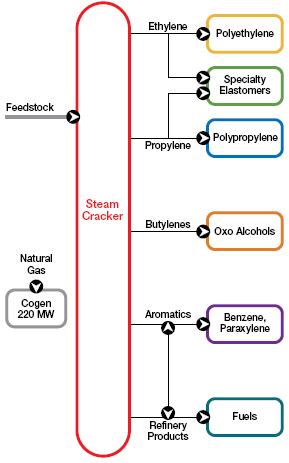
SINGAPORE PETROCHEMICAL PROJECT
The addition of a second world-scale petrochemical project at our integrated site in Singapore
reinforces ExxonMobil’s commitment to meet increasing demand in Asia.
The new complex will include a 1-million-tons-per-year ethylene steam cracker; polyethylene,
polypropylene, specialty elastomer, and benzene units; and expansions to the existing oxo alcohol
and paraxylene units. The steam cracker and derivatives units will be fully integrated within the
existing complex to maximize synergies. Proprietary steam cracker technology will enable a broad
range of feedstocks to be processed.
The project also significantly increases our ability to supply higher-value products for consumer,
packaging, automotive, and construction markets. By employing our latest proprietary metallocene
catalyst technologies for polyethylene and specialty elastomers, we are able to provide
high-performance products to the rapidly growing Asian markets.
This project builds on ExxonMobil’s position as the single largest foreign investor in Singapore.
We expect the project will result in approximately 400 new plant and business positions in
Singapore, and construction activity will require more than 10,000 people at its peak.
90 EXXON MOBIL CORPORATION § 2007 FINANCIAL & OPERATING REVIEW
BUILD PROPRIETARY TECHNOLOGY POSITIONS
Development and deployment of technology are key competitive advantages and major sources of
differentiation for ExxonMobil. We focus significant research in the development of leading process
and product technology, including identification and utilization of lower-cost, advantaged
feedstocks, and commercialization of premium products.
Lower-Cost, Advantaged Feedstocks – A significant portion of our research and development program
is committed to developing processes that enable us to run heavier, lower-cost feedstocks. Through
process technology development, synergies with Refining & Supply and the Upstream, and selective
investment, we have significantly increased our ability to process a broad range of feeds. This
feedstock flexibility captures additional value regardless of economic environment. Approximately
60 percent of our ethylene production is from advantaged feeds and we expect continued growth going
forward.
Another example of our competitive advantage is in steam cracking. New furnaces we are building are
20 percent larger than those typically used in the industry and have a 4- to 5-percent conversion
advantage. Application of latest technology and global best practices in the design of the new
Singapore ethylene steam cracker will give it the greatest feed flexibility of any ExxonMobil steam
cracker in the world.
Olefins produced from advantaged steam cracking feeds are ultimately used to produce a number of
premium products.
About 60 years ago, ExxonMobil began operating the world’s first steam cracker. Today, steam
cracking remains the foundation of the petrochemical industry.
ExxonMobil produces metallocene-based polyethylene resins with outstanding film qualities for
greenhouse roofing. In China, the world’s largest agricultural film market, the use of high-quality
films helps farmers compete in both local and international markets.
Premium Product Development – Throughout our Chemical businesses, a key focus area is the continued
upgrading of products to meet evolving customer needs. Through close collaboration with customers
and application of proprietary technology, we have developed a large number of value-added products
within both our specialty and commodity businesses. These “premium products” are backed by a strong
intellectual property position and have growth rates well above the industry average. Premium
products are a key component of our investment plan, including production of metallocene-based
polyethylene and specialty elastomers in Singapore.
EXXON MOBIL CORPORATION § 2007 FINANCIAL & OPERATING REVIEW 91
Overview of Key Products
ExxonMobil Chemical is a premier supplier of olefins, polyolefins, and aromatics, and has
strong market positions in a wide variety of other petrochemicals. New and enhanced products
and applications are continually being developed to meet evolving customer needs.
Polyethylene
Automotive – fuel tanks, storage tanks
Consumer – milk bottles, storage containers, toys
Packaging – flexible food packaging, bags
Polypropylene
Appliance – clothes washer parts, dishwasher liners
Automotive – interior and exterior trim parts
Consumer – packaging, diapers, health care
Specialty Elastomers
Automotive – hoses, belts, door and window seals
Consumer – appliance parts, household goods
Industrial – roof sheeting, electrical cable insulation
Butyl Polymers
Automotive – hoses, tubing, engine mounts
Tires – inner liners, sidewalls, inner tubes
Adhesive Polymers
Consumer – tapes, labels, diaper assembly
Industrial – glues, packaging, road marking, tires
Oriented Polypropylene Film
Consumer – flexible packaging, labels
Industrial – tapes, protective laminates
Petroleum Additives
Transportation – motor and gear lubricants, transportation fuels
Synthetic Base Fluids
Automotive – synthetic engine, gear, and transmission oils
Industrial – synthetic lubricants, fiber-optic cable gel
Oxygenated Fluids
Consumer – paints, cleaning fluids, de-icing fluids, rubbing alcohol
Industrial – paints, adhesives, magnetic tapes
Hydrocarbon Fluids
Consumer – aerosol products, paints, lighter fluids
Industrial – degreasers, agricultural chemicals, adhesives, inks
Oxo Alcohols and Acids
Consumer – tapes, shampoo
Industrial – cleaners, coatings
Petroleum Additives – motor oil
Plasticizers
Automotive – dashboards, side moldings
Construction – flooring, wall covering, carpet backing
Consumer – garden hoses, sports equipment, shoes
Aromatics
Automotive – polyurethane parts, headlights
Consumer – PET bottles and packaging, polyester and nylon fabrics, CDs/DVDs
Industrial – paints, coatings
Butyl Polymers from ExxonMobil enhance tire life and performance.
Many of our products are used in packaging, including bottles, labels, and shipping wraps.
Today’s plastics have reduced the weight of automobiles by about 10 percent. From bumpers to door panels, parts made from our polymers are lighter weight, resulting in improved fuel economy.
Synthetic lubricants, adhesives, butyl rubber, hydrocarbon fluids, specialty elastomers, and plasticizers also play important roles in improving vehicle performance and lowering costs.
We also continue to develop new products, such as battery separator film for hybrid and electric vehicles, that will improve efficiency and performance for both the auto manufacturer and the consumer.
ExxonMobil offers numerous products
for a wide variety of automotive applications.
92 EXXON MOBIL CORPORATION § 2007 FINANCIAL & OPERATING REVIEW
Chemical Operating Statistics
LARGE/INTEGRATED
PRODUCTION COMPLEX CAPACITY (Based on size or breadth of
product slate)
| |
|
|
|
|
|
|
|
|
|
|
|
|
|
|
|
|
|
|
|
|
|
|
|
|
|
|
|
|
|
|
| (millions of metric tons per year) |
|
Ethylene |
|
|
Polyethylene |
|
|
Polypropylene |
|
|
Paraxylene |
|
|
Additional Products |
| |
North America |
|
|
|
|
|
|
|
|
|
|
|
|
|
|
|
|
|
|
|
|
|
|
|
|
|
|
|
|
|
|
Baton Rouge, Louisiana |
|
|
1.0 |
|
|
|
1.3 |
|
|
|
0.4 |
|
|
|
— |
|
|
P |
|
B |
|
E |
|
A |
|
F |
|
O |
|
|
Baytown, Texas |
|
|
2.2 |
|
|
|
— |
|
|
|
0.8 |
|
|
|
0.6 |
|
|
P |
|
B |
|
|
|
|
|
F |
|
|
|
|
Beaumont, Texas |
|
|
0.9 |
|
|
|
1.0 |
|
|
|
— |
|
|
|
0.3 |
|
|
P |
|
|
|
|
|
|
|
|
|
|
|
S |
Mont Belvieu, Texas |
|
|
— |
|
|
|
1.0 |
|
|
|
— |
|
|
|
— |
|
|
|
|
|
|
|
|
|
|
|
|
|
|
|
Sarnia, Ontario |
|
|
0.3 |
|
|
|
0.5 |
|
|
|
— |
|
|
|
— |
|
|
P |
|
|
|
|
|
|
|
F |
|
O |
|
|
|
|
|
|
|
|
|
|
|
|
|
|
|
|
|
|
|
|
|
|
|
|
|
|
|
|
|
|
|
|
|
Europe |
|
|
|
|
|
|
|
|
|
|
|
|
|
|
|
|
|
|
|
|
|
|
|
|
|
|
|
|
|
|
Antwerp, Belgium |
|
|
0.5 |
|
|
|
0.3 |
|
|
|
— |
|
|
|
— |
|
|
P |
|
|
|
|
|
|
|
F |
|
O |
|
|
Fawley, United Kingdom |
|
|
0.1 |
|
|
|
— |
|
|
|
— |
|
|
|
— |
|
|
P |
|
B |
|
|
|
|
|
F |
|
O |
|
|
Fife, United Kingdom |
|
|
0.4 |
|
|
|
— |
|
|
|
— |
|
|
|
— |
|
|
|
|
|
|
|
|
|
|
|
|
|
|
|
Meerhout, Belgium |
|
|
— |
|
|
|
0.5 |
|
|
|
— |
|
|
|
— |
|
|
|
|
|
|
|
|
|
|
|
|
|
|
|
Notre-Dame-de-Gravenchon, France |
|
|
0.4 |
|
|
|
0.4 |
|
|
|
0.4 |
|
|
|
— |
|
|
P |
|
B |
|
E |
|
A |
|
|
|
O |
|
S |
Rotterdam, the Netherlands |
|
|
— |
|
|
|
— |
|
|
|
— |
|
|
|
0.6 |
|
|
|
|
|
|
|
|
|
|
|
|
O |
|
|
|
|
|
|
|
|
|
|
|
|
|
|
|
|
|
|
|
|
|
|
|
|
|
|
|
|
|
|
|
|
|
Middle East |
|
|
|
|
|
|
|
|
|
|
|
|
|
|
|
|
|
|
|
|
|
|
|
|
|
|
|
|
|
|
Al Jubail, Saudi Arabia |
|
|
0.6 |
|
|
|
0.6 |
|
|
|
— |
|
|
|
— |
|
|
|
|
|
|
|
|
|
|
|
|
|
|
|
Yanbu, Saudi Arabia |
|
|
1.0 |
|
|
|
0.7 |
|
|
|
0.2 |
|
|
|
— |
|
|
P |
|
|
|
|
|
|
|
|
|
|
|
|
|
|
|
|
|
|
|
|
|
|
|
|
|
|
|
|
|
|
|
|
|
|
|
|
|
|
|
|
|
|
|
Asia Pacific |
|
|
|
|
|
|
|
|
|
|
|
|
|
|
|
|
|
|
|
|
|
|
|
|
|
|
|
|
|
|
Kawasaki, Japan |
|
|
0.5 |
|
|
|
0.1 |
|
|
|
— |
|
|
|
— |
|
|
P |
|
B |
|
|
|
A |
|
F |
|
|
|
|
Singapore |
|
|
0.9 |
|
|
|
0.6 |
|
|
|
0.4 |
|
|
|
0.9 |
|
|
P |
|
|
|
|
|
|
|
F |
|
O |
|
|
Sriracha, Thailand |
|
|
— |
|
|
|
— |
|
|
|
— |
|
|
|
0.5 |
|
|
|
|
|
|
|
|
|
|
F |
|
|
|
|
|
|
|
|
|
|
|
|
|
|
|
|
|
|
|
|
|
|
|
|
|
|
|
|
|
|
|
|
|
|
|
All other |
|
|
— |
|
|
|
0.1 |
|
|
|
— |
|
|
|
0.6 |
|
|
|
|
|
|
|
|
|
|
|
|
|
|
|
| |
Total worldwide |
|
|
8.8 |
|
|
|
7.1 |
|
|
|
2.2 |
|
|
|
3.5 |
|
|
|
|
|
|
|
|
|
|
|
|
|
|
|
| |
P Propylene B Butyl E Specialty Elastomers A Adhesive Polymers F Fluids O Oxo Alcohols S Synthetics
OTHER MANUFACTURING LOCATIONS(1)
| |
|
|
|
|
|
|
|
| Location |
|
Product |
|
North America
|
|
|
|
|
|
|
|
|
Bayway, New Jersey
|
|
|
|
5 |
|
|
|
|
Belleville, Ontario
|
|
|
|
|
|
u |
|
|
Chalmette, Louisiana
|
|
|
n |
|
|
|
|
|
Dartmouth, Nova Scotia
|
|
|
|
|
l |
|
|
|
Edison, New Jersey
|
|
|
|
|
l |
|
|
|
Houston, Texas(2)
|
|
|
n |
|
|
|
|
|
Joliet, Illinois
|
|
|
n |
|
|
|
|
|
LaGrange, Georgia
|
|
|
|
|
|
u |
|
|
Pensacola, Florida
|
|
|
|
5 |
|
|
|
|
Plaquemine, Louisiana
|
|
|
|
5 |
|
|
|
|
Shawnee, Oklahoma
|
|
|
|
|
|
u |
|
|
|
|
|
|
|
|
|
|
|
Latin America
|
|
|
|
|
|
|
|
|
Campana, Argentina
|
|
|
n |
|
l |
|
|
|
Managua, Nicaragua
|
|
|
|
|
l |
|
|
|
Paulinia, Brazil
|
|
|
|
|
l |
|
|
|
|
|
|
|
|
|
|
|
|
Europe
|
|
|
|
|
|
|
|
|
Amsterdam, the Netherlands
|
|
|
|
|
l |
|
|
|
Augusta, Italy
|
|
|
n |
|
|
|
|
|
Brindisi, Italy
|
|
|
|
|
|
u |
|
|
Cologne, Germany
|
|
|
|
5 |
|
|
|
|
Fos-sur-Mer, France
|
|
|
n |
|
|
|
|
|
Geleen, the Netherlands
|
|
|
|
5 |
|
|
|
|
Harnes, France(2)
|
|
|
|
|
l |
|
|
|
Karlsruhe, Germany
|
|
|
n |
|
|
|
|
|
Kerkrade, the Netherlands
|
|
|
|
|
|
u |
|
|
Newport, United Kingdom
|
|
|
|
5 |
|
|
|
|
Trecate, Italy
|
|
|
|
|
l |
|
|
|
Virton, Belgium
|
|
|
|
|
|
u |
|
|
|
|
|
|
|
|
|
|
|
Asia Pacific
|
|
|
|
|
|
|
|
|
Adelaide, Australia(2)
|
|
|
|
|
l |
|
|
|
Jinshan, China
|
|
|
|
5 |
|
|
|
|
Kashima, Japan
|
|
|
|
5 |
|
|
|
|
Nasu, Japan
|
|
|
|
|
|
u |
|
|
Panyu, China
|
|
|
|
|
l |
|
|
|
Sakai, Japan
|
|
|
n |
|
l |
|
|
|
Wakayama, Japan
|
|
|
n |
|
|
|
|
|
|
|
| (1) |
|
Includes joint-venture plants, with the exception of the Infineum
additives joint ventures. |
| |
| (2) |
|
Facility mothballed. |
| |
| n |
|
Olefins/Aromatics |
| |
| 5 |
|
Polymers |
| |
| l |
|
Other Chemicals |
| |
| u |
|
Films |
EXXON MOBIL CORPORATION § 2007 FINANCIAL & OPERATING
REVIEW 93
VOLUMES
| |
|
|
|
|
|
|
|
|
|
|
|
|
|
|
|
|
|
|
|
|
| Includes ExxonMobil’s share of equity companies |
|
2007 |
|
|
2006 |
|
|
2005 |
|
|
2004 |
|
|
2003 |
|
| |
| Worldwide Production Volumes (thousands of metric tons) |
Ethylene |
|
|
8,155 |
|
|
|
7,878 |
|
|
|
7,930 |
|
|
|
8,271 |
|
|
|
7,567 |
|
Polyethylene |
|
|
6,693 |
|
|
|
6,275 |
|
|
|
6,213 |
|
|
|
6,248 |
|
|
|
6,091 |
|
Polypropylene |
|
|
1,897 |
|
|
|
1,815 |
|
|
|
1,680 |
|
|
|
1,885 |
|
|
|
1,965 |
|
Paraxylene |
|
|
2,995 |
|
|
|
3,038 |
|
|
|
2,785 |
|
|
|
2,826 |
|
|
|
2,531 |
|
| |
|
|
|
|
|
|
|
|
|
|
|
|
|
|
|
|
|
|
|
|
|
| Prime Product Sales Volumes(1) by Region (thousands of metric tons) |
Americas(2) |
|
|
12,034 |
|
|
|
11,907 |
|
|
|
11,523 |
|
|
|
12,842 |
|
|
|
11,939 |
|
Europe/Middle East/Africa |
|
|
7,463 |
|
|
|
7,497 |
|
|
|
7,310 |
|
|
|
7,334 |
|
|
|
7,180 |
|
Asia Pacific |
|
|
7,983 |
|
|
|
7,946 |
|
|
|
7,944 |
|
|
|
7,612 |
|
|
|
7,448 |
|
| |
Total worldwide |
|
|
27,480 |
|
|
|
27,350 |
|
|
|
26,777 |
|
|
|
27,788 |
|
|
|
26,567 |
|
| |
|
|
|
|
|
|
|
|
|
|
|
|
|
|
|
|
|
|
|
|
|
Prime Product Sales Volumes (1) by Business (thousands of metric tons) |
Less-cyclical specialty businesses |
|
|
6,237 |
|
|
|
6,228 |
|
|
|
6,083 |
|
|
|
6,324 |
|
|
|
6,113 |
|
Olefins/polyolefins/aromatics/other |
|
|
21,243 |
|
|
|
21,122 |
|
|
|
20,694 |
|
|
|
21,464 |
|
|
|
20,454 |
|
| |
Total |
|
|
27,480 |
|
|
|
27,350 |
|
|
|
26,777 |
|
|
|
27,788 |
|
|
|
26,567 |
|
| |
|
|
|
| (1) |
|
Prime product sales include ExxonMobil’s share of equity-company volumes and finished product
transfers to the Downstream. Carbon-black oil volumes are excluded. |
| |
| (2) |
|
Includes North America and Latin America. |
94 EXXON MOBIL CORPORATION § 2007 FINANCIAL & OPERATING REVIEW
Frequently Used Terms
Listed below are definitions of several of ExxonMobil’s key business and financial performance
measures and other terms. These definitions are provided to facilitate understanding of the terms
and their calculation. In the case of financial measures that we believe constitute “non-GAAP
financial measures” under Securities and Exchange Commission Regulation G, we provide a
reconciliation to the most comparable Generally Accepted Accounting Principles (GAAP) measure and
other information required by that rule.
EARNINGS EXCLUDING ACCOUNTING CHANGE AND OTHER SPECIAL ITEMS
In addition to reporting U.S. GAAP defined net income, ExxonMobil also presents a measure of
earnings that excludes earnings from a required accounting change and other special items
quantified and described in our quarterly and annual earnings press releases. Earnings excluding
the aforementioned items is a non-GAAP financial measure, and is included to facilitate
comparisons of base business performance across periods. A reconciliation to net income is shown
on page 10. We also refer to earnings excluding accounting changes and other special items as
normalized earnings. Earnings per share amounts use the same average common shares outstanding as
used for the calculation of net income per common share and net income per common share —
assuming dilution.
OPERATING
COSTS
Operating costs are the combined total of production, manufacturing, selling, general,
administrative, exploration, depreciation, and depletion expenses from the Consolidated Statement
of Income and ExxonMobil’s share of similar costs for equity companies. Operating costs are the
costs during the period to produce, manufacture, and otherwise prepare the company’s products for
sale — including energy costs, staffing, maintenance, and other costs to explore for and produce
oil and gas, and operate refining and chemical plants. Distribution and marketing expenses are
also included. Operating costs exclude the cost of raw materials, taxes, and interest expense.
These expenses are on a before-tax basis. While ExxonMobil’s management is responsible for all
revenue and expense elements of net income, operating costs, as defined below, represent the
expenses most directly under management’s control. Information regarding these costs is therefore
useful for investors and ExxonMobil management in evaluating management’s performance.
Reconciliation of Operating Costs
| |
|
|
|
|
|
|
|
|
|
|
|
|
|
|
|
|
|
|
|
|
| (millions of dollars) |
|
2007 |
|
|
2006 |
|
|
2005 |
|
|
2004 |
|
|
2003 |
|
| |
From ExxonMobil’s Consolidated Statement of Income |
|
|
|
|
|
|
|
|
|
|
|
|
|
|
|
|
|
|
|
|
Total costs and other deductions |
|
|
334,078 |
|
|
|
310,233 |
|
|
|
311,248 |
|
|
|
256,794 |
|
|
|
214,772 |
|
Less: |
|
|
|
|
|
|
|
|
|
|
|
|
|
|
|
|
|
|
|
|
Crude oil and product purchases |
|
|
199,498 |
|
|
|
182,546 |
|
|
|
185,219 |
|
|
|
139,224 |
|
|
|
107,658 |
|
Interest expense |
|
|
400 |
|
|
|
654 |
|
|
|
496 |
|
|
|
638 |
|
|
|
207 |
|
Sales-based taxes |
|
|
31,728 |
|
|
|
30,381 |
|
|
|
30,742 |
|
|
|
27,263 |
|
|
|
23,855 |
|
Other taxes and duties |
|
|
40,953 |
|
|
|
39,203 |
|
|
|
41,554 |
|
|
|
40,954 |
|
|
|
37,645 |
|
Income applicable to minority and preferred interests |
|
|
1,005 |
|
|
|
1,051 |
|
|
|
799 |
|
|
|
776 |
|
|
|
694 |
|
| |
Subtotal |
|
|
60,494 |
|
|
|
56,398 |
|
|
|
52,438 |
|
|
|
47,939 |
|
|
|
44,713 |
|
ExxonMobil’s share of equity-company expenses |
|
|
5,619 |
|
|
|
4,947 |
|
|
|
4,520 |
|
|
|
4,209 |
|
|
|
3,937 |
|
| |
Total operating costs |
|
|
66,113 |
|
|
|
61,345 |
|
|
|
56,958 |
|
|
|
52,148 |
|
|
|
48,650 |
|
| |
Components of Operating Costs
| |
|
|
|
|
|
|
|
|
|
|
|
|
|
|
|
|
|
|
|
|
| (millions of dollars) |
|
2007 |
|
|
2006 |
|
|
2005 |
|
|
2004 |
|
|
2003 |
|
| |
From ExxonMobil’s Consolidated Statement of Income |
|
|
|
|
|
|
|
|
|
|
|
|
|
|
|
|
|
|
|
|
Production and manufacturing expenses |
|
|
31,885 |
|
|
|
29,528 |
|
|
|
26,819 |
|
|
|
23,225 |
|
|
|
21,260 |
|
Selling, general, and administrative expenses |
|
|
14,890 |
|
|
|
14,273 |
|
|
|
14,402 |
|
|
|
13,849 |
|
|
|
13,396 |
|
Depreciation and depletion |
|
|
12,250 |
|
|
|
11,416 |
|
|
|
10,253 |
|
|
|
9,767 |
|
|
|
9,047 |
|
Exploration expenses, including dry holes |
|
|
1,469 |
|
|
|
1,181 |
|
|
|
964 |
|
|
|
1,098 |
|
|
|
1,010 |
|
| |
Subtotal |
|
|
60,494 |
|
|
|
56,398 |
|
|
|
52,438 |
|
|
|
47,939 |
|
|
|
44,713 |
|
ExxonMobil’s share of equity-company expenses |
|
|
5,619 |
|
|
|
4,947 |
|
|
|
4,520 |
|
|
|
4,209 |
|
|
|
3,937 |
|
| |
Total operating costs |
|
|
66,113 |
|
|
|
61,345 |
|
|
|
56,958 |
|
|
|
52,148 |
|
|
|
48,650 |
|
| |
PRODUCTION SHARING CONTRACT NET INTEREST REDUCTIONS
Production Sharing Contract (PSC) net interest reductions are contractual reductions in
ExxonMobil’s share of production volumes covered by PSCs. These reductions typically occur
when cumulative investment returns or production volumes achieve thresholds as specified in
the PSCs. Once a net interest reduction has occurred, it typically will not be reversed by
subsequent events, such as lower crude oil prices.
EXXON MOBIL CORPORATION § 2007 FINANCIAL & OPERATING
REVIEW 95
PRICE AND SPEND IMPACTS ON VOLUMES
Price and spend impacts on volumes are fluctuations in ExxonMobil’s share of production volumes
caused by changes in oil and gas prices or spending levels from one period to another. For example,
at higher prices fewer barrels are required for ExxonMobil to recover its costs. According to the
terms of contractual arrangements or government royalty regimes, price or spending variability can
increase or decrease royalty burdens and/or volumes attributable to ExxonMobil. These effects
generally vary from period to period with field spending patterns or market prices for crude oil or
natural gas.
CAPITAL EMPLOYED
Capital employed is a measure of net investment. When viewed from the perspective of how the
capital is used by the businesses, it includes ExxonMobil’s net share of property, plant, and
equipment and other assets less liabilities, excluding both short-term and long-term debt. When
viewed from the perspective of the sources of capital employed in total for the Corporation, it
includes ExxonMobil’s share of total debt and shareholders’ equity. Both of these views include
ExxonMobil’s share of amounts applicable to equity companies, which the Corporation believes should
be included to provide a more comprehensive measure of capital employed.
| |
|
|
|
|
|
|
|
|
|
|
|
|
|
|
|
|
|
|
|
|
| (millions of dollars) |
|
2007 |
|
|
2006 |
|
|
2005 |
|
|
2004 |
|
|
2003 |
|
| |
Business uses: asset and liability perspective |
|
|
|
|
|
|
|
|
|
|
|
|
|
|
|
|
|
|
|
|
Total assets |
|
|
242,082 |
|
|
|
219,015 |
|
|
|
208,335 |
|
|
|
195,256 |
|
|
|
174,278 |
|
Less liabilities and minority share of assets and liabilities |
|
|
|
|
|
|
|
|
|
|
|
|
|
|
|
|
|
|
|
|
Total current liabilities excluding notes and loans payable |
|
|
(55,929 |
) |
|
|
(47,115 |
) |
|
|
(44,536 |
) |
|
|
(39,701 |
) |
|
|
(33,597 |
) |
Total long-term liabilities excluding long-term debt and equity
of minority and preferred shareholders in affiliated companies |
|
|
(50,543 |
) |
|
|
(45,905 |
) |
|
|
(41,095 |
) |
|
|
(41,554 |
) |
|
|
(37,839 |
) |
Minority share of assets and liabilities |
|
|
(5,332 |
) |
|
|
(4,948 |
) |
|
|
(4,863 |
) |
|
|
(5,285 |
) |
|
|
(4,945 |
) |
Add ExxonMobil share of debt-financed equity-company net assets |
|
|
3,386 |
|
|
|
2,808 |
|
|
|
3,450 |
|
|
|
3,914 |
|
|
|
4,151 |
|
| |
Total capital employed |
|
|
133,664 |
|
|
|
123,855 |
|
|
|
121,291 |
|
|
|
112,630 |
|
|
|
102,048 |
|
| |
|
|
|
|
|
|
|
|
|
|
|
|
|
|
|
|
|
|
|
|
|
Total corporate sources: debt and equity perspective |
|
|
|
|
|
|
|
|
|
|
|
|
|
|
|
|
|
|
|
|
Notes and loans payable |
|
|
2,383 |
|
|
|
1,702 |
|
|
|
1,771 |
|
|
|
3,280 |
|
|
|
4,789 |
|
Long-term debt |
|
|
7,183 |
|
|
|
6,645 |
|
|
|
6,220 |
|
|
|
5,013 |
|
|
|
4,756 |
|
Shareholders’ equity |
|
|
121,762 |
|
|
|
113,844 |
|
|
|
111,186 |
|
|
|
101,756 |
|
|
|
89,915 |
|
Less minority share of total debt |
|
|
(1,050 |
) |
|
|
(1,144 |
) |
|
|
(1,336 |
) |
|
|
(1,333 |
) |
|
|
(1,563 |
) |
Add ExxonMobil share of equity-company debt |
|
|
3,386 |
|
|
|
2,808 |
|
|
|
3,450 |
|
|
|
3,914 |
|
|
|
4,151 |
|
| |
Total capital employed |
|
|
133,664 |
|
|
|
123,855 |
|
|
|
121,291 |
|
|
|
112,630 |
|
|
|
102,048 |
|
| |
RETURN ON AVERAGE CAPITAL EMPLOYED (ROCE)
Return on average capital employed is a performance measure ratio. From the perspective of the
business segments, ROCE is annual business segment earnings divided by average business segment
capital employed (average of beginning- and end-of-year amounts). These segment earnings include
ExxonMobil’s share of segment earnings of equity companies, consistent with our capital employed
definition, and exclude the cost of financing. The Corporation’s total ROCE is net income excluding
the after-tax cost of financing, divided by total corporate average capital employed. The
Corporation has consistently applied its ROCE definition for many years and views it as the best
measure of historical capital productivity in our capital-intensive, long-term industry, both to
evaluate management’s performance and to demonstrate to shareholders that capital has been used
wisely over the long term. Additional measures, which are more cash-flow based, are used to make
investment decisions.
Return on Average Capital Employed
| |
|
|
|
|
|
|
|
|
|
|
|
|
|
|
|
|
|
|
|
|
| (millions of dollars) |
|
2007 |
|
|
2006 |
|
|
2005 |
|
|
2004 |
|
|
2003 |
|
| |
Net income |
|
|
40,610 |
|
|
|
39,500 |
|
|
|
36,130 |
|
|
|
25,330 |
|
|
|
21,510 |
|
Financing costs (after tax) |
|
|
|
|
|
|
|
|
|
|
|
|
|
|
|
|
|
|
|
|
Gross third-party debt |
|
|
(339 |
) |
|
|
(264 |
) |
|
|
(261 |
) |
|
|
(461 |
) |
|
|
(490 |
) |
ExxonMobil share of equity companies |
|
|
(204 |
) |
|
|
(156 |
) |
|
|
(144 |
) |
|
|
(185 |
) |
|
|
(172 |
) |
All other financing costs — net |
|
|
268 |
|
|
|
499 |
|
|
|
(35 |
) |
|
|
378 |
|
|
|
2,196 |
(1) |
| |
Total financing costs |
|
|
(275 |
) |
|
|
79 |
|
|
|
(440 |
) |
|
|
(268 |
) |
|
|
1,534 |
|
| |
Earnings excluding financing costs |
|
|
40,885 |
|
|
|
39,421 |
|
|
|
36,570 |
|
|
|
25,598 |
|
|
|
19,976 |
|
| |
Average capital employed |
|
|
128,760 |
|
|
|
122,573 |
|
|
|
116,961 |
|
|
|
107,339 |
|
|
|
95,373 |
|
Return on average capital employed — corporate total |
|
|
31.8% |
|
|
|
32.2% |
|
|
|
31.3% |
|
|
|
23.8% |
|
|
|
20.9% |
|
|
|
|
| (1) |
|
“All other financing costs — net” in 2003 includes interest income (after tax) associated
with the settlement of a U.S. tax dispute. |
96 EXXON MOBIL CORPORATION § 2007 FINANCIAL & OPERATING REVIEW
TOTAL SHAREHOLDER RETURN
Shareholder return measures the change in value of an investment in stock over a specified period
of time, assuming dividend reinvestment. We calculate shareholder return over a particular
measurement period by: dividing (1) the sum of (a) the cumulative value of dividends received
during the measurement period, assuming reinvestment, plus (b) the difference between the stock
price at the end and at the beginning of the measurement period; by (2) the stock price at the
beginning of the measurement period. For this purpose, we assume dividends are reinvested in stock
at market prices at approximately the same time actual dividends are paid. Shareholder return is
usually quoted on an annualized basis.
CAPITAL AND EXPLORATION EXPENDITURES (Capex)
Capital and exploration expenditures are the combined total of additions at cost to property,
plant, and equipment and exploration expenses on a before-tax basis from the Consolidated
Statement of Income. ExxonMobil’s Capex includes its share of similar costs for equity companies.
Capex excludes depreciation on the cost of exploration support equipment and facilities recorded
to property, plant, and equipment when acquired. While ExxonMobil’s management is responsible for
all investments and elements of net income, particular focus is placed on managing the
controllable aspects of this group of expenditures.
FINDING AND RESOURCE-ACQUISITION COSTS
Finding and resource-acquisition costs per oil-equivalent barrel is a performance measure that is
calculated using the Exploration portion of Upstream capital and exploration expenditures and
proved property acquisition costs divided by resource additions (in oil-equivalent barrels).
ExxonMobil refers to new discoveries and acquisitions of discovered resources as resource
additions. In addition to proved reserves, resource additions include quantities of oil and gas
that are not yet classified as proved reserves, but which ExxonMobil believes will likely be moved
into the proved reserves category and produced in the future.
| |
|
|
|
|
|
|
|
|
|
|
|
|
|
|
|
|
|
|
|
|
| |
|
2007 |
|
|
2006 |
|
|
2005 |
|
|
2004 |
|
|
2003 |
|
| |
Exploration portion of Upstream capital and
exploration expenditures (millions of dollars) |
|
|
1,909 |
|
|
|
2,044 |
|
|
|
1,693 |
|
|
|
1,283 |
|
|
|
1,215 |
|
Proved property acquisition costs (millions of dollars) |
|
|
37 |
|
|
|
234 |
|
|
|
174 |
|
|
|
93 |
|
|
|
— |
|
Total exploration and proved property
acquisition costs (millions of dollars) |
|
|
1,946 |
|
|
|
2,278 |
|
|
|
1,867 |
|
|
|
1,376 |
|
|
|
1,215 |
|
Resource additions (millions of oil-equivalent barrels) |
|
|
2,010 |
|
|
|
4,270 |
|
|
|
4,365 |
|
|
|
2,940 |
|
|
|
2,115 |
|
Finding and resource-acquisition costs per
oil-equivalent barrel (dollars) |
|
|
0.97 |
|
|
|
0.53 |
|
|
|
0.43 |
|
|
|
0.47 |
|
|
|
0.57 |
|
LIQUIDS AND NATURAL GAS PROVED RESERVES
In this report, we use the term “proved reserves” to mean quantities of oil and gas that
ExxonMobil has determined to be reasonably certain of recovery under existing economic and
operating conditions on the basis of our long-standing, rigorous management review process. We
only book proved reserves when we have made significant funding commitments for the related
projects. In this report, we aggregate proved reserves of consolidated and equity companies,
excluding royalties and quantities due others, since ExxonMobil does not view these reserves
differently from a management perspective. To reflect management’s view of ExxonMobil’s total
liquids reserves, proved reserves in this report also include oil sands reserves from Canadian
Syncrude operations, which are reported separately as mining reserves in our Form 10-K and proxy
statement. Oil sands reserves included in this report totaled 694 million barrels at year-end
2007, 718 million barrels at year-end 2006, 738 million barrels at year-end 2005, 757 million
barrels at year-end 2004, and 781 million barrels at year-end 2003. For our own management
purposes and as discussed in this report, we determine proved reserves based on price and cost
assumptions that are consistent with those used to make investment decisions. Therefore, the
proved reserves in this report are not directly comparable to the data reported in our Form 10-K
and proxy statement. Based on regulatory guidance, ExxonMobil began in 2004 to state our results
in the Form 10-K and proxy statement to reflect the impacts on proved reserves of utilizing
December 31 liquids and natural gas prices (“year-end price/cost effects”). On this basis,
year-end proved reserves, including year-end price/cost effects, 2007 proved reserves totaled 22.5
billion oil-equivalent barrels, 22.8 billion oil-equivalent barrels in 2006, 22.4 billion
oil-equivalent barrels in 2005, and 21.7 billion oil-equivalent barrels in 2004. Excluding
year-end price/cost effects, 2007 proved reserves totaled 22.7 billion oil-equivalent barrels,
2006 proved reserves totaled 22.7 billion oil-equivalent barrels, 2005 proved reserves totaled
22.4 billion oil-equivalent barrels, while 2004 proved reserves totaled 22.2 billion
oil-equivalent barrels.
RESOURCES, RESOURCE BASE, AND RECOVERABLE RESOURCES
Resources, resource base, recoverable oil, recoverable hydrocarbons, recoverable resources, and
similar terms used in this report are the total remaining estimated quantities of oil and gas that
are expected to be ultimately recoverable. In addition to proved reserves, the resource base
includes quantities of oil and gas that are not yet classified as proved reserves, but which
ExxonMobil believes will likely be moved into the proved reserves category and produced in the
future.
PROVED RESERVES REPLACEMENT RATIO
Proved reserves replacement ratio is a performance measure that is calculated using proved
oil-equivalent reserves additions divided by oil-equivalent production. Both proved reserves
additions and production include amounts applicable to equity companies. The ratio usually
reported by ExxonMobil excludes sales and year-end price/cost effects, and includes Canadian oil
sands mining operations in both additions and production volumes. See the definition of “liquids
and natural gas proved reserves” above and the listing of inclusions and exclusions on pages 64
and 65.
EXXON MOBIL CORPORATION § 2007 FINANCIAL & OPERATING REVIEW 97
PROVED RESERVES REPLACEMENT COSTS
Proved reserves replacement costs per oil-equivalent barrel is a performance measure ratio.
Proved reserves replacement costs per barrel are costs incurred in property acquisition and
exploration, plus costs incurred in development activities, divided by proved oil-equivalent
reserves additions, excluding sales. Both the costs incurred and the proved reserves additions
include amounts applicable to equity companies as well as Canadian oil sands operations and
exclude year-end price/cost effects. See the definition of “liquids and natural gas proved
reserves” on the preceding page.
| |
|
|
|
|
|
|
|
|
|
|
|
|
|
|
|
|
|
|
|
|
| (millions of dollars) |
|
2007 |
|
|
2006 |
|
|
2005 |
|
|
2004 |
|
|
2003 |
|
| |
Costs incurred |
|
|
|
|
|
|
|
|
|
|
|
|
|
|
|
|
|
|
|
|
Property acquisition costs |
|
|
194 |
|
|
|
597 |
|
|
|
453 |
|
|
|
134 |
|
|
|
45 |
|
Exploration costs |
|
|
1,762 |
|
|
|
1,685 |
|
|
|
1,420 |
|
|
|
1,255 |
|
|
|
1,181 |
|
Development costs |
|
|
11,570 |
|
|
|
12,103 |
|
|
|
10,561 |
|
|
|
9,122 |
|
|
|
9,856 |
|
Total costs incurred |
|
|
13,526 |
|
|
|
14,385 |
|
|
|
12,434 |
|
|
|
10,511 |
|
|
|
11,082 |
|
| |
| |
|
|
|
|
|
|
|
|
|
|
|
|
|
|
|
|
|
|
|
|
| (millions of barrels) |
|
2007 |
|
|
2006 |
|
|
2005 |
|
|
2004 |
|
|
2003 |
|
| |
Proved oil-equivalent reserves additions
|
|
|
|
|
|
|
|
|
|
|
|
|
|
|
|
|
|
|
|
|
Revisions |
|
|
1,793 |
|
|
|
390 |
|
|
|
377 |
|
|
|
140 |
|
|
|
619 |
|
Improved recovery |
|
|
35 |
|
|
|
29 |
|
|
|
31 |
|
|
|
28 |
|
|
|
116 |
|
Extensions/discoveries |
|
|
251 |
|
|
|
881 |
|
|
|
1,461 |
|
|
|
1,809 |
|
|
|
961 |
|
Purchases |
|
|
2 |
|
|
|
755 |
|
|
|
122 |
|
|
|
11 |
|
|
|
2 |
|
Total oil-equivalent reserves additions |
|
|
2,081 |
|
|
|
2,055 |
|
|
|
1,991 |
|
|
|
1,988 |
|
|
|
1,698 |
|
| |
Proved reserves replacement costs (dollars per barrel) |
|
|
6.50 |
|
|
|
7.00 |
|
|
|
6.25 |
|
|
|
5.29 |
|
|
|
6.53 |
|
HEAVY OIL
Heavy oil, for the purpose of this report, includes heavy oil, extra heavy oil, and bitumen, as
defined by the World Petroleum Congress in 1987 based on API gravity and viscosity at reservoir
conditions. Heavy oil has an API gravity between 10 and 22.3 degrees. The API gravity of extra
heavy oil and bitumen is less than 10 degrees. Extra heavy oil has a viscosity less than 10
thousand centipoise, whereas the viscosity of bitumen is greater than 10 thousand centipoise. The
term “oil sands” is used to indicate heavy oil (generally bitumen) that is recovered in a mining
operation.
CASH FLOW FROM OPERATIONS AND ASSET SALES
Cash flow from operations and asset sales is the sum of the net cash provided by operating
activities and proceeds from sales of subsidiaries, investments, and property, plant, and equipment
from the Summary Statement of Cash Flows. This cash flow is the total sources of cash from both
operating the Corporation’s assets and from the divesting of assets. The Corporation employs a
long-standing and regular disciplined review process to ensure that all assets are contributing to
the Corporation’s strategic and financial objectives. Assets are divested when they are no longer
meeting these objectives or are worth considerably more to others. Because of the regular nature of
this activity, we believe it is useful for investors to consider sales proceeds together with cash
provided by operating activities when evaluating cash available for investment in the business and
financing activities, including shareholder distributions.
| |
|
|
|
|
|
|
|
|
|
|
|
|
|
|
|
|
|
|
|
|
| (millions of dollars) |
|
2007 |
|
|
2006 |
|
|
2005 |
|
|
2004 |
|
|
2003 |
|
| |
Net cash provided by operating activities |
|
|
52,002 |
|
|
|
49,286 |
|
|
|
48,138 |
|
|
|
40,551 |
|
|
|
28,498 |
|
Sales of subsidiaries, investments and
property, plant, and equipment |
|
|
4,204 |
|
|
|
3,080 |
|
|
|
6,036 |
|
|
|
2,754 |
|
|
|
2,290 |
|
| |
Cash flow from operations and asset sales |
|
|
56,206 |
|
|
|
52,366 |
|
|
|
54,174 |
|
|
|
43,305 |
|
|
|
30,788 |
|
| |
DISTRIBUTIONS TO SHAREHOLDERS
The Corporation distributes cash to shareholders in the form of both dividends and share
purchases. Shares are purchased both to reduce shares outstanding and to offset shares issued
in conjunction with company benefit plans and programs. For purposes of calculating
distributions to shareholders, the Corporation only includes the cost of those shares purchased
to reduce shares outstanding.
| |
|
|
|
|
|
|
|
|
|
|
|
|
|
|
|
|
|
|
|
|
| (millions of dollars) |
|
2007 |
|
|
2006 |
|
|
2005 |
|
|
2004 |
|
|
2003 |
|
| |
Dividends paid to ExxonMobil shareholders |
|
|
7,621 |
|
|
|
7,628 |
|
|
|
7,185 |
|
|
|
6,896 |
|
|
|
6,515 |
|
Cost of shares purchased to reduce shares outstanding |
|
|
28,000 |
|
|
|
25,000 |
|
|
|
16,000 |
|
|
|
8,000 |
|
|
|
5,000 |
|
| |
Distributions to ExxonMobil shareholders |
|
|
35,621 |
|
|
|
32,628 |
|
|
|
23,185 |
|
|
|
14,896 |
|
|
|
11,515 |
|
| |
Memo: Gross cost of shares purchased to offset
shares issued under benefit plans and programs |
|
|
3,822 |
|
|
|
4,558 |
|
|
|
2,221 |
|
|
|
1,951 |
|
|
|
881 |
|
98 EXXON MOBIL CORPORATION § 2007 FINANCIAL & OPERATING REVIEW
Index
| |
|
|
|
|
Acreage |
|
|
32, 33, 42, 46, 50, 54, 58, 62 |
|
Africa |
|
|
33, 34, 37, 38, 39, 40, 41, 50-53 |
|
Americas gas market |
|
|
36-37 |
|
Asia Pacific |
|
|
19, 20, 33, 40, 41, 54-55, 78, 88, 89 |
|
Asian gas market |
|
|
36, 37 |
|
|
|
|
|
|
Balance sheet |
|
|
15 |
|
Business strategies |
|
|
3, 4-5, 31, 69, 85 |
|
|
|
|
|
|
Canada |
|
|
23, 33, 36, 42, 44-45 |
|
Capital and exploration expenditures |
|
|
2, 5, 12-13, 30, 31, 68, 69, 73, 84, 85, 96 |
|
Capital employed |
|
|
2, 11, 30, 68, 75, 84, 86, 95 |
|
Cash flow |
|
|
2, 3, 5, 17, 97 |
|
Cash flow statement |
|
|
17, 97 |
|
Chemical capacity |
|
|
92 |
|
Chemical products |
|
|
91 |
|
Chemical projects |
|
|
78, 88-89 |
|
Chemical results |
|
|
84-85 |
|
Chemical volumes |
|
|
5, 93 |
|
|
|
|
|
|
Depreciation and depletion |
|
|
14, 16, 17, 66, 67 |
|
Dividend and shareholder distributions |
|
|
6 |
|
Downstream results |
|
|
68-69 |
|
|
|
|
|
|
Earnings |
|
|
3, 5, 6, 10, 30, 31, 42, 46, 50, 54, 58, 66-67, 68, 69, 84, 85, 86, 94, 95 |
|
Earnings, oil and gas |
|
|
66-67 |
|
Earnings per barrel |
|
|
31, 35 |
|
Energy management |
|
|
8, 9, 36, 72, 73, 87 |
|
Energy outlook |
|
|
18-21 |
|
Europe |
|
|
33, 38, 40, 41, 46-49, 73, 77, 86, 88 |
|
European gas market |
|
|
36-37 |
|
Exploration captures |
|
|
33 |
|
|
|
|
|
|
Financial highlights |
|
|
2 |
|
Finding and resource-acquisition costs |
|
|
31, 40, 96 |
|
Frequently used terms |
|
|
94-97 |
|
Fuels marketing |
|
|
74-75, 78 |
|
Fujian Venture |
|
|
29, 78, 89 |
|
|
|
|
|
|
Heavy oil |
|
|
23, 32, 34, 35, 44, 45, 97 |
|
|
|
|
|
|
Income statement |
|
|
16 |
|
Integration |
|
|
5, 29, 31, 69, 70, 71, 74, 85, 87 |
|
|
|
|
|
|
Key financial ratios |
|
|
2 |
|
|
|
|
|
|
LNG |
|
|
20, 34, 36-37, 38, 43, 47, 49, 51, 54, 55, 56-57 |
|
Lubricants & Specialties |
|
|
76-77 |
|
|
|
|
|
|
Middle East |
|
|
19, 20, 29, 36, 37, 38, 40, 41, 54, 56-57, 88, 89 |
|
Molecule management |
|
|
29, 69, 72 |
|
|
|
|
|
|
Operating costs |
|
|
14, 66, 67, 69, 72, 74, 94 |
|
|
|
|
|
|
Petroleum product sales |
|
|
5, 68, 69, 82-83 |
|
Price and Spend Impacts |
|
|
41, 95 |
|
Production Sharing Contract |
|
|
41, 53, 55, 59 |
|
Production volumes |
|
|
5, 30, 31, 41, 60-61 |
|
Property, plant and equipment |
|
|
14 |
|
|
|
|
|
|
Refinery utilization |
|
|
68, 69, 79 |
|
Refining & Supply |
|
|
70-73, 78 |
|
Refining capacity |
|
|
70, 72, 79-81 |
|
Reserves and resources |
|
|
30, 31, 32, 34, 40-41, 42, 46, 50, 54, 58, 63-65, 96, 97 |
|
Reserves replacement costs |
|
|
65, 97 |
|
Reserves replacement ratio |
|
|
30, 31, 41, 64-65, 96 |
|
Retail sites |
|
|
74-75, 78, 83 |
|
Return on average capital employed |
|
|
2, 3, 4, 11, 30, 31, 68, 69, 84, 85, 95 |
|
Russia/Caspian |
|
|
8, 9, 24, 38, 40, 41, 58-59, 76, 77 |
|
|
|
|
|
|
Safety, health and environment |
|
|
7-9 |
|
Share purchases |
|
|
6, 97 |
|
South America |
|
|
45 |
|
|
|
|
|
|
Technology |
|
|
22-28 |
|
Tight gas |
|
|
32, 34, 36, 40, 43 |
|
Total shareholder return |
|
|
3, 6, 96 |
|
|
|
|
|
|
United States |
|
|
33, 42-44 |
|
Upstream development project summary |
|
|
39 |
|
Upstream production profile |
|
|
41 |
|
Upstream results |
|
|
30-31 |
|
|
|
|
|
|
Wells, net drilled |
|
|
62 |
|
|
|
|
|
|
DATA TABLES |
|
|
|
|
Corporate Financial Tables |
|
|
|
|
Capital and Exploration Expenditures |
|
|
12-13 |
|
Capital Employed/ROCE |
|
|
11 |
|
Financial Statements |
|
|
14-17 |
|
Functional Earnings |
|
|
10 |
|
|
|
|
|
|
Business Tables |
|
|
|
|
Upstream |
|
|
60-67 |
|
Downstream |
|
|
79-83 |
|
Chemical |
|
|
92-93 |
|
Exxon Mobil Corporation has numerous affiliates, many with names that include ExxonMobil,
Exxon, Mobil, and Esso. For convenience and simplicity, those terms and terms such as Corporation,
company, our, we, and its are sometimes used as abbreviated references to specific affiliates or
affiliate groups. Abbreviated references describing global or regional operational organizations,
and global or regional business lines are also sometimes used for convenience and simplicity.
Similarly, ExxonMobil has business relationships with thousands of customers, suppliers,
governments, and others. For convenience and simplicity, words such as venture, joint venture,
partnership, co-venturer, and partner are used to indicate business and other relationships
involving common activities and interests, and those words may not indicate precise legal
relationships.
The following are trademarks, service marks, or proprietary process names of Exxon Mobil
Corporation or one of its affiliates: Esso, Exxon, Mobil, R3M, SCANfining, On the Run,
Mobil 1, CFZ, EMpower, Mobilgear SHC XMP, MSDW-3, Mobil 1 ESP, Mobil 1 Delvac ESP, Mobil 1 Extended
Performance, CorrCast, Electrofrac, Enable, Exxpro, PxMax, Mobil 1 Advanced Fuel Economy,
Spectrasyn Ultra, Pegasus 1005, and Taking on the World’s Toughest Energy Challenges. The following
third party trademarks or service marks, referenced in the text of the report are owned by the
entities indicated: NASCAR (National Association for Stock Car Racing, Inc.), Formula 1 (Formula
One Licensing BV), IRL (Indianapolis Motor Speedway Corporation), Tesco (Tesco Stores Limited),
Doutor (Kabushiki Kaisha Doutor Coffee, dba Doutor Coffee Co., Ltd.), 7-Eleven (7-Eleven, Inc.),
NTUC Fairprice (NTUC Fairprice Co-Operative Ltd.), Tim Hortons (The TDL Group Ltd.), Porsche and
Porsche SuperCup (Dr. Ing. H.c.F. Porsche AG), Aston Martin (Aston Martin Lagonda Limited), Bentley
(Bentley Motors Limited), Cadillac and Corvette (General Motors Corporation), Chrysler and Dodge
(Chrysler Corporation), Mercedes and Mercedes Benz (Daimler AG), Saab (Saab Automobile Ab), Acura
(Honda Motor Co., Ltd.) American Le Mans (Automobile Club de l’Ouest, A.C.O.), Nissan (Nissan Motor
Co., Ltd.), McLaren (McLaren Racing Limited), Vodafone (Vodafone Group Plc).
5959 Las Colinas Boulevard
Irving, Texas 75039-2298
exxonmobil.com
